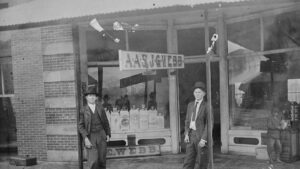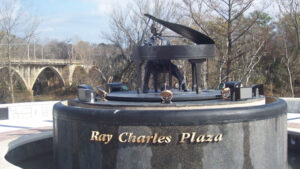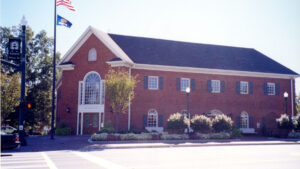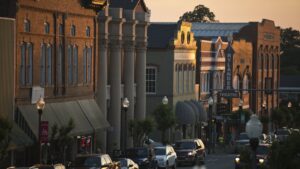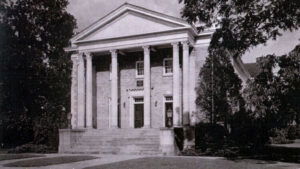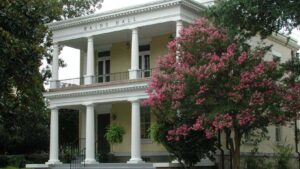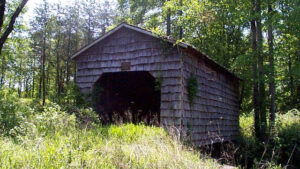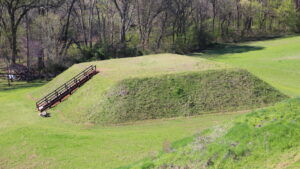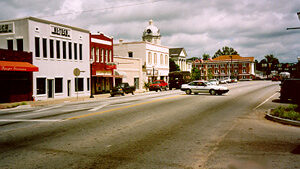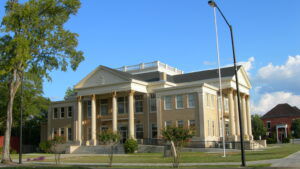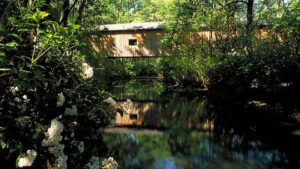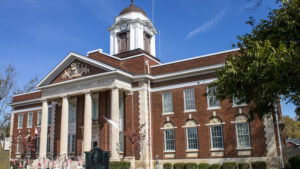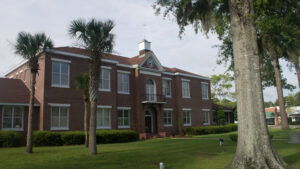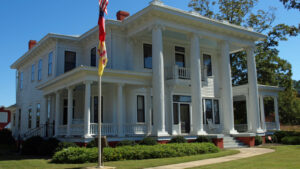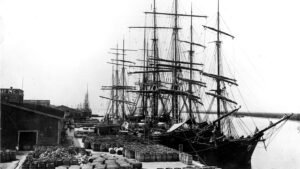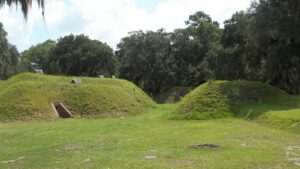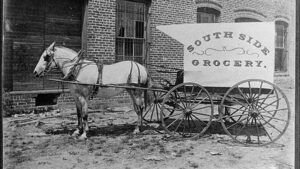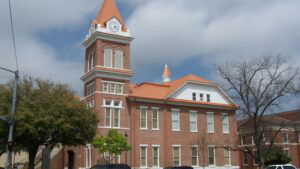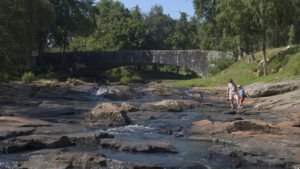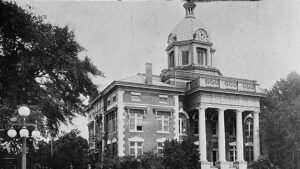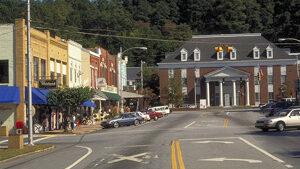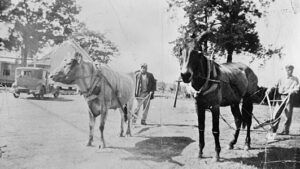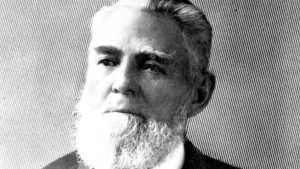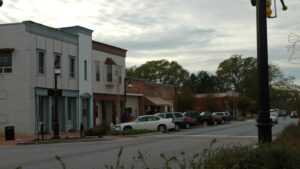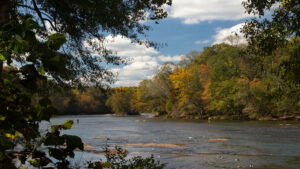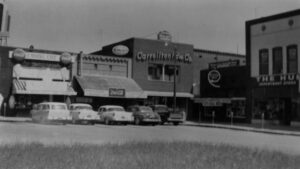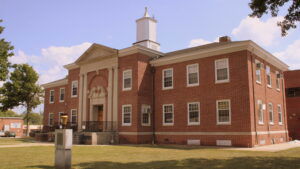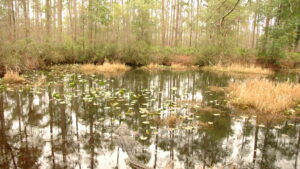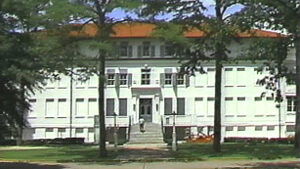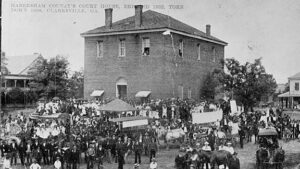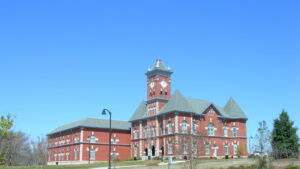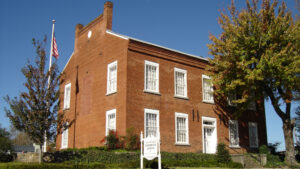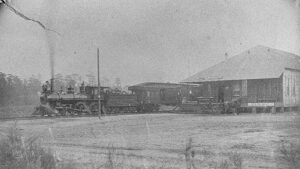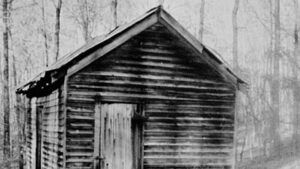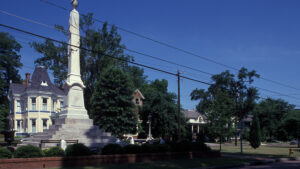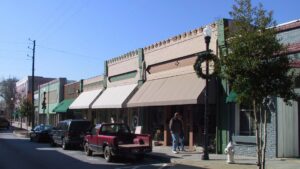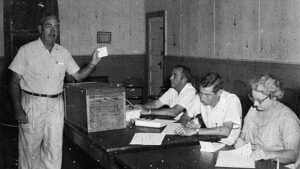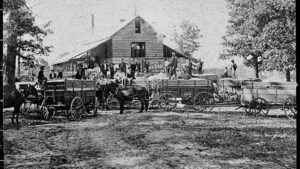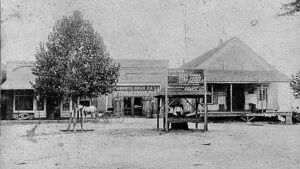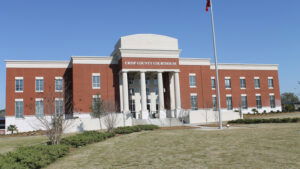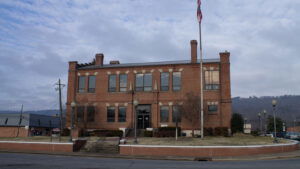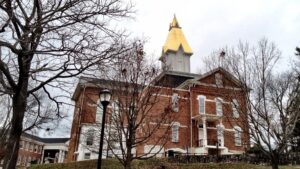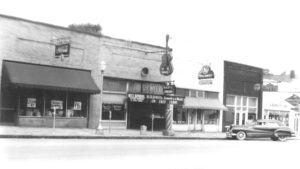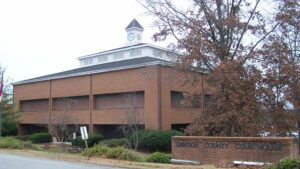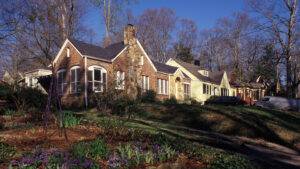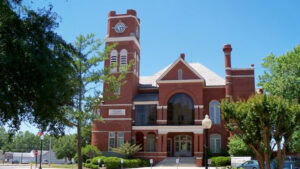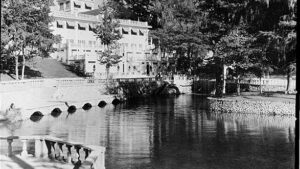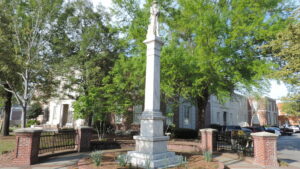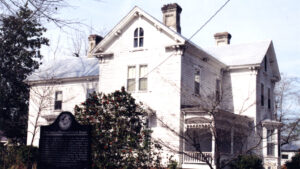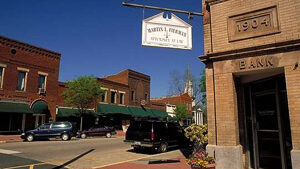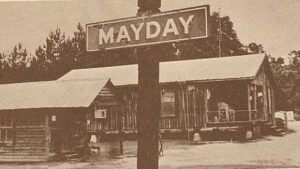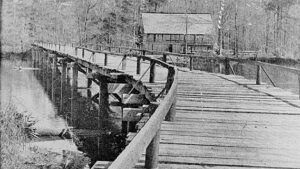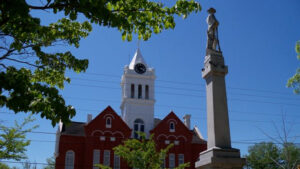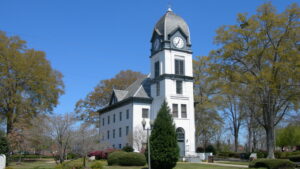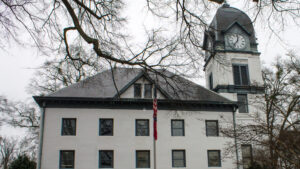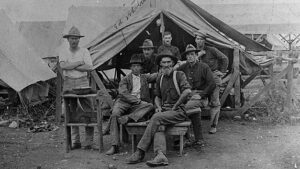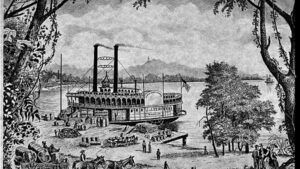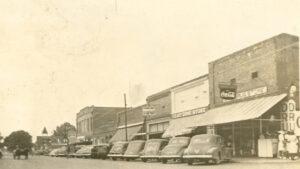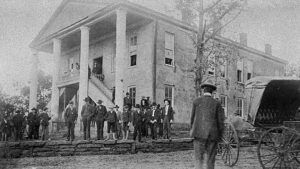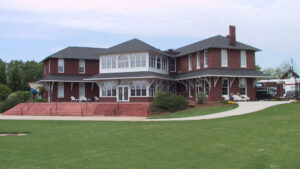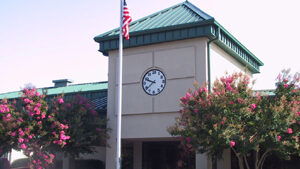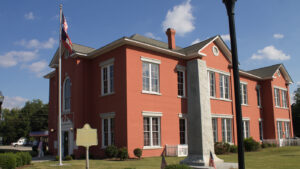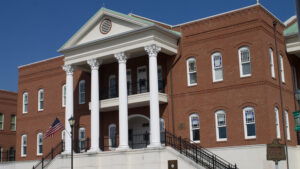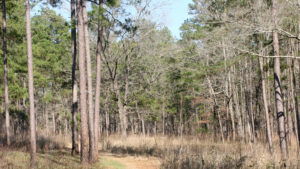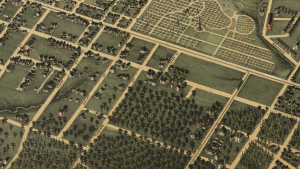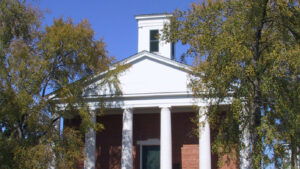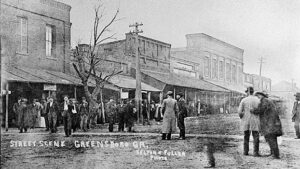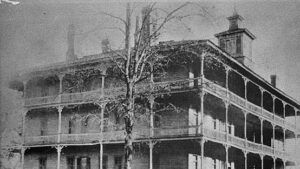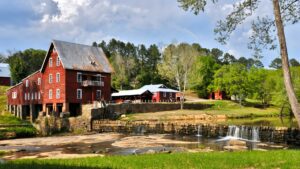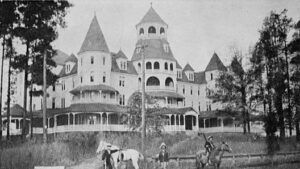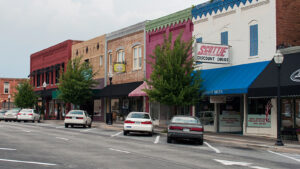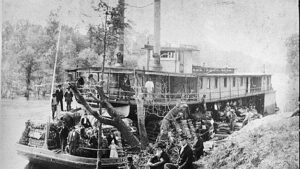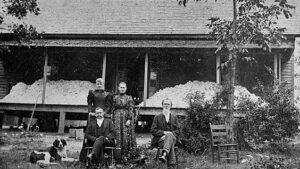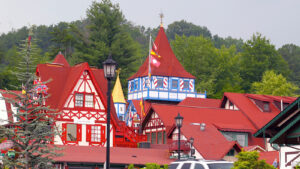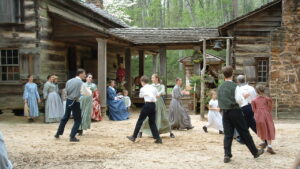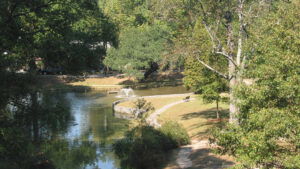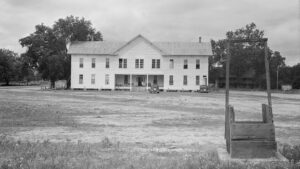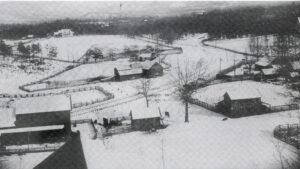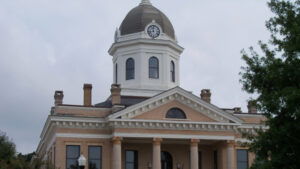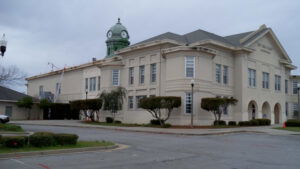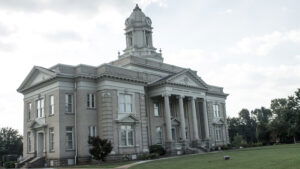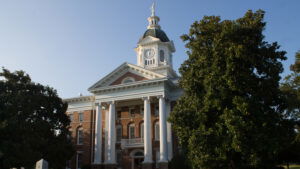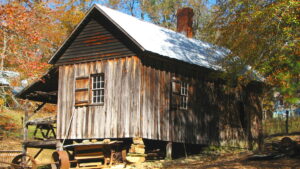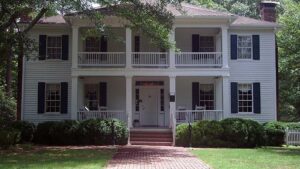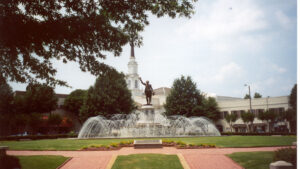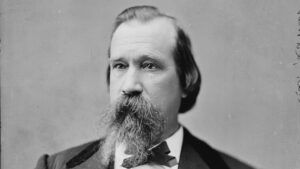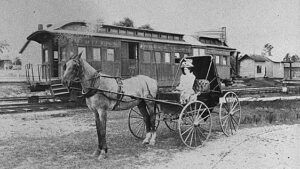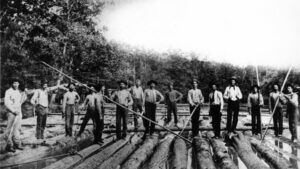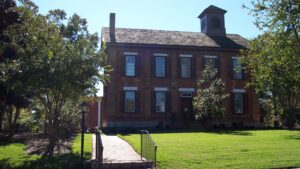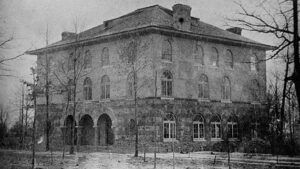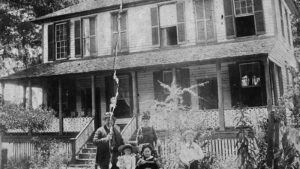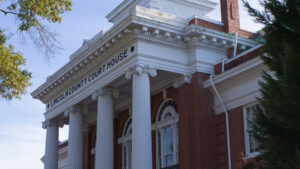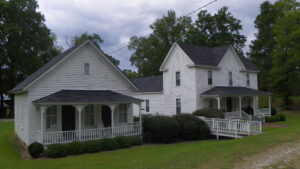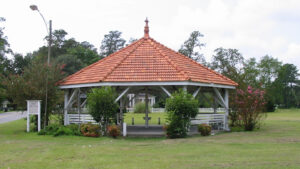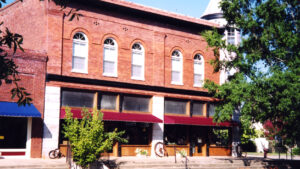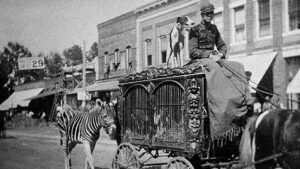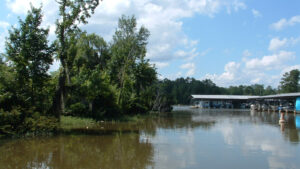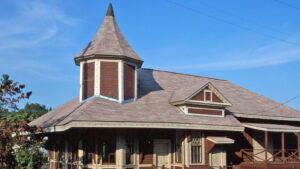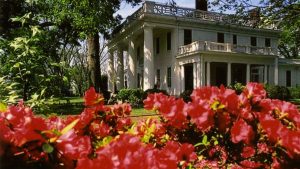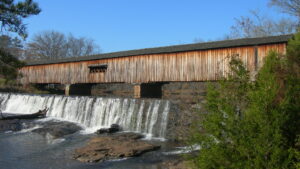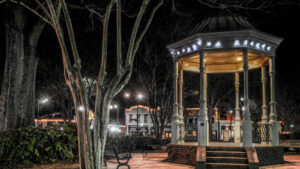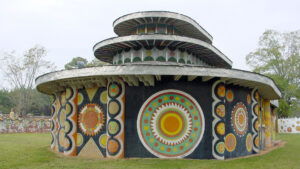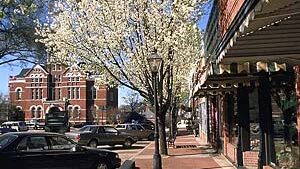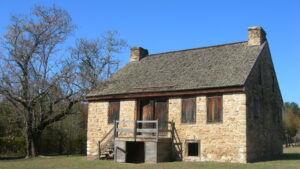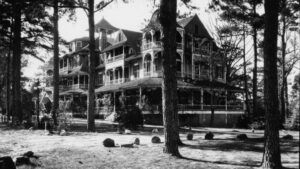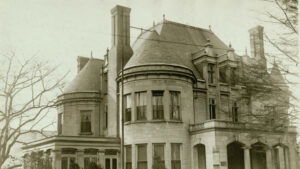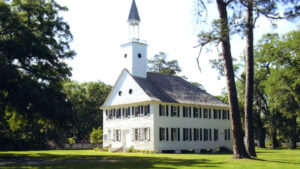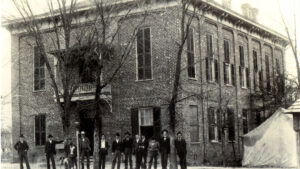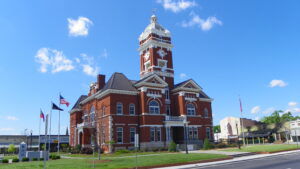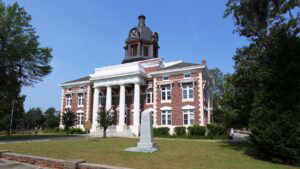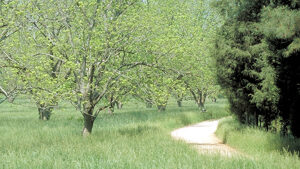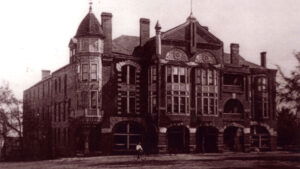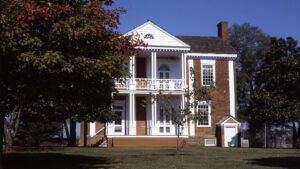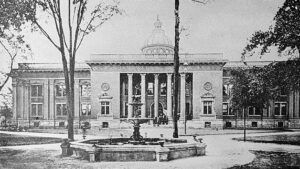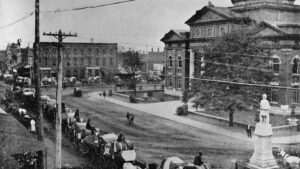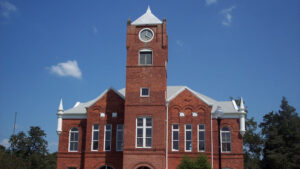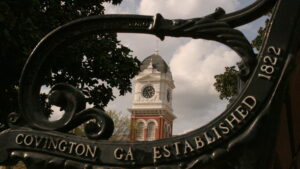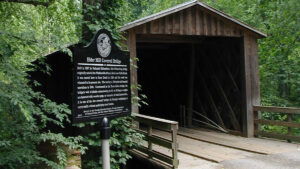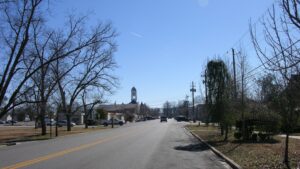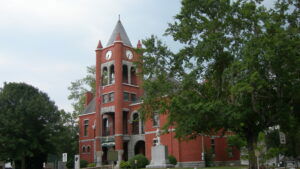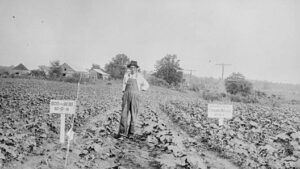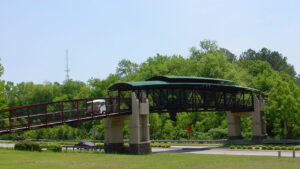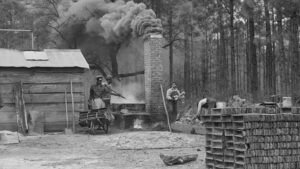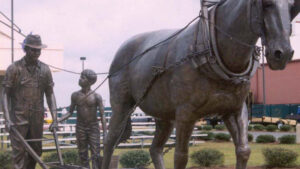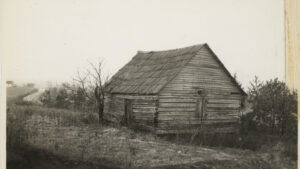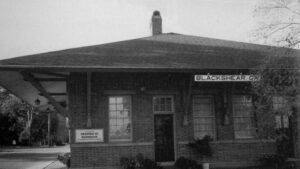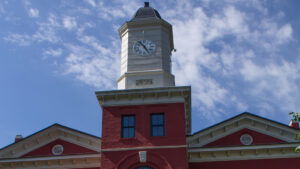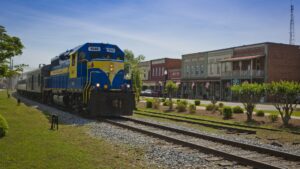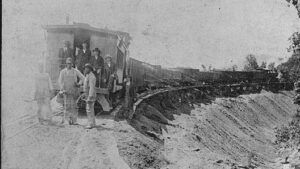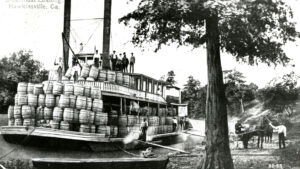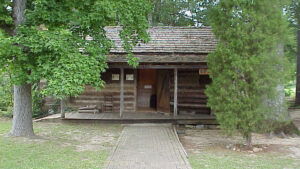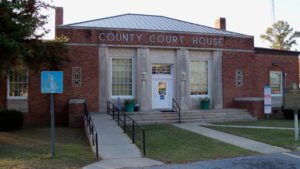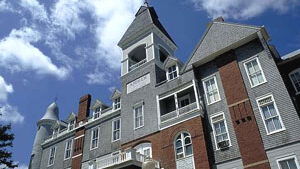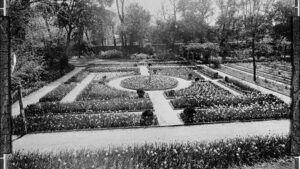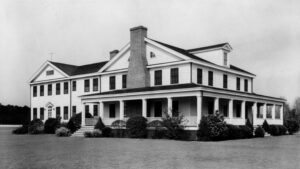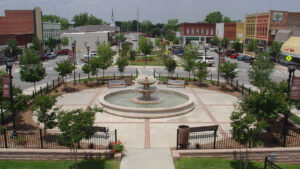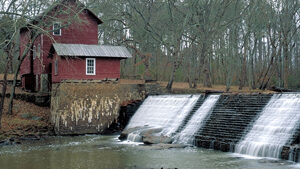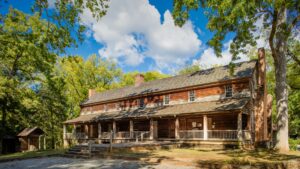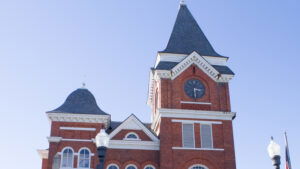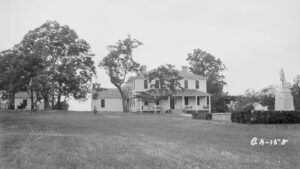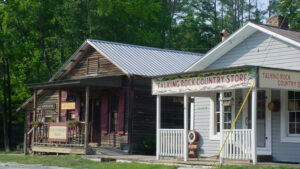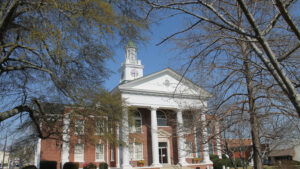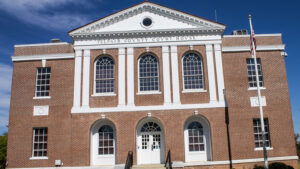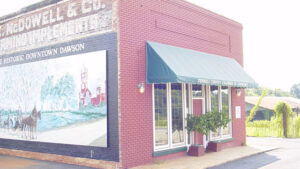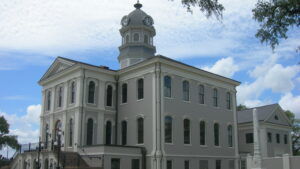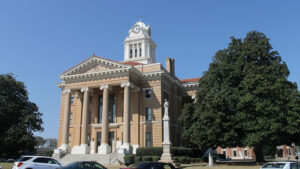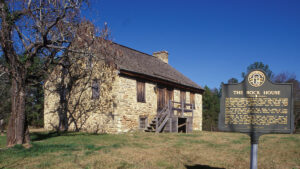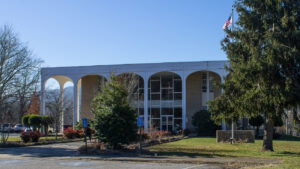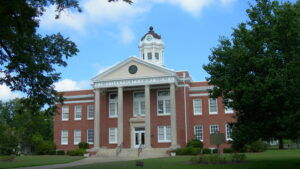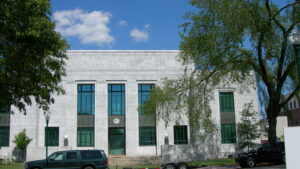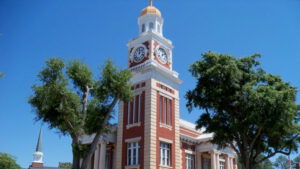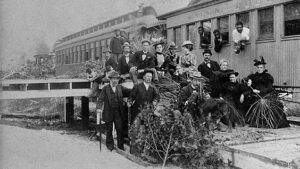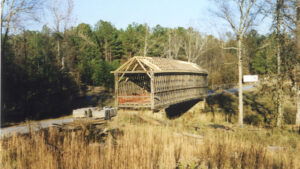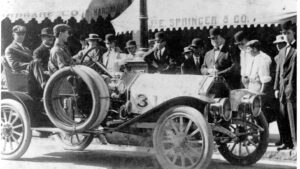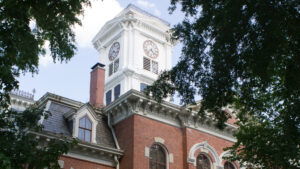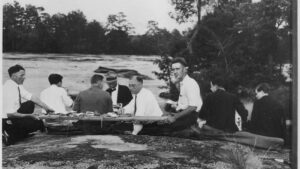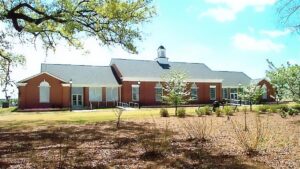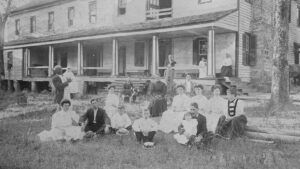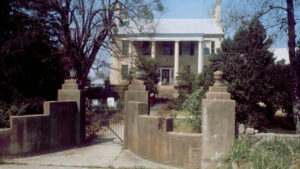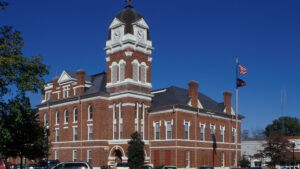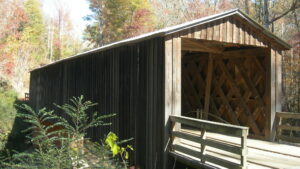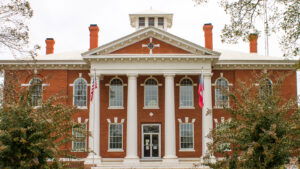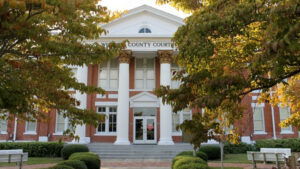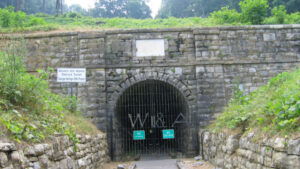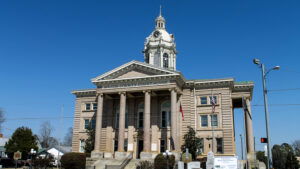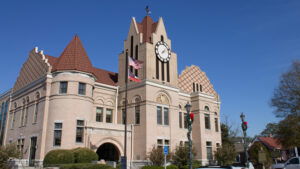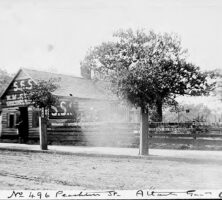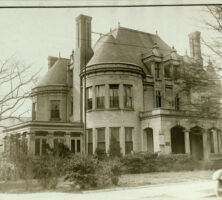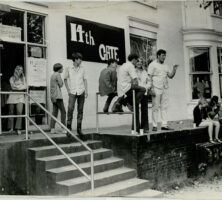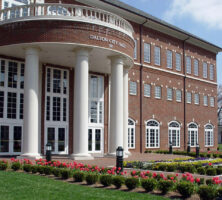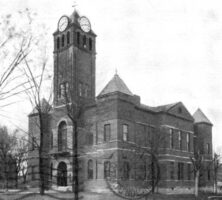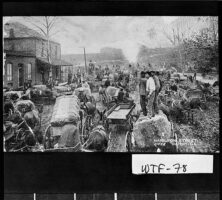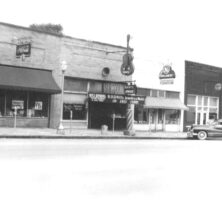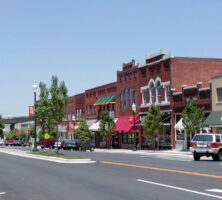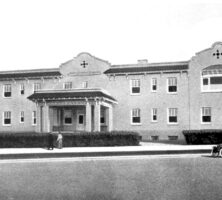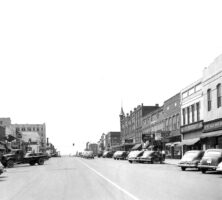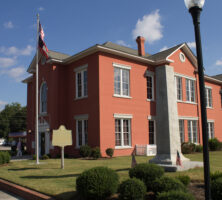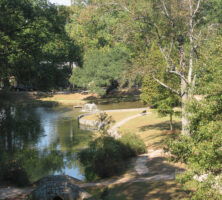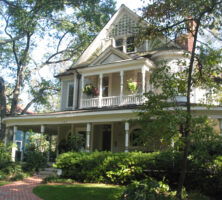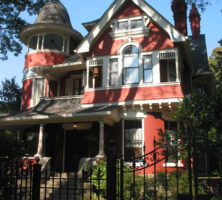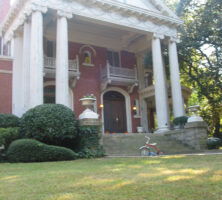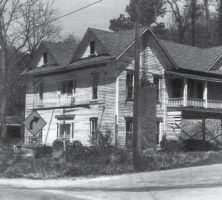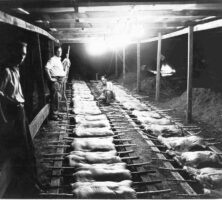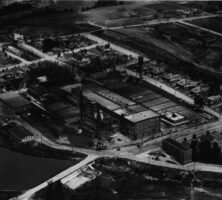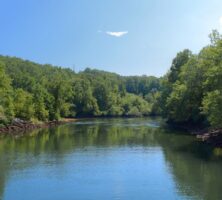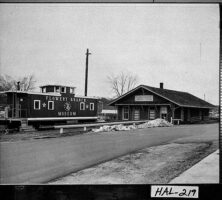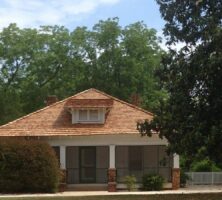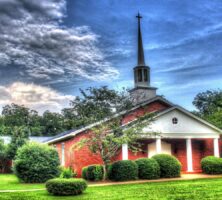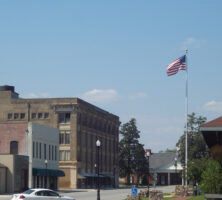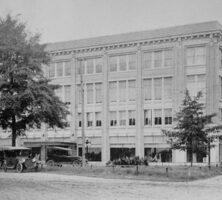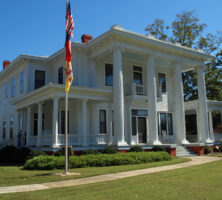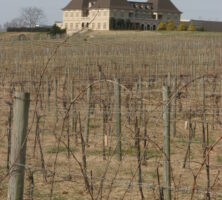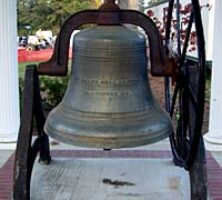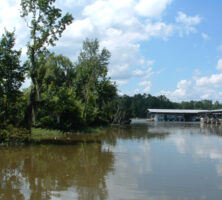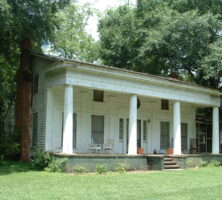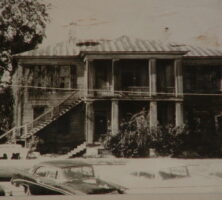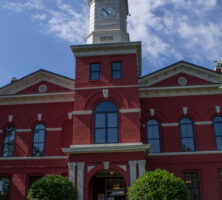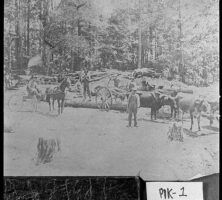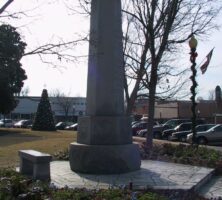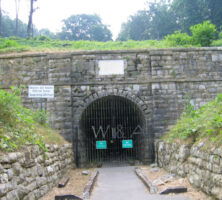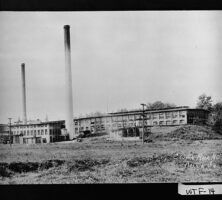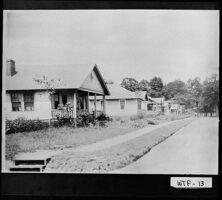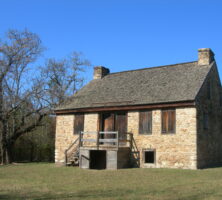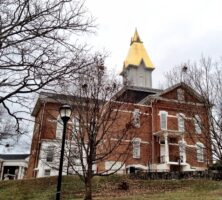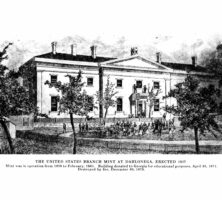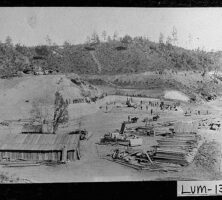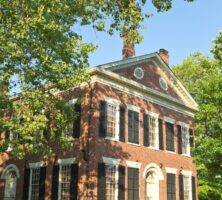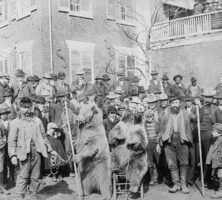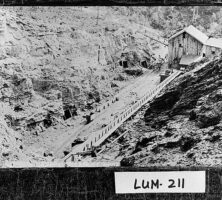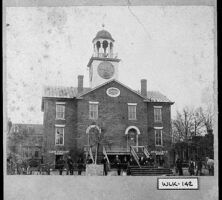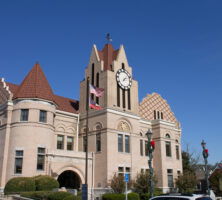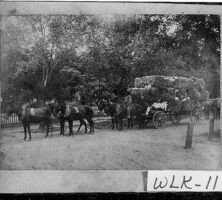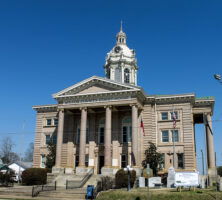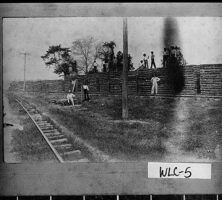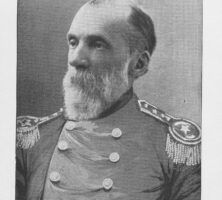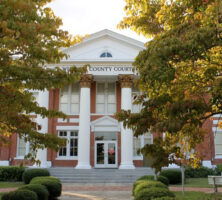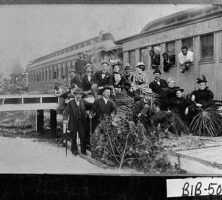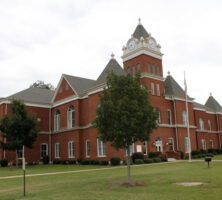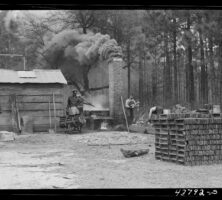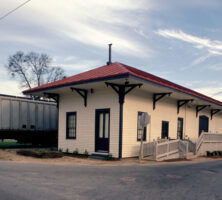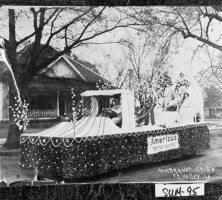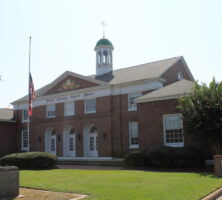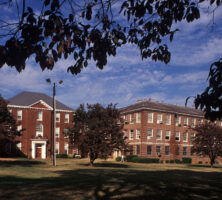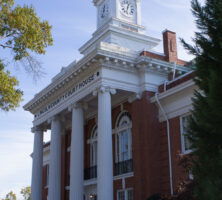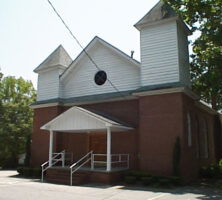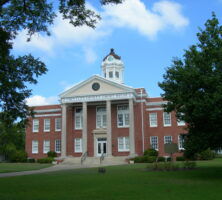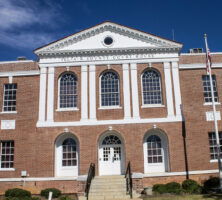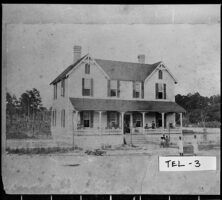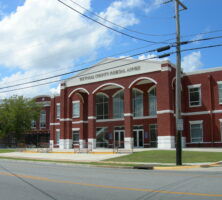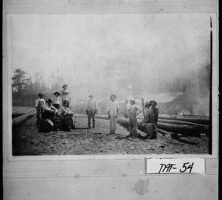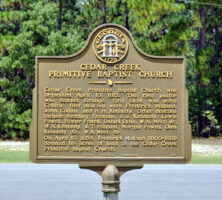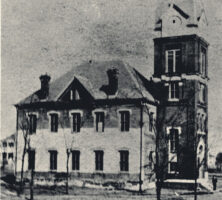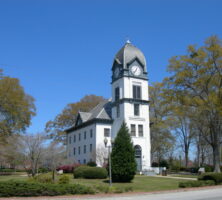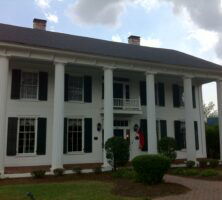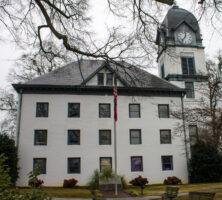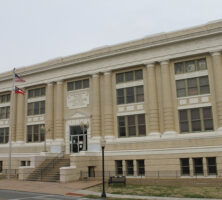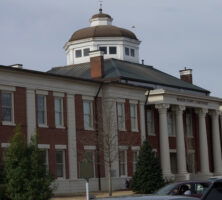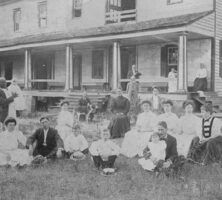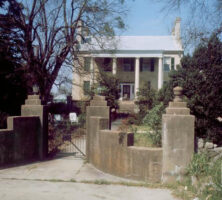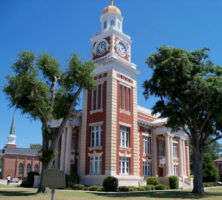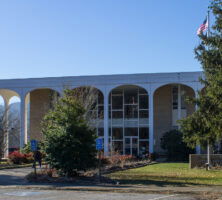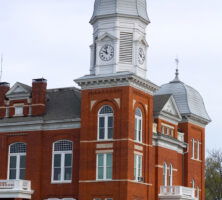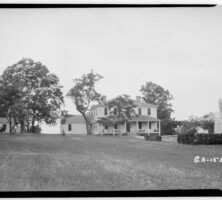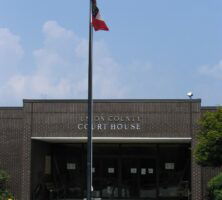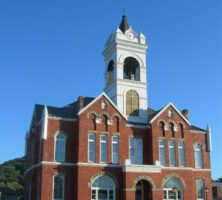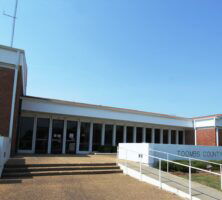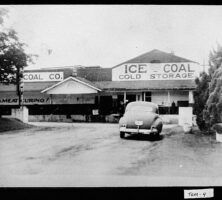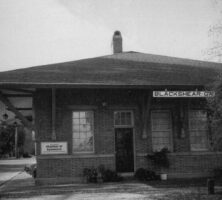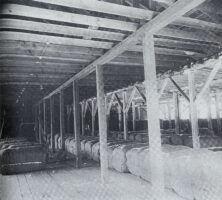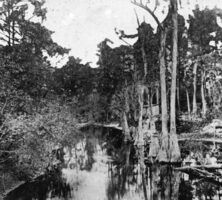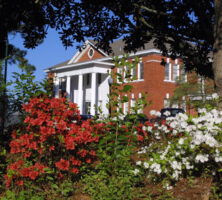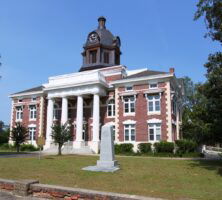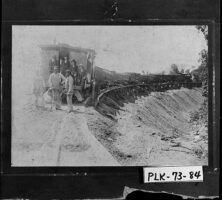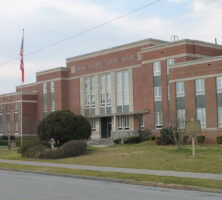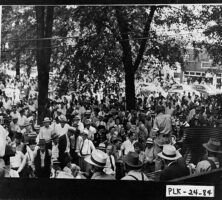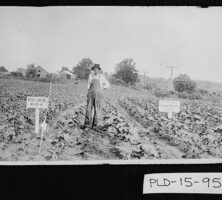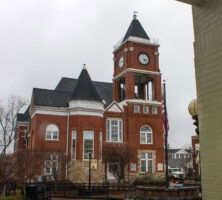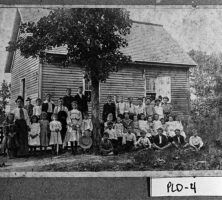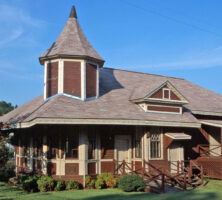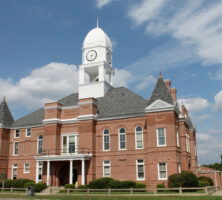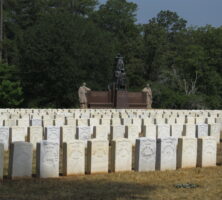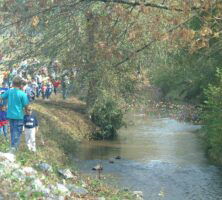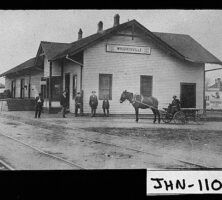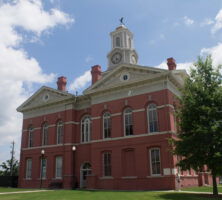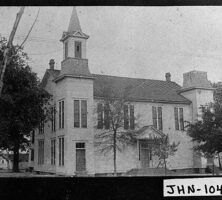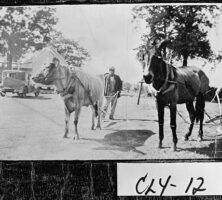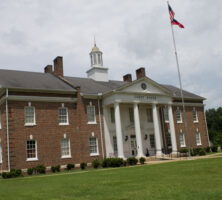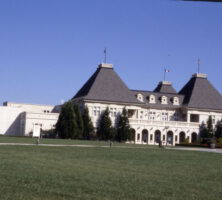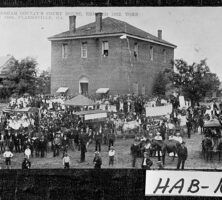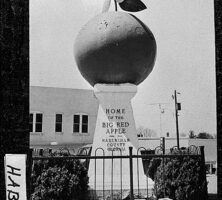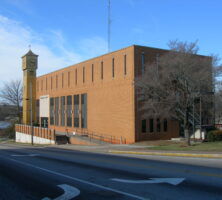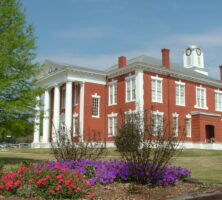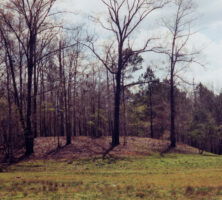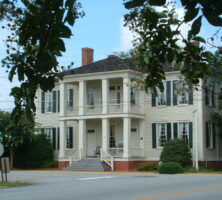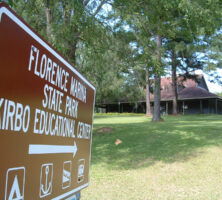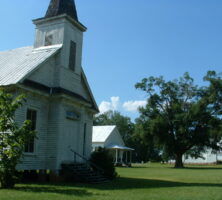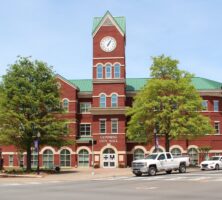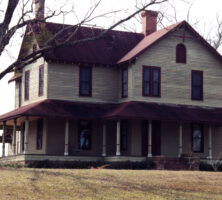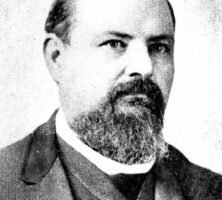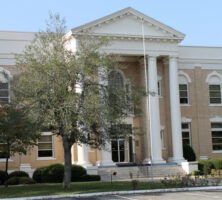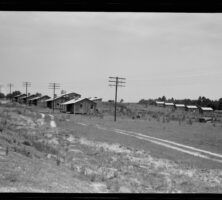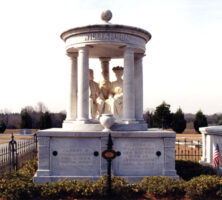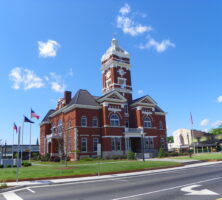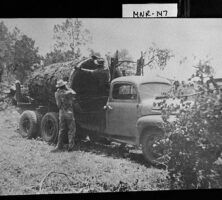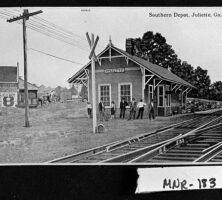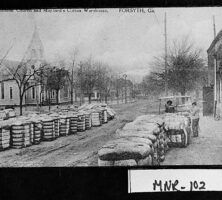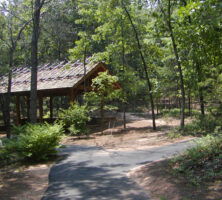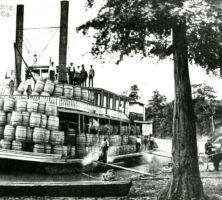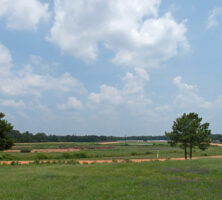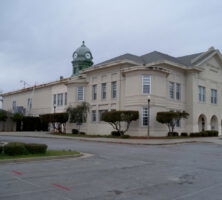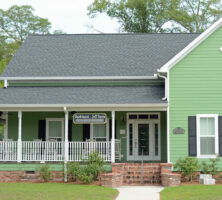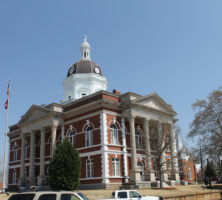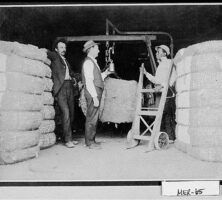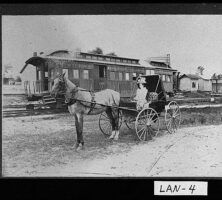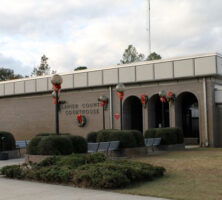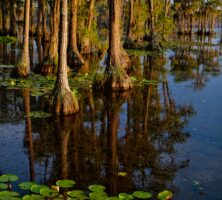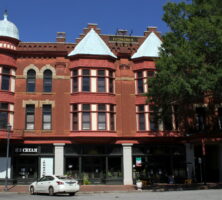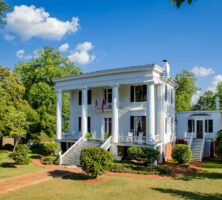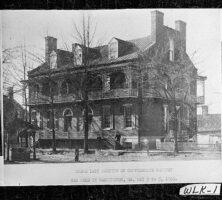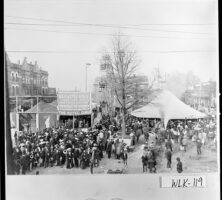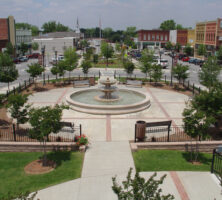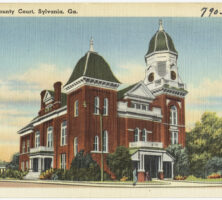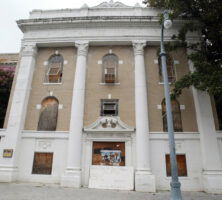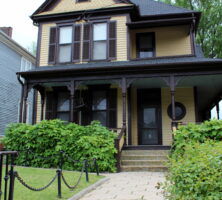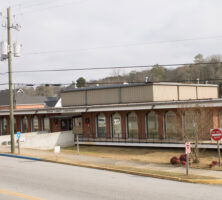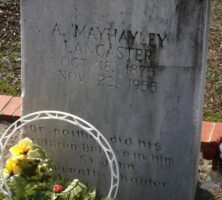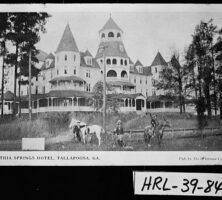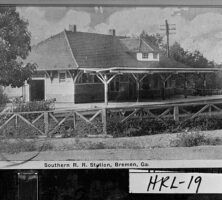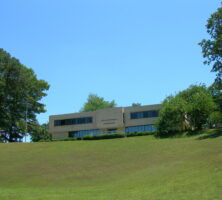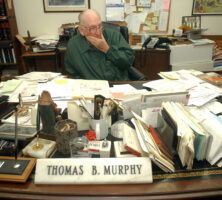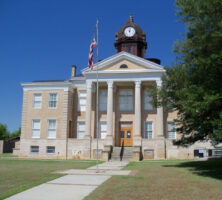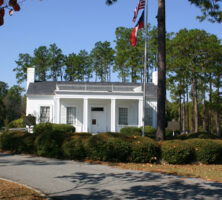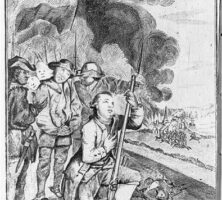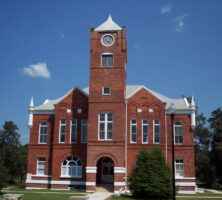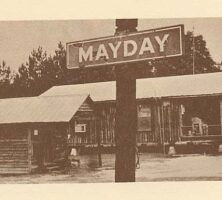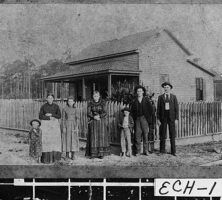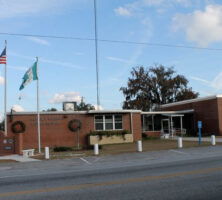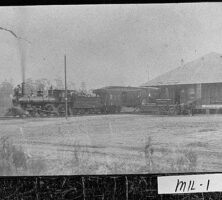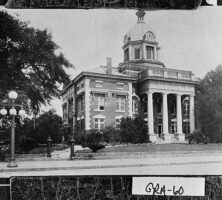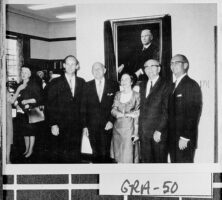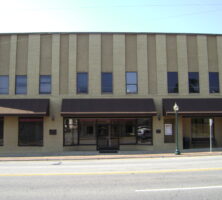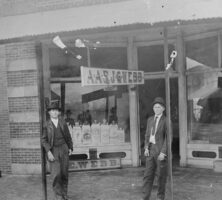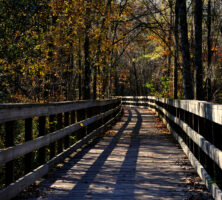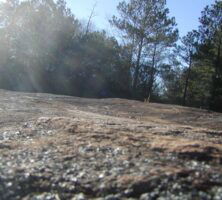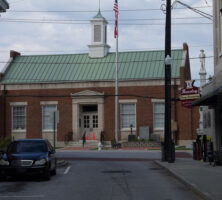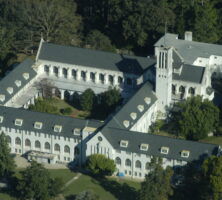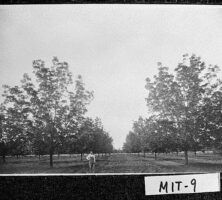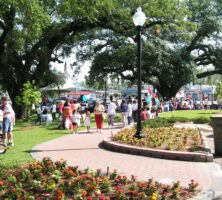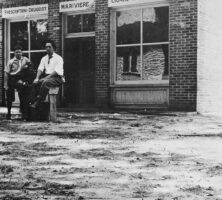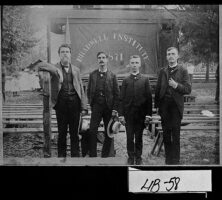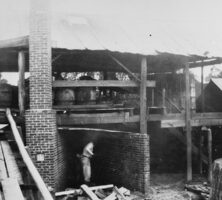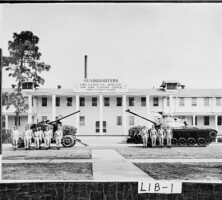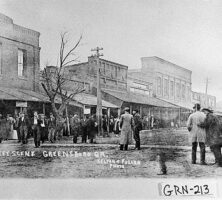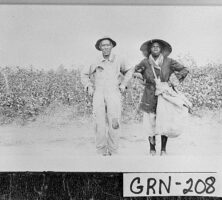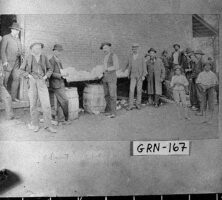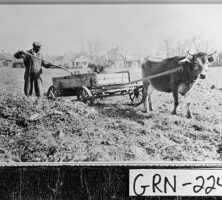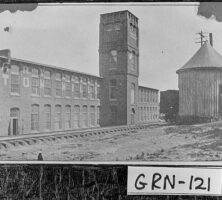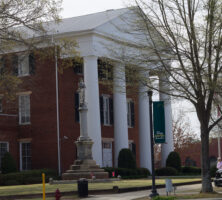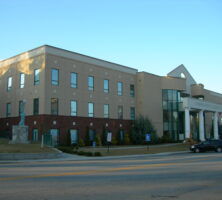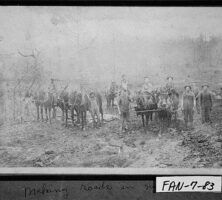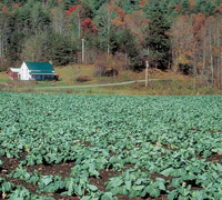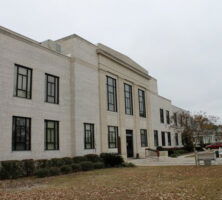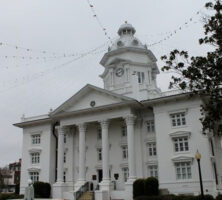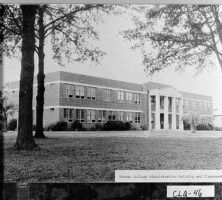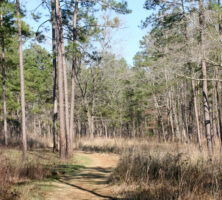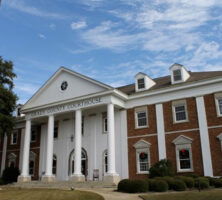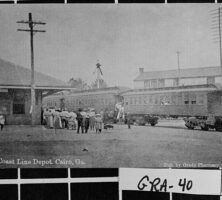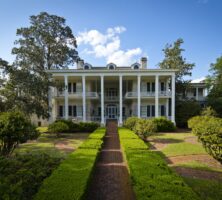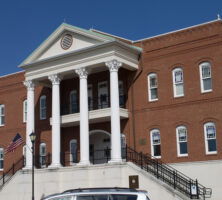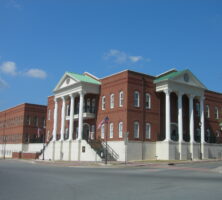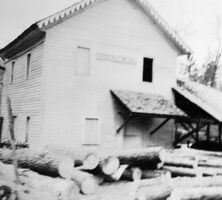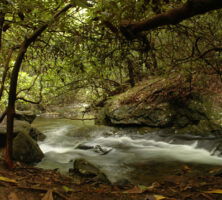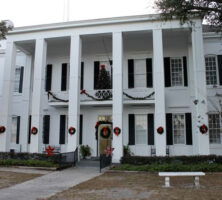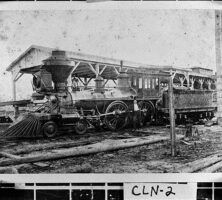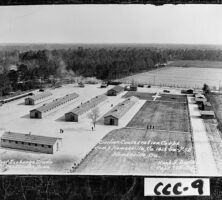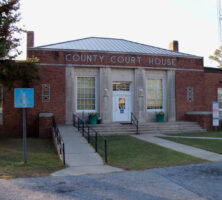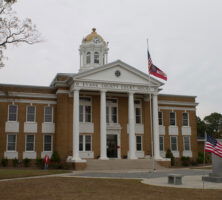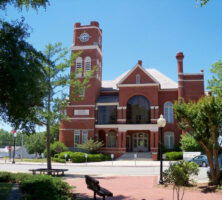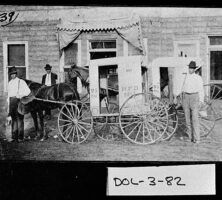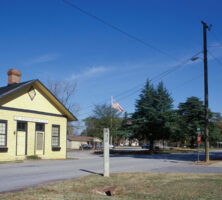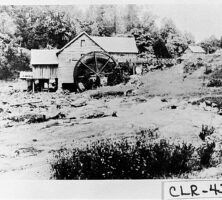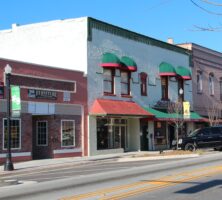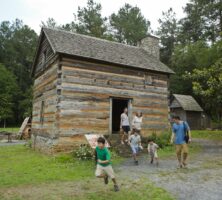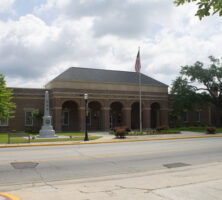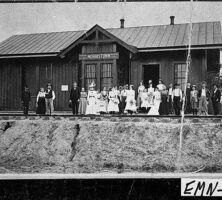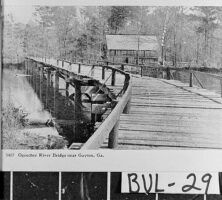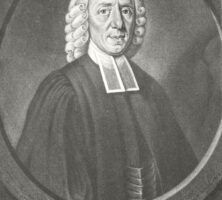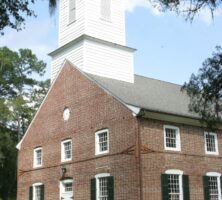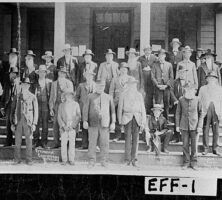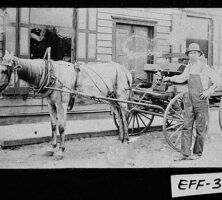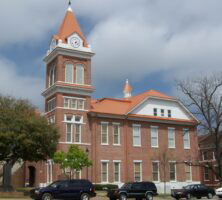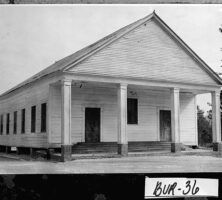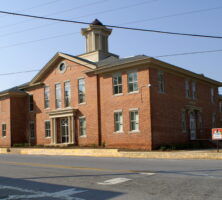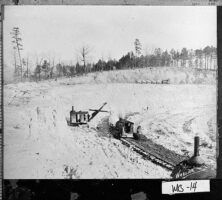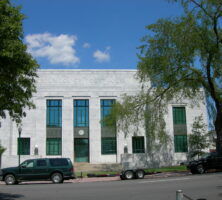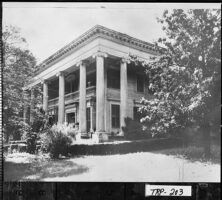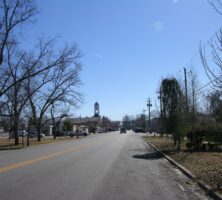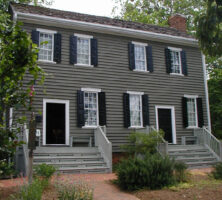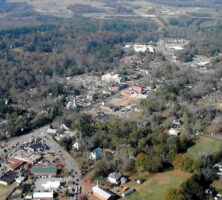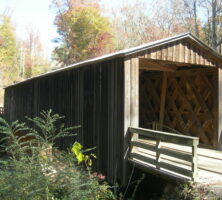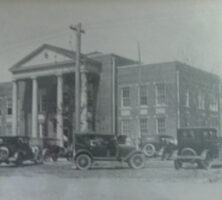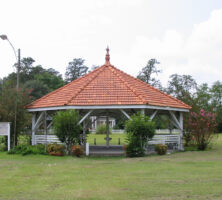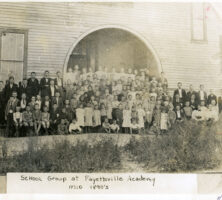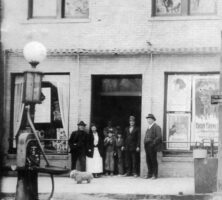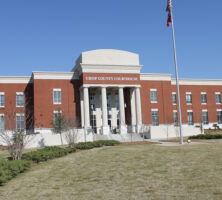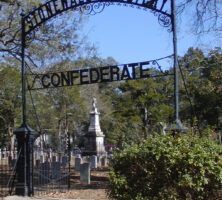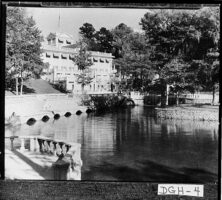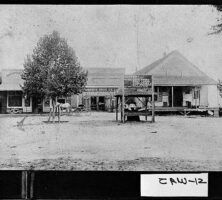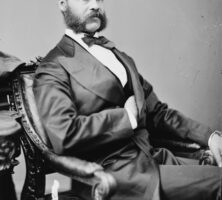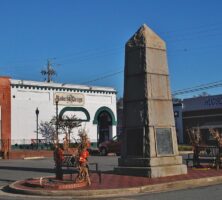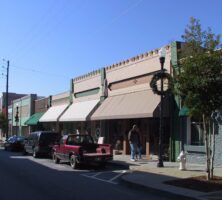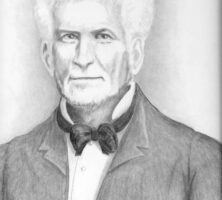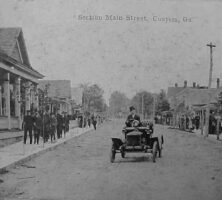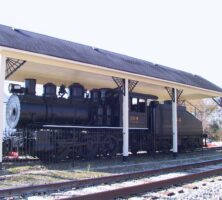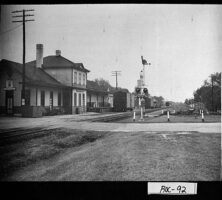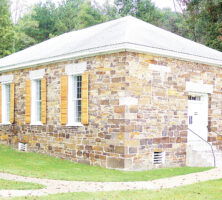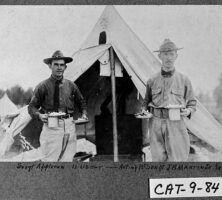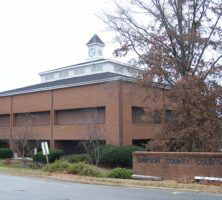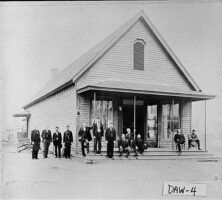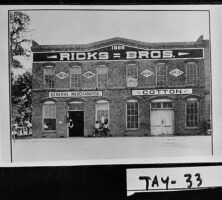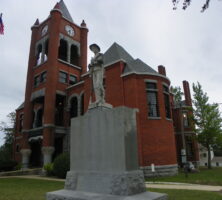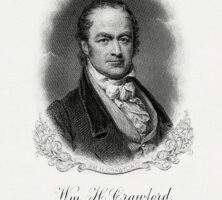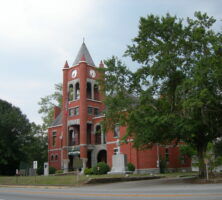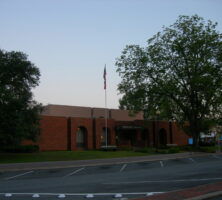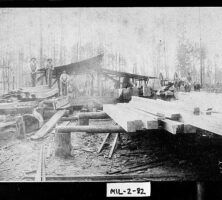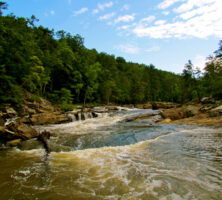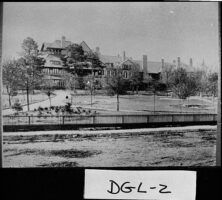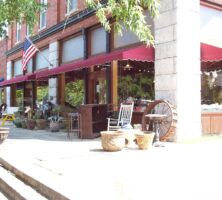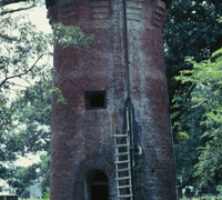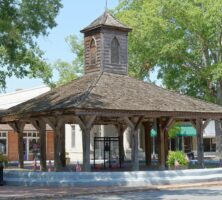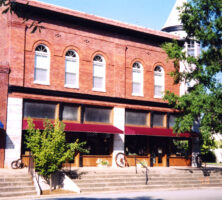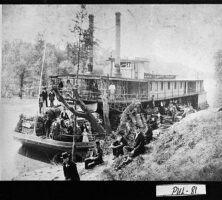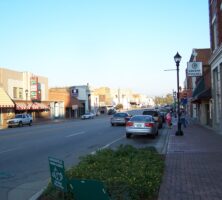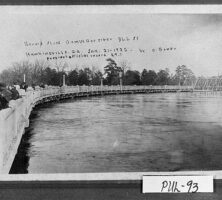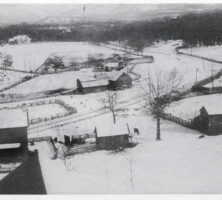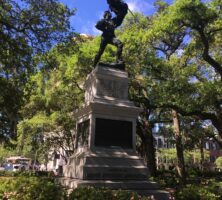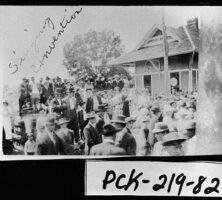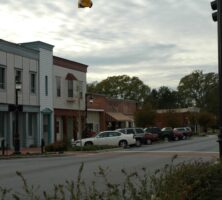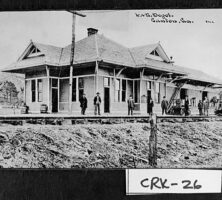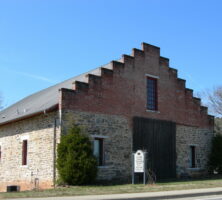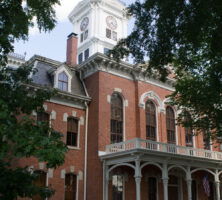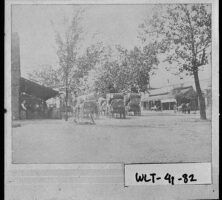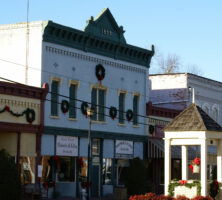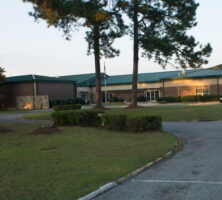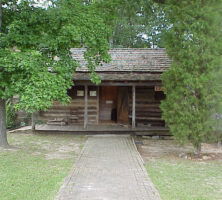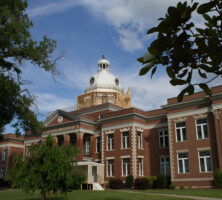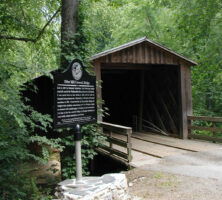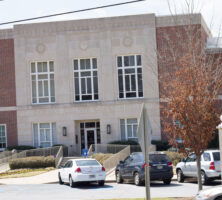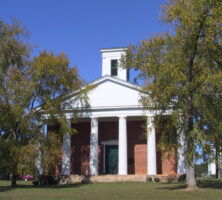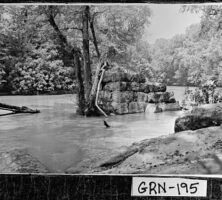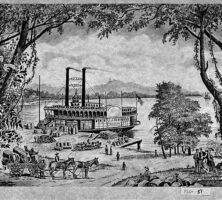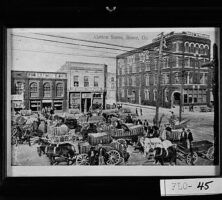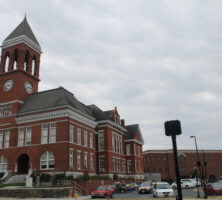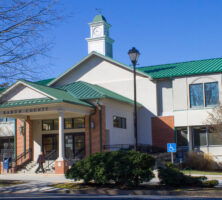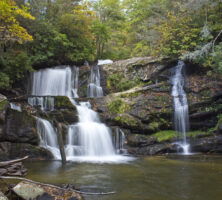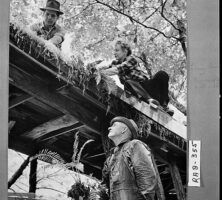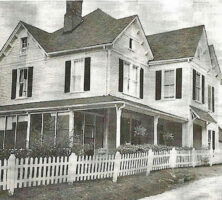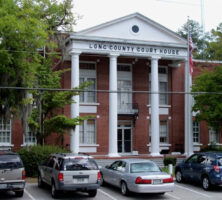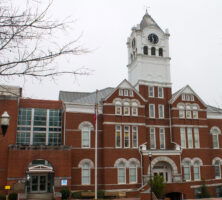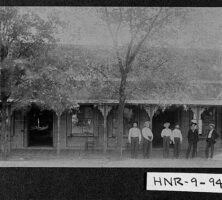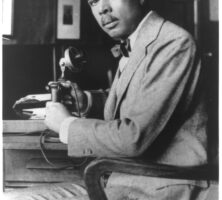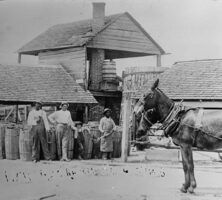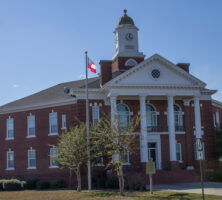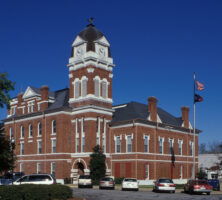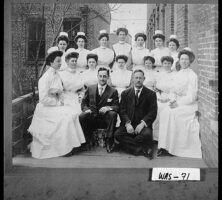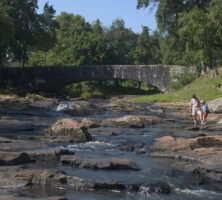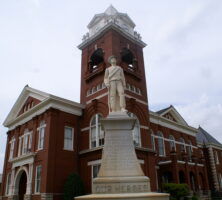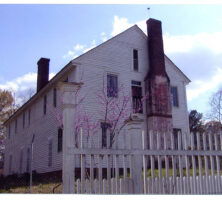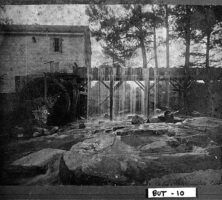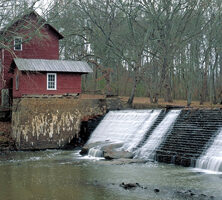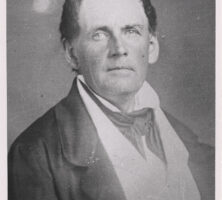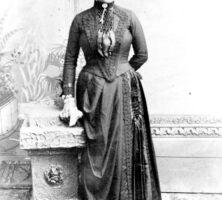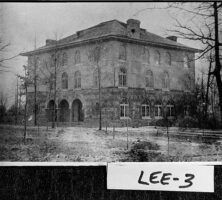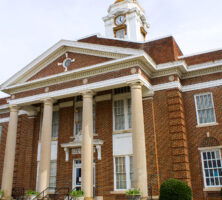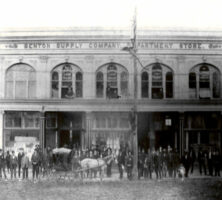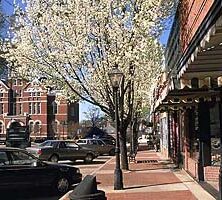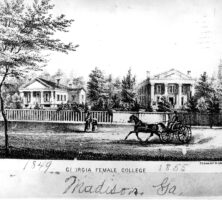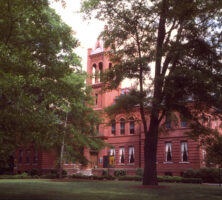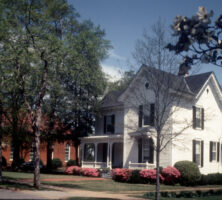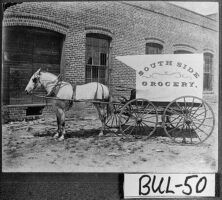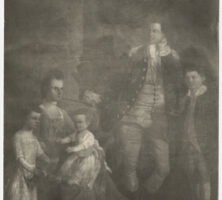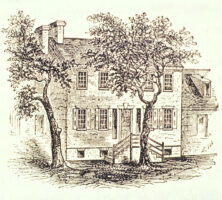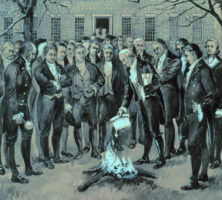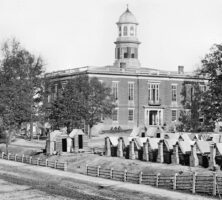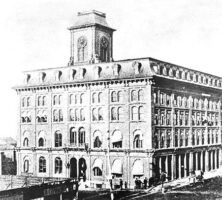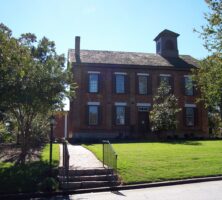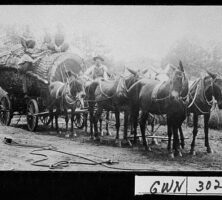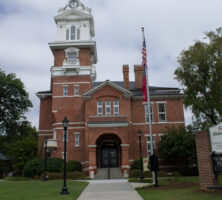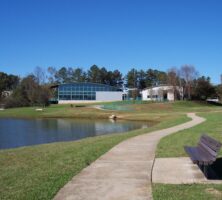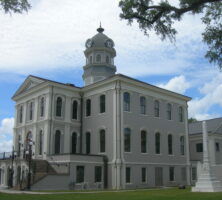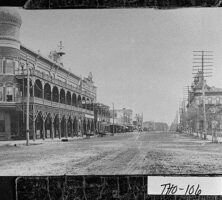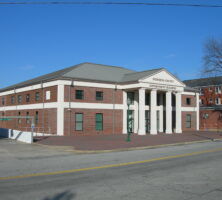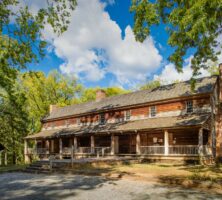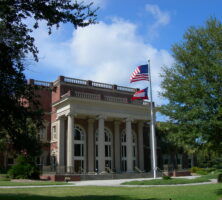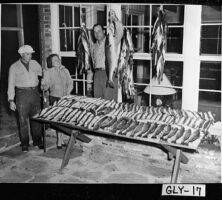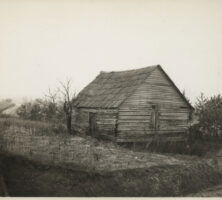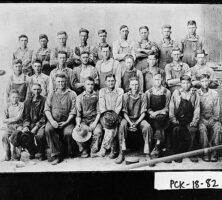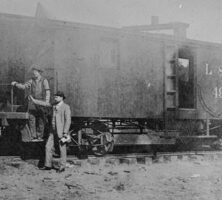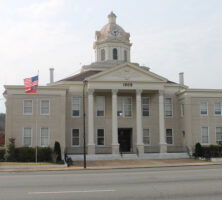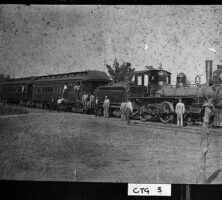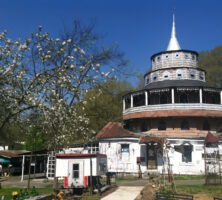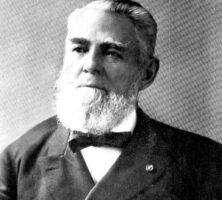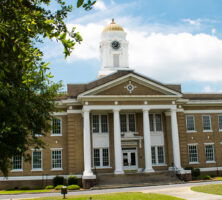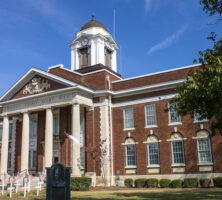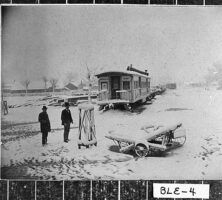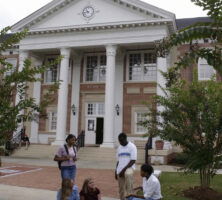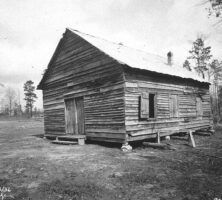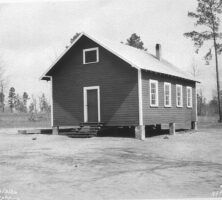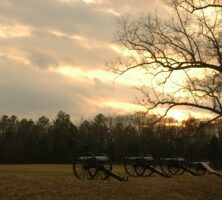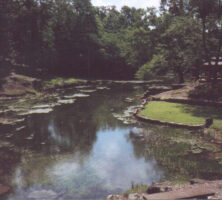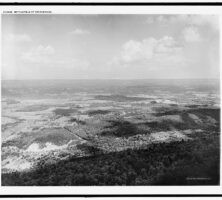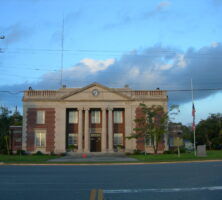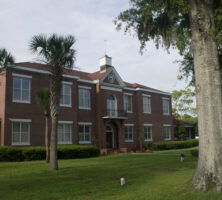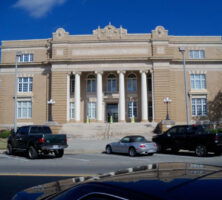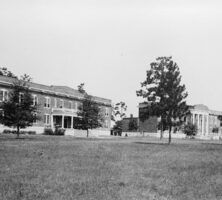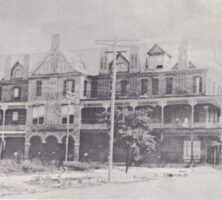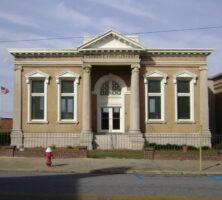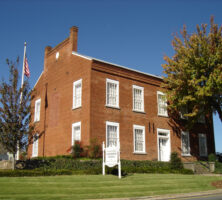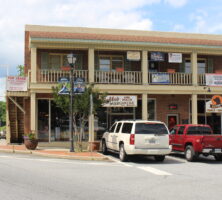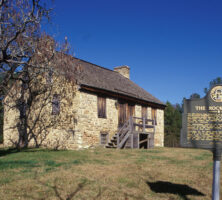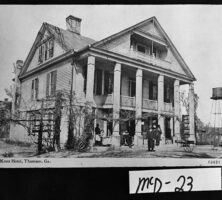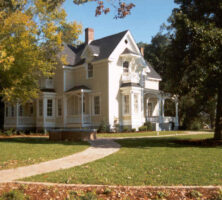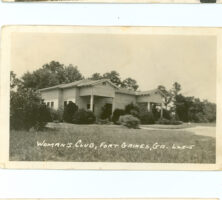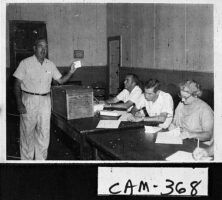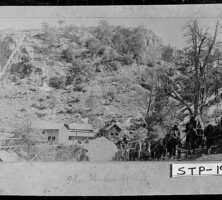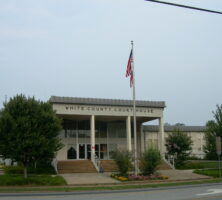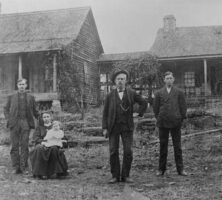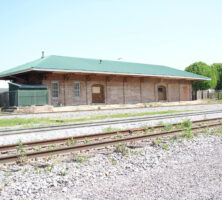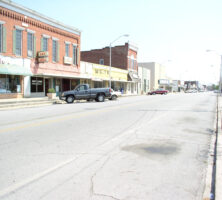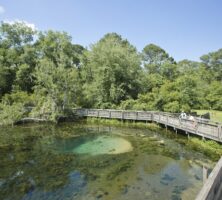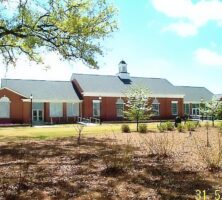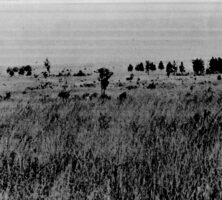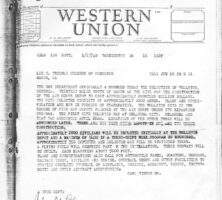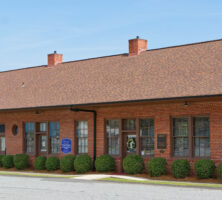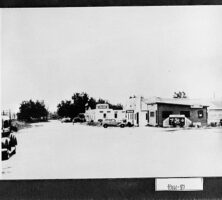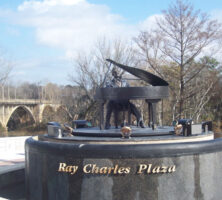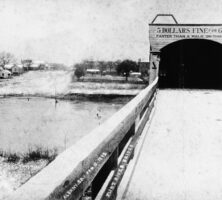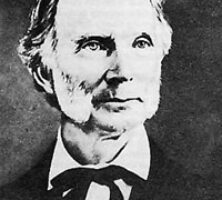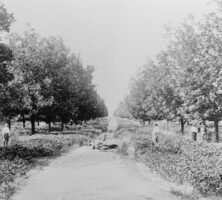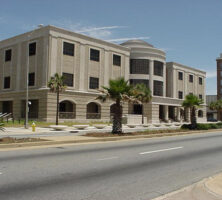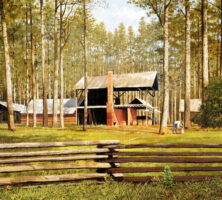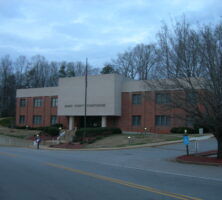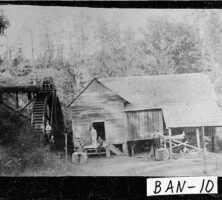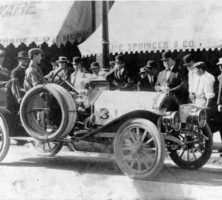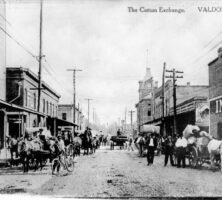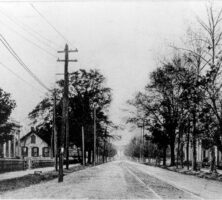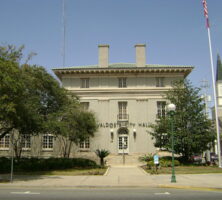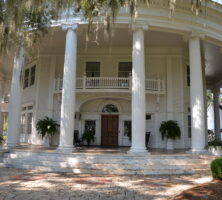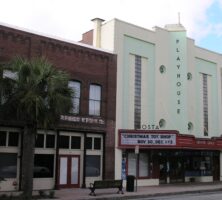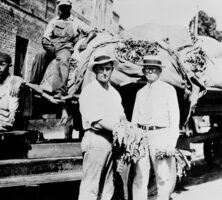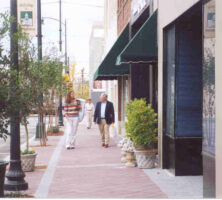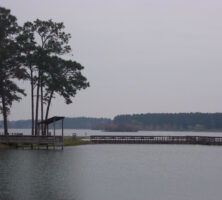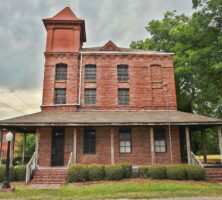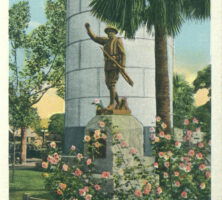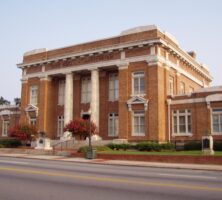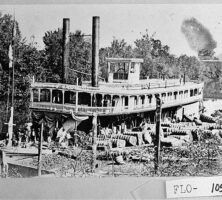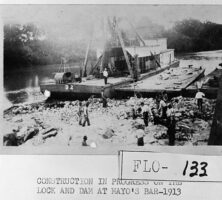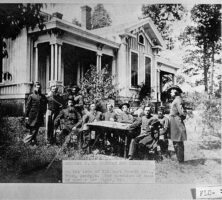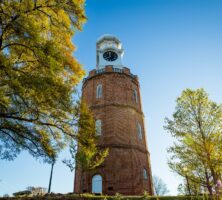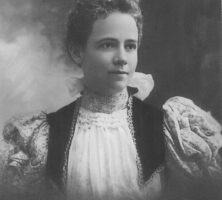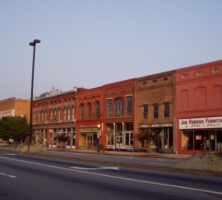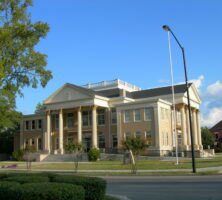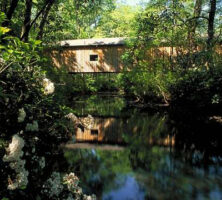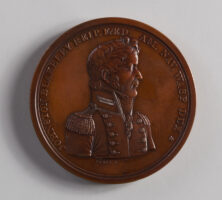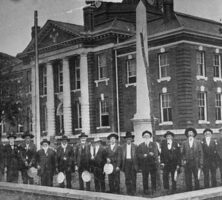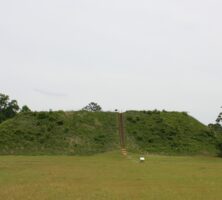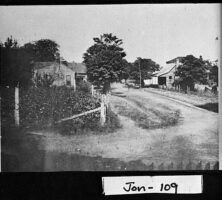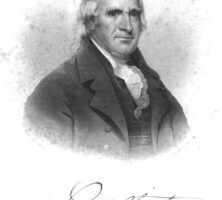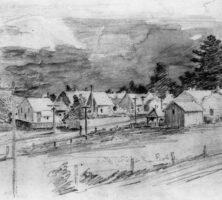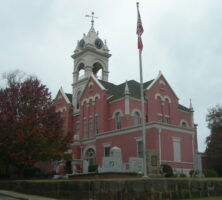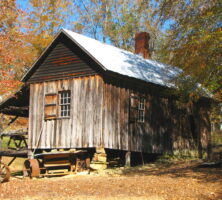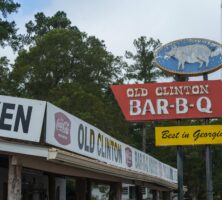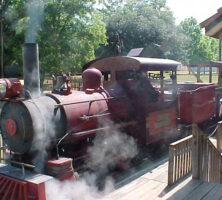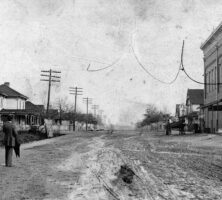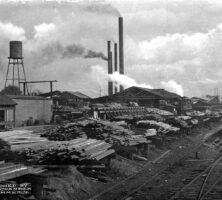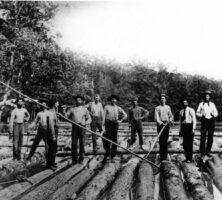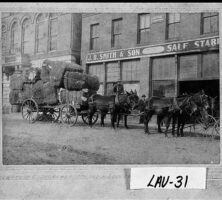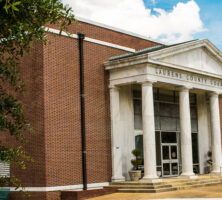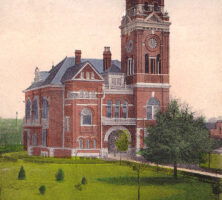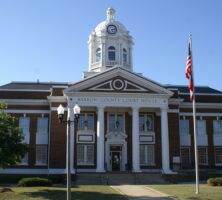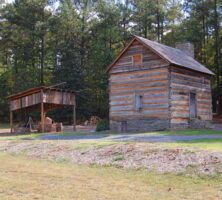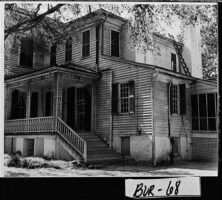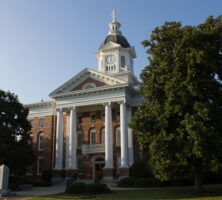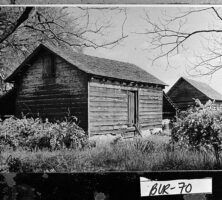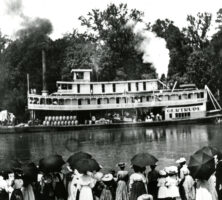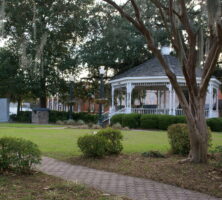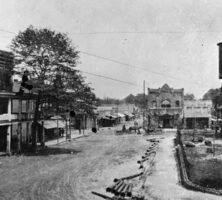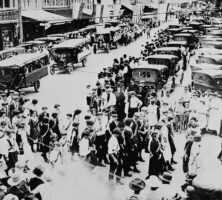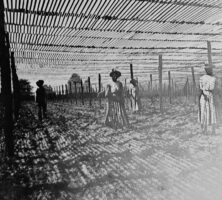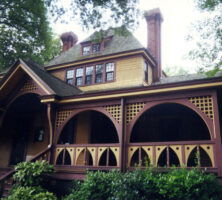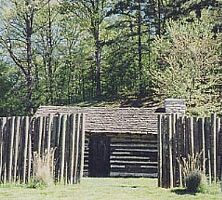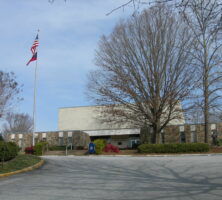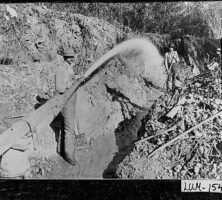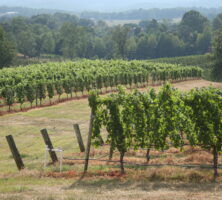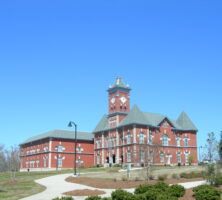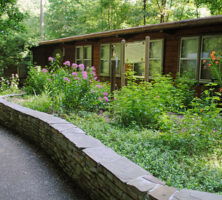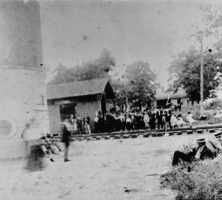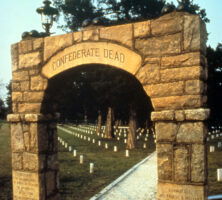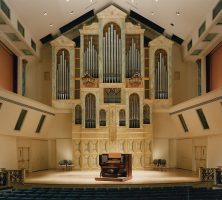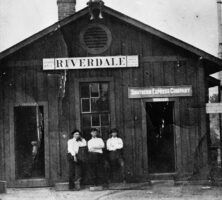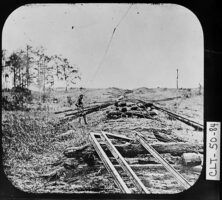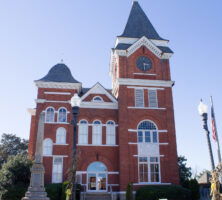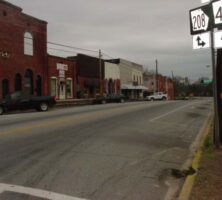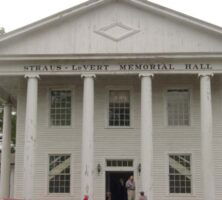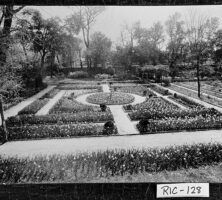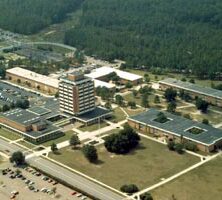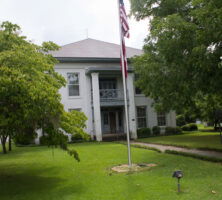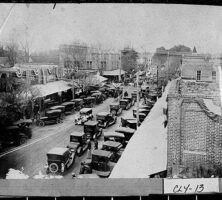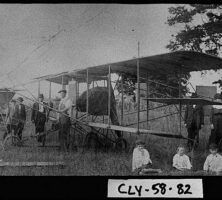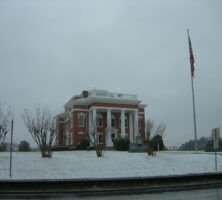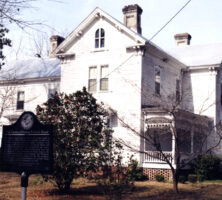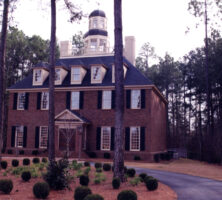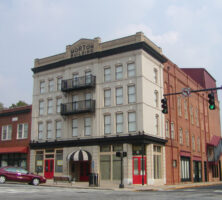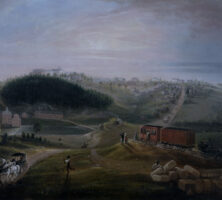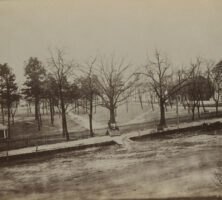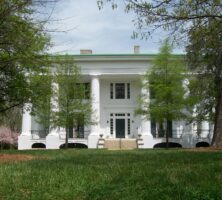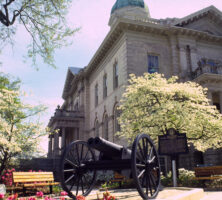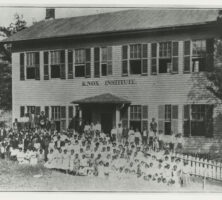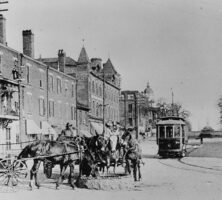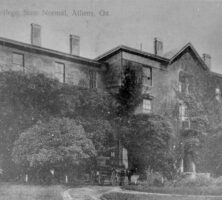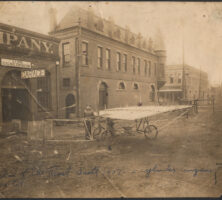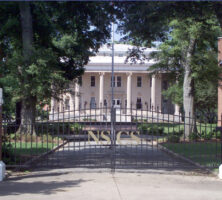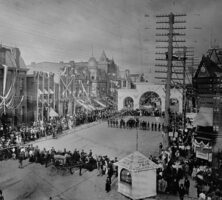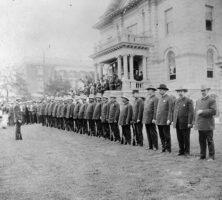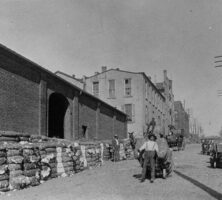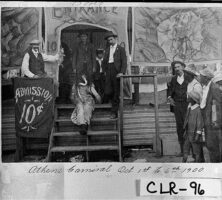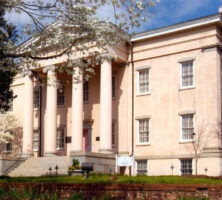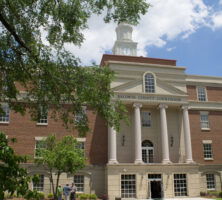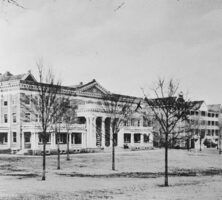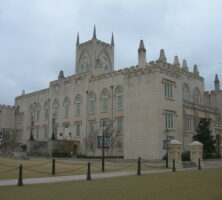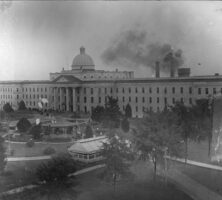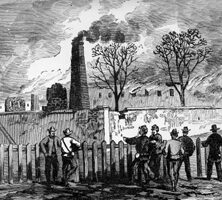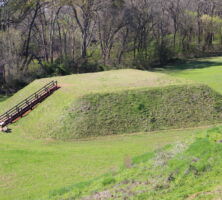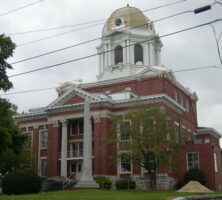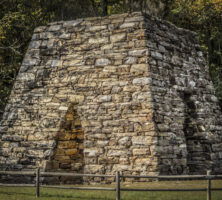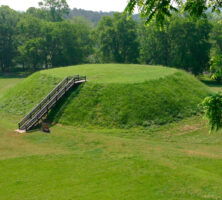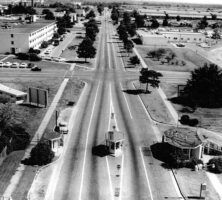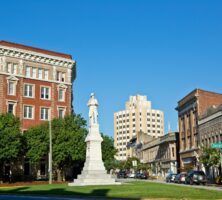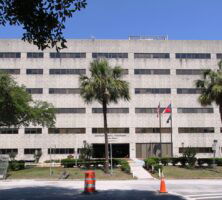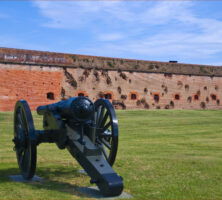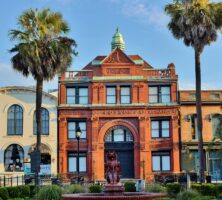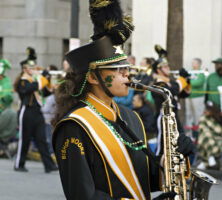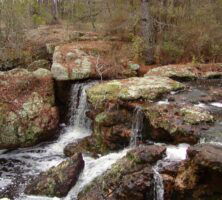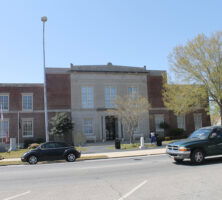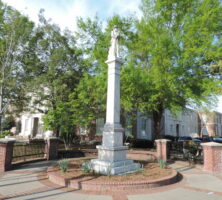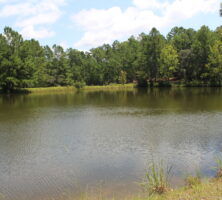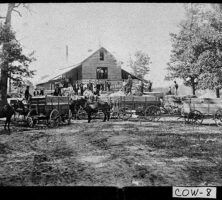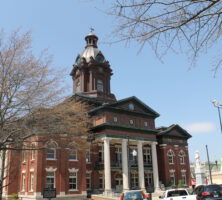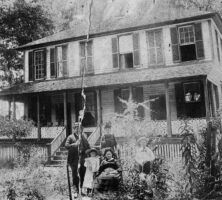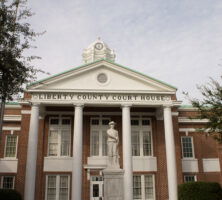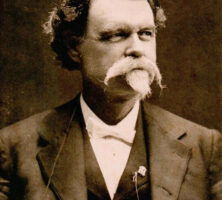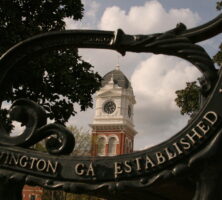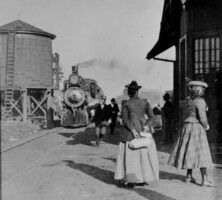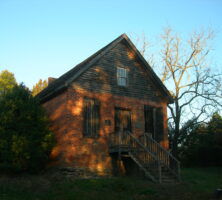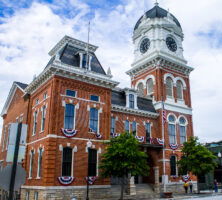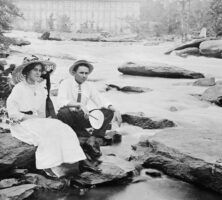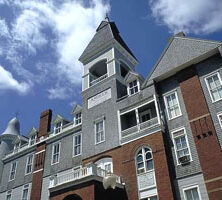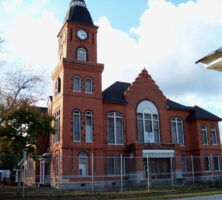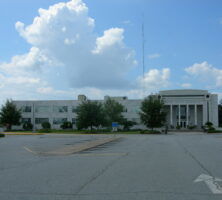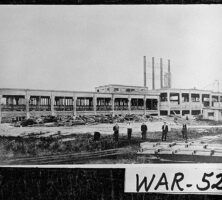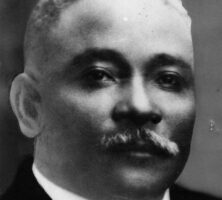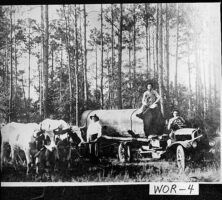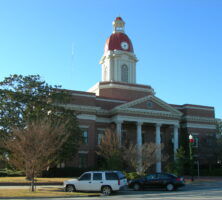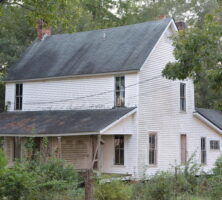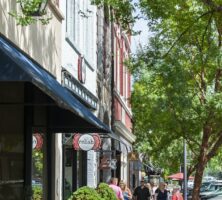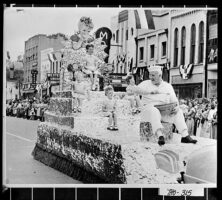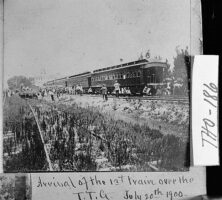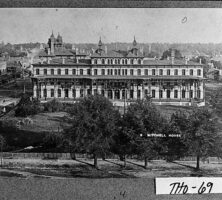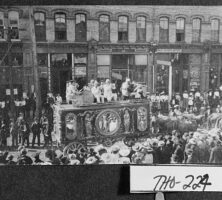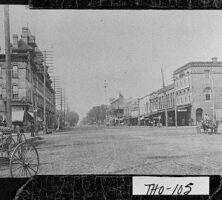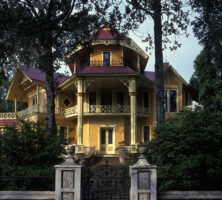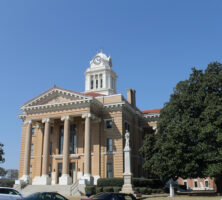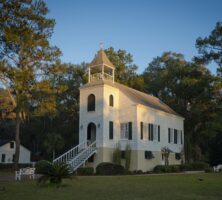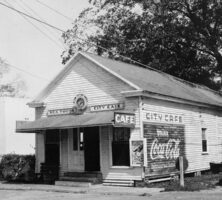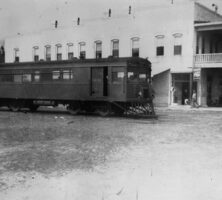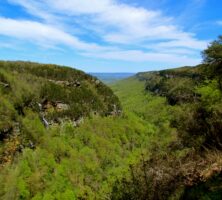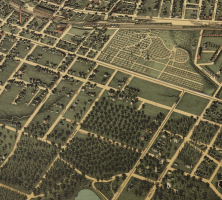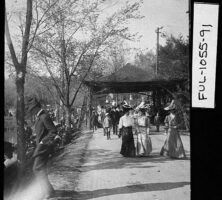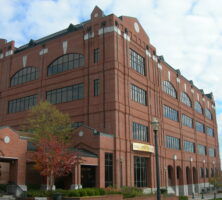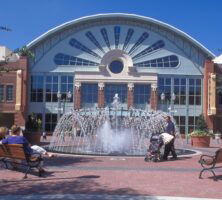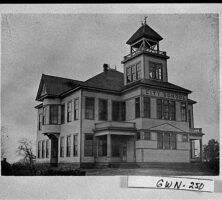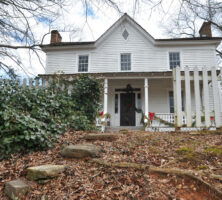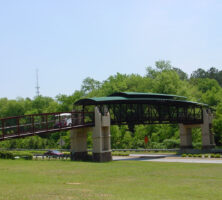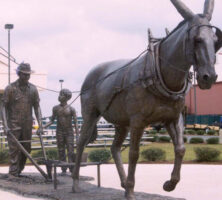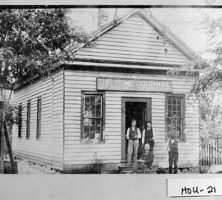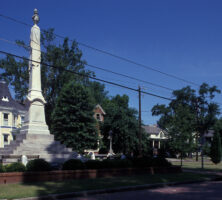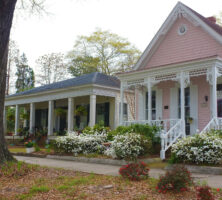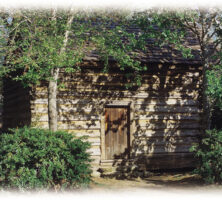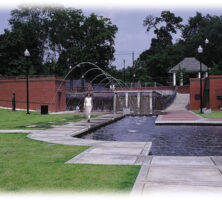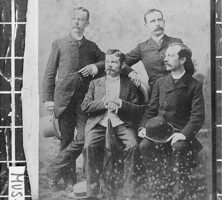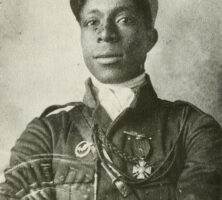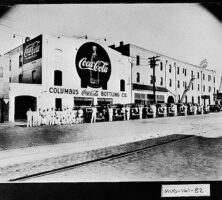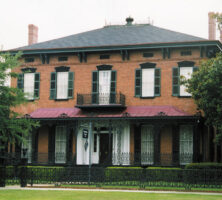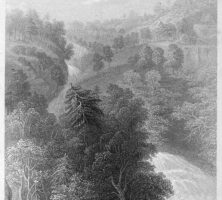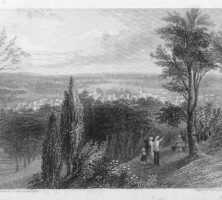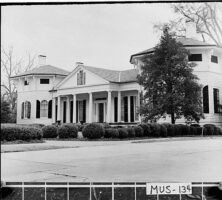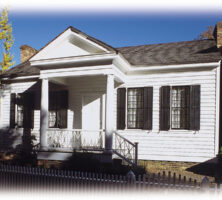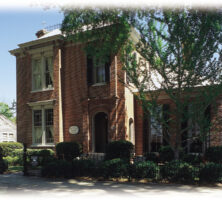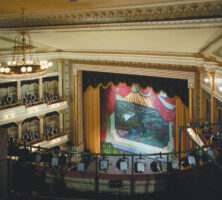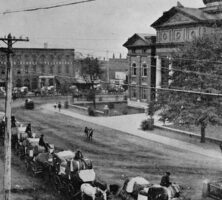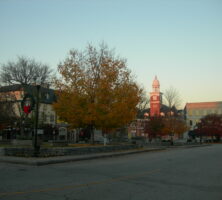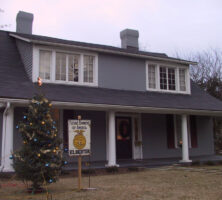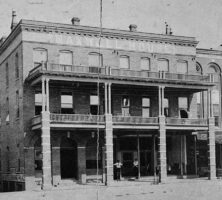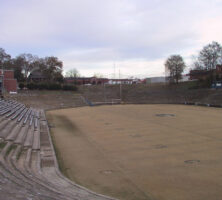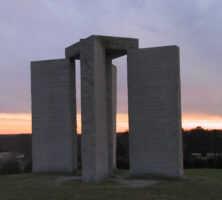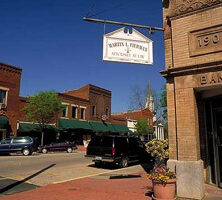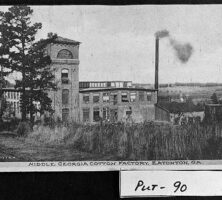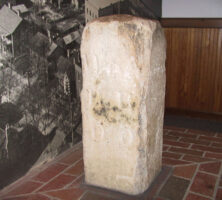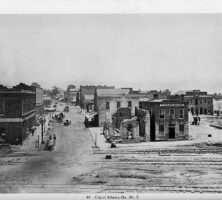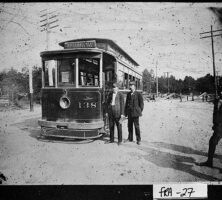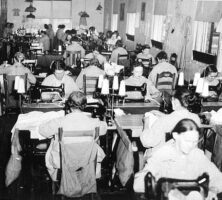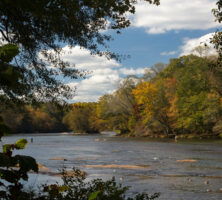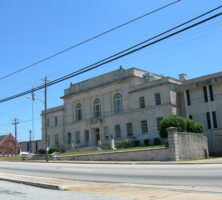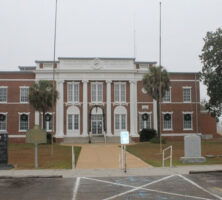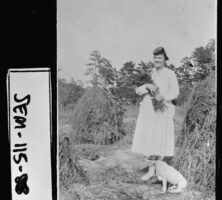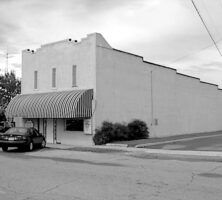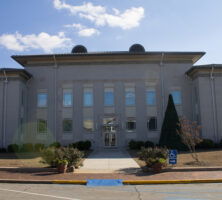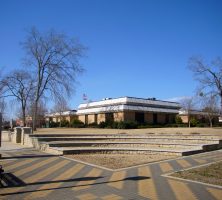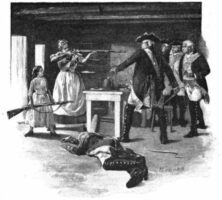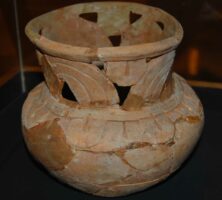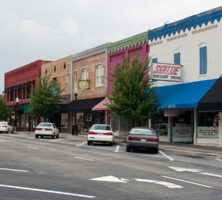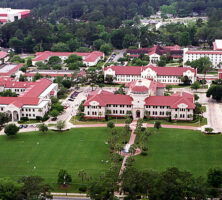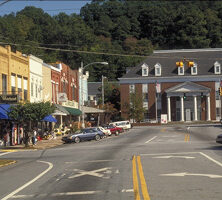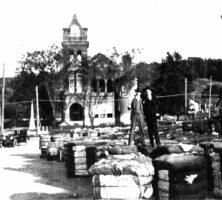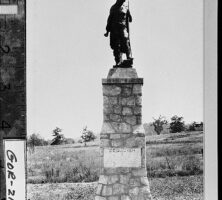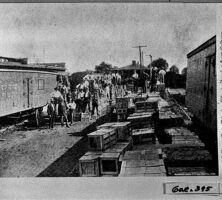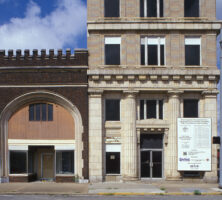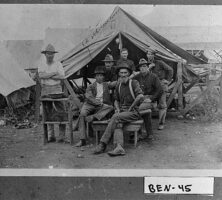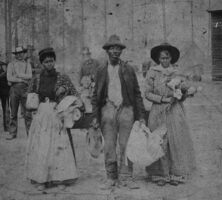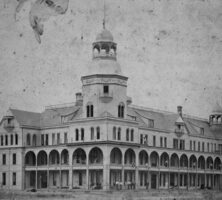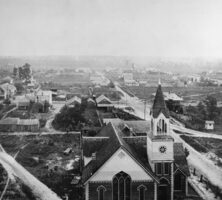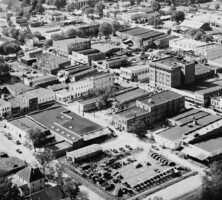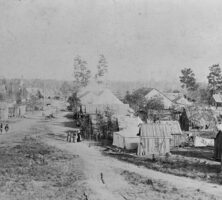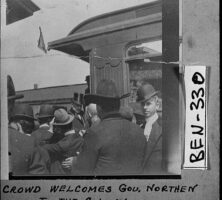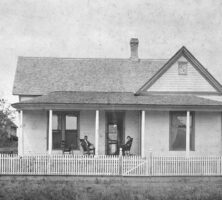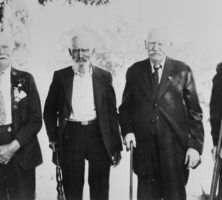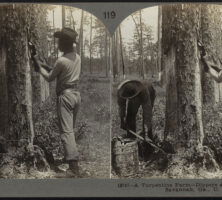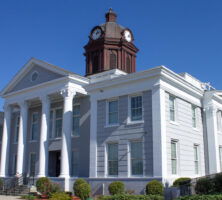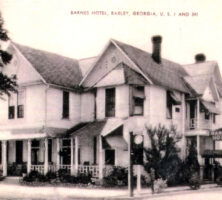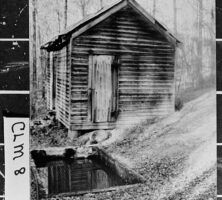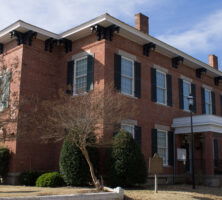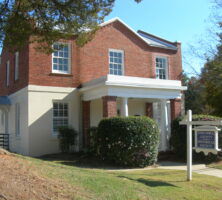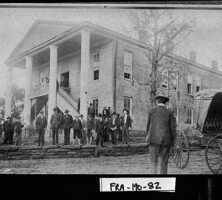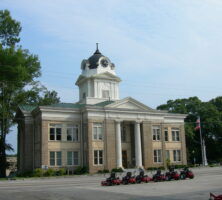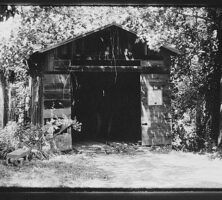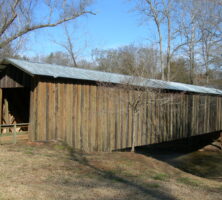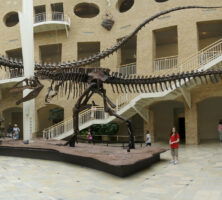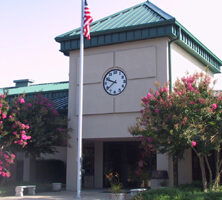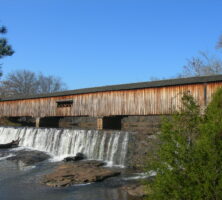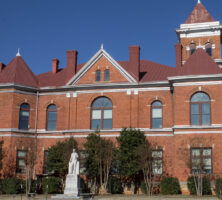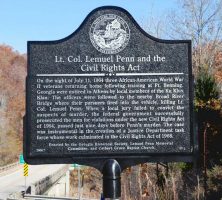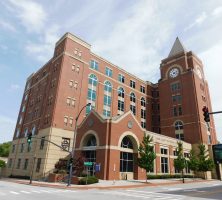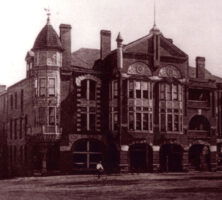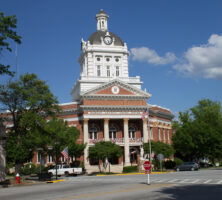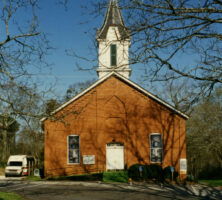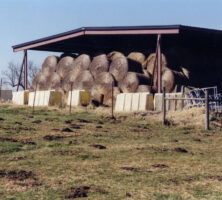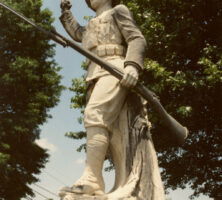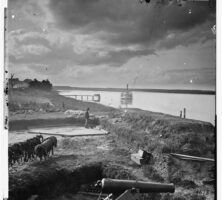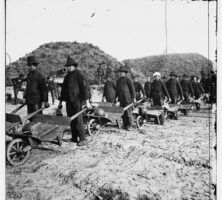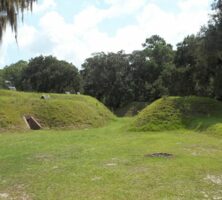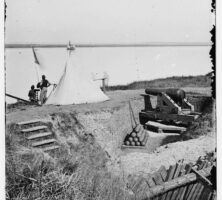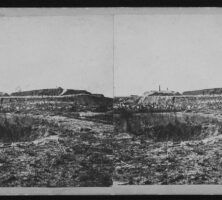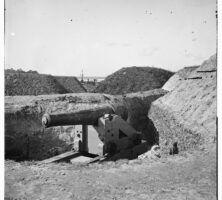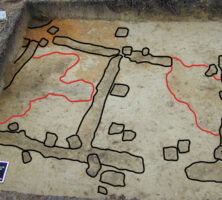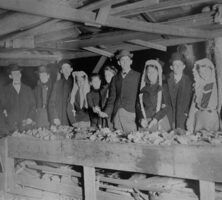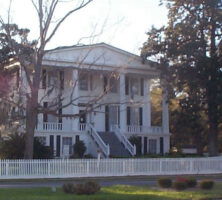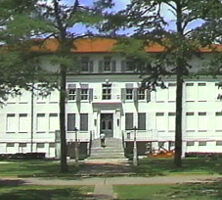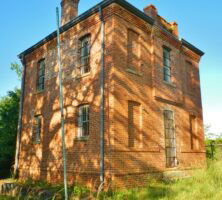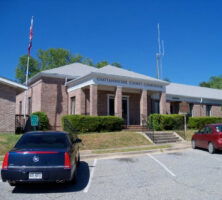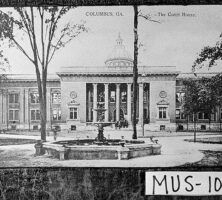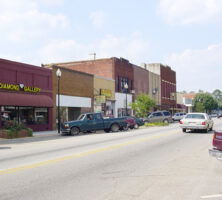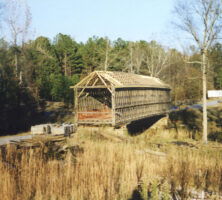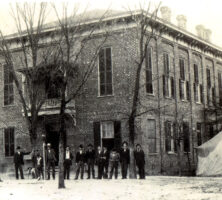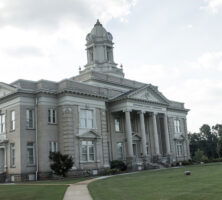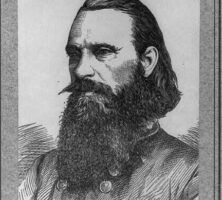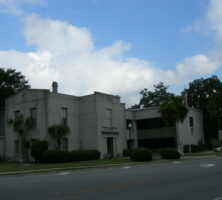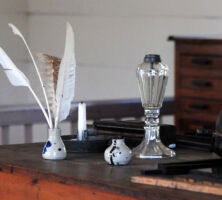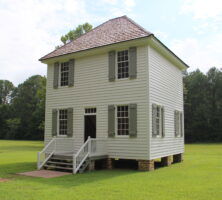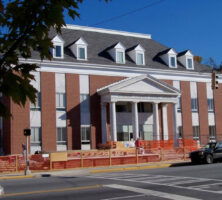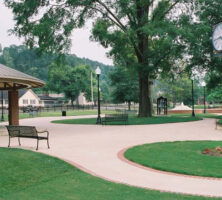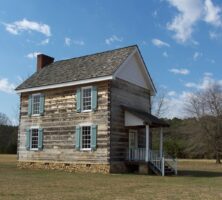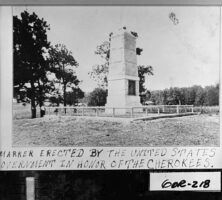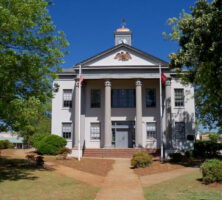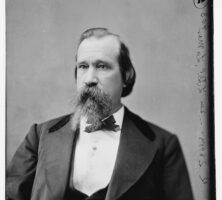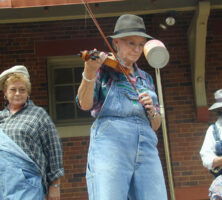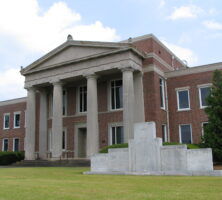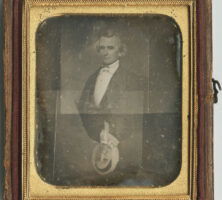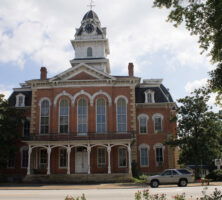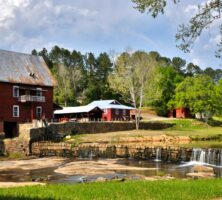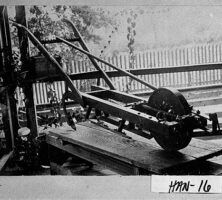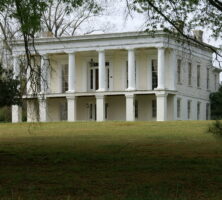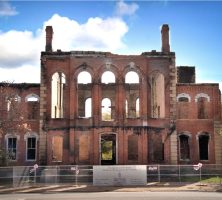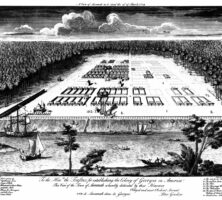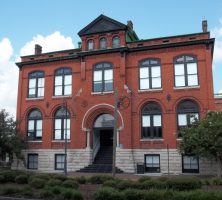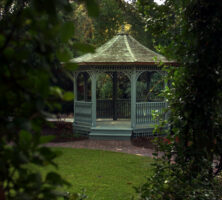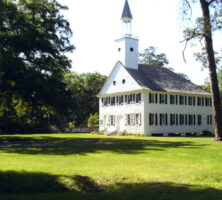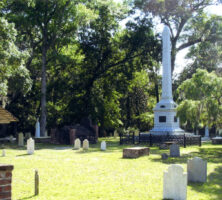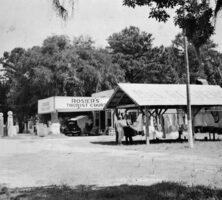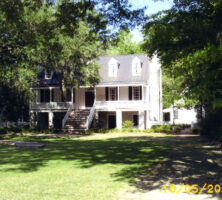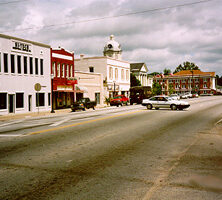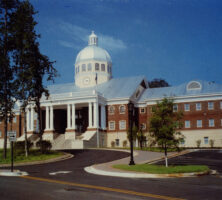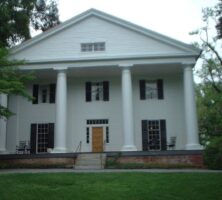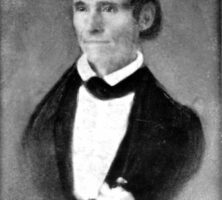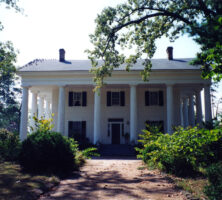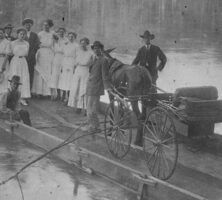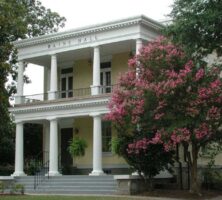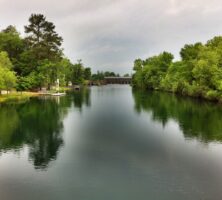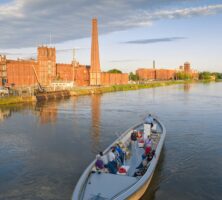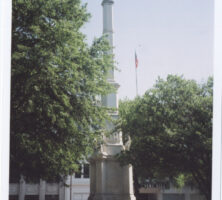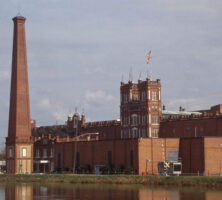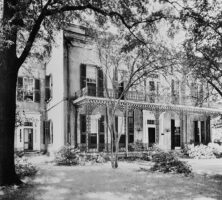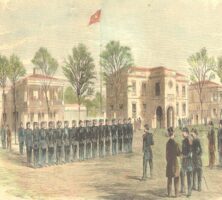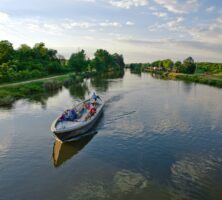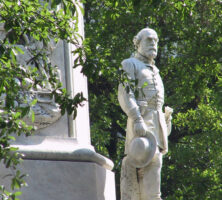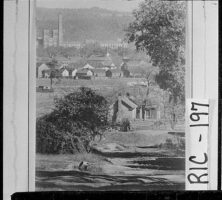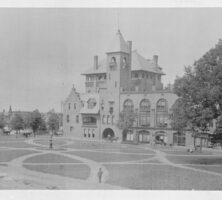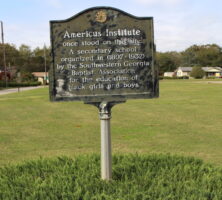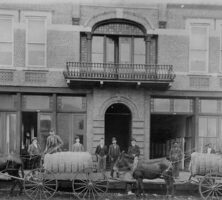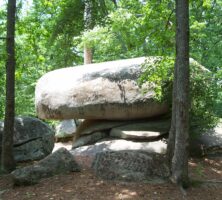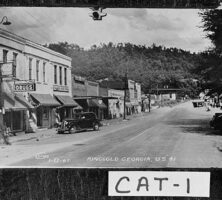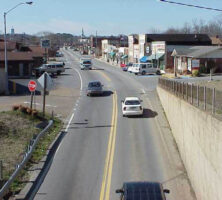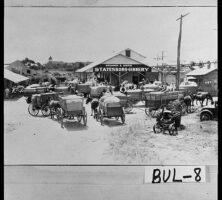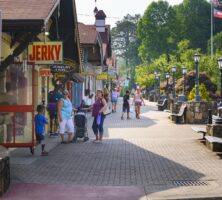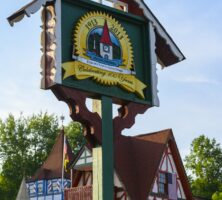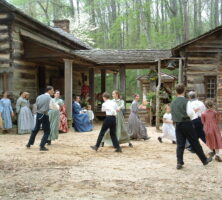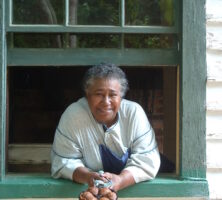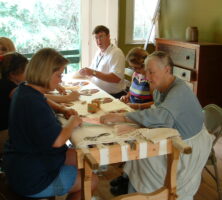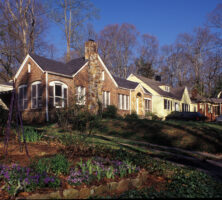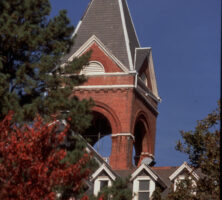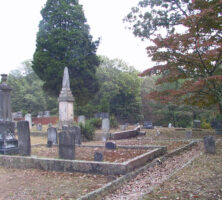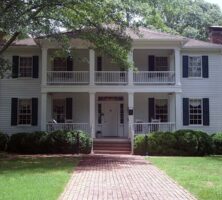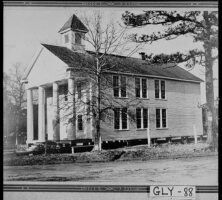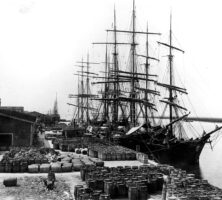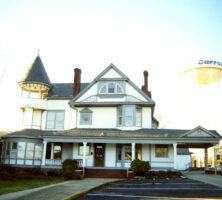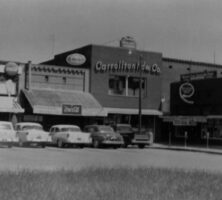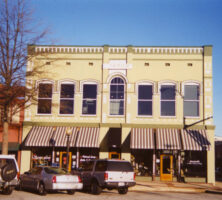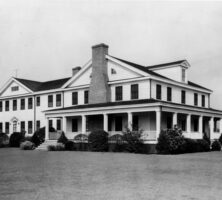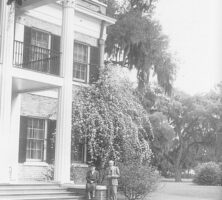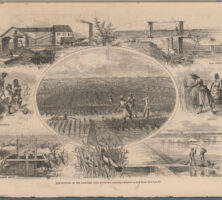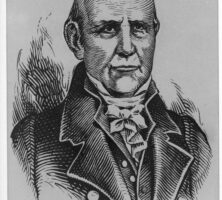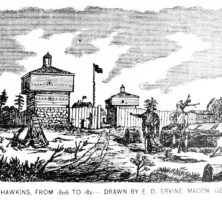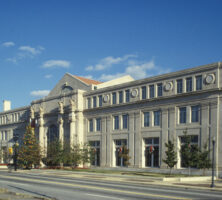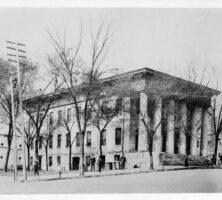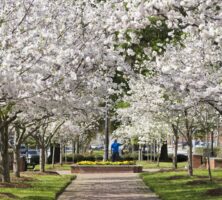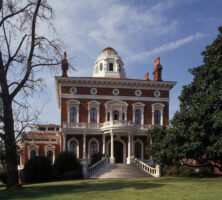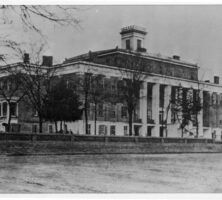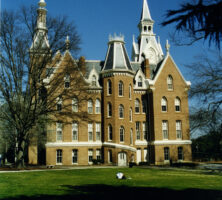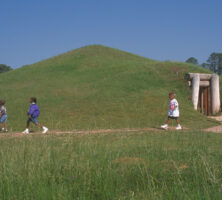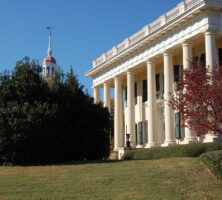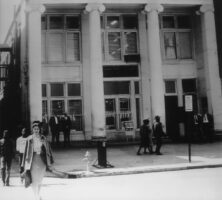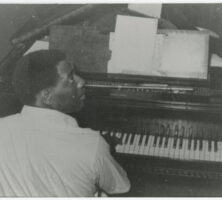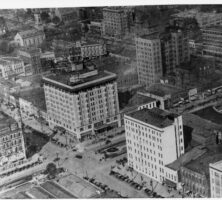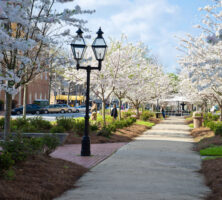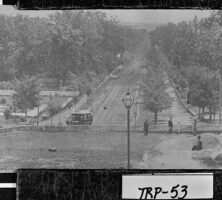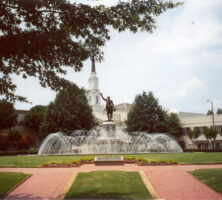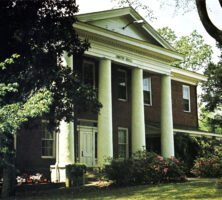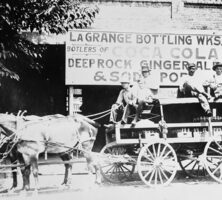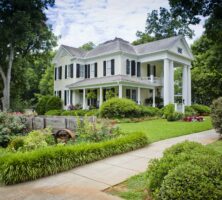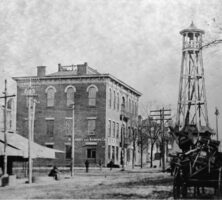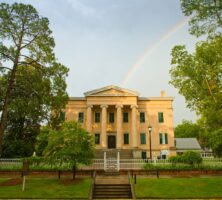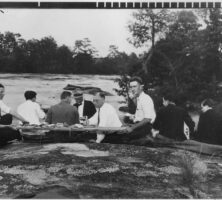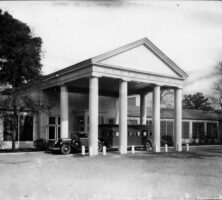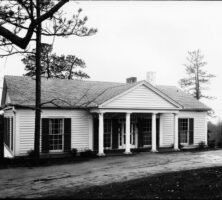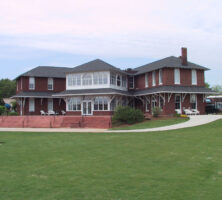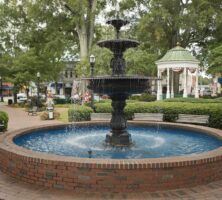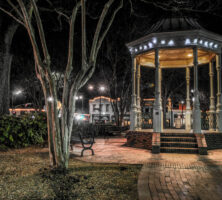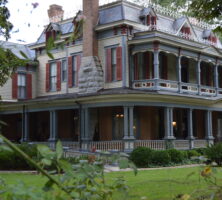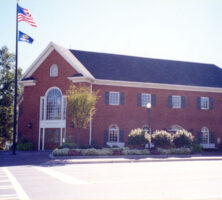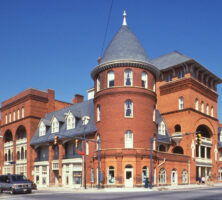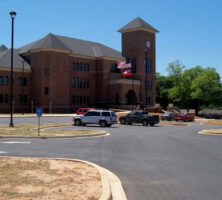The New Georgia Encyclopedia is supported by funding from A More Perfect Union, a special initiative of the National Endowment for the Humanities.
The Midtown skyline, seen here from Piedmont Park, reflects the neighborhood's dramatic growth. Midtown is the second-largest business district in Atlanta.
Photograph by Daniel Mayer
The New Georgia Encyclopedia does not hold the copyright for this media resource and can neither grant nor deny permission to republish or reproduce the image online or in print. All requests for permission to publish or reproduce the resource must be submitted to the rights holder.
Sections of Peachtree Street, Atlanta's primary thoroughfare, retained a rural character well into the late nineteenth century.
The New Georgia Encyclopedia does not hold the copyright for this media resource and can neither grant nor deny permission to republish or reproduce the image online or in print. Requests for permission to publish or reproduce the resource should be submitted to Special Collections and Archives at Georgia State University.
The Wimbish House is one of the last grand homes remaining on Peachtree Street. It was built in 1898 and designed by noted Atlanta architect W.T. Downing.
The New Georgia Encyclopedia does not hold the copyright for this media resource and can neither grant nor deny permission to republish or reproduce the image online or in print. Requests for permission to publish or reproduce the resource should be submitted to Special Collections and Archives at Georgia State University.
In the late 1960s and 1970s, Midtown became a haven for Atlanta's counterculture. Here, young residents of the neighborhood can be seen lounging at a local hangout in 1968.
The New Georgia Encyclopedia does not hold the copyright for this media resource and can neither grant nor deny permission to republish or reproduce the image online or in print. Requests for permission to publish or reproduce the resource should be submitted to Special Collections and Archives at Georgia State University.
Members of the Southern Element Flag Corps march down Peachtree Street in 1994 during the city's annual gay pride parade. A chapter of the Gay Liberation Front opened in Atlanta in 1971 and organized the city's first pride parade from 7th Street to Piedmont Park.
Courtesy of Atlanta Journal-Constitution.
The New Georgia Encyclopedia does not hold the copyright for this media resource and can neither grant nor deny permission to republish or reproduce the image online or in print. All requests for permission to publish or reproduce the resource must be submitted to the Atlanta Journal-Constitution.
Atlanta's Fox Theatre has seen more than $20 million in restoration projects since coming under the ownership of the nonprofit organization, Atlanta Landmarks, in 1975. The Fox was designated a National Historic Landmark in 1976.
The New Georgia Encyclopedia does not hold the copyright for this media resource and can neither grant nor deny permission to republish or reproduce the image online or in print. Requests for permission to publish or reproduce the resource may need to be submitted to the Georgia Department of Community Affairs, Historic Preservation Division.
The city of Dalton, founded as Cross Plains in 1837, is the seat of Whitfield County. Known as the carpet capital of the world, Dalton and the surrounding region produce most of the nation's tufted carpets.
Courtesy of Dalton Convention and Visitors Bureau
The New Georgia Encyclopedia does not hold the copyright for this media resource and can neither grant nor deny permission to republish or reproduce the image online or in print. All requests for permission to publish or reproduce the resource must be submitted to the rights holder.
An aerial photograph, taken in 1890, shows the north end of Dalton, the capital of Whitfield County.
Courtesy of Georgia Archives, Vanishing Georgia, # wtf025.
The New Georgia Encyclopedia does not hold the copyright for this media resource and can neither grant nor deny permission to republish or reproduce the image online or in print. Requests for permission to publish or reproduce the resource should be submitted to the Georgia Archives.
Located in Dalton, Whitfield County's second courthouse, pictured circa 1907, was built in 1891 to replace a wooden structure burned by Union troops during the Civil War. The second courthouse was used until 1960, when it was demolished.
Courtesy of Georgia Info, Digital Library of Georgia.
The New Georgia Encyclopedia does not hold the copyright for this media resource and can neither grant nor deny permission to republish or reproduce the image online or in print. Requests for permission to publish or reproduce the resource may need to be submitted to the Digital Library of Georgia.
Cotton farmers converge on Hamilton Street in Dalton, circa 1900. Agriculture was the predominant industry in the Dalton area until the end of the nineteenth century, when farming was largely supplanted by the textile industry.
Courtesy of Georgia Archives, Vanishing Georgia, #
wtf078.
The New Georgia Encyclopedia does not hold the copyright for this media resource and can neither grant nor deny permission to republish or reproduce the image online or in print. Requests for permission to publish or reproduce the resource should be submitted to the Georgia Archives.
Chenille bedspreads hang on a line in Dalton, where in 1895 resident Catherine Evans Whitener revived the craft of hand tufting. The resulting cottage industry for the production of chenille goods is credited as the origin of Dalton's renowned carpet industy.
Courtesy of Dalton Convention and Visitors Bureau
The New Georgia Encyclopedia does not hold the copyright for this media resource and can neither grant nor deny permission to republish or reproduce the image online or in print. All requests for permission to publish or reproduce the resource must be submitted to the rights holder.
Downtown Dalton, the seat of Whitfield County, is pictured in the 1950s. In the years following World War II (1941-45), the city experienced an economic boom with the growth of its carpet industry.
Courtesy of Sherry Cady
The New Georgia Encyclopedia does not hold the copyright for this media resource and can neither grant nor deny permission to republish or reproduce the image online or in print. All requests for permission to publish or reproduce the resource must be submitted to the rights holder.
The headquarters of World Carpets, pictured in 1969, featured a waterfall on its Morris Street side. World Carpets was founded in Dalton in 1954 by husband and wife Shaheen Shaheen and Piera Barbaglia.
From World Carpets: The First Thirty Years, by S. Shaheen
The New Georgia Encyclopedia does not hold the copyright for this media resource and can neither grant nor deny permission to republish or reproduce the image online or in print. All requests for permission to publish or reproduce the resource must be submitted to the rights holder.
Downtown Dalton in the twenty-first century features numerous attractions, including shopping and cultural events. The city is located in Whitfield County, eighty miles north of Atlanta.
Courtesy of Dalton Convention and Visitors Bureau
The New Georgia Encyclopedia does not hold the copyright for this media resource and can neither grant nor deny permission to republish or reproduce the image online or in print. All requests for permission to publish or reproduce the resource must be submitted to the rights holder.
The New Georgia Encyclopedia does not hold the copyright for this media resource and can neither grant nor deny permission to republish or reproduce the image online or in print. All requests for permission to publish or reproduce the resource must be submitted to the rights holder.
Hamilton Memorial Hospital, pictured circa 1930, was built in Dalton in 1918 during the influenza pandemic of that year.
Courtesy of Crown Gardens and Archives
The New Georgia Encyclopedia does not hold the copyright for this media resource and can neither grant nor deny permission to republish or reproduce the image online or in print. All requests for permission to publish or reproduce the resource must be submitted to the rights holder.
Streetscape of Dalton, the seat of Whitfield County, taken in the 1940s.
Courtesy of Sherry Cady
The New Georgia Encyclopedia does not hold the copyright for this media resource and can neither grant nor deny permission to republish or reproduce the image online or in print. All requests for permission to publish or reproduce the resource must be submitted to the rights holder.
The Glascock County Courthouse in Gibson was built in 1919 and remodeled in 1942. An extensive renovation of the interior was completed in 1973.
Courtesy of Don Bowman
The New Georgia Encyclopedia does not hold the copyright for this media resource and can neither grant nor deny permission to republish or reproduce the image online or in print. All requests for permission to publish or reproduce the resource must be submitted to the rights holder.
Comprising ten acres, Springvale Park is the centerpiece of the Inman Park neighborhood, which was established in the late 1880s. In 1903 Inman Park founder Joel Hurt hired landscape architect Frederick Law Olmsted to improve the park aesthetically.
Photograph by Ted Bazemore
The New Georgia Encyclopedia does not hold the copyright for this media resource and can neither grant nor deny permission to republish or reproduce the image online or in print. All requests for permission to publish or reproduce the resource must be submitted to the rights holder.
Atlanta's first planned garden suburb, Inman Park was envisioned as an oasis for the city's wealthy citizens. After a period of decline, the neighborhood underwent an extensive restoration, beginning in the 1970s.
Photograph by Ted Bazemore
The New Georgia Encyclopedia does not hold the copyright for this media resource and can neither grant nor deny permission to republish or reproduce the image online or in print. All requests for permission to publish or reproduce the resource must be submitted to the rights holder.
The Trolley Barn in Inman Park was the terminus for Atlanta's first electric streetcar line, which ran west to downtown. The barn was the repair depot for the streetcars. Today the building is used for community events.
Photograph by Ted Bazemore
The New Georgia Encyclopedia does not hold the copyright for this media resource and can neither grant nor deny permission to republish or reproduce the image online or in print. All requests for permission to publish or reproduce the resource must be submitted to the rights holder.
In 1969 Robert Griggs purchased and restored this Queen Anne-style house on Euclid Avenue, thereby launching the Inman Park restoration movement.
Photograph by Ted Bazemore
The New Georgia Encyclopedia does not hold the copyright for this media resource and can neither grant nor deny permission to republish or reproduce the image online or in print. All requests for permission to publish or reproduce the resource must be submitted to the rights holder.
The Beaux-Arts style Callan Castle (1902-4) was built in Inman Park for Coca-Cola Company founder Asa Candler.
Photograph by Ted Bazemore
The New Georgia Encyclopedia does not hold the copyright for this media resource and can neither grant nor deny permission to republish or reproduce the image online or in print. All requests for permission to publish or reproduce the resource must be submitted to the rights holder.
The town that is now Talking Rock, in Pickens County, was originally part of the Cherokee Nation. Today, the tiny town claims fewer than 100 residents.
Photograph by Pam Brannon
The New Georgia Encyclopedia does not hold the copyright for this media resource and can neither grant nor deny permission to republish or reproduce the image online or in print. All requests for permission to publish or reproduce the resource must be submitted to the rights holder.
The modern town of Talking Rock, in Pickens County, grew up around the railroad during the late nineteenth century. The town incorporated in 1883.
Photograph by Pam Brannon
The New Georgia Encyclopedia does not hold the copyright for this media resource and can neither grant nor deny permission to republish or reproduce the image online or in print. All requests for permission to publish or reproduce the resource must be submitted to the rights holder.
This old hotel in Talking Rock is a remnant from the town's era of prosperity. Before the turn of the twentieth century, Talking Rock boomed with the arrival of the railroad, the growth of the marble industry, and the thriving commerce of a factory, mills, cotton gins, and stores.
Courtesy of Robert Scott Davis
The New Georgia Encyclopedia does not hold the copyright for this media resource and can neither grant nor deny permission to republish or reproduce the image online or in print. All requests for permission to publish or reproduce the resource must be submitted to the rights holder.
Ludville Academy, pictured circa 1930, was built in the community of Ludville in 1877 and ten years later moved to Talking Rock, where it housed the first high school in Pickens County.
Courtesy of Georgia Archives, Vanishing Georgia, #
pck059-82.
The New Georgia Encyclopedia does not hold the copyright for this media resource and can neither grant nor deny permission to republish or reproduce the image online or in print. Requests for permission to publish or reproduce the resource should be submitted to the Georgia Archives.
Manchester, incorporated in 1909, was named for the industrial city in England. Although it is not the county seat, Manchester is the largest town in Meriwether County.
Photograph by Jim Corley
The New Georgia Encyclopedia does not hold the copyright for this media resource and can neither grant nor deny permission to republish or reproduce the image online or in print. All requests for permission to publish or reproduce the resource must be submitted to the rights holder.
The Callaway Mills textile plant was built in Manchester by Fuller E. Callaway in the early 1900s, and the annual company picnic was held every July 15, Callaway's birthday. Men are shown barbecuing pigs in preparation for the picnic.
Courtesy of Troup County Archives, Nix-Price Collection.
The New Georgia Encyclopedia does not hold the copyright for this media resource and can neither grant nor deny permission to republish or reproduce the image online or in print. All requests for permission to publish or reproduce the resource must be submitted to the rights holder.
Manchester native Stuart Woods is a successful popular-fiction writer. His first novel, Chiefs (1981), is set in the fictional town of Delano, which shares many similarities with Manchester.
Photograph by Mark Coggins
The New Georgia Encyclopedia does not hold the copyright for this media resource and can neither grant nor deny permission to republish or reproduce the image online or in print. All requests for permission to publish or reproduce the resource must be submitted to the rights holder.
Signs above the doors at a railroad station in Manchester (Meriwether County), pictured in 1944, read "Colored Men" and "Colored Waiting Room," indicating segregated facilities.
Courtesy of Library of Congress, Prints and Photographs Division, Farm Security Administration - Office of War Information Photograph Collection, #LC-USF3301-001172-M4.
The New Georgia Encyclopedia does not hold the copyright for this media resource and can neither grant nor deny permission to republish or reproduce the image online or in print. All requests for permission to publish or reproduce the resource must be submitted to the rights holder.
An aerial view of Callaway Mills in Manchester.
Courtesy of Troup County Archives, LaGrange, Callaway Educational Association Collection.
The New Georgia Encyclopedia does not hold the copyright for this media resource and can neither grant nor deny permission to republish or reproduce the image online or in print. All requests for permission to publish or reproduce the resource must be submitted to the rights holder.
The town of Flowery Branch is located on the shores of Lake Lanier in north Georgia. The name Flowery Branch is the translation of the Cherokee word Anaguluskee, the town's original name.
Image from G. DAWSON
The New Georgia Encyclopedia does not hold the copyright for this media resource and can neither grant nor deny permission to republish or reproduce the image online or in print. All requests for permission to publish or reproduce the resource must be submitted to the rights holder.
In this photograph, dated 1911, workers are installing waterworks along Main Street in Flowery Branch. The town, about twelve miles from Gainesville, was incorporated in 1983.
Courtesy of Georgia Archives, Vanishing Georgia, #
hal255.
The New Georgia Encyclopedia does not hold the copyright for this media resource and can neither grant nor deny permission to republish or reproduce the image online or in print. Requests for permission to publish or reproduce the resource should be submitted to the Georgia Archives.
The old Southern Railway depot in Flowery Branch was restored and converted to a community center in the 1970s. The Flowery Branch Museum is housed in the railroad car beside the depot.
Courtesy of Georgia Archives, Vanishing Georgia, #
hal219.
The New Georgia Encyclopedia does not hold the copyright for this media resource and can neither grant nor deny permission to republish or reproduce the image online or in print. Requests for permission to publish or reproduce the resource should be submitted to the Georgia Archives.
Downtown Plains is part of the attraction for tourists visiting the area. Tourism is the main industry for Plains today, but the area has primarily been a farming community for most of its history.
Courtesy of Explore Georgia, Photograph by Ralph Daniel.
The New Georgia Encyclopedia does not hold the copyright for this media resource and can neither grant nor deny permission to republish or reproduce the image online or in print. Requests for permission to publish or reproduce the resource may need to be submitted to Explore Georgia.
This historic postcard shows Main Street in downtown Plains in 1905. At the time, cotton farming was the largest local enterprise.
Courtesy of Georgia Archives, Vanishing Georgia, #sum135a.
The New Georgia Encyclopedia does not hold the copyright for this media resource and can neither grant nor deny permission to republish or reproduce the image online or in print. Requests for permission to publish or reproduce the resource should be submitted to the Georgia Archives.
Jimmy Carter's boyhood home and farm in Plains, where the family grew peanuts, are managed today by the National Park Service.
Photograph from National Park Service
The New Georgia Encyclopedia does not hold the copyright for this media resource and can neither grant nor deny permission to republish or reproduce the image online or in print. All requests for permission to publish or reproduce the resource must be submitted to the rights holder.
The New Georgia Encyclopedia does not hold the copyright for this media resource and can neither grant nor deny permission to republish or reproduce the image online or in print. All requests for permission to publish or reproduce the resource must be submitted to the rights holder.
In Plains Jimmy Carter teaches Sunday school at Maranatha Baptist Church, where a large crowd usuallly gathers to attend the class.
Courtesy of National Park Service
The New Georgia Encyclopedia does not hold the copyright for this media resource and can neither grant nor deny permission to republish or reproduce the image online or in print. All requests for permission to publish or reproduce the resource must be submitted to the rights holder.
Pelham, in Mitchell County, was incorporated in 1881 and named for a Civil War soldier.
Photograph by Greg Loyd
The New Georgia Encyclopedia does not hold the copyright for this media resource and can neither grant nor deny permission to republish or reproduce the image online or in print. All requests for permission to publish or reproduce the resource must be submitted to the rights holder.
The Hand Trading Company was the largest mercantile store in southwest Georgia in the early twentieth century. Pictured in 1918, the four-story retail emporium featured nearly 100,000 feet of floor space.
Courtesy of Georgia Archives, Vanishing Georgia, # mit022.
The New Georgia Encyclopedia does not hold the copyright for this media resource and can neither grant nor deny permission to republish or reproduce the image online or in print. Requests for permission to publish or reproduce the resource should be submitted to the Georgia Archives.
Located just outside the Pelham city limits, WABW-TV, Channel 14, is a full-power television station and a repeater of Georgia Public Broadcasting. The station's UHF tower broadcasts its signal as far south as Florida and well north of Albany.
Photograph by Greg Loyd
The New Georgia Encyclopedia does not hold the copyright for this media resource and can neither grant nor deny permission to republish or reproduce the image online or in print. All requests for permission to publish or reproduce the resource must be submitted to the rights holder.
The New Georgia Encyclopedia does not hold the copyright for this media resource and can neither grant nor deny permission to republish or reproduce the image online or in print. All requests for permission to publish or reproduce the resource must be submitted to the rights holder.
The New Georgia Encyclopedia does not hold the copyright for this media resource and can neither grant nor deny permission to republish or reproduce the image online or in print. All requests for permission to publish or reproduce the resource must be submitted to the rights holder.
The four-acre park, located on Lumber Street in Lincolnton, is the primary project of the Lincoln County Historical Society. Several nineteenth-century structures are preserved on the site.
Image from J Stephen Conn
The New Georgia Encyclopedia does not hold the copyright for this media resource and can neither grant nor deny permission to republish or reproduce the image online or in print. All requests for permission to publish or reproduce the resource must be submitted to the rights holder.
The New Georgia Encyclopedia does not hold the copyright for this media resource and can neither grant nor deny permission to republish or reproduce the image online or in print. All requests for permission to publish or reproduce the resource must be submitted to the rights holder.
William Henry Braselton, the first mayor of Braselton, built this house in the early 1900s. Today it is used as Braselton's town hall, and the structure is rumored to be haunted.
Image from Chris Pruitt
The New Georgia Encyclopedia does not hold the copyright for this media resource and can neither grant nor deny permission to republish or reproduce the image online or in print. All requests for permission to publish or reproduce the resource must be submitted to the rights holder.
The New Georgia Encyclopedia does not hold the copyright for this media resource and can neither grant nor deny permission to republish or reproduce the image online or in print. All requests for permission to publish or reproduce the resource must be submitted to the rights holder.
The Chateau Elan Resort and Winery in Braselton is a major tourist attraction northeast of Atlanta.
Image from Bruce Tuten
The New Georgia Encyclopedia does not hold the copyright for this media resource and can neither grant nor deny permission to republish or reproduce the image online or in print. All requests for permission to publish or reproduce the resource must be submitted to the rights holder.
The bell that once rang for the Braselton High School, from 1920 to 1957, now sits on the grounds of Braselton's town hall.
Courtesy of Britney Compton
The New Georgia Encyclopedia does not hold the copyright for this media resource and can neither grant nor deny permission to republish or reproduce the image online or in print. All requests for permission to publish or reproduce the resource must be submitted to the rights holder.
Road Atlanta, a 2.54-mile, 12-turn road-racing course in Braselton, is a major tourist attraction in Jackson County. The venue, part of the Panoz Motor Sports Group, offers a variety of motor-sport events, including sports car, motorcycle, and kart racing.
Image from Osajus Photography
The New Georgia Encyclopedia does not hold the copyright for this media resource and can neither grant nor deny permission to republish or reproduce the image online or in print. All requests for permission to publish or reproduce the resource must be submitted to the rights holder.
The Florence Marina State Park, about sixteen miles west of Lumpkin, is situated at the northern end of Lake Walter F. George. The park is one of many attractions in the area.
Courtesy of Matthew M. Moye
The New Georgia Encyclopedia does not hold the copyright for this media resource and can neither grant nor deny permission to republish or reproduce the image online or in print. All requests for permission to publish or reproduce the resource must be submitted to the rights holder.
Brigadier general Clement Anselm Evans, a Confederate war hero who later became a Methodist minister, was born and reared in Lumpkin. The Evans home was built circa 1835.
Courtesy of Matthew M. Moye
The New Georgia Encyclopedia does not hold the copyright for this media resource and can neither grant nor deny permission to republish or reproduce the image online or in print. All requests for permission to publish or reproduce the resource must be submitted to the rights holder.
The Bedingfield Inn, pictured before its restoration in 1965, was built in the antebellum era, when Lumpkin served as a stagecoach stop. Restoring the inn became the first small-town community preservation project in Georgia.
Courtesy of Stewart County Historical Commission
The New Georgia Encyclopedia does not hold the copyright for this media resource and can neither grant nor deny permission to republish or reproduce the image online or in print. All requests for permission to publish or reproduce the resource must be submitted to the rights holder.
The Pike County Courthouse, designed in the Romanesque revival and colonial revival styles, was built in Zebulon in 1895. It is the county's third courthouse.
Courtesy of Don Bowman
The New Georgia Encyclopedia does not hold the copyright for this media resource and can neither grant nor deny permission to republish or reproduce the image online or in print. All requests for permission to publish or reproduce the resource must be submitted to the rights holder.
Workers load logs for transport at a sawmill in Pike County, circa 1910. The timber industry continues to be an important economic activity in Pike County, which was created by the state legislature in 1822.
Courtesy of Georgia Archives, Vanishing Georgia, #
pik001.
The New Georgia Encyclopedia does not hold the copyright for this media resource and can neither grant nor deny permission to republish or reproduce the image online or in print. Requests for permission to publish or reproduce the resource should be submitted to the Georgia Archives.
The Newton County Courthouse rises over downtown Covington, known as both "the city of beautiful homes" and as "a full-service city." The city supports an active Main Street program, which revitalized the historic downtown and created new economic opportunity for Covington residents.
Image from Neal Wellons
The New Georgia Encyclopedia does not hold the copyright for this media resource and can neither grant nor deny permission to republish or reproduce the image online or in print. All requests for permission to publish or reproduce the resource must be submitted to the rights holder.
A monument in downtown Covington reads: "In loving and grateful memory of those citizens of Newton County who gave their lives in the defense of our country."
Photograph by Kate Howard, New Georgia Encyclopedia
The New Georgia Encyclopedia does not hold the copyright for this media resource and can neither grant nor deny permission to republish or reproduce the image online or in print. All requests for permission to publish or reproduce the resource must be submitted to the rights holder.
Cast members of the television series In the Heat of the Night pose during the filming of an episode in downtown Covington, circa 1994. From left, Denise Nicholas (Harriet DeLong), Carroll O'Connor (Sheriff Bill Gillespie), and Carl Weathers (Chief Hampton Forbes).
Courtesy of Georgia Department of Economic Development.
The New Georgia Encyclopedia does not hold the copyright for this media resource and can neither grant nor deny permission to republish or reproduce the image online or in print. Requests for permission to publish or reproduce the resource may need to be submitted to the Georgia Department of Economic Development.
Tunnel Hill, a city in Whitfield County, was named for the 1,477-foot railroad tunnel exacavated through the Chetoogeta Ridge in 1848-49. The city served in 1864 as a winter camp for General Joseph E. Johnston's Confederate troops during the Civil War.
Photograph by Ethan Geer
The New Georgia Encyclopedia does not hold the copyright for this media resource and can neither grant nor deny permission to republish or reproduce the image online or in print. All requests for permission to publish or reproduce the resource must be submitted to the rights holder.
The Whitfield County Courthouse, located in Dalton, was completed in 2006. Designed in the modern style, the structure incorporates the previous courthouse, which was built on the site in 1961.
Photograph by Jimmy Emerson, DVM
The New Georgia Encyclopedia does not hold the copyright for this media resource and can neither grant nor deny permission to republish or reproduce the image online or in print. All requests for permission to publish or reproduce the resource must be submitted to the rights holder.
Crown Cotton Mill No. 2, located on Chattanooga Avenue in Dalton, is pictured in the late 1920s. Established in 1884, Crown Cotton Mill brought much-needed economic activity to Whitfield County and by 1916 employed 1,000 workers.
Courtesy of Georgia Archives, Vanishing Georgia, #
wtf014b.
The New Georgia Encyclopedia does not hold the copyright for this media resource and can neither grant nor deny permission to republish or reproduce the image online or in print. Requests for permission to publish or reproduce the resource should be submitted to the Georgia Archives.
Mill houses line a street in Dalton, circa 1930. The carpet and textile industries in the city began in the late nineteenth century with the tufted bedspreads of Catherine Evans Whitener and by the 1940s had developed into a mechanized industry in Whitfield County.
Courtesy of Georgia Archives, Vanishing Georgia, #
wtf013a.
The New Georgia Encyclopedia does not hold the copyright for this media resource and can neither grant nor deny permission to republish or reproduce the image online or in print. Requests for permission to publish or reproduce the resource should be submitted to the Georgia Archives.
The Wayne County Courthouse, designed in the Romanesque revival style, was completed in 1903. Located in Jesup, the building was added to the National Register of Historic Places in 1980.
Courtesy of Don Bowman
The New Georgia Encyclopedia does not hold the copyright for this media resource and can neither grant nor deny permission to republish or reproduce the image online or in print. All requests for permission to publish or reproduce the resource must be submitted to the rights holder.
Kayakers paddle down a stretch of the Altamaha River. The river played an integral role in the county's timber industry during the early nineteenth century as a means for transporting logs to the coast.
Courtesy of Explore Georgia, Photograph by Ralph Daniel.
The New Georgia Encyclopedia does not hold the copyright for this media resource and can neither grant nor deny permission to republish or reproduce the image online or in print. Requests for permission to publish or reproduce the resource may need to be submitted to Explore Georgia.
Although the Darien economy is dependent on tourism, many locals continue to make a living through offshore fishing and shrimping.
Courtesy of Explore Georgia, Photograph by Ralph Daniel.
The New Georgia Encyclopedia does not hold the copyright for this media resource and can neither grant nor deny permission to republish or reproduce the image online or in print. Requests for permission to publish or reproduce the resource may need to be submitted to Explore Georgia.
Hickory Hill, pictured circa 1910, was the home of noted senator and publisher Thomas E. Watson. Located in Thomson, the historic home, renovated to its 1920s appearance, is open to the public for tours by appointment.
Courtesy of Georgia Archives, Vanishing Georgia, #
cob706.
The New Georgia Encyclopedia does not hold the copyright for this media resource and can neither grant nor deny permission to republish or reproduce the image online or in print. Requests for permission to publish or reproduce the resource should be submitted to the Georgia Archives.
The McDuffie County Courthouse, located in Thomson, was built in 1872. Major renovations to the courthouse, the county's first, were made in 1934 and 1970.
Courtesy of Don Bowman
The New Georgia Encyclopedia does not hold the copyright for this media resource and can neither grant nor deny permission to republish or reproduce the image online or in print. All requests for permission to publish or reproduce the resource must be submitted to the rights holder.
Rock House, built in 1785 near the Quaker community of Wrightsborough in McDuffie County, is considered to be the oldest standing building in Georgia with its original architecture intact.
Image from Jimmy Emerson, DVM
The New Georgia Encyclopedia does not hold the copyright for this media resource and can neither grant nor deny permission to republish or reproduce the image online or in print. All requests for permission to publish or reproduce the resource must be submitted to the rights holder.
The New Georgia Encyclopedia does not hold the copyright for this media resource and can neither grant nor deny permission to republish or reproduce the image online or in print. All requests for permission to publish or reproduce the resource must be submitted to the rights holder.
The gold-topped Price Memorial Hall, on the campus of North Georgia College and State University, rises above Dahlonega, the seat of Lumpkin County. The site of a gold rush in 1828-29, Dahlonega today attracts tourists interested in both its history and scenic mountain setting.
Image from davidaabrown
The New Georgia Encyclopedia does not hold the copyright for this media resource and can neither grant nor deny permission to republish or reproduce the image online or in print. All requests for permission to publish or reproduce the resource must be submitted to the rights holder.
In 1838 a federal Branch Mint went into operation at Dahlonega. It coined more than $100,000 worth of gold in its first year, and by the time it closed in 1861, it had produced almost 1.5 million gold coins with a face value of more than $6 million.
Courtesy of Dahlonega Mountain Signal
The New Georgia Encyclopedia does not hold the copyright for this media resource and can neither grant nor deny permission to republish or reproduce the image online or in print. All requests for permission to publish or reproduce the resource must be submitted to the rights holder.
Construction of the Consolidated Gold Mining Company began in Dahlonega in 1899, during a revived interest in the area's gold. The company was the largest gold-processing plant east of the Mississippi River.
Courtesy of Georgia Archives, Vanishing Georgia, #
lum133.
The New Georgia Encyclopedia does not hold the copyright for this media resource and can neither grant nor deny permission to republish or reproduce the image online or in print. Requests for permission to publish or reproduce the resource should be submitted to the Georgia Archives.
The Dahlonega Gold Museum, one of the city's many tourist attractions, is housed in the historic Lumpkin County Courthouse, built in 1836. The museum documents the importance of gold to the area's history and economy.
Courtesy of Explore Georgia, Photograph by Ralph Daniel.
The New Georgia Encyclopedia does not hold the copyright for this media resource and can neither grant nor deny permission to republish or reproduce the image online or in print. Requests for permission to publish or reproduce the resource may need to be submitted to Explore Georgia.
The New Georgia Encyclopedia does not hold the copyright for this media resource and can neither grant nor deny permission to republish or reproduce the image online or in print. All requests for permission to publish or reproduce the resource must be submitted to the rights holder.
Three Frenchmen brought a couple of dancing bears to Dahlonega for a show in 1892.
Courtesy of Georgia Archives, Vanishing Georgia, # lum058.
The New Georgia Encyclopedia does not hold the copyright for this media resource and can neither grant nor deny permission to republish or reproduce the image online or in print. Requests for permission to publish or reproduce the resource should be submitted to the Georgia Archives.
A gold-mining operation near Dahlonega is pictured circa 1910.
Courtesy of Georgia Archives, Vanishing Georgia, #
lum211.
The New Georgia Encyclopedia does not hold the copyright for this media resource and can neither grant nor deny permission to republish or reproduce the image online or in print. Requests for permission to publish or reproduce the resource should be submitted to the Georgia Archives.
The old courthouse in Wilkes County, pictured circa 1890, was constructed in 1817 and served until 1904.
Courtesy of Georgia Archives, Vanishing Georgia, #
wlk142b.
The New Georgia Encyclopedia does not hold the copyright for this media resource and can neither grant nor deny permission to republish or reproduce the image online or in print. Requests for permission to publish or reproduce the resource should be submitted to the Georgia Archives.
The Wilkes County Courthouse, completed in 1904, is designed with a Richardsonian Romanesque influence. Located in Washington, the courthouse is the county's second.
Courtesy of Don Bowman
The New Georgia Encyclopedia does not hold the copyright for this media resource and can neither grant nor deny permission to republish or reproduce the image online or in print. All requests for permission to publish or reproduce the resource must be submitted to the rights holder.
A wagon loaded with cotton, pictured circa 1900, stands on West Main Street in Washington, the seat of Wilkes County. Cotton was a major cash crop in the county throughout the nineteenth century and into the early twentieth century, ending with the boll weevil invasion.
Courtesy of Georgia Archives, Vanishing Georgia, #wlk011.
The New Georgia Encyclopedia does not hold the copyright for this media resource and can neither grant nor deny permission to republish or reproduce the image online or in print. Requests for permission to publish or reproduce the resource should be submitted to the Georgia Archives.
The Wilcox County Courthouse, built in Abbeville in 1903, is designed in the neoclassical revival style. It is the county's second courthouse.
Courtesy of Don Bowman
The New Georgia Encyclopedia does not hold the copyright for this media resource and can neither grant nor deny permission to republish or reproduce the image online or in print. All requests for permission to publish or reproduce the resource must be submitted to the rights holder.
Workmen in Wilcox County, pictured circa 1915, stand on white-oak barrel staves, which were shipped overseas for use in whiskey barrels.
Courtesy of Georgia Archives, Vanishing Georgia, #
wlc005.
The New Georgia Encyclopedia does not hold the copyright for this media resource and can neither grant nor deny permission to republish or reproduce the image online or in print. Requests for permission to publish or reproduce the resource should be submitted to the Georgia Archives.
The New Georgia Encyclopedia does not hold the copyright for this media resource and can neither grant nor deny permission to republish or reproduce the image online or in print. All requests for permission to publish or reproduce the resource must be submitted to the rights holder.
General Joseph Wheeler, born near Augusta, commanded U.S. volunteers in Cuba during the Spanish-American War. Wheeler also served during the Civil War and the Philippine Insurrection, and authored several books on military and civil subjects. Wheeler County, in central Georgia, is named in his honor.
From The Conflict with Spain and Conquest of the Philippines, by H. F. Keenan
The New Georgia Encyclopedia does not hold the copyright for this media resource and can neither grant nor deny permission to republish or reproduce the image online or in print. All requests for permission to publish or reproduce the resource must be submitted to the rights holder.
The Wheeler County Courthouse, built in Alamo in 1917, is designed in the neoclassical revival style. Restored in 1961, it is the county's second official courthouse.
Courtesy of Don Bowman
The New Georgia Encyclopedia does not hold the copyright for this media resource and can neither grant nor deny permission to republish or reproduce the image online or in print. All requests for permission to publish or reproduce the resource must be submitted to the rights holder.
Passengers pose for a photograph, circa 1901, at Gallemore, a community in Twiggs County located between Macon and Danville. Railroad construction played a key role in the settlement patterns of Twiggs County in the late nineteenth and early twentieth centuries.
Courtesy of Georgia Archives, Vanishing Georgia, #
bib050.
The New Georgia Encyclopedia does not hold the copyright for this media resource and can neither grant nor deny permission to republish or reproduce the image online or in print. Requests for permission to publish or reproduce the resource should be submitted to the Georgia Archives.
The Twiggs County Courthouse, located in Jeffersonville, was completed in 1904. Designed in the Romanesque revival style, the courthouse was renovated in 1979 and expanded between 1996 and 2003.
Courtesy of Don Bowman
The New Georgia Encyclopedia does not hold the copyright for this media resource and can neither grant nor deny permission to republish or reproduce the image online or in print. All requests for permission to publish or reproduce the resource must be submitted to the rights holder.
Workers harvest and distill turpentine at a still near Pembroke, which was founded as a railroad town and turpentine-shipping center in 1890. Incorporated in 1905, Pembroke became the seat of Bryan County in 1937.
Courtesy of Library of Congress, Prints and Photographs Division, Farm Security Administration - Office of War Information Photograph Collection, #LC-USF34-043792-D.
The New Georgia Encyclopedia does not hold the copyright for this media resource and can neither grant nor deny permission to republish or reproduce the image online or in print. All requests for permission to publish or reproduce the resource must be submitted to the rights holder.
The Byron depot has been restored and now serves as a museum housing photographs and other memorabilia of the city's history.
The New Georgia Encyclopedia does not hold the copyright for this media resource and can neither grant nor deny permission to republish or reproduce the image online or in print. Requests for permission to publish or reproduce the resource may need to be submitted to the Georgia Department of Community Affairs, Historic Preservation Division.
Harvesting peaches in Peach County, the self-proclaimed "Peach Capital of the World."
Courtesy of Explore Georgia, Photograph by Andrew Thomas Lee.
The New Georgia Encyclopedia does not hold the copyright for this media resource and can neither grant nor deny permission to republish or reproduce the image online or in print. Requests for permission to publish or reproduce the resource may need to be submitted to Explore Georgia.
Queen Elizabeth Joyner rides a float from Americus–Sumter County in the Peach Parade, held during Fort Valley's Peach Blossom Festival in the mid-1920s. Fort Valley is the seat of Peach County, the self-proclaimed "Peach Capital of the World."
Courtesy of Georgia Archives, Vanishing Georgia, #
sum095.
The New Georgia Encyclopedia does not hold the copyright for this media resource and can neither grant nor deny permission to republish or reproduce the image online or in print. Requests for permission to publish or reproduce the resource should be submitted to the Georgia Archives.
The New Georgia Encyclopedia does not hold the copyright for this media resource and can neither grant nor deny permission to republish or reproduce the image online or in print. All requests for permission to publish or reproduce the resource must be submitted to the rights holder.
The Peach County Courthouse, built in 1936, was designed in the colonial revival style. The courthouse, located in Fort Valley, was expanded in 1970 and again in the 1990s.
Courtesy of Don Bowman
The New Georgia Encyclopedia does not hold the copyright for this media resource and can neither grant nor deny permission to republish or reproduce the image online or in print. All requests for permission to publish or reproduce the resource must be submitted to the rights holder.
Fort Valley State University, located in Peach County, is one of ten historically Black colleges and universities in the state. Since the advent of the HOPE scholarship program in 1993, enrollment by Georgia students at historically Black schools in other states has decreased.
The New Georgia Encyclopedia does not hold the copyright for this media resource and can neither grant nor deny permission to republish or reproduce the image online or in print. Requests for permission to publish or reproduce the resource may need to be submitted to the Georgia Department of Community Affairs, Historic Preservation Division.
Built in 1915, the Lincoln County Courthouse is designed in the neoclassical revival style. Listed on the National Register of Historic Places, the courthouse is the third to be built in Lincolnton, the county seat.
Courtesy of Don Bowman
The New Georgia Encyclopedia does not hold the copyright for this media resource and can neither grant nor deny permission to republish or reproduce the image online or in print. All requests for permission to publish or reproduce the resource must be submitted to the rights holder.
The New Georgia Encyclopedia does not hold the copyright for this media resource and can neither grant nor deny permission to republish or reproduce the image online or in print. All requests for permission to publish or reproduce the resource must be submitted to the rights holder.
Mulberry Christian Methodist Episcopal Church was built in 1873 and offered church services and a school to Black residents of Lincolnton, the seat of Lincoln County. A congregation of approximately 200 members continues to meet in the church.
Courtesy of Lincolnton-Lincoln County Chamber of Commerce
The New Georgia Encyclopedia does not hold the copyright for this media resource and can neither grant nor deny permission to republish or reproduce the image online or in print. All requests for permission to publish or reproduce the resource must be submitted to the rights holder.
The Treutlen County Courthouse, built in Soperton in 1920, is designed in the neoclassical revival style. The county's original courthouse, it was renovated in 1976 and added to the National Register of Historic Places in 1980.
Photograph by Jimmy Emerson, DVM
The New Georgia Encyclopedia does not hold the copyright for this media resource and can neither grant nor deny permission to republish or reproduce the image online or in print. All requests for permission to publish or reproduce the resource must be submitted to the rights holder.
The New Georgia Encyclopedia does not hold the copyright for this media resource and can neither grant nor deny permission to republish or reproduce the image online or in print. All requests for permission to publish or reproduce the resource must be submitted to the rights holder.
The Telfair County Courthouse, built in 1934, is designed in the colonial revival style. It is the second courthouse to be built in McRae, which became the county seat in 1871. At least two other courthouses were built during the nineteenth century in Telfair County's first seat, Jacksonville.
Courtesy of Don Bowman
The New Georgia Encyclopedia does not hold the copyright for this media resource and can neither grant nor deny permission to republish or reproduce the image online or in print. All requests for permission to publish or reproduce the resource must be submitted to the rights holder.
The McLeod Hotel, pictured circa 1890, was located in Lumber City, which boasted the largest sawmill in the South at the time of its incorporation in 1889. Today Lumber City is one of six incorporated cities in Telfair County.
Courtesy of Georgia Archives, Vanishing Georgia, #
tel003.
The New Georgia Encyclopedia does not hold the copyright for this media resource and can neither grant nor deny permission to republish or reproduce the image online or in print. Requests for permission to publish or reproduce the resource should be submitted to the Georgia Archives.
The New Georgia Encyclopedia does not hold the copyright for this media resource and can neither grant nor deny permission to republish or reproduce the image online or in print. All requests for permission to publish or reproduce the resource must be submitted to the rights holder.
A Register and Glennville train, pictured in 1906, stops at the depot in Glennville, today the largest city in Tattnall County. The R&G Railroad was renamed the East Georgia Railway in 1914.
Courtesy of Georgia Archives, Vanishing Georgia, #
tat017.
The New Georgia Encyclopedia does not hold the copyright for this media resource and can neither grant nor deny permission to republish or reproduce the image online or in print. Requests for permission to publish or reproduce the resource should be submitted to the Georgia Archives.
The Tattnall County Courthouse, built in Reidsville in 1902, was most recently renovated in 1991. Designed with a Second Empire influence, the courthouse is the county's third.
Courtesy of Don Bowman
The New Georgia Encyclopedia does not hold the copyright for this media resource and can neither grant nor deny permission to republish or reproduce the image online or in print. All requests for permission to publish or reproduce the resource must be submitted to the rights holder.
Workers, pictured circa 1910, pose at the sawmill of Frank Southwell near Mendes, in Tattnall County. The largely agricultural economy of the county in the nineteenth century supported a number of mills, many of which were built by 1849.
Courtesy of Georgia Archives, Vanishing Georgia, #
tat054.
The New Georgia Encyclopedia does not hold the copyright for this media resource and can neither grant nor deny permission to republish or reproduce the image online or in print. Requests for permission to publish or reproduce the resource should be submitted to the Georgia Archives.
Gordonia-Alatamaha State Park, located in Tattnall County, is named for the endangered Gordonia bay tree, a relative of the rare Franklin tree discovered in 1765 by John and William Bartram. The park offers facilities for fishing, boating, and camping, as well as an eighteen-hole golf course.
Courtesy of Explore Georgia, Photograph by Ralph Daniel.
The New Georgia Encyclopedia does not hold the copyright for this media resource and can neither grant nor deny permission to republish or reproduce the image online or in print. Requests for permission to publish or reproduce the resource may need to be submitted to Explore Georgia.
The Georgia Historical Commission gained national recognition as a pioneer in state historic preservation. The commission erected some 1,800 historical markers. This marker designates the site of the Cedar Creek Primitive Baptist Church, established in 1813 in Tattnall County.
Courtesy of Georgia Info, Digital Library of Georgia.
The New Georgia Encyclopedia does not hold the copyright for this media resource and can neither grant nor deny permission to republish or reproduce the image online or in print. Requests for permission to publish or reproduce the resource may need to be submitted to the Digital Library of Georgia.
Constructed in 1825, the original Fayette County Courthouse, pictured in the late 1880s, is listed on the National Register of Historic Places as the oldest courthouse in Georgia. The clock tower was added to the structure in 1888.
Courtesy of Fayette County Historical Society
The New Georgia Encyclopedia does not hold the copyright for this media resource and can neither grant nor deny permission to republish or reproduce the image online or in print. All requests for permission to publish or reproduce the resource must be submitted to the rights holder.
Fayette County's first courthouse (in use from 1825 until 1965) is the oldest county courthouse in the State of Georgia. Today the building houses the Fayette County Chamber of Commerce and the Fayette County Development Authority.
Image from Jimmy Emerson, DVM
The New Georgia Encyclopedia does not hold the copyright for this media resource and can neither grant nor deny permission to republish or reproduce the image online or in print. All requests for permission to publish or reproduce the resource must be submitted to the rights holder.
The Holliday-Dorsey-Fife House in Fayetteville, designed in the Greek revival style, was built in 1855 by John Stiles Holliday, the uncle of "Doc" Holliday. The city bought the home in 1999, and following renovations, the Holliday-Dorsey-Fife House Museum opened to the public in 2003.
Image from Cdrcody
The New Georgia Encyclopedia does not hold the copyright for this media resource and can neither grant nor deny permission to republish or reproduce the image online or in print. All requests for permission to publish or reproduce the resource must be submitted to the rights holder.
The Old Fayette County courthouse in 2015. Today, this building is used as office space for several organizations, including the Fayette County Development Authority. The Fayette County Superior Court is located at One Center Drive in Fayetteville.
Courtesy of Don Bowman
The New Georgia Encyclopedia does not hold the copyright for this media resource and can neither grant nor deny permission to republish or reproduce the image online or in print. All requests for permission to publish or reproduce the resource must be submitted to the rights holder.
Lula Falls and Lula Lake, in Walker County near Lookout Mountain, are protected by the Lula Lake Land Trust. More than 4,000 acres, which lie within the Rock Creek watershed, are owned by the trust.
Image from Rock/Creek
The New Georgia Encyclopedia does not hold the copyright for this media resource and can neither grant nor deny permission to republish or reproduce the image online or in print. All requests for permission to publish or reproduce the resource must be submitted to the rights holder.
Lee and Gordon's Mills, pictured between 1900 and 1915, was a saw- and gristmill built during the 1830s in Walker County. The mill continued to operate until 1967, and during the 1990s it was restored as a Civil War-era museum.
Courtesy of Library of Congress, Prints and Photographs Division
The New Georgia Encyclopedia does not hold the copyright for this media resource and can neither grant nor deny permission to republish or reproduce the image online or in print. All requests for permission to publish or reproduce the resource must be submitted to the rights holder.
The New Georgia Encyclopedia does not hold the copyright for this media resource and can neither grant nor deny permission to republish or reproduce the image online or in print. All requests for permission to publish or reproduce the resource must be submitted to the rights holder.
The Walker County Courthouse in LaFayette, completed in 1919, was designed in the Beaux-Arts classical and Italian Renaissance revival styles. It was added to the National Register of Historic Places in 1980.
Courtesy of Don Bowman
The New Georgia Encyclopedia does not hold the copyright for this media resource and can neither grant nor deny permission to republish or reproduce the image online or in print. All requests for permission to publish or reproduce the resource must be submitted to the rights holder.
The Warren County Courthouse, built in 1910 and renovated in 2000, is located in Warrenton and designed in the neoclassical revival style. Added to the National Register of Historic Places in 1980, the courthouse is the county's third.
Courtesy of Don Bowman
The New Georgia Encyclopedia does not hold the copyright for this media resource and can neither grant nor deny permission to republish or reproduce the image online or in print. All requests for permission to publish or reproduce the resource must be submitted to the rights holder.
Visitors gather in 1908 outside the Beall Springs Hotel, a popular resort destination in Warren County during the early twentieth century. Built around a mineral springs, the town of Beall Springs developed after the state acquired the springs and surrounding land in 1773.
Courtesy of Georgia Archives, Vanishing Georgia, # wrr001.
The New Georgia Encyclopedia does not hold the copyright for this media resource and can neither grant nor deny permission to republish or reproduce the image online or in print. Requests for permission to publish or reproduce the resource should be submitted to the Georgia Archives.
The Roberts-McGregor House in Warrenton, the seat of Warren County, was a two-story stuccoed brick home built in 1835. The home was added to the National Register of Historic Places in 1979 and was later demolished.
Courtesy of Owens Library, School of Environment and Design, University of Georgia, Hubert B. Owens Collection, #Box 45.
The New Georgia Encyclopedia does not hold the copyright for this media resource and can neither grant nor deny permission to republish or reproduce the image online or in print. All requests for permission to publish or reproduce the resource must be submitted to the rights holder.
The Turner County Courthouse, built in 1907, is the only recorded courthouse in the county's history. Located in Ashburn, it is designed in the neoclassical revival style.
Courtesy of Don Bowman
The New Georgia Encyclopedia does not hold the copyright for this media resource and can neither grant nor deny permission to republish or reproduce the image online or in print. All requests for permission to publish or reproduce the resource must be submitted to the rights holder.
The home of J. S. Shingler, pictured in 1918, is located in the historic Shingler Heights neighborhood of Ashburn, the seat of Turner County.
Courtesy of Georgia Archives, Vanishing Georgia, # tur007.
The New Georgia Encyclopedia does not hold the copyright for this media resource and can neither grant nor deny permission to republish or reproduce the image online or in print. Requests for permission to publish or reproduce the resource should be submitted to the Georgia Archives.
The Towns County Courthouse, built in 1964, is designed in the modern style. Located in Hiawassee, it is the county's third courthouse.
Courtesy of Don Bowman
The New Georgia Encyclopedia does not hold the copyright for this media resource and can neither grant nor deny permission to republish or reproduce the image online or in print. All requests for permission to publish or reproduce the resource must be submitted to the rights holder.
The New Georgia Encyclopedia does not hold the copyright for this media resource and can neither grant nor deny permission to republish or reproduce the image online or in print. All requests for permission to publish or reproduce the resource must be submitted to the rights holder.
The New Georgia Encyclopedia does not hold the copyright for this media resource and can neither grant nor deny permission to republish or reproduce the image online or in print. All requests for permission to publish or reproduce the resource must be submitted to the rights holder.
Lake Chatuge, a 7,050-acre reservoir, was created when the Tennessee Valley Authority dammed the Hiwassee River in 1941. It is located in Towns County, in the north Georgia mountains.
Courtesy of Explore Georgia, Photograph by Ralph Daniel.
The New Georgia Encyclopedia does not hold the copyright for this media resource and can neither grant nor deny permission to republish or reproduce the image online or in print. Requests for permission to publish or reproduce the resource may need to be submitted to Explore Georgia.
The New Georgia Encyclopedia does not hold the copyright for this media resource and can neither grant nor deny permission to republish or reproduce the image online or in print. All requests for permission to publish or reproduce the resource must be submitted to the rights holder.
The Taliaferro County Courthouse, built in 1902, is designed in the High Victorian style. Added to the National Register of Historic Places in 1980, it is the county's second courthouse.
Courtesy of Don Bowman
The New Georgia Encyclopedia does not hold the copyright for this media resource and can neither grant nor deny permission to republish or reproduce the image online or in print. All requests for permission to publish or reproduce the resource must be submitted to the rights holder.
Liberty Hall, the mansion of Georgia governor Alexander Stephens, forms the centerpiece of the A. H. Stephens Historic Park in Taliaferro County. The interior of the home, which was placed on the National Register of Historic Places in 1970, is open to the public.
Courtesy of Explore Georgia, Photograph by Ralph Daniel.
The New Georgia Encyclopedia does not hold the copyright for this media resource and can neither grant nor deny permission to republish or reproduce the image online or in print. Requests for permission to publish or reproduce the resource may need to be submitted to Explore Georgia.
The A. H. Stephens Historic Park, in Crawfordville, is part of the Georgia state park system. The park includes Alexander Stephens's restored home, Liberty Hall, as well a museum containing Civil War artifacts.
Courtesy of Georgia Department of Natural Resources, Photograph from Georgia State Parks.
The New Georgia Encyclopedia does not hold the copyright for this media resource and can neither grant nor deny permission to republish or reproduce the image online or in print. Requests for permission to publish or reproduce the resource may need to be submitted to the Georgia Department of Natural Resources.
Liberty Hall in Taliaferro County, home of Alexander H. Stephens, is pictured in 1936.
Courtesy of Library of Congress, Prints and Photographs Division, Historic American Buildings Survey, #HABS GA,133-CRAWV,1--2.
The New Georgia Encyclopedia does not hold the copyright for this media resource and can neither grant nor deny permission to republish or reproduce the image online or in print. All requests for permission to publish or reproduce the resource must be submitted to the rights holder.
Hiawassee, the seat of Towns County, is situated on the banks of Lake Chatuge, a reservoir created by the Tennessee Valley Authority in 1941. Although 3,500 acres of land were covered by the lake, its creation improved the local economy. Today the lake is a popular recreation area.
Photograph by Tom Cooper
The New Georgia Encyclopedia does not hold the copyright for this media resource and can neither grant nor deny permission to republish or reproduce the image online or in print. All requests for permission to publish or reproduce the resource must be submitted to the rights holder.
The New Georgia Encyclopedia does not hold the copyright for this media resource and can neither grant nor deny permission to republish or reproduce the image online or in print. All requests for permission to publish or reproduce the resource must be submitted to the rights holder.
Woody Lake is located near the rural community of Suches in Union County, which continues to operate the Woody Gap School, one of the few remaining rural schools in the state to survive several rounds of consolidation.
Image from John Getchel
The New Georgia Encyclopedia does not hold the copyright for this media resource and can neither grant nor deny permission to republish or reproduce the image online or in print. All requests for permission to publish or reproduce the resource must be submitted to the rights holder.
The Union County Courthouse, located in Blairsville, was built in 1978 as an annex to the Union County Office Building, which was constructed in 1976. The county's fourth courthouse, it is designed in the modern style.
Photograph by John Trainor
The New Georgia Encyclopedia does not hold the copyright for this media resource and can neither grant nor deny permission to republish or reproduce the image online or in print. All requests for permission to publish or reproduce the resource must be submitted to the rights holder.
Blood Mountain, with an altitude of 4,458 feet, is the highest point along the Georgia section of the Appalachian Trail. It is located in Union County.
Image from Lily S
The New Georgia Encyclopedia does not hold the copyright for this media resource and can neither grant nor deny permission to republish or reproduce the image online or in print. All requests for permission to publish or reproduce the resource must be submitted to the rights holder.
Visitors to Brasstown Bald, the highest elevation in Georgia, can view four states. The mountain is partly in Union County and partly in Towns County.
Courtesy of Explore Georgia, Photograph by Ralph Daniel.
The New Georgia Encyclopedia does not hold the copyright for this media resource and can neither grant nor deny permission to republish or reproduce the image online or in print. Requests for permission to publish or reproduce the resource may need to be submitted to Explore Georgia.
The Old Union County Courthouse, constructed in 1899, served as the county's courthouse until 1971. The building, which today houses the Union County Historical Society, was renovated by local volunteers and added to the National Register of Historic Places in 1980.
Image from Jimmy Emerson, DVM
The New Georgia Encyclopedia does not hold the copyright for this media resource and can neither grant nor deny permission to republish or reproduce the image online or in print. All requests for permission to publish or reproduce the resource must be submitted to the rights holder.
The Toombs County Courthouse, built in Lyons in 1964, is designed in the modern style.
Photograph by OZinOH
The New Georgia Encyclopedia does not hold the copyright for this media resource and can neither grant nor deny permission to republish or reproduce the image online or in print. All requests for permission to publish or reproduce the resource must be submitted to the rights holder.
C. E. Adams's ice plant, pictured in the 1940s, was located in Vidalia, a community in Toombs County. During the years of World War II (1941-45), a number of new businesses sprang up in Vidalia to support a newly built U.S. Army Air Force field.
Courtesy of Georgia Archives, Vanishing Georgia, #tom002.
The New Georgia Encyclopedia does not hold the copyright for this media resource and can neither grant nor deny permission to republish or reproduce the image online or in print. Requests for permission to publish or reproduce the resource should be submitted to the Georgia Archives.
Vidalia onions were first cultivated by Mose Coleman, a farmer in Toombs County, during the 1930s and today represent one of the county's most important commodities. The crop is named for the community of Vidalia, which is located in Toombs County and known as the "Sweet Onion Capital of the World."
Image from UGA CAES/Extension
The New Georgia Encyclopedia does not hold the copyright for this media resource and can neither grant nor deny permission to republish or reproduce the image online or in print. All requests for permission to publish or reproduce the resource must be submitted to the rights holder.
Vidalia onions grow in Toombs County, one of the counties served by an extension office of the Small Farmer Outreach Training and Technical Assistance Project of Fort Valley State University.
Courtesy of Explore Georgia, Photograph by Ralph Daniel.
The New Georgia Encyclopedia does not hold the copyright for this media resource and can neither grant nor deny permission to republish or reproduce the image online or in print. Requests for permission to publish or reproduce the resource may need to be submitted to Explore Georgia.
The Blackshear railroad depot in Pierce County, added to the National Register of Historic Places in 2000, houses the chamber of commerce as well as the county's Heritage Museum and genealogical library. The depot was built in 1902.
Courtesy of John Walker Guss and Pierce County Historical and Genealogical Society, Inc.
The New Georgia Encyclopedia does not hold the copyright for this media resource and can neither grant nor deny permission to republish or reproduce the image online or in print. All requests for permission to publish or reproduce the resource must be submitted to the rights holder.
The Pierce County Courthouse, located in Blackshear, was constructed in 1902 and remodeled in 1970. Designed in the neoclassical revival style, the courthouse is the county's third. It was placed on the National Register of Historic Places in 1980.
Courtesy of Don Bowman
The New Georgia Encyclopedia does not hold the copyright for this media resource and can neither grant nor deny permission to republish or reproduce the image online or in print. All requests for permission to publish or reproduce the resource must be submitted to the rights holder.
A warehouse in Pierce County stores bales of cotton, one of the major crops grown in the county during the nineteenth century. The boll weevil infestation of the 1920s, however, caused many Pierce County farmers to switch from cotton to tobacco cultivation.
Courtesy of John Walker Guss and Pierce County Historical and Genealogical Society, Inc.
The New Georgia Encyclopedia does not hold the copyright for this media resource and can neither grant nor deny permission to republish or reproduce the image online or in print. All requests for permission to publish or reproduce the resource must be submitted to the rights holder.
The Satilla River, pictured near Blackshear, the seat of Pierce County, circa 1925.
Courtesy of Georgia Archives, Vanishing Georgia, # prc012.
The New Georgia Encyclopedia does not hold the copyright for this media resource and can neither grant nor deny permission to republish or reproduce the image online or in print. Requests for permission to publish or reproduce the resource should be submitted to the Georgia Archives.
Brewton-Parker College is a four-year institution affiliated with the Georgia Baptist Convention. Built in 1904, the same year as the school's founding, Gates Hall, pictured, is the only original building still standing on the college's main campus, which is located in Mount Vernon.
Courtesy of Terry Gaston, Brewton-Parker College
The New Georgia Encyclopedia does not hold the copyright for this media resource and can neither grant nor deny permission to republish or reproduce the image online or in print. All requests for permission to publish or reproduce the resource must be submitted to the rights holder.
Richard Montgomery, pictured in an engraving made around 1777, was a brigadier general in the Continental Army who was killed in Quebec in 1775. Montgomery County, in east central Georgia, is named in his honor.
Courtesy of Library of Congress, Prints and Photographs Division
The New Georgia Encyclopedia does not hold the copyright for this media resource and can neither grant nor deny permission to republish or reproduce the image online or in print. All requests for permission to publish or reproduce the resource must be submitted to the rights holder.
The Montgomery County Courthouse, designed in the neoclassical revival style, was built in 1907. Located in Mount Vernon, the courthouse was added to the National Register of Historic Places in 1980. Renovations to the building were completed in 1992.
Photograph by OZinOH
The New Georgia Encyclopedia does not hold the copyright for this media resource and can neither grant nor deny permission to republish or reproduce the image online or in print. All requests for permission to publish or reproduce the resource must be submitted to the rights holder.
The East and West Railroad, built between Cartersville and Cedartown around 1900, is one of several railroads that came to Polk County in the late nineteenth and early twentieth centuries.
Courtesy of Georgia Archives, Vanishing Georgia, #
plk073-84.
The New Georgia Encyclopedia does not hold the copyright for this media resource and can neither grant nor deny permission to republish or reproduce the image online or in print. Requests for permission to publish or reproduce the resource should be submitted to the Georgia Archives.
The Polk County Courthouse, designed in the stripped classical style, was built in Cedartown in 1951. It is the county's third courthouse.
Courtesy of Don Bowman
The New Georgia Encyclopedia does not hold the copyright for this media resource and can neither grant nor deny permission to republish or reproduce the image online or in print. All requests for permission to publish or reproduce the resource must be submitted to the rights holder.
The New Georgia Encyclopedia does not hold the copyright for this media resource and can neither grant nor deny permission to republish or reproduce the image online or in print. All requests for permission to publish or reproduce the resource must be submitted to the rights holder.
A crowd is gathered for a 1946 Eugene Talmadge political rally in Cedartown, Polk County.
Courtesy of Georgia Archives, Vanishing Georgia, #
plk024-84.
The New Georgia Encyclopedia does not hold the copyright for this media resource and can neither grant nor deny permission to republish or reproduce the image online or in print. Requests for permission to publish or reproduce the resource should be submitted to the Georgia Archives.
Hiram Colored School in Paulding County was built by the Rural School Building Program of the Julius Rosenwald Fund in 1930. The Rosenwald schools, which offered an education to African American students, were built throughout the South from 1912 to 1932.
The New Georgia Encyclopedia does not hold the copyright for this media resource and can neither grant nor deny permission to republish or reproduce the image online or in print. Requests for permission to publish or reproduce the resource may need to be submitted to the Georgia Department of Community Affairs, Historic Preservation Division.
Jacob Searight Freeman, pictured circa 1927, was a cotton farmer in Paulding County. Agriculture has played an integral role in the county's economy since the nineteenth century.
Courtesy of Georgia Archives, Vanishing Georgia, #
pld015-95.
The New Georgia Encyclopedia does not hold the copyright for this media resource and can neither grant nor deny permission to republish or reproduce the image online or in print. Requests for permission to publish or reproduce the resource should be submitted to the Georgia Archives.
The Paulding County Courthouse, located in Dallas, was built in 1892 and is designed in the Queen Anne style. The structure was placed on the National Register of Historic Places in 1980, and a three-story annex was added in 1990. It is the county's third courthouse.
Courtesy of Don Bowman
The New Georgia Encyclopedia does not hold the copyright for this media resource and can neither grant nor deny permission to republish or reproduce the image online or in print. All requests for permission to publish or reproduce the resource must be submitted to the rights holder.
The students of Oak Hill School, a one-room school in Paulding County, gather with their teacher, Ella Louise Babb, for a photograph in 1904. Similar schools opened around the county early in the twentieth century.
Courtesy of Georgia Archives, Vanishing Georgia, #
pld004.
The New Georgia Encyclopedia does not hold the copyright for this media resource and can neither grant nor deny permission to republish or reproduce the image online or in print. Requests for permission to publish or reproduce the resource should be submitted to the Georgia Archives.
A railroad depot is pictured in Ideal, in Macon County.
Courtesy of Steve Storey
The New Georgia Encyclopedia does not hold the copyright for this media resource and can neither grant nor deny permission to republish or reproduce the image online or in print. All requests for permission to publish or reproduce the resource must be submitted to the rights holder.
The Macon County Courthouse in Oglethorpe, built in 1894, is an example of the Romanesque revival style. It is the county's third courthouse, and the second to be built in Oglethorpe, which became the county seat in 1856. The first seat of Macon County was Lanier.
Courtesy of Don Bowman
The New Georgia Encyclopedia does not hold the copyright for this media resource and can neither grant nor deny permission to republish or reproduce the image online or in print. All requests for permission to publish or reproduce the resource must be submitted to the rights holder.
The cemetery at Andersonville Prison, the most notorious prison camp of the Civil War, was designated a national cemetery after the war ended. In 1998 the Andersonville National Historic Site, in Macon County, opened the National Prisoner of War Museum, which is dedicated to all U.S. prisoners of war.
Image from Ken Lund
The New Georgia Encyclopedia does not hold the copyright for this media resource and can neither grant nor deny permission to republish or reproduce the image online or in print. All requests for permission to publish or reproduce the resource must be submitted to the rights holder.
Rubber ducks race down Beaver Creek during the 2005 Beaver Creek Festival, held each fall in Montezuma, one of the largest cities in Macon County. The festival celebrates the recovery of the city following the 1994 flooding of the Flint River.
Photograph by Camille Bielby
The New Georgia Encyclopedia does not hold the copyright for this media resource and can neither grant nor deny permission to republish or reproduce the image online or in print. All requests for permission to publish or reproduce the resource must be submitted to the rights holder.
The New Georgia Encyclopedia does not hold the copyright for this media resource and can neither grant nor deny permission to republish or reproduce the image online or in print. All requests for permission to publish or reproduce the resource must be submitted to the rights holder.
The Wrightsville railroad depot, located in the seat of Johnson County, was built in 1900 by the Wrightsville and Tennille Railroad. Pictured circa 1915, the depot was restored duringthe 1990s and today houses the Wrightsville–Johnson County Chamber of Commerce and the Johnson County Development Authority.
Courtesy of Georgia Archives, Vanishing Georgia, #
jhn110.
The New Georgia Encyclopedia does not hold the copyright for this media resource and can neither grant nor deny permission to republish or reproduce the image online or in print. Requests for permission to publish or reproduce the resource should be submitted to the Georgia Archives.
The Johnson County Courthouse, built in 1895, is the county's second courthouse. Designed in the Romanesque revival and colonial revival styles, the building was remodeled in 1938 and restored in 1996.
Courtesy of Don Bowman
The New Georgia Encyclopedia does not hold the copyright for this media resource and can neither grant nor deny permission to republish or reproduce the image online or in print. All requests for permission to publish or reproduce the resource must be submitted to the rights holder.
The Nannie Lou Warthen Institute, pictured circa 1900, was founded in 1888 as a district high school in Johnson County by the Methodist Episcopal Church. In the early 1900s the school received a charter and became Warthen College, which later closed.
Courtesy of Georgia Archives, Vanishing Georgia, #
jhn104.
The New Georgia Encyclopedia does not hold the copyright for this media resource and can neither grant nor deny permission to republish or reproduce the image online or in print. Requests for permission to publish or reproduce the resource should be submitted to the Georgia Archives.
Workers prepare to plow a field on Will J. Bruner's Calhoun County farm in 1932. Although the number of small farms in the county has decreased over the years, more than 50 percent of Calhoun County is designated as prime farmland by the U.S. Department of Agriculture.
Courtesy of Georgia Archives, Vanishing Georgia, #cly012.
The New Georgia Encyclopedia does not hold the copyright for this media resource and can neither grant nor deny permission to republish or reproduce the image online or in print. Requests for permission to publish or reproduce the resource should be submitted to the Georgia Archives.
Built in 1935, the Calhoun County Courthouse, located in Morgan, is the third in the county's history. Designed in the colonial revival style, the courthouse was renovated in 1972.
Courtesy of Don Bowman
The New Georgia Encyclopedia does not hold the copyright for this media resource and can neither grant nor deny permission to republish or reproduce the image online or in print. All requests for permission to publish or reproduce the resource must be submitted to the rights holder.
Among several endangered species found in Calhoun County is the gopher tortoise, the state reptile of Georgia. The tortoise is identified as a threatened species by the U.S. Fish and Wildlife Service.
Image from U.S. Fish and Wildlife Service
The New Georgia Encyclopedia does not hold the copyright for this media resource and can neither grant nor deny permission to republish or reproduce the image online or in print. All requests for permission to publish or reproduce the resource must be submitted to the rights holder.
The gopher tortoise is the official state reptile. Photo by U.S. Fish and Wildlife Service Southeast Region 4/24/2002
Photo by U.S. Fish and Wildlife Service Southeast Region 4/24/2002
The New Georgia Encyclopedia does not hold the copyright for this media resource and can neither grant nor deny permission to republish or reproduce the image online or in print. All requests for permission to publish or reproduce the resource must be submitted to the rights holder.
The Mulberry depot in Jackson County is pictured circa 1910.
Courtesy of Georgia Archives, Vanishing Georgia, #
jac014.
The New Georgia Encyclopedia does not hold the copyright for this media resource and can neither grant nor deny permission to republish or reproduce the image online or in print. Requests for permission to publish or reproduce the resource should be submitted to the Georgia Archives.
Bales of cotton are weighed, circa 1904, in Commerce, one of several incorporated cities in Jackson County. Because the town was an important center for the cotton market early in the twentieth century, residents changed its name from Harmony Grove to Commerce in 1904.
Courtesy of Georgia Archives, Vanishing Georgia, #
jac005.
The New Georgia Encyclopedia does not hold the copyright for this media resource and can neither grant nor deny permission to republish or reproduce the image online or in print. Requests for permission to publish or reproduce the resource should be submitted to the Georgia Archives.
The Jackson County Courthouse in Jefferson, designed in the classical modern style, was completed in 2004. It is the county's fifth courthouse.
Photograph by Jimmy Emerson, DVM
The New Georgia Encyclopedia does not hold the copyright for this media resource and can neither grant nor deny permission to republish or reproduce the image online or in print. All requests for permission to publish or reproduce the resource must be submitted to the rights holder.
The train depot in Pendergrass, pictured in 1908, was renovated in the 1990s and today houses the Pendergrass City Hall, as well as a community center. Pendergrass is an incorporated city in Jackson County.
Courtesy of Georgia Archives, Vanishing Georgia, #
jac011.
The New Georgia Encyclopedia does not hold the copyright for this media resource and can neither grant nor deny permission to republish or reproduce the image online or in print. Requests for permission to publish or reproduce the resource should be submitted to the Georgia Archives.
Almost 200 acres of vineyards at Chateau Elan, a winery in Braselton, are planted with Vitis vinifera varieties and French-American hybrids. Chateau Elan produces an average of 40,000 cases of wine annually.
Courtesy of Gerard Krewer
The New Georgia Encyclopedia does not hold the copyright for this media resource and can neither grant nor deny permission to republish or reproduce the image online or in print. All requests for permission to publish or reproduce the resource must be submitted to the rights holder.
A gathering takes place in Clarkesville, the seat of Habersham County, outside the county's second courthouse. The structure was built in 1832 and destroyed in 1898.
Courtesy of Georgia Archives, Vanishing Georgia, #
hab010.
The New Georgia Encyclopedia does not hold the copyright for this media resource and can neither grant nor deny permission to republish or reproduce the image online or in print. Requests for permission to publish or reproduce the resource should be submitted to the Georgia Archives.
The "Home of the Big Red Apple" monument, built in downtown Cornelia in 1925, commemorates the importance of apples to the economy of Habersham County.
Courtesy of Georgia Archives, Vanishing Georgia, #
hab027.
The New Georgia Encyclopedia does not hold the copyright for this media resource and can neither grant nor deny permission to republish or reproduce the image online or in print. Requests for permission to publish or reproduce the resource should be submitted to the Georgia Archives.
The Habersham County Courthouse, built in 1963, is designed in the modern style. Situated in downtown Clarkesville, the courthouse is the county's fourth.
Photograph by Jimmy Emerson, DVM
The New Georgia Encyclopedia does not hold the copyright for this media resource and can neither grant nor deny permission to republish or reproduce the image online or in print. All requests for permission to publish or reproduce the resource must be submitted to the rights holder.
The New Georgia Encyclopedia does not hold the copyright for this media resource and can neither grant nor deny permission to republish or reproduce the image online or in print. All requests for permission to publish or reproduce the resource must be submitted to the rights holder.
The Stewart County Courthouse in Lumpkin, designed in the neoclassical revival style, was built in 1923. The county's fifth courthouse, the structure has been renovated twice, first in 1935-36 and again in 1983.
Courtesy of Matthew M. Moye
The New Georgia Encyclopedia does not hold the copyright for this media resource and can neither grant nor deny permission to republish or reproduce the image online or in print. All requests for permission to publish or reproduce the resource must be submitted to the rights holder.
The excavation of the Singer-Moye Mounds in Stewart County has revealed the buried foundations of Indian buildings that were destroyed and abandoned more than 600 years ago. Thousands of ceramics fragments and animal bones have also been recovered.
Photograph by Elisabeth Hughes, New Georgia Encyclopedia
The New Georgia Encyclopedia does not hold the copyright for this media resource and can neither grant nor deny permission to republish or reproduce the image online or in print. All requests for permission to publish or reproduce the resource must be submitted to the rights holder.
Although cotton is still grown in Stewart County today, overproduction and lack of rail access ultimately led to the crop's decline in the county during the 1850s. Earlier in the nineteenth century, the county was one of the state's top three cotton producers.
Courtesy of Matthew M. Moye
The New Georgia Encyclopedia does not hold the copyright for this media resource and can neither grant nor deny permission to republish or reproduce the image online or in print. All requests for permission to publish or reproduce the resource must be submitted to the rights holder.
The Bedingfield Inn in Lumpkin, built in 1836 and restored in 1965, is considered to be the first small-town community preservation project in Georgia. It was restored as part of an effort by county leaders to establish a tourist industry in the area.
Courtesy of Matthew M. Moye
The New Georgia Encyclopedia does not hold the copyright for this media resource and can neither grant nor deny permission to republish or reproduce the image online or in print. All requests for permission to publish or reproduce the resource must be submitted to the rights holder.
The Kirbo Educational Center at Florence Marina State Park in Stewart County provides historical information on the town of Florence, as well as displays of animals and Indian artifacts.
Courtesy of Matthew M. Moye
The New Georgia Encyclopedia does not hold the copyright for this media resource and can neither grant nor deny permission to republish or reproduce the image online or in print. All requests for permission to publish or reproduce the resource must be submitted to the rights holder.
Church Row, located in the Louvale community of Stewart County, comprises the Antioch Primitive Baptist Church, Marvin Methodist Church, and New Hope Baptist Church. Each church was originally established in another community before moving to Louvale.
Courtesy of Matthew M. Moye
The New Georgia Encyclopedia does not hold the copyright for this media resource and can neither grant nor deny permission to republish or reproduce the image online or in print. All requests for permission to publish or reproduce the resource must be submitted to the rights holder.
The Cumming Country Fair and Festival, held each October in Cumming, offers a variety of rides and games along the midway, as well as concerts, a petting zoo, and Heritage Village, which features historical exhibits.
Photograph by Nancy Horton
The New Georgia Encyclopedia does not hold the copyright for this media resource and can neither grant nor deny permission to republish or reproduce the image online or in print. All requests for permission to publish or reproduce the resource must be submitted to the rights holder.
Cumming City Hall is located in downtown Cumming, the seat of Forsyth County. The four-story building houses the city's administrative offices and features a rotunda depicting various community leaders from 1900 to 2002.
Photograph by Thomson200 / CC0
The New Georgia Encyclopedia does not hold the copyright for this media resource and can neither grant nor deny permission to republish or reproduce the image online or in print. All requests for permission to publish or reproduce the resource must be submitted to the rights holder.
The New Georgia Encyclopedia does not hold the copyright for this media resource and can neither grant nor deny permission to republish or reproduce the image online or in print. All requests for permission to publish or reproduce the resource must be submitted to the rights holder.
On January 17, 1987, a group of Atlantans marched to protest the lack of African Americans in Cumming, the seat of Forsyth County. Led by the Reverend Hosea Williams, the march was disrupted by militant white racists, many from outside the county.
Courtesy of Atlanta Journal-Constitution.
The New Georgia Encyclopedia does not hold the copyright for this media resource and can neither grant nor deny permission to republish or reproduce the image online or in print. All requests for permission to publish or reproduce the resource must be submitted to the Atlanta Journal-Constitution.
Built circa 1870, the Dodge Guest House is considered Dodge County's oldest residence. Located ten miles southeast of Eastman, it was built by William Dodge for executives of his Georgia Land and Lumber Company. Next door a "sister" house (demolished) served as the residence of Captain John C. Forsyth, the company agent. He was murdered there in 1890 at the behest of several conspirators against the Dodges.
Photograph by Harold B. Haley
The New Georgia Encyclopedia does not hold the copyright for this media resource and can neither grant nor deny permission to republish or reproduce the image online or in print. All requests for permission to publish or reproduce the resource must be submitted to the rights holder.
William Dodge was president of the Georgia Land and Lumber Company, which owned 300,000 acres of longleaf pine in Georgia during the nineteenth century. In 1870 Dodge funded the construction of a courthouse in Dodge County, which was named in his honor.
Courtesy of Georgia Historical Quarterly
The New Georgia Encyclopedia does not hold the copyright for this media resource and can neither grant nor deny permission to republish or reproduce the image online or in print. All requests for permission to publish or reproduce the resource must be submitted to the rights holder.
The Dodge County Courthouse, designed in the neoclassical revival style, was built in Eastman in 1908. The structure replaced a two-story wooden courthouse built around the time of the county's creation in 1870.
Courtesy of Don Bowman
The New Georgia Encyclopedia does not hold the copyright for this media resource and can neither grant nor deny permission to republish or reproduce the image online or in print. All requests for permission to publish or reproduce the resource must be submitted to the rights holder.
A camp in Dodge County, pictured in 1937, housed workers in the turpentine industry that arose, alongside the lumber industry, in the area during the 1930s.
Courtesy of Library of Congress, Prints and Photographs Division, Farm Security Administration - Office of War Information Photograph Collection, #LC-USF34-017700-C.
The New Georgia Encyclopedia does not hold the copyright for this media resource and can neither grant nor deny permission to republish or reproduce the image online or in print. All requests for permission to publish or reproduce the resource must be submitted to the rights holder.
The mausoleum of Martha Buchan (1858-1938) and Albert Genavie (1854-1925) Williamson is in the historic Orphans Cemetery, just north of Eastman. The Georgia marble structure, erected in 1912 and adorned by a three-ton, columned canopy enclosing the statuary of Italian marble, is listed on the National Register of Historic Places.
Photograph by Harold B. Haley
The New Georgia Encyclopedia does not hold the copyright for this media resource and can neither grant nor deny permission to republish or reproduce the image online or in print. All requests for permission to publish or reproduce the resource must be submitted to the rights holder.
The Monroe County Courthouse, designed in the High Victorian Eclectic style, was built in Forsyth in 1896. Added to the National Register of Historic Places in 1980, the structure is the county's second courthouse.
Photograph by J Stephen Conn
The New Georgia Encyclopedia does not hold the copyright for this media resource and can neither grant nor deny permission to republish or reproduce the image online or in print. All requests for permission to publish or reproduce the resource must be submitted to the rights holder.
The Forsyth Female Collegiate Institute was founded in Monroe County in 1849 and later became Tift College. In 1986 the school merged with Mercer University in Macon.
Courtesy of Georgia Archives, Vanishing Georgia, #mnr079.
The New Georgia Encyclopedia does not hold the copyright for this media resource and can neither grant nor deny permission to republish or reproduce the image online or in print. Requests for permission to publish or reproduce the resource should be submitted to the Georgia Archives.
Employees of the Gus Stuart Logging Company in Monroe County load freshly cut lumber in 1952. The timber industry became an important part of the county's economy in the mid-twentieth century after the demise of the cotton industy.
Courtesy of Georgia Archives, Vanishing Georgia, #
mnr147.
The New Georgia Encyclopedia does not hold the copyright for this media resource and can neither grant nor deny permission to republish or reproduce the image online or in print. Requests for permission to publish or reproduce the resource should be submitted to the Georgia Archives.
Lake Juliette, a 3,600-acre reservoir in Monroe County, is one of the premier spots for waterfowl hunting in the state. It is operated by the Georgia Power Company.
Courtesy of Explore Georgia, Photograph by Ralph Daniel.
The New Georgia Encyclopedia does not hold the copyright for this media resource and can neither grant nor deny permission to republish or reproduce the image online or in print. Requests for permission to publish or reproduce the resource may need to be submitted to Explore Georgia.
The railroad depot in Juliette, in Monroe County, is pictured circa 1900.
Courtesy of Georgia Archives, Vanishing Georgia, #
mnr183.
The New Georgia Encyclopedia does not hold the copyright for this media resource and can neither grant nor deny permission to republish or reproduce the image online or in print. Requests for permission to publish or reproduce the resource should be submitted to the Georgia Archives.
West Adams Street in the town of Forsyth, in Monroe County, is pictured circa 1913. On the left is Forsyth Methodist Church, and on the right is Maynard's Cotton Warehouse.
Courtesy of Georgia Archives, Vanishing Georgia, #
mnr102.
The New Georgia Encyclopedia does not hold the copyright for this media resource and can neither grant nor deny permission to republish or reproduce the image online or in print. Requests for permission to publish or reproduce the resource should be submitted to the Georgia Archives.
Sawnee Mountain Preserve, a 720-acre park in Forsyth County, opened to the public in 2005. Built on abandoned mining lands, the park offers hiking, rock climbing, and environmental education to vistors.
Photograph by Melinda S. Mullikin, New Georgia Encyclopedia
The New Georgia Encyclopedia does not hold the copyright for this media resource and can neither grant nor deny permission to republish or reproduce the image online or in print. All requests for permission to publish or reproduce the resource must be submitted to the rights holder.
Marchers demonstrate for fair housing in Forsyth County in 1987. The march, led by Hosea Williams, ended in a confrontation with Ku Klux Klansmen throwing rocks and bottles at the demonstrators. The incident brought national attention to Forsyth County and resulted in the indictment of two Klan organizations.
Courtesy of Atlanta Journal-Constitution.
The New Georgia Encyclopedia does not hold the copyright for this media resource and can neither grant nor deny permission to republish or reproduce the image online or in print. All requests for permission to publish or reproduce the resource must be submitted to the Atlanta Journal-Constitution.
The Forsyth County Courthouse in Cumming, the county's third, was built in 1977 to replace an earlier courthouse that burned in 1973. In 1996 an administration building was constructed across the street from the courthouse.
Photograph by Melinda S. Mullikin, New Georgia Encyclopedia
The New Georgia Encyclopedia does not hold the copyright for this media resource and can neither grant nor deny permission to republish or reproduce the image online or in print. All requests for permission to publish or reproduce the resource must be submitted to the rights holder.
Workers load a steamboat docked at Hawkinsville on the Ocmulgee River, circa 1910. The seat of Pulaski County, Hawkinsville became a major center for river transportation in the state during the nineteenth century.
Courtesy of Georgia Archives, Vanishing Georgia, #
pul003.
The New Georgia Encyclopedia does not hold the copyright for this media resource and can neither grant nor deny permission to republish or reproduce the image online or in print. Requests for permission to publish or reproduce the resource should be submitted to the Georgia Archives.
The Pulaski County Courthouse, built in 1874, is the county's third courthouse. A three-story annex was added to the courthouse in 1910, and the original building was restored in 1936. Designed in the neoclassical revival style, the courthouse is located in Hawkinsville, which became the county seat in 1836.
Courtesy of Don Bowman
The New Georgia Encyclopedia does not hold the copyright for this media resource and can neither grant nor deny permission to republish or reproduce the image online or in print. All requests for permission to publish or reproduce the resource must be submitted to the rights holder.
Hawkinsville, in Pulaski County, calls itself the harness horse racing capital of Georgia. A section of city's Horse Training Facility is pictured.
Courtesy of UGA Archway Partnership
The New Georgia Encyclopedia does not hold the copyright for this media resource and can neither grant nor deny permission to republish or reproduce the image online or in print. All requests for permission to publish or reproduce the resource must be submitted to the rights holder.
The Jeff Davis County Courthouse in Hazlehurst was constructed in 1907. Renovations were completed in 1975 and 1995, and the building was placed on the National Register of Historic Places in 1980. Designed in the neoclassical revival style, the courthouse is the county's first.
Courtesy of Don Bowman
The New Georgia Encyclopedia does not hold the copyright for this media resource and can neither grant nor deny permission to republish or reproduce the image online or in print. All requests for permission to publish or reproduce the resource must be submitted to the rights holder.
The Pace House in Hazlehurst was built in 1900 by one of the city's orginal aldermen and was added to the National Register of Historic Places in 2003. In 1996 the Hazlehurst-Jeff Davis County Historical Museum Society purchased the house and opened the Hazlehurst Jeff Davis Museum. A fire in 2011 destroyed the building and damaged many of the museum's artifacts.
Image from Bubba73 (Jud McCranie)
The New Georgia Encyclopedia does not hold the copyright for this media resource and can neither grant nor deny permission to republish or reproduce the image online or in print. All requests for permission to publish or reproduce the resource must be submitted to the rights holder.
The Meriwether Inn, a Victorian hotel built in 1869, dominated the resort grounds when Franklin D. Roosevelt first visited Warm Springs in 1924. Early patients of the Warm Springs Foundation stayed in the inn and a number of cottages scattered across the grounds.
The New Georgia Encyclopedia does not hold the copyright for this media resource and can neither grant nor deny permission to republish or reproduce the image online or in print. All requests for permission to publish or reproduce the resource must be submitted to the rights holder.
Completed in 1904, the Meriwether County Courthouse in Greenville was designed in the neoclassical revival style. The building was restored in 1980 after a fire in 1976 destroyed its outer walls. It is the county's second courthouse.
Courtesy of Don Bowman
The New Georgia Encyclopedia does not hold the copyright for this media resource and can neither grant nor deny permission to republish or reproduce the image online or in print. All requests for permission to publish or reproduce the resource must be submitted to the rights holder.
Cotton, a significant economic factor in the early economy of Meriwether County, is weighed by B. B. Lovett Sr. (center), E. D. Gill (left), and Henry Hegman at Lovett's warehouse in Woodbury, circa 1925. Lovett also owned substantial acreage in the county at that time.
Courtesy of Georgia Archives, Vanishing Georgia, #
mer065.
The New Georgia Encyclopedia does not hold the copyright for this media resource and can neither grant nor deny permission to republish or reproduce the image online or in print. Requests for permission to publish or reproduce the resource should be submitted to the Georgia Archives.
In 1932, the same year in which he was elected president of the United States, Franklin D. Roosevelt built a home in Warm Springs that came to be known as the Little White House. The home was opened to the public in 1948, three years after Roosevelt's death there.
Courtesy of Georgia Archives.
The New Georgia Encyclopedia does not hold the copyright for this media resource and can neither grant nor deny permission to republish or reproduce the image online or in print. Requests for permission to publish or reproduce the resource should be submitted to the Georgia Archives.
A woman drives a carriage in Lanier County, circa 1900. Industrialization drove the development of the county's two main communities during the nineteenth century. Alapaha (later Lakeland, the county seat) began as a mill village, while Registerville (later Stockton) was a railroad town.
Courtesy of Georgia Archives, Vanishing Georgia, #
lan004.
The New Georgia Encyclopedia does not hold the copyright for this media resource and can neither grant nor deny permission to republish or reproduce the image online or in print. Requests for permission to publish or reproduce the resource should be submitted to the Georgia Archives.
The Lanier County Courthouse, designed in the modern style, was built in Lakeland in 1973 to replace the county's first courthouse, built in 1921.
Courtesy of Don Bowman
The New Georgia Encyclopedia does not hold the copyright for this media resource and can neither grant nor deny permission to republish or reproduce the image online or in print. All requests for permission to publish or reproduce the resource must be submitted to the rights holder.
Banks Lake, a 3,900-acre natural lake, is located within the Banks Lake National Wildlife Refuge in Lanier County. The refuge receives approximately 20,000 visitors each year.
Courtesy of Explore Georgia, Photograph by Ralph Daniel.
The New Georgia Encyclopedia does not hold the copyright for this media resource and can neither grant nor deny permission to republish or reproduce the image online or in print. Requests for permission to publish or reproduce the resource may need to be submitted to Explore Georgia.
The Fitzpatrick Hotel, pictured in the background, is a historic structure in downtown Washington. Originally called Heard's Fort, the city is said to be the first place in the nation named in honor of U.S. president George Washington. Incorporated in 1805, Washington is the seat of Wilkes County.
Image from Brent Moore
The New Georgia Encyclopedia does not hold the copyright for this media resource and can neither grant nor deny permission to republish or reproduce the image online or in print. All requests for permission to publish or reproduce the resource must be submitted to the rights holder.
The home of Robert Toombs, a Confederate general and U.S. senator, was built in 1797. Located in Washington, the seat of Wilkes County, the home is open to the public as a state historic site.
Courtesy of Explore Georgia, Photograph by Ralph Daniel.
The New Georgia Encyclopedia does not hold the copyright for this media resource and can neither grant nor deny permission to republish or reproduce the image online or in print. Requests for permission to publish or reproduce the resource may need to be submitted to Explore Georgia.
In May 1865 the final cabinet meeting of the Confederacy, presided over by Jefferson Davis, was held in the State of Georgia Bank building in Washington. The building, pictured circa 1900, later served as the residence of B. W. Heard.
Courtesy of Georgia Archives, Vanishing Georgia, #
wlk001.
The New Georgia Encyclopedia does not hold the copyright for this media resource and can neither grant nor deny permission to republish or reproduce the image online or in print. Requests for permission to publish or reproduce the resource should be submitted to the Georgia Archives.
The New Georgia Encyclopedia does not hold the copyright for this media resource and can neither grant nor deny permission to republish or reproduce the image online or in print. All requests for permission to publish or reproduce the resource must be submitted to the rights holder.
A carnival on the square in Washington is pictured circa 1901. The Fitzpatrick Hotel is on the left, and the old Wilkes County Courthouse is visible behind the Ferris wheel. A sign advertises "wild Aztec girls," and says they are "twenty-four years old, stand three feet tall, weigh thirty-seven pounds, and their heads are no larger than an orange."
Courtesy of Georgia Archives, Vanishing Georgia, #
wlk119.
The New Georgia Encyclopedia does not hold the copyright for this media resource and can neither grant nor deny permission to republish or reproduce the image online or in print. Requests for permission to publish or reproduce the resource should be submitted to the Georgia Archives.
A revitalization effort in downtown Sylvania, completed in 2005, brought new sidewalks and other improvements to the city. The seat of Screven County, Sylvania is known as the "Azalea and Dogwood City," as well as the "Welcome Station City."
Photograph by Nancy Edenfield
The New Georgia Encyclopedia does not hold the copyright for this media resource and can neither grant nor deny permission to republish or reproduce the image online or in print. All requests for permission to publish or reproduce the resource must be submitted to the rights holder.
An early-twentieth-century postcard, date issued 1930-1945, depicts the Screven County Courthouse in Sylvania. This courthouse was built in 1897 to replace one that burned in a citywide fire that same year, and served the county until 1963.
Image from Boston Public Library
The New Georgia Encyclopedia does not hold the copyright for this media resource and can neither grant nor deny permission to republish or reproduce the image online or in print. All requests for permission to publish or reproduce the resource must be submitted to the rights holder.
Residents of Screven County participate in the parade for the 2006 Livestock Festival, held each April in Sylvania. The Miss Screven County Livestock Festival Queen is also crowned during the festival.
Photograph by Nancy Edenfield
The New Georgia Encyclopedia does not hold the copyright for this media resource and can neither grant nor deny permission to republish or reproduce the image online or in print. All requests for permission to publish or reproduce the resource must be submitted to the rights holder.
The Sweet Auburn neighborhood was the heart of the Black residential and business community in the first part of the twentieth century. Pictured in the foreground is an administrative office of the National Park Service, which maintains the Martin Luther King Jr. National Historic Site in the neighborhood.
Courtesy of Georgia Department of Economic Development.
The New Georgia Encyclopedia does not hold the copyright for this media resource and can neither grant nor deny permission to republish or reproduce the image online or in print. Requests for permission to publish or reproduce the resource may need to be submitted to the Georgia Department of Economic Development.
The old Atlanta Life Insurance building, pictured in 2005, is boarded up on Auburn Avenue. Established by Alonzo Herndon in 1905, Atlanta Life was one of three financial institutions, all headquartered in the Sweet Auburn district, that served the Black middle class in Atlanta before the civil rights movement.
Courtesy of Atlanta Journal-Constitution.
The New Georgia Encyclopedia does not hold the copyright for this media resource and can neither grant nor deny permission to republish or reproduce the image online or in print. All requests for permission to publish or reproduce the resource must be submitted to the Atlanta Journal-Constitution.
The Royal Peacock, a club located in Atlanta's Sweet Auburn historic district, was formerly known as the Top Hat Club, one of the city's premier African American music venues early in the twentieth century.
Courtesy of Atlanta Journal-Constitution.
The New Georgia Encyclopedia does not hold the copyright for this media resource and can neither grant nor deny permission to republish or reproduce the image online or in print. All requests for permission to publish or reproduce the resource must be submitted to the Atlanta Journal-Constitution.
The birthplace of Martin Luther King Jr. in Atlanta is one of the many historic properties that J. W. Robinson has worked to restore.
Image from Wally Gobetz
The New Georgia Encyclopedia does not hold the copyright for this media resource and can neither grant nor deny permission to republish or reproduce the image online or in print. All requests for permission to publish or reproduce the resource must be submitted to the rights holder.
Visitors enjoy the activities offered at the Sweet Auburn Heritage Festival, held each year in the Auburn Avenue historic district. The festival was founded in 1984 by civil rights leader Hosea Williams.
Courtesy of Atlanta Journal-Constitution.
The New Georgia Encyclopedia does not hold the copyright for this media resource and can neither grant nor deny permission to republish or reproduce the image online or in print. All requests for permission to publish or reproduce the resource must be submitted to the Atlanta Journal-Constitution.
Members of a Heard County family pose in front of their cotton crop, circa 1900. Residents of the county began raising cotton in the nineteenth century, but many were forced to abandon the crop during the first decades of the twentieth century, in the wake of the boll weevil devastations and the Great Depression.
Courtesy of Georgia Archives, Vanishing Georgia, #
hrd005.
The New Georgia Encyclopedia does not hold the copyright for this media resource and can neither grant nor deny permission to republish or reproduce the image online or in print. Requests for permission to publish or reproduce the resource should be submitted to the Georgia Archives.
Heard County's third courthouse, built in 1964, is an example of the modern architectural style. It is located in Franklin, the seat of Heard County, which was created by the state legislature in 1830.
Courtesy of Don Bowman
The New Georgia Encyclopedia does not hold the copyright for this media resource and can neither grant nor deny permission to republish or reproduce the image online or in print. All requests for permission to publish or reproduce the resource must be submitted to the rights holder.
In 2001 Heard County resident Dot Moore published Oracle of the Ages, a collection of anecdotes about Mayhayley Lancaster, a well-known fortune teller and activist in Heard County. The book was selected by the Georgia Historical Society for the Lilla M. Hayes Award in 2002.
Image from Terrycchambers
The New Georgia Encyclopedia does not hold the copyright for this media resource and can neither grant nor deny permission to republish or reproduce the image online or in print. All requests for permission to publish or reproduce the resource must be submitted to the rights holder.
The Lithia Springs Hotel in Tallapoosa, pictured circa 1910, was one of several hotels and resorts built in Haralson County during the last decades of the nineteenth century to attract visitors to the area's mineral springs. It was torn down in 1943.
Courtesy of Georgia Archives, Vanishing Georgia, #
hrl039-84.
The New Georgia Encyclopedia does not hold the copyright for this media resource and can neither grant nor deny permission to republish or reproduce the image online or in print. Requests for permission to publish or reproduce the resource should be submitted to the Georgia Archives.
The depot at Bremen in Haralson County, pictured circa 1925, was built for the Southern Railway. Norfolk Southern, which bought Southern, still uses the lines for its freight trains.
Courtesy of Georgia Archives, Vanishing Georgia, #
hrl019.
The New Georgia Encyclopedia does not hold the copyright for this media resource and can neither grant nor deny permission to republish or reproduce the image online or in print. Requests for permission to publish or reproduce the resource should be submitted to the Georgia Archives.
The Haralson County Courthouse, designed in the modern style, was built in Buchanan in 1972. An earlier courthouse, completed in 1891, today houses the county's historical society and a museum.
Photograph by Jimmy Emerson, DVM
The New Georgia Encyclopedia does not hold the copyright for this media resource and can neither grant nor deny permission to republish or reproduce the image online or in print. All requests for permission to publish or reproduce the resource must be submitted to the rights holder.
Employees of HL-A Lock, a manufacturer of locks, door handles, and mirrors for Honda, work in the factory. The company, located in Bremen, is one of Haralson County's major employers.
Courtesy of Georgia Department of Economic Development.
The New Georgia Encyclopedia does not hold the copyright for this media resource and can neither grant nor deny permission to republish or reproduce the image online or in print. Requests for permission to publish or reproduce the resource may need to be submitted to the Georgia Department of Economic Development.
Tom Murphy is pictured in his Bremen (Haralson County) law office following his defeat by Republican Bill Heath in the 2002 election for Speaker of the Georgia House.
Courtesy of Atlanta Journal-Constitution.
The New Georgia Encyclopedia does not hold the copyright for this media resource and can neither grant nor deny permission to republish or reproduce the image online or in print. All requests for permission to publish or reproduce the resource must be submitted to the Atlanta Journal-Constitution.
Designed in the neoclassical revival style, the Jasper County Courthouse was built in Monticello in 1907. The building, constructed of brick and Georgia marble, is the county's fourth courthouse.
Courtesy of Don Bowman
The New Georgia Encyclopedia does not hold the copyright for this media resource and can neither grant nor deny permission to republish or reproduce the image online or in print. All requests for permission to publish or reproduce the resource must be submitted to the rights holder.
The Seven Islands Nature Trail in Monticello provides one of many opportunities for outdoor recreation in Jasper County. Each year the city hosts the hunters, fishers, and boaters who visit the nearby Oconee National Forest and Lake Jackson.
Courtesy of Georgia Department of Economic Development.
The New Georgia Encyclopedia does not hold the copyright for this media resource and can neither grant nor deny permission to republish or reproduce the image online or in print. Requests for permission to publish or reproduce the resource may need to be submitted to the Georgia Department of Economic Development.
This courthouse, built in Irwinville in 1883, was Irwin County's third official courthouse and continued to house county government offices after the seat was relocated to Ocilla in 1907. Pictured in 1935, the building was remodeled into apartments during the Great Depression.
Courtesy of Library of Congress, Prints and Photographs Division, Farm Security Administration - Office of War Information Photograph Collection, Photograph by Arthur Rothstein.
The New Georgia Encyclopedia does not hold the copyright for this media resource and can neither grant nor deny permission to republish or reproduce the image online or in print. All requests for permission to publish or reproduce the resource must be submitted to the rights holder.
The Irwin County Courthouse was built in Ocilla in 1910, three years after Ocilla was designated county seat. Designed in the neoclassical revival style, the building was renovated in 1972.
Courtesy of Don Bowman
The New Georgia Encyclopedia does not hold the copyright for this media resource and can neither grant nor deny permission to republish or reproduce the image online or in print. All requests for permission to publish or reproduce the resource must be submitted to the rights holder.
Jefferson Davis, the president of the Confederacy, was captured by Union troops in Irwin County near the close of the Civil War in 1865. The location is marked today by the Jefferson Davis Memorial Historic Site, which includes a museum and a thirteen-acre park.
Courtesy of Jefferson Davis Memorial Historic Site
The New Georgia Encyclopedia does not hold the copyright for this media resource and can neither grant nor deny permission to republish or reproduce the image online or in print. All requests for permission to publish or reproduce the resource must be submitted to the rights holder.
The Harris County Courthouse was built in Hamilton in 1908. In 1998 an annex was added to the building, which is an example of the neoclassical revival style.
Courtesy of Don Bowman
The New Georgia Encyclopedia does not hold the copyright for this media resource and can neither grant nor deny permission to republish or reproduce the image online or in print. All requests for permission to publish or reproduce the resource must be submitted to the rights holder.
The New Georgia Encyclopedia does not hold the copyright for this media resource and can neither grant nor deny permission to republish or reproduce the image online or in print. All requests for permission to publish or reproduce the resource must be submitted to the rights holder.
This etching by John Norman, made around 1776, depicts the death of Joseph Warren at the Battle of Bunker Hill during the Revolutionary War. Both Warren County and its seat, Warrenton, in east central Georgia are named in his honor.
Courtesy of Library of Congress, Prints and Photographs Division
The New Georgia Encyclopedia does not hold the copyright for this media resource and can neither grant nor deny permission to republish or reproduce the image online or in print. All requests for permission to publish or reproduce the resource must be submitted to the rights holder.
The old Baker County Courthouse in Newton was flooded by the Flint River in both 1994 and 1998. The structure was restored in 2000 and today houses a library and county government offices.
Courtesy of Greg Loyd
The New Georgia Encyclopedia does not hold the copyright for this media resource and can neither grant nor deny permission to republish or reproduce the image online or in print. All requests for permission to publish or reproduce the resource must be submitted to the rights holder.
The New Georgia Encyclopedia does not hold the copyright for this media resource and can neither grant nor deny permission to republish or reproduce the image online or in print. All requests for permission to publish or reproduce the resource must be submitted to the rights holder.
Clay is chopped into small pieces during kaolin processing at a plant in Glascock County on December 2, 1971. The kaolin, timber, and health care industries have formed the basis of the county's economy since the mid-1940s.
Courtesy of Georgia Archives, Vanishing Georgia, #
gla003.
The New Georgia Encyclopedia does not hold the copyright for this media resource and can neither grant nor deny permission to republish or reproduce the image online or in print. Requests for permission to publish or reproduce the resource should be submitted to the Georgia Archives.
In 1922 John Wesley Langdale, founder of the Langdale Forest Products Company, purchased timber leases around Mayday, an unchartered community in Echols County. Today the company, founded in 1894 and based in Valdosta, owns a significant portion of the county's land.
From Remembered Places and Leftover Pieces
The New Georgia Encyclopedia does not hold the copyright for this media resource and can neither grant nor deny permission to republish or reproduce the image online or in print. All requests for permission to publish or reproduce the resource must be submitted to the rights holder.
Members of the Rentz family stand outside their home in Statenville, the seat of Echols County, in the late nineteenth century. The economy of the area, still predominantly rural, has relied on agriculture and forestry throughout its history.
Courtesy of Georgia Archives, Vanishing Georgia, #
ech001.
The New Georgia Encyclopedia does not hold the copyright for this media resource and can neither grant nor deny permission to republish or reproduce the image online or in print. Requests for permission to publish or reproduce the resource should be submitted to the Georgia Archives.
The Echols County Courthouse in Statenville, designed in the modern style, was built in 1956. It is the county's third courthouse.
Courtesy of Don Bowman
The New Georgia Encyclopedia does not hold the copyright for this media resource and can neither grant nor deny permission to republish or reproduce the image online or in print. All requests for permission to publish or reproduce the resource must be submitted to the rights holder.
A Central of Georgia Railway train stops at the depot in Colquitt, the seat of Miller County, around 1890. The only incorporated town in the county, Colquitt was named in honor of preacher and politician Walter Terry Colquitt.
Courtesy of Georgia Archives, Vanishing Georgia, #
mil001.
The New Georgia Encyclopedia does not hold the copyright for this media resource and can neither grant nor deny permission to republish or reproduce the image online or in print. Requests for permission to publish or reproduce the resource should be submitted to the Georgia Archives.
The New Georgia Encyclopedia does not hold the copyright for this media resource and can neither grant nor deny permission to republish or reproduce the image online or in print. All requests for permission to publish or reproduce the resource must be submitted to the rights holder.
The New Georgia Encyclopedia does not hold the copyright for this media resource and can neither grant nor deny permission to republish or reproduce the image online or in print. All requests for permission to publish or reproduce the resource must be submitted to the rights holder.
The first courthouse in Grady County was built in Cairo in 1908. The structure, which was designed by architect Alexander Blair, burned in 1980.
Courtesy of Georgia Archives, Vanishing Georgia, #
gra060.
The New Georgia Encyclopedia does not hold the copyright for this media resource and can neither grant nor deny permission to republish or reproduce the image online or in print. Requests for permission to publish or reproduce the resource should be submitted to the Georgia Archives.
The New Georgia Encyclopedia does not hold the copyright for this media resource and can neither grant nor deny permission to republish or reproduce the image online or in print. All requests for permission to publish or reproduce the resource must be submitted to the rights holder.
In 1964 the family of Walter Blair Roddenbery (in portrait), owners of the W. B. Roddenbery Company, donated $185,000 for the construction of a library in Cairo. Pictured at the library's dedication are, from left, Ralph Roddenbery, Fred Roddenbery, librarian Wessie Connell, J. B. Roddenbery, and J. B. Roddenbery Jr.
Courtesy of Georgia Archives, Vanishing Georgia, #gra050.
The New Georgia Encyclopedia does not hold the copyright for this media resource and can neither grant nor deny permission to republish or reproduce the image online or in print. Requests for permission to publish or reproduce the resource should be submitted to the Georgia Archives.
Georgia native Teresa Edwards has been recognized as one of the greatest American female athletes of the twentieth century. After beginning her career playing for the University of Georgia, she went on to play basketball in the WNBA as well as international leagues. Edwards is the first basketball player to have played in five Olympics, and she won gold in the 1996 Atlanta games.
Courtesy of Atlanta Journal-Constitution.
The New Georgia Encyclopedia does not hold the copyright for this media resource and can neither grant nor deny permission to republish or reproduce the image online or in print. All requests for permission to publish or reproduce the resource must be submitted to the Atlanta Journal-Constitution.
Cairo, the seat of Grady County, was settled in the early 1800s and incorporated in 1870. The city is governed by a mayor, city manager, and five-member city council.
Image from Michael Rivera
The New Georgia Encyclopedia does not hold the copyright for this media resource and can neither grant nor deny permission to republish or reproduce the image online or in print. All requests for permission to publish or reproduce the resource must be submitted to the rights holder.
Alonzo Webb (left) and Jim Webb pose outside their general store in Adel, circa 1920. Originally named Puddleville, Adel was incorporated in 1889 and became the seat of Cook County in 1918.
Courtesy of Georgia Archives, Vanishing Georgia, # cok007-82.
The New Georgia Encyclopedia does not hold the copyright for this media resource and can neither grant nor deny permission to republish or reproduce the image online or in print. Requests for permission to publish or reproduce the resource should be submitted to the Georgia Archives.
A walking trail winds through the grounds of Reed Bingham State Park, located near Adel in Cook and Colquitt counties. The park surrounds a 375-acre lake, which is used for boating, fishing, and waterskiing.
Image from Mike McCall
The New Georgia Encyclopedia does not hold the copyright for this media resource and can neither grant nor deny permission to republish or reproduce the image online or in print. All requests for permission to publish or reproduce the resource must be submitted to the rights holder.
This Panola granite, found at Panola Mountain State Conservation Park in Rockdale County, differs in mineral composition and texture from the granite outcrops at nearby Stone Mountain and Arabia Mountain.
Photograph by Chad A. S. Mullikin
The New Georgia Encyclopedia does not hold the copyright for this media resource and can neither grant nor deny permission to republish or reproduce the image online or in print. All requests for permission to publish or reproduce the resource must be submitted to the rights holder.
The Rockdale County Courthouse, designed in the colonial revival style, was built in Conyers in 1939. Historical records suggest that the courthouse is the second to be constructed in the county's history.
Courtesy of Don Bowman
The New Georgia Encyclopedia does not hold the copyright for this media resource and can neither grant nor deny permission to republish or reproduce the image online or in print. All requests for permission to publish or reproduce the resource must be submitted to the rights holder.
Workers operate a sawmill on the McCart Farm in Rockdale County in 1920. A number of mills operated in the county during the early decades of the twentieth century.
Courtesy of Georgia Archives, Vanishing Georgia, #roc009.
The New Georgia Encyclopedia does not hold the copyright for this media resource and can neither grant nor deny permission to republish or reproduce the image online or in print. Requests for permission to publish or reproduce the resource should be submitted to the Georgia Archives.
The Monastery of the Holy Spirit in Rockdale County was founded by Trappist monks in 1944. The monastery supports itself through the sale of a variety of products, including books and bonsai trees.
Courtesy of Our Lady of the Holy Spirit Monastery
The New Georgia Encyclopedia does not hold the copyright for this media resource and can neither grant nor deny permission to republish or reproduce the image online or in print. All requests for permission to publish or reproduce the resource must be submitted to the rights holder.
A farmer stands in a Mitchell County pecan grove in the early twentieth century. The grove was one of the first to be planted in the county. Pecans, along with cotton, peanuts, and soybeans, continue to be an important agricultural product in Mitchell County.
Courtesy of Georgia Archives, Vanishing Georgia, #
mit009.
The New Georgia Encyclopedia does not hold the copyright for this media resource and can neither grant nor deny permission to republish or reproduce the image online or in print. Requests for permission to publish or reproduce the resource should be submitted to the Georgia Archives.
Completed in 1937, the Mitchell County Courthouse includes elements of both art deco and stripped classical architectural styles. It is the fourth courthouse to be built in the county.
Courtesy of Don Bowman
The New Georgia Encyclopedia does not hold the copyright for this media resource and can neither grant nor deny permission to republish or reproduce the image online or in print. All requests for permission to publish or reproduce the resource must be submitted to the rights holder.
Shoppers browse the "Gnat Market" in downtown Camilla during the 2005 Gnat Days Festival. The festival takes place each May and includes a 5K run/walk, a bicycle race, and a pet show.
Courtesy of Camilla Chamber of Commerce
The New Georgia Encyclopedia does not hold the copyright for this media resource and can neither grant nor deny permission to republish or reproduce the image online or in print. All requests for permission to publish or reproduce the resource must be submitted to the rights holder.
Wildflowers grow near Hinesville, the seat of Liberty County.
Image from K e v i n
The New Georgia Encyclopedia does not hold the copyright for this media resource and can neither grant nor deny permission to republish or reproduce the image online or in print. All requests for permission to publish or reproduce the resource must be submitted to the rights holder.
The M. R. Riviere Drugstore, pictured circa 1905, was located across from Bradwell Park in Hinesville, the seat of Liberty County.
Courtesy of Georgia Archives, Vanishing Georgia, # lib067.
The New Georgia Encyclopedia does not hold the copyright for this media resource and can neither grant nor deny permission to republish or reproduce the image online or in print. Requests for permission to publish or reproduce the resource should be submitted to the Georgia Archives.
Samuel Dowse Bradwell (left) poses with faculty members outside Bradwell Institute, circa 1875. The private boarding school was founded as the Hinesville Academy by Bradwell's father but closed during the Civil War. Bradwell reopened the school after the war and renamed it in honor of his father.
Courtesy of Georgia Archives, Vanishing Georgia, #
lib058.
The New Georgia Encyclopedia does not hold the copyright for this media resource and can neither grant nor deny permission to republish or reproduce the image online or in print. Requests for permission to publish or reproduce the resource should be submitted to the Georgia Archives.
A worker operates a turpentine still in Hinesville during the 1930s. The decade was one of growing prosperity for the community, which steadily recovered from the devastation of the Civil War.
Courtesy of Georgia Archives, Vanishing Georgia, # lib011.
The New Georgia Encyclopedia does not hold the copyright for this media resource and can neither grant nor deny permission to republish or reproduce the image online or in print. Requests for permission to publish or reproduce the resource should be submitted to the Georgia Archives.
The roads that led from Camp Stewart to Hinesville were filled with a variety of entertainment choices, including juke-joints, bars, gambling houses, USO clubs, and entertainment booths, like the one pictured here in April 1941.
Courtesy of Library of Congress, Prints and Photographs Division, Farm Security Administration - Office of War Information Photograph Collection, #LC-DIG-fsa-8a35213.
The New Georgia Encyclopedia does not hold the copyright for this media resource and can neither grant nor deny permission to republish or reproduce the image online or in print. All requests for permission to publish or reproduce the resource must be submitted to the rights holder.
Stores line Main Street in Hinesville, the seat of Liberty County, in 1941. The arrival of Camp Stewart the previous year spurred tremendous growth in Hinesville during World War II, as establishments catering to the soldiers opened in the town.
Courtesy of Library of Congress, Prints and Photographs Division, Farm Security Administration - Office of War Information Photograph Collection, #LC-USF34-043785-D.
The New Georgia Encyclopedia does not hold the copyright for this media resource and can neither grant nor deny permission to republish or reproduce the image online or in print. All requests for permission to publish or reproduce the resource must be submitted to the rights holder.
Soldiers at Fort Stewart, near Hinesville in Liberty County, stand in formation outside the fort's headquarters. Established during World War II, the fort has remained active and today houses around 16,000 troops of the Third Infantry Division.
Courtesy of Georgia Archives, Vanishing Georgia, #
lib001.
The New Georgia Encyclopedia does not hold the copyright for this media resource and can neither grant nor deny permission to republish or reproduce the image online or in print. Requests for permission to publish or reproduce the resource should be submitted to the Georgia Archives.
In 2003 Greensboro was a Main Street Community of the Georgia Department of Community Affairs.
The New Georgia Encyclopedia does not hold the copyright for this media resource and can neither grant nor deny permission to republish or reproduce the image online or in print. Requests for permission to publish or reproduce the resource may need to be submitted to the Georgia Department of Community Affairs, Historic Preservation Division.
The New Georgia Encyclopedia does not hold the copyright for this media resource and can neither grant nor deny permission to republish or reproduce the image online or in print. All requests for permission to publish or reproduce the resource must be submitted to the rights holder.
Main Street was a center of activity in Greensboro, pictured circa 1895. The economy of the city, the seat of Greene County, was heavily dependent on cotton production in the area.
Courtesy of Georgia Archives, Vanishing Georgia, #grn213.
The New Georgia Encyclopedia does not hold the copyright for this media resource and can neither grant nor deny permission to republish or reproduce the image online or in print. Requests for permission to publish or reproduce the resource should be submitted to the Georgia Archives.
African American tenant farmers pose before a cotton field in Greene County in October 1940. The woman has a cotton sack slung over her shoulder.
Courtesy of Georgia Archives, Vanishing Georgia, #
grn208.
The New Georgia Encyclopedia does not hold the copyright for this media resource and can neither grant nor deny permission to republish or reproduce the image online or in print. Requests for permission to publish or reproduce the resource should be submitted to the Georgia Archives.
Men gather to buy and sell cotton at the Cotton Exchange in Greensboro, circa 1891. After the Civil War, the community returned to the production of cotton as its primary economic activity, but a boll weevil infestation in 1922 led to the city's decline for the remainder of the decade.
Courtesy of Georgia Archives, Vanishing Georgia, #
grn167.
The New Georgia Encyclopedia does not hold the copyright for this media resource and can neither grant nor deny permission to republish or reproduce the image online or in print. Requests for permission to publish or reproduce the resource should be submitted to the Georgia Archives.
A worker in Greensboro clears leaves from the town's Bethea Square in the late 1930s. During these years the town benefited from the assistance of the federal government's New Deal programs, although most of the relief went to white residents rather than to the community's Black majority.
Courtesy of Georgia Archives, Vanishing Georgia, #
grn224.
The New Georgia Encyclopedia does not hold the copyright for this media resource and can neither grant nor deny permission to republish or reproduce the image online or in print. Requests for permission to publish or reproduce the resource should be submitted to the Georgia Archives.
The Mary-Leila Cotton Mill, pictured around 1910, opened in Greensboro in 1899. It was the first industrial factory to arrive in Greene County, as the community attempted to diversify its cotton-based economy.
Courtesy of Georgia Archives, Vanishing Georgia, #
grn121.
The New Georgia Encyclopedia does not hold the copyright for this media resource and can neither grant nor deny permission to republish or reproduce the image online or in print. Requests for permission to publish or reproduce the resource should be submitted to the Georgia Archives.
The New Georgia Encyclopedia does not hold the copyright for this media resource and can neither grant nor deny permission to republish or reproduce the image online or in print. All requests for permission to publish or reproduce the resource must be submitted to the rights holder.
A mill worker is pictured in October 1941 at the Mary-Leila Cotton Mill in Greensboro. Mills in Georgia were profitable during World War II (1941-45), producing such items as nylon and silk, as well as life rafts and uniforms for the war effort.
Courtesy of Library of Congress, Prints and Photographs Division
The New Georgia Encyclopedia does not hold the copyright for this media resource and can neither grant nor deny permission to republish or reproduce the image online or in print. All requests for permission to publish or reproduce the resource must be submitted to the rights holder.
The Greene County Courthouse in Greensboro, designed in the Greek revival style, was completed in 1849. The top floor of the building has been used as a Masonic lodge since the time of its construction. The courthouse was remodeled in 1938 and listed on the National Register of Historic Places in 1980.
Courtesy of Don Bowman
The New Georgia Encyclopedia does not hold the copyright for this media resource and can neither grant nor deny permission to republish or reproduce the image online or in print. All requests for permission to publish or reproduce the resource must be submitted to the rights holder.
Large portions of the Cohutta Wilderness Area lie in the Blue Ridge Mountains of Fannin County. Designated a wilderness area by the federal government in 1976, Cohutta today covers around 40,000 acres in Georgia and Tennessee and is the largest wilderness area east of the Mississippi River.
Courtesy of Georgia Department of Economic Development.
The New Georgia Encyclopedia does not hold the copyright for this media resource and can neither grant nor deny permission to republish or reproduce the image online or in print. Requests for permission to publish or reproduce the resource may need to be submitted to the Georgia Department of Economic Development.
The Fannin County Courthouse, completed in 2004, is the third courthouse to be built in Blue Ridge, the county seat since 1895. The county's first courthouse was constructed in Morganton, the first seat, in 1855.
Photograph by Jimmy Emerson, DVM
The New Georgia Encyclopedia does not hold the copyright for this media resource and can neither grant nor deny permission to republish or reproduce the image online or in print. All requests for permission to publish or reproduce the resource must be submitted to the rights holder.
Builders construct a road through the mountains of Fannin County in the 1930s. The development of a transportation infrastructure, including railroads and roads, within the county has played a key role in the area's economic development since the 1880s.
Courtesy of Georgia Archives, Vanishing Georgia, #
fan007-83.
The New Georgia Encyclopedia does not hold the copyright for this media resource and can neither grant nor deny permission to republish or reproduce the image online or in print. Requests for permission to publish or reproduce the resource should be submitted to the Georgia Archives.
The Blue Ridge Scenic Railway transports tourists on excursion trips between Blue Ridge, the seat of Fannin County, and McCaysville. The train operates each year from April through December.
Image from Thomas Hawk
The New Georgia Encyclopedia does not hold the copyright for this media resource and can neither grant nor deny permission to republish or reproduce the image online or in print. All requests for permission to publish or reproduce the resource must be submitted to the rights holder.
A small area of concentrated vegetable production, mostly cabbage, pumpkins, tomatoes, and sweet corn, exists north of Atlanta. A cabbage farm in Fannin County is pictured.
Courtesy of Georgia Department of Economic Development.
The New Georgia Encyclopedia does not hold the copyright for this media resource and can neither grant nor deny permission to republish or reproduce the image online or in print. Requests for permission to publish or reproduce the resource may need to be submitted to the Georgia Department of Economic Development.
Men gather on the steps of the post office (far right) on Main Street in Mineral Bluff, a community in Fannin County, circa 1910.
Courtesy of Georgia Archives, Vanishing Georgia, #
fan012-83.
The New Georgia Encyclopedia does not hold the copyright for this media resource and can neither grant nor deny permission to republish or reproduce the image online or in print. Requests for permission to publish or reproduce the resource should be submitted to the Georgia Archives.
The Cook County Courthouse was built in Adel in 1939. Designed in the stripped classical style, the courthouse is the county's first.
Courtesy of Don Bowman
The New Georgia Encyclopedia does not hold the copyright for this media resource and can neither grant nor deny permission to republish or reproduce the image online or in print. All requests for permission to publish or reproduce the resource must be submitted to the rights holder.
A train stops at the depot in Sparks, circa 1907. Sparks, along with Cecil and Lenox, is an incorporated town originally established as a railroad stop in Cook County.
Courtesy of Georgia Archives, Vanishing Georgia, #
cok003.
The New Georgia Encyclopedia does not hold the copyright for this media resource and can neither grant nor deny permission to republish or reproduce the image online or in print. Requests for permission to publish or reproduce the resource should be submitted to the Georgia Archives.
Black vultures are a common sight at Reed Bingham State Park, which lies in both Cook and Colquitt counties. Thousands of black and turkey vultures winter in the park each year.
Photograph by Susan Wing
The New Georgia Encyclopedia does not hold the copyright for this media resource and can neither grant nor deny permission to republish or reproduce the image online or in print. All requests for permission to publish or reproduce the resource must be submitted to the rights holder.
The Colquitt County Courthouse, built in 1902, is located in Moultrie. The courthouse, along with the Moultrie Commercial Historic District and several other downtown buildings, is listed on the National Register of Historic Places.
Courtesy of Don Bowman
The New Georgia Encyclopedia does not hold the copyright for this media resource and can neither grant nor deny permission to republish or reproduce the image online or in print. All requests for permission to publish or reproduce the resource must be submitted to the rights holder.
A tram road, built by the Georgia Northern Railroad to transport timber, ran through Colquitt County in the early 1900s. The timber industry in the county thrived in the decade before the Civil War, with the production of naval stores, and for several decades afterward, with the harvesting of trees to make crossties for the railroads.
Courtesy of Georgia Archives, Vanishing Georgia, #
clq072.
The New Georgia Encyclopedia does not hold the copyright for this media resource and can neither grant nor deny permission to republish or reproduce the image online or in print. Requests for permission to publish or reproduce the resource should be submitted to the Georgia Archives.
Buyers inspect tobacco leaves during an auction held in a Moultrie warehouse, circa 1965. Tobacco cultivation has been an important economic activity in Colquitt County since 1925.
Courtesy of Georgia Archives, Vanishing Georgia, #
clq063.
The New Georgia Encyclopedia does not hold the copyright for this media resource and can neither grant nor deny permission to republish or reproduce the image online or in print. Requests for permission to publish or reproduce the resource should be submitted to the Georgia Archives.
Brewton-Parker College, a Baptist institution based in Montgomery County, offers an extension program at Norman Park in Colquitt County. The building originally housed the Norman Institute, a Baptist-affiliated school founded in 1900.
Courtesy of Georgia Archives, Vanishing Georgia, #
clq046.
The New Georgia Encyclopedia does not hold the copyright for this media resource and can neither grant nor deny permission to republish or reproduce the image online or in print. Requests for permission to publish or reproduce the resource should be submitted to the Georgia Archives.
Reed Bingham State Park, located in Colquitt and Cook counties, offers nature trails from which a variety of wildlife, including birds, snakes, and turtles, may be observed.
Image from tom spinker
The New Georgia Encyclopedia does not hold the copyright for this media resource and can neither grant nor deny permission to republish or reproduce the image online or in print. All requests for permission to publish or reproduce the resource must be submitted to the rights holder.
A birding trail winds through the Birdsong Nature Center, located partially in Grady County. Birdsong was founded in 1986 as a nonprofit educational center to offer programs in biodiversity, land management, and the longleaf-pine ecosystem.
Photograph by Julius F. Ariail Jr.
The New Georgia Encyclopedia does not hold the copyright for this media resource and can neither grant nor deny permission to republish or reproduce the image online or in print. All requests for permission to publish or reproduce the resource must be submitted to the rights holder.
The Grady County Courthouse in Cairo was built in the early 1980s after an earlier courthouse, constructed in 1908, burned.
Courtesy of Don Bowman
The New Georgia Encyclopedia does not hold the copyright for this media resource and can neither grant nor deny permission to republish or reproduce the image online or in print. All requests for permission to publish or reproduce the resource must be submitted to the rights holder.
People gather outside the Atlantic Coast Line Depot in Cairo, the seat of Grady County, circa 1916. With the arrival of the railroads in the county, area residents were able to market their agricultural products, including timber.
Courtesy of Georgia Archives, Vanishing Georgia, #
gra040.
The New Georgia Encyclopedia does not hold the copyright for this media resource and can neither grant nor deny permission to republish or reproduce the image online or in print. Requests for permission to publish or reproduce the resource should be submitted to the Georgia Archives.
In 1825 one of the first white settlers in the area, Thomas Jefferson Johnson, acquired the land that became Pebble Hill Plantation, in Thomasville. Two years later he built the first structure on the property. The site has been a museum since 1983.
Courtesy of Explore Georgia, Photograph by Ralph Daniel.
The New Georgia Encyclopedia does not hold the copyright for this media resource and can neither grant nor deny permission to republish or reproduce the image online or in print. Requests for permission to publish or reproduce the resource may need to be submitted to Explore Georgia.
The Gilmer County Courthouse is located in Ellijay, the seat of Gilmer County. It is part of a courthouse complex that was begun in 2007 and completed in 2009. The complex replaced the county's historic courthouse, which was demolished in 2008. The part of the new courthouse that faces the city square looks similar to the old courthouse.
Courtesy of Don Bowman
The New Georgia Encyclopedia does not hold the copyright for this media resource and can neither grant nor deny permission to republish or reproduce the image online or in print. All requests for permission to publish or reproduce the resource must be submitted to the rights holder.
The Gilmer County Courthouse is located in Ellijay, the seat of Gilmer County. It is part of a courthouse complex that was begun in 2007 and completed in 2009. The complex replaced the county's historic courthouse, which was demolished in 2008.
Image from Jimmy Emerson, DVM
The New Georgia Encyclopedia does not hold the copyright for this media resource and can neither grant nor deny permission to republish or reproduce the image online or in print. All requests for permission to publish or reproduce the resource must be submitted to the rights holder.
The Stegall Mill, pictured in 1939, milled both lumber and wheat beside the Caretecay River in Gilmer County. Mills and cotton gins were among the earliest industries to be established in the county during the nineteenth century.
Courtesy of Georgia Archives, Vanishing Georgia, #gil002.
The New Georgia Encyclopedia does not hold the copyright for this media resource and can neither grant nor deny permission to republish or reproduce the image online or in print. Requests for permission to publish or reproduce the resource should be submitted to the Georgia Archives.
A stream flows through the Chattahoochee National Forest, a large portion of which lies in Gilmer County.
Courtesy of Georgia Department of Economic Development.
The New Georgia Encyclopedia does not hold the copyright for this media resource and can neither grant nor deny permission to republish or reproduce the image online or in print. Requests for permission to publish or reproduce the resource may need to be submitted to the Georgia Department of Economic Development.
Built in 1896, the Clinch County Courthouse in Homerville was originally designed in the Victorian style. In 1936 extensive renovations and additions, designed in the neoclassical revival style, were made to the courthouse, which is the third in the county's history.
Courtesy of Don Bowman
The New Georgia Encyclopedia does not hold the copyright for this media resource and can neither grant nor deny permission to republish or reproduce the image online or in print. All requests for permission to publish or reproduce the resource must be submitted to the rights holder.
An engine stops at a sawmill in Clinch County, at a now-defunct town called Humphries between Dupont and Stockton, in 1893. The mill was located in the wiregrass region of the state, which was heavily logged in the late nineteenth and early twentieth centuries.
Courtesy of Georgia Archives, Vanishing Georgia, #cln002.
The New Georgia Encyclopedia does not hold the copyright for this media resource and can neither grant nor deny permission to republish or reproduce the image online or in print. Requests for permission to publish or reproduce the resource should be submitted to the Georgia Archives.
The New Georgia Encyclopedia does not hold the copyright for this media resource and can neither grant nor deny permission to republish or reproduce the image online or in print. All requests for permission to publish or reproduce the resource must be submitted to the rights holder.
Camp Homerville, pictured in 1934, was established in Clinch County during the Great Depression by the Civilian Conservation Corps, Company 1413. Members of the corps focused on forestry and photography.
Courtesy of Georgia Archives, Vanishing Georgia, #
ccc009.
The New Georgia Encyclopedia does not hold the copyright for this media resource and can neither grant nor deny permission to republish or reproduce the image online or in print. Requests for permission to publish or reproduce the resource should be submitted to the Georgia Archives.
The Quitman County Courthouse in Georgetown was built in 1939. Designed in the stripped classical style, the structure also features colonial revival elements.
Courtesy of Don Bowman
The New Georgia Encyclopedia does not hold the copyright for this media resource and can neither grant nor deny permission to republish or reproduce the image online or in print. All requests for permission to publish or reproduce the resource must be submitted to the rights holder.
The New Georgia Encyclopedia does not hold the copyright for this media resource and can neither grant nor deny permission to republish or reproduce the image online or in print. All requests for permission to publish or reproduce the resource must be submitted to the rights holder.
The New Georgia Encyclopedia does not hold the copyright for this media resource and can neither grant nor deny permission to republish or reproduce the image online or in print. All requests for permission to publish or reproduce the resource must be submitted to the rights holder.
A Seaboard Air Line Railway train pulls into the depot at Claxton, circa 1915. Claxton, the seat of Evans County, was founded when the first railroad came through the area in the 1890s.
Courtesy of Georgia Archives, Vanishing Georgia, #
eva010.
The New Georgia Encyclopedia does not hold the copyright for this media resource and can neither grant nor deny permission to republish or reproduce the image online or in print. Requests for permission to publish or reproduce the resource should be submitted to the Georgia Archives.
The courthouse in Evans County, designed in the neoclassical revival style, was built in Claxton in 1923. Substantial renovations were completed in 1980.
Courtesy of Don Bowman
The New Georgia Encyclopedia does not hold the copyright for this media resource and can neither grant nor deny permission to republish or reproduce the image online or in print. All requests for permission to publish or reproduce the resource must be submitted to the rights holder.
Members of the Civitan Club in Newnan conduct a Claxton Fruit Cake sale, circa 1961. The Claxton Bakery, which produces the fruit cakes, was founded in Claxton, the seat of Evans County, in 1910 and continues operation today.
Courtesy of Georgia Archives, Vanishing Georgia, # cow053.
The New Georgia Encyclopedia does not hold the copyright for this media resource and can neither grant nor deny permission to republish or reproduce the image online or in print. Requests for permission to publish or reproduce the resource should be submitted to the Georgia Archives.
The Dooly County Courthouse, completed in 1892, is the third to be erected in Vienna, the county seat. Designed in the Romanesque revival style, the courthouse underwent renovations in both 1963 and the late 1980s.
Courtesy of Don Bowman
The New Georgia Encyclopedia does not hold the copyright for this media resource and can neither grant nor deny permission to republish or reproduce the image online or in print. All requests for permission to publish or reproduce the resource must be submitted to the rights holder.
L. A. Woodruff (center), the postmaster of Byromville in Dooly County, stands outside the U.S. Post Office with two mail carriers, V. O. Webb (left) and Bob Johnson, circa 1910. Byromville, incorporated in 1905, is one of six incorporated towns in the county.
Courtesy of Georgia Archives, Vanishing Georgia, #
dol003-82.
The New Georgia Encyclopedia does not hold the copyright for this media resource and can neither grant nor deny permission to republish or reproduce the image online or in print. Requests for permission to publish or reproduce the resource should be submitted to the Georgia Archives.
The New Georgia Encyclopedia does not hold the copyright for this media resource and can neither grant nor deny permission to republish or reproduce the image online or in print. All requests for permission to publish or reproduce the resource must be submitted to the rights holder.
The Winterville railroad depot, built in Clarke County in the late nineteenth century, was first known as "Six-mile Station" to indicate its distance from Athens. Later known as Winter's Station, the depot today houses Winterville's visitors center.
The New Georgia Encyclopedia does not hold the copyright for this media resource and can neither grant nor deny permission to republish or reproduce the image online or in print. Requests for permission to publish or reproduce the resource may need to be submitted to the Georgia Department of Community Affairs, Historic Preservation Division.
The Clarke County Courthouse, located in Athens, was built in 1914 and designed by A. Ten Eyck Brown. It has elements of Italian Renaissance revival, neoclassical revival, and Beaux-Arts classicism architecture.
Courtesy of Don Bowman
The New Georgia Encyclopedia does not hold the copyright for this media resource and can neither grant nor deny permission to republish or reproduce the image online or in print. All requests for permission to publish or reproduce the resource must be submitted to the rights holder.
Puryear's Mill, pictured circa 1918, was located on Cedar Creek in Clarke County and operated as a cotton gin and corn mill. The facility was dismantled in 1945.
Courtesy of Georgia Archives, Vanishing Georgia, #
clr043.
The New Georgia Encyclopedia does not hold the copyright for this media resource and can neither grant nor deny permission to republish or reproduce the image online or in print. Requests for permission to publish or reproduce the resource should be submitted to the Georgia Archives.
The New Georgia Encyclopedia does not hold the copyright for this media resource and can neither grant nor deny permission to republish or reproduce the image online or in print. All requests for permission to publish or reproduce the resource must be submitted to the rights holder.
In 1957 the residents of Winder celebrated "Russell Appreciation Day" in honor of Richard B. Russell Jr., a longtime resident of the city. Russell, waving from the car, served briefly as governor of the state before becoming a U.S. senator in 1933. He remained in the Senate until his death in 1971.
Courtesy of Georgia Archives, Vanishing Georgia, #
brw091.
The New Georgia Encyclopedia does not hold the copyright for this media resource and can neither grant nor deny permission to republish or reproduce the image online or in print. Requests for permission to publish or reproduce the resource should be submitted to the Georgia Archives.
The city of Winder is the seat of Barrow County. Incorporated in 1884, the town covers about eleven square miles and serves as a bedroom community for Atlanta.
Image from Thomson M
The New Georgia Encyclopedia does not hold the copyright for this media resource and can neither grant nor deny permission to republish or reproduce the image online or in print. All requests for permission to publish or reproduce the resource must be submitted to the rights holder.
The old train depot in Winder currently houses the city's chamber of commerce. The arrival in 1883 of the railroad spurred economic growth in Winder, which was renamed in appreciation of John H. Winder, the general manager of Seaboard Air Line Railway.
Image from Chris Pruitt
The New Georgia Encyclopedia does not hold the copyright for this media resource and can neither grant nor deny permission to republish or reproduce the image online or in print. All requests for permission to publish or reproduce the resource must be submitted to the rights holder.
Shops line Broad Street, pictured circa 1910, in downtown Winder. Today Broad Street continues to be a major thoroughfare in the city, which is the seat of Barrow County.
Courtesy of Georgia Archives, Vanishing Georgia, #
brw270-82.
The New Georgia Encyclopedia does not hold the copyright for this media resource and can neither grant nor deny permission to republish or reproduce the image online or in print. Requests for permission to publish or reproduce the resource should be submitted to the Georgia Archives.
The two-story log blockhouse at Fort Yargo, founded in 1792, was built by white settlers as a defense against hostile Creek Indians in the area of present-day Barrow County. Today the fort seves as a state park.
Courtesy of Explore Georgia, Photograph by Ralph Daniel.
The New Georgia Encyclopedia does not hold the copyright for this media resource and can neither grant nor deny permission to republish or reproduce the image online or in print. Requests for permission to publish or reproduce the resource may need to be submitted to Explore Georgia.
The Emanuel County Courthouse, the seventh in the county's history, was built in Swainsboro in 2002. The previous courthouse, completed in 1940, was the first in the county's history that did not burn. It was demolished in 2000, and a city park was built on the site.
Courtesy of Don Bowman
The New Georgia Encyclopedia does not hold the copyright for this media resource and can neither grant nor deny permission to republish or reproduce the image online or in print. All requests for permission to publish or reproduce the resource must be submitted to the rights holder.
Workers for the Swainsboro Lumber Company in Emanuel County pose with timber, circa 1935. The company operated for approximately twenty years as part of the community's thriving lumber industry, which began in the 1870s with the arrival of the railroad.
Courtesy of Georgia Archives, Vanishing Georgia, # emn052.
The New Georgia Encyclopedia does not hold the copyright for this media resource and can neither grant nor deny permission to republish or reproduce the image online or in print. Requests for permission to publish or reproduce the resource should be submitted to the Georgia Archives.
Parrish Mill in the George L. Smith State Park in Emanuel County was built around 1880 and served in a variety of capacities, including as a sawmill and a dam. The park also offers camping, hiking, and boating to visitors.
Courtesy of Georgia Department of Economic Development.
The New Georgia Encyclopedia does not hold the copyright for this media resource and can neither grant nor deny permission to republish or reproduce the image online or in print. Requests for permission to publish or reproduce the resource may need to be submitted to the Georgia Department of Economic Development.
A crowd gathers to meet the train at the Central of Georgia Railway depot in Norristown, in Emanuel County. The arrival of railroads in the county during the 1870s spurred the growth of the local lumber industry.
Courtesy of Georgia Archives, Vanishing Georgia, #emn004.
The New Georgia Encyclopedia does not hold the copyright for this media resource and can neither grant nor deny permission to republish or reproduce the image online or in print. Requests for permission to publish or reproduce the resource should be submitted to the Georgia Archives.
A wooden bridge, pictured in 1908, crosses the Ogeechee River near Guyton in Effingham County. Today visitors to Guyton enjoy the Guyton Historic District and the Mossy Oak Music Park.
Courtesy of Georgia Archives, Vanishing Georgia, #
bul029.
The New Georgia Encyclopedia does not hold the copyright for this media resource and can neither grant nor deny permission to republish or reproduce the image online or in print. Requests for permission to publish or reproduce the resource should be submitted to the Georgia Archives.
The Effingham County Courthouse in Springfield was built in 1908 and designed in the neoclassical revival style. The courthouse is likely the second to be constructed in Springfield, which was named the fourth seat in the county's history in 1799.
Photograph by Jimmy Emerson, DVM
The New Georgia Encyclopedia does not hold the copyright for this media resource and can neither grant nor deny permission to republish or reproduce the image online or in print. All requests for permission to publish or reproduce the resource must be submitted to the rights holder.
Lutheran minister Johann Martin Boltzius, along with religious refugees from Salzburger, founded the settlement of Ebenezer near Savannah in the early 1730s as a religious utopia. Boltzius hoped to create a successful economic system that was not dependent upon slavery.
The New Georgia Encyclopedia does not hold the copyright for this media resource and can neither grant nor deny permission to republish or reproduce the image online or in print. Requests for permission to publish or reproduce the resource should be submitted to the Hargrett Manuscript and Rare Book Library at the University of Georgia.
Jerusalem Church was established by the Salzburgers in Ebenezer during the 1730s. Ebenezer, left in ruins after the Revolutionary War, had disappeared by 1855, but Jerusalem Church, now known as Jerusalem Evangelical Lutheran Church, still stands. It is one of the few buildings in Georgia left intact after the Revolutionary War.
Photograph by Bruce Tuten
The New Georgia Encyclopedia does not hold the copyright for this media resource and can neither grant nor deny permission to republish or reproduce the image online or in print. All requests for permission to publish or reproduce the resource must be submitted to the rights holder.
Confederate veterans of the Civil War stand outside the Effingham County Courthouse in 1901. During the war, Union troops occupied the abandoned town of Ebenezer, founded in the county by Lutherans around 1734.
Courtesy of Georgia Archives, Vanishing Georgia, #
eff001.
The New Georgia Encyclopedia does not hold the copyright for this media resource and can neither grant nor deny permission to republish or reproduce the image online or in print. Requests for permission to publish or reproduce the resource should be submitted to the Georgia Archives.
Springfield resident S. M. Claxton poses beside his delivery wagon, used to transport soda water, in 1913. In the years after the Civil War, Springfield began to decline, losing many of its businesses to the nearby town of Rincon.
Courtesy of Georgia Archives, Vanishing Georgia, #
eff003.
The New Georgia Encyclopedia does not hold the copyright for this media resource and can neither grant nor deny permission to republish or reproduce the image online or in print. Requests for permission to publish or reproduce the resource should be submitted to the Georgia Archives.
The Burke County Courthouse in Waynesboro was completed in 1857. The vernacular architectural style includes Italianate elements as well as a Victorian clock tower. The fourth courthouse in the county's history, the structure replaced one that was both built and burnt in 1856.
Photograph by J Stephen Conn
The New Georgia Encyclopedia does not hold the copyright for this media resource and can neither grant nor deny permission to republish or reproduce the image online or in print. All requests for permission to publish or reproduce the resource must be submitted to the rights holder.
Porter W. Carswell, who served in both houses of the state legislature during his political career, examines cotton grown in 1966 on Bellevue Plantation in Burke County.
Courtesy of Georgia Archives, Vanishing Georgia, #
bur111.
The New Georgia Encyclopedia does not hold the copyright for this media resource and can neither grant nor deny permission to republish or reproduce the image online or in print. Requests for permission to publish or reproduce the resource should be submitted to the Georgia Archives.
The Bark Camp Church, pictured around 1900, was a Baptist church established in 1788 on the Bark Camp site in Burke County. Bark Camp, founded prior to the Revolutionary War, served as a camp for incoming settlers to the area.
Courtesy of Georgia Archives, Vanishing Georgia, #
bur036.
The New Georgia Encyclopedia does not hold the copyright for this media resource and can neither grant nor deny permission to republish or reproduce the image online or in print. Requests for permission to publish or reproduce the resource should be submitted to the Georgia Archives.
The Wilkinson County Courthouse, designed in the colonial revival style, was built in Irwinton in 1924. Wilkinson County was established in 1803 from land that was ceded by the Creek Indians to the state in the 1802 Treaty of Fort Wilkinson.
Photograph by C Smith
The New Georgia Encyclopedia does not hold the copyright for this media resource and can neither grant nor deny permission to republish or reproduce the image online or in print. All requests for permission to publish or reproduce the resource must be submitted to the rights holder.
Kaolin is extracted in Wilkinson County at the Klondyke Mine, owned by the Edgar Brothers Kaolin Company, in 1936. The steam shovel (left) deposits the kaolin, a white clay-like substance used in the manufacture of a variety of products, into a rail car that carries the substance to a plant for processing.
Courtesy of Georgia Archives, Vanishing Georgia, #
wks014.
The New Georgia Encyclopedia does not hold the copyright for this media resource and can neither grant nor deny permission to republish or reproduce the image online or in print. Requests for permission to publish or reproduce the resource should be submitted to the Georgia Archives.
The Troup County Courthouse in LaGrange, designed in the stripped classical style, was completed in 1939. It is the third courthouse in the county's history.
Photograph by Jimmy Emerson, DVM
The New Georgia Encyclopedia does not hold the copyright for this media resource and can neither grant nor deny permission to republish or reproduce the image online or in print. All requests for permission to publish or reproduce the resource must be submitted to the rights holder.
Bellevue, pictured in 1900, was the home of Benjamin Hill, a senator from Georgia in both the U.S. and Confederate congresses. Designed in the Greek revival style, the house was completed in 1855.
Courtesy of Georgia Archives, Vanishing Georgia, #
trp203.
The New Georgia Encyclopedia does not hold the copyright for this media resource and can neither grant nor deny permission to republish or reproduce the image online or in print. Requests for permission to publish or reproduce the resource should be submitted to the Georgia Archives.
The West Point Dam and Lake was constructed in Troup County by the U.S. Army Corps of Engineers during the 1960s and 1970s to help control flooding in the area. Today the lake is a popular public recreation area.
Courtesy of U.S. Army Corps of Engineers
The New Georgia Encyclopedia does not hold the copyright for this media resource and can neither grant nor deny permission to republish or reproduce the image online or in print. All requests for permission to publish or reproduce the resource must be submitted to the rights holder.
The clock tower of the Macon County Courthouse rises over downtown Oglethorpe, the county seat. Oglethorpe was incorporated in 1849 on land first settled by Timothy Barnard, who operated an Indian trading post prior to the Revolutionary War.
Photograph by Sherri Martin, The Citizen Georgian
The New Georgia Encyclopedia does not hold the copyright for this media resource and can neither grant nor deny permission to republish or reproduce the image online or in print. All requests for permission to publish or reproduce the resource must be submitted to the rights holder.
The New Georgia Encyclopedia does not hold the copyright for this media resource and can neither grant nor deny permission to republish or reproduce the image online or in print. All requests for permission to publish or reproduce the resource must be submitted to the rights holder.
The New Georgia Encyclopedia does not hold the copyright for this media resource and can neither grant nor deny permission to republish or reproduce the image online or in print. All requests for permission to publish or reproduce the resource must be submitted to the rights holder.
Eagle Tavern in Watkinsville opened in 1801 and served as a stop for stage travelers during much of the nineteenth century. The tavern was dedicated as a historic site in 1966 by the Georgia Historical Commission and today houses a museum.
Photograph by Melinda Smith Mullikin, New Georgia Encyclopedia
The New Georgia Encyclopedia does not hold the copyright for this media resource and can neither grant nor deny permission to republish or reproduce the image online or in print. All requests for permission to publish or reproduce the resource must be submitted to the rights holder.
The city of Watkinsville, founded around 1791, is the seat of Oconee County. Agriculture has remained the primary economic activity throughout the city's history.
Courtesy of Tricia Smith, Oconee County Board of Commissioners
The New Georgia Encyclopedia does not hold the copyright for this media resource and can neither grant nor deny permission to republish or reproduce the image online or in print. All requests for permission to publish or reproduce the resource must be submitted to the rights holder.
Elder Mill Covered Bridge, located south of Watkinsville, was built in the late nineteenth century and is one of the state's few covered wooden bridges still in use today.
Image from Jimmy Emerson, DVM
The New Georgia Encyclopedia does not hold the copyright for this media resource and can neither grant nor deny permission to republish or reproduce the image online or in print. All requests for permission to publish or reproduce the resource must be submitted to the rights holder.
A "Dixie" tile roof graces a home in Ludowici, the seat of Long County in east Georgia. "Dixie" tiles were produced by the Ludowici-Celadon Roofing Tile Company at its plant near the town from the early 1900s until 1914.
Photograph by Luciana Spracher
The New Georgia Encyclopedia does not hold the copyright for this media resource and can neither grant nor deny permission to republish or reproduce the image online or in print. All requests for permission to publish or reproduce the resource must be submitted to the rights holder.
The Long County Courthouse was built in Ludowici in 1926, six years after the county's creation from the western portion of Liberty County. The original courthouse is still in use today.
Courtesy of Debbie's Diner, Ludowici
The New Georgia Encyclopedia does not hold the copyright for this media resource and can neither grant nor deny permission to republish or reproduce the image online or in print. All requests for permission to publish or reproduce the resource must be submitted to the rights holder.
The Ludowici Well Pavilion was constructed in 1905 and today serves as a public park in the center of town. The octagonal structure houses an artesian well and is covered with "Dixie" tile, which was manufactured in Ludowici early in the twentieth century.
Photograph by Luciana Spracher
The New Georgia Encyclopedia does not hold the copyright for this media resource and can neither grant nor deny permission to republish or reproduce the image online or in print. All requests for permission to publish or reproduce the resource must be submitted to the rights holder.
C. W. Herndon, a Georgia Bureau of Investigation agent, stands before a billboard, erected at his suggestion, in 1970. During the mid-twentieth century, the town of Ludowici in east Georgia acquired the reputation of being a speed trap, in which tourists traveling to and from Florida were often stopped.
Courtesy of Georgia Archives, Vanishing Georgia, #
lon001.
The New Georgia Encyclopedia does not hold the copyright for this media resource and can neither grant nor deny permission to republish or reproduce the image online or in print. Requests for permission to publish or reproduce the resource should be submitted to the Georgia Archives.
The New Georgia Encyclopedia does not hold the copyright for this media resource and can neither grant nor deny permission to republish or reproduce the image online or in print. All requests for permission to publish or reproduce the resource must be submitted to the rights holder.
Students of the Fayetteville Academy in Fayette County gather before the school in the mid-1880s. The school, which served as the model for Margaret Mitchell's fictional Fayetteville Female Academy in Gone With the Wind, was housed in the Holliday-Dorsey-Fife home, erected in 1855.
Courtesy of Fayette County Historical Society
The New Georgia Encyclopedia does not hold the copyright for this media resource and can neither grant nor deny permission to republish or reproduce the image online or in print. All requests for permission to publish or reproduce the resource must be submitted to the rights holder.
The "Old 87" locomotive sits on the tracks outside the Fayetteville depot late in the nineteenth century. The Atlanta and Florida railroad line arrived in Fayetteville in 1888 and spurred an economic recovery in the area following the devastation of the Civil War.
Courtesy of Fayette County Historical Society
The New Georgia Encyclopedia does not hold the copyright for this media resource and can neither grant nor deny permission to republish or reproduce the image online or in print. All requests for permission to publish or reproduce the resource must be submitted to the rights holder.
Citizens in Fayetteville are pictured circa 1906 on the downtown square. Following several decades of prosperity, the town suffered an economic downturn in the 1920s and 1930s as the result of a drought, the Great Depression, and the closure of its railroad line.
Courtesy of Fayette County Historical Society
The New Georgia Encyclopedia does not hold the copyright for this media resource and can neither grant nor deny permission to republish or reproduce the image online or in print. All requests for permission to publish or reproduce the resource must be submitted to the rights holder.
The Crisp County Superior Court building in Cordele was opened in the late 2000s.
Courtesy of Don Bowman
The New Georgia Encyclopedia does not hold the copyright for this media resource and can neither grant nor deny permission to republish or reproduce the image online or in print. All requests for permission to publish or reproduce the resource must be submitted to the rights holder.
Residents of Crisp County gather for a watermelon eating, circa 1939. Watermelons are an important commodity in the county's economy, and the crop is celebrated annually with the Watermelon Days Festival, which is held in Cordele each July
Courtesy of Georgia Archives, Vanishing Georgia, #
crp002.
The New Georgia Encyclopedia does not hold the copyright for this media resource and can neither grant nor deny permission to republish or reproduce the image online or in print. Requests for permission to publish or reproduce the resource should be submitted to the Georgia Archives.
The New Georgia Encyclopedia does not hold the copyright for this media resource and can neither grant nor deny permission to republish or reproduce the image online or in print. All requests for permission to publish or reproduce the resource must be submitted to the rights holder.
The groundbreaking for the St. Paul/Gillespie-Selden Rural Life Community Center in Cordele took place in December 1999. The center offers a twenty-four-hour child-care facility for parents on welfare who are struggling to find work.
Courtesy of USDA Rural Development
The New Georgia Encyclopedia does not hold the copyright for this media resource and can neither grant nor deny permission to republish or reproduce the image online or in print. All requests for permission to publish or reproduce the resource must be submitted to the rights holder.
The Spalding County Courthouse was built in Griffin in 1985. It replaced the county's 1911 courthouse, which burned down in 1981.
Courtesy of Don Bowman
The New Georgia Encyclopedia does not hold the copyright for this media resource and can neither grant nor deny permission to republish or reproduce the image online or in print. All requests for permission to publish or reproduce the resource must be submitted to the rights holder.
The remains of more than 500 Confederate soldiers and 1 Union soldier are buried in Griffin's Stonewall Confederate Cemetery and Memorial Park. The cemetery was established around 1867 by the Ladies Memorial Aid Society in Griffin.
Photograph by Melinda Smith Mullikin, New Georgia Encyclopedia
The New Georgia Encyclopedia does not hold the copyright for this media resource and can neither grant nor deny permission to republish or reproduce the image online or in print. All requests for permission to publish or reproduce the resource must be submitted to the rights holder.
The New Georgia Encyclopedia does not hold the copyright for this media resource and can neither grant nor deny permission to republish or reproduce the image online or in print. All requests for permission to publish or reproduce the resource must be submitted to the rights holder.
The New Georgia Encyclopedia does not hold the copyright for this media resource and can neither grant nor deny permission to republish or reproduce the image online or in print. All requests for permission to publish or reproduce the resource must be submitted to the rights holder.
An old locomotive sits at an Albany station.
Courtesy of Steve Storey
The New Georgia Encyclopedia does not hold the copyright for this media resource and can neither grant nor deny permission to republish or reproduce the image online or in print. All requests for permission to publish or reproduce the resource must be submitted to the rights holder.
The Dougherty County Courthouse in Albany, the county's third, was built in 1968 in the modern style. In 1993, after the completion of a new government center to house nonjudicial offices, the courthouse was named the Albany–Dougherty County Judicial Building.
Courtesy of Don Bowman
The New Georgia Encyclopedia does not hold the copyright for this media resource and can neither grant nor deny permission to republish or reproduce the image online or in print. All requests for permission to publish or reproduce the resource must be submitted to the rights holder.
Two men attempt to rescue a cow in high water near Albany during the Flint River flood of 1925. The Flint River has overrun its banks several times in Albany's history; the most severe flood occurred in the summer of 1994, when the river crested in the city at more than forty-three feet.
Courtesy of Georgia Archives, Vanishing Georgia, #
dgh246-86.
The New Georgia Encyclopedia does not hold the copyright for this media resource and can neither grant nor deny permission to republish or reproduce the image online or in print. Requests for permission to publish or reproduce the resource should be submitted to the Georgia Archives.
Visitors feed a rhino in the Parks at Chehaw in Albany. The zoo was designed by Dougherty County native Jim Fowler, the longtime cohost of Mutual of Omaha's Wild Kingdom. The Chehaw zoo and Zoo Atlanta are the only two accredited zoos in the state.
Courtesy of Explore Georgia, Photograph by Ralph Daniel.
The New Georgia Encyclopedia does not hold the copyright for this media resource and can neither grant nor deny permission to republish or reproduce the image online or in print. Requests for permission to publish or reproduce the resource may need to be submitted to Explore Georgia.
Radium Springs, one of Georgia's Seven Natural Wonders, was the site of a casino that had its heyday during the 1920s. The casino was demolished in 2003.
Courtesy of Georgia Archives, Vanishing Georgia, #
dgh004.
The New Georgia Encyclopedia does not hold the copyright for this media resource and can neither grant nor deny permission to republish or reproduce the image online or in print. Requests for permission to publish or reproduce the resource should be submitted to the Georgia Archives.
The Dade County Courthouse in Trenton, built in 1926, was designed in the Dutch colonial revival style. It houses the county's superior court, district attorney, and state probation office.
Courtesy of Don Bowman
The New Georgia Encyclopedia does not hold the copyright for this media resource and can neither grant nor deny permission to republish or reproduce the image online or in print. All requests for permission to publish or reproduce the resource must be submitted to the rights holder.
The New Georgia Encyclopedia does not hold the copyright for this media resource and can neither grant nor deny permission to republish or reproduce the image online or in print. All requests for permission to publish or reproduce the resource must be submitted to the rights holder.
A waterfall in Cloudland Canyon State Park in Dade County. The park is one of many scenic attractions in the county, which include Lookout Mountain and 164 caves.
Image from Jeff Gunn
The New Georgia Encyclopedia does not hold the copyright for this media resource and can neither grant nor deny permission to republish or reproduce the image online or in print. All requests for permission to publish or reproduce the resource must be submitted to the rights holder.
The business section of Roberta in Crawford County, around 1900, included the Roberta Drug Company (center). An advertisement for the Middle Georgia Loan and Realty Company hangs over the well in front of the drugstore.
Courtesy of Georgia Archives, Vanishing Georgia, #
crw012.
The New Georgia Encyclopedia does not hold the copyright for this media resource and can neither grant nor deny permission to republish or reproduce the image online or in print. Requests for permission to publish or reproduce the resource should be submitted to the Georgia Archives.
Jefferson Franklin Long was the first African American from Georgia to serve in the U.S. House of Representatives. A native of Crawford County, Long was elected in December 1870 and served until March 1871.
Courtesy of Library of Congress, Prints and Photographs Division
The New Georgia Encyclopedia does not hold the copyright for this media resource and can neither grant nor deny permission to republish or reproduce the image online or in print. All requests for permission to publish or reproduce the resource must be submitted to the rights holder.
The New Georgia Encyclopedia does not hold the copyright for this media resource and can neither grant nor deny permission to republish or reproduce the image online or in print. All requests for permission to publish or reproduce the resource must be submitted to the rights holder.
A monument commemorating Creek Indian agent Benjamin Hawkins stands in front of the Old Roberta Train Depot in Crawford County. Hawkins established the Creek Agency Reserve on the Flint River in Crawford County in 1803.
Photograph by Wikimedia
The New Georgia Encyclopedia does not hold the copyright for this media resource and can neither grant nor deny permission to republish or reproduce the image online or in print. All requests for permission to publish or reproduce the resource must be submitted to the rights holder.
The Crawford County Courthouse in Knoxville, completed in 2002, stands one block behind the previous courthouse, which was built in 1832. Knoxville is one of only three unincorporated towns in the state serving as county seats.
Photograph by Jimmy Emerson, DVM
The New Georgia Encyclopedia does not hold the copyright for this media resource and can neither grant nor deny permission to republish or reproduce the image online or in print. All requests for permission to publish or reproduce the resource must be submitted to the rights holder.
Conyers, the seat of Rockdale County, began as the train station for a line built between Augusta and Marthasville (later Atlanta) in 1845. It was incorporated in 1854 and as of 2000 had a population of 10,689.
Photograph by Kate Howard, New Georgia Encyclopedia
The New Georgia Encyclopedia does not hold the copyright for this media resource and can neither grant nor deny permission to republish or reproduce the image online or in print. All requests for permission to publish or reproduce the resource must be submitted to the rights holder.
The town of Conyers in Rockdale County is named for W. D. Conyers, a banker and railroad director who purchased the land on which the town was later established. He donated the land, with the stipulation that whiskey never be sold on it, for the construction of a railroad and depot in 1845.
Courtesy of City of Conyers
The New Georgia Encyclopedia does not hold the copyright for this media resource and can neither grant nor deny permission to republish or reproduce the image online or in print. All requests for permission to publish or reproduce the resource must be submitted to the rights holder.
The original train depot in Conyers was built in 1845 and still stands in the city's "Olde Town" district. The railroad played an integral part in the city's history, attracting the attention of Union troops, who used Conyers as their headquarters, in 1864 and supporting a thriving farming and mill industry in the late nineteenth and early twentieth centuries.
Photograph by Kate Howard, New Georgia Encyclopedia
The New Georgia Encyclopedia does not hold the copyright for this media resource and can neither grant nor deny permission to republish or reproduce the image online or in print. All requests for permission to publish or reproduce the resource must be submitted to the rights holder.
Milstead Manufacturing Company, a cotton mill purchased by the Callaway family in 1905, was founded on the Yellow River near Conyers in 1902. Although the mill closed in 1960, many of the structures in its mill village are still standing. Date of image unavailable.
Courtesy of City of Conyers
The New Georgia Encyclopedia does not hold the copyright for this media resource and can neither grant nor deny permission to republish or reproduce the image online or in print. All requests for permission to publish or reproduce the resource must be submitted to the rights holder.
Early twentieth-century view of Main Street in downtown Conyers.
Courtesy of City of Conyers
The New Georgia Encyclopedia does not hold the copyright for this media resource and can neither grant nor deny permission to republish or reproduce the image online or in print. All requests for permission to publish or reproduce the resource must be submitted to the rights holder.
The church at the Monastery of the Holy Spirit offers daily masses to the public. The monastery, founded in Conyers in 1944 by twenty Cistercian monks, supports itself through the production of such items as pottery and fudge.
Courtesy of Georgia Department of Economic Development.
The New Georgia Encyclopedia does not hold the copyright for this media resource and can neither grant nor deny permission to republish or reproduce the image online or in print. Requests for permission to publish or reproduce the resource may need to be submitted to the Georgia Department of Economic Development.
The New Georgia Encyclopedia does not hold the copyright for this media resource and can neither grant nor deny permission to republish or reproduce the image online or in print. All requests for permission to publish or reproduce the resource must be submitted to the rights holder.
The Dinky, a 1905 Rogers steam locomotive, is housed in Olde Town Conyers, across from the original train depot. The engine is one of only three of this particular model left in the world.
Photograph by Kate Howard, New Georgia Encyclopedia
The New Georgia Encyclopedia does not hold the copyright for this media resource and can neither grant nor deny permission to republish or reproduce the image online or in print. All requests for permission to publish or reproduce the resource must be submitted to the rights holder.
The railroad depot in Conyers, the seat of Rockdale County, is pictured in 1953.
Courtesy of Georgia Archives, Vanishing Georgia, #
roc092.
The New Georgia Encyclopedia does not hold the copyright for this media resource and can neither grant nor deny permission to republish or reproduce the image online or in print. Requests for permission to publish or reproduce the resource should be submitted to the Georgia Archives.
The Catoosa County Courthouse, built in Ringgold in 1939, is the county's second courthouse. Designed in the colonial revival style, the courthouse replaced an older one that survived the Civil War.
Photograph by Brent Moore
The New Georgia Encyclopedia does not hold the copyright for this media resource and can neither grant nor deny permission to republish or reproduce the image online or in print. All requests for permission to publish or reproduce the resource must be submitted to the rights holder.
The Old Stone Church in Ringgold was built in 1849 and served as a hospital during the Civil War for troops on both sides of the conflict. The original altar and pews of the church, which today houses a Civil War museum, are still intact.
Courtesy of Catoosa County News
The New Georgia Encyclopedia does not hold the copyright for this media resource and can neither grant nor deny permission to republish or reproduce the image online or in print. All requests for permission to publish or reproduce the resource must be submitted to the rights holder.
Sergeant Appleton (left) and Acting 1st Sergeant J. B. Martin Jr., both of Troop A, Georgia National Guard, pose in July 1910 during a training camp at the Chickamauga and Chattanooga National Military Park in Catoosa County.
Courtesy of Georgia Archives, Vanishing Georgia, #cat009-84.
The New Georgia Encyclopedia does not hold the copyright for this media resource and can neither grant nor deny permission to republish or reproduce the image online or in print. Requests for permission to publish or reproduce the resource should be submitted to the Georgia Archives.
The Dawson County Courthouse in Dawsonville, the second in the county's history, was built in 1978.
Courtesy of J Stephen Conn
The New Georgia Encyclopedia does not hold the copyright for this media resource and can neither grant nor deny permission to republish or reproduce the image online or in print. All requests for permission to publish or reproduce the resource must be submitted to the rights holder.
A group poses outside the McClure Mercantile Store in Dawson County between 1880 and 1889. Eleven of the twelve men pictured are identified as Harben, Colonel Bishop, A. Carney, J. Byrd, Jim McClure, Dave McKee, Dale McClure, Jim Martin, Horatio Tatum, John Wilder, and Dr. Kitchens.
Courtesy of Georgia Archives, Vanishing Georgia, #
daw004.
The New Georgia Encyclopedia does not hold the copyright for this media resource and can neither grant nor deny permission to republish or reproduce the image online or in print. Requests for permission to publish or reproduce the resource should be submitted to the Georgia Archives.
Located in Dawson County, Amicalola Falls derives its name from a Native American word meaning "tumbling waters." Amicalola Falls is the highest waterfall in Georgia and among the highest in the southeast.
Photograph by Ryan McKee
The New Georgia Encyclopedia does not hold the copyright for this media resource and can neither grant nor deny permission to republish or reproduce the image online or in print. All requests for permission to publish or reproduce the resource must be submitted to the rights holder.
Fishing for trout in Dawson County. Several wild species are found in north Georgia: rainbow, brook, and brown trout.
Courtesy of Georgia Department of Economic Development.
The New Georgia Encyclopedia does not hold the copyright for this media resource and can neither grant nor deny permission to republish or reproduce the image online or in print. Requests for permission to publish or reproduce the resource may need to be submitted to the Georgia Department of Economic Development.
The Taylor County Courthouse, designed in the neoclassical revival style, was built in Butler in 1935.
Courtesy of Don Bowman
The New Georgia Encyclopedia does not hold the copyright for this media resource and can neither grant nor deny permission to republish or reproduce the image online or in print. All requests for permission to publish or reproduce the resource must be submitted to the rights holder.
Workers harvest cotton in Taylor County in December 1959. Cotton remains a major agricultural commodity in the area, along with peaches, poultry, and eggs.
Courtesy of Georgia Archives, Vanishing Georgia, #
tay005.
The New Georgia Encyclopedia does not hold the copyright for this media resource and can neither grant nor deny permission to republish or reproduce the image online or in print. Requests for permission to publish or reproduce the resource should be submitted to the Georgia Archives.
Baskets of strawberries are displayed at the Georgia Strawberry Festival, hosted each April by the city of Reynolds in Taylor County. The festival offers a number of events, including a strawberry cook-off, parades, and a car show.
Photograph by Kelly Bond
The New Georgia Encyclopedia does not hold the copyright for this media resource and can neither grant nor deny permission to republish or reproduce the image online or in print. All requests for permission to publish or reproduce the resource must be submitted to the rights holder.
Located in Reynolds (Taylor County), the Ricks Bros. store, pictured in 1909, bought cotton and sold general merchandise.
Courtesy of Georgia Archives, Vanishing Georgia, #tay033.
The New Georgia Encyclopedia does not hold the copyright for this media resource and can neither grant nor deny permission to republish or reproduce the image online or in print. Requests for permission to publish or reproduce the resource should be submitted to the Georgia Archives.
The Oglethorpe County Courthouse stands at the corner of Gilmer and Main streets in Lexington. Built in 1887, the courthouse is designed in the Romanesque revival style.
Photograph by J Stephen Conn
The New Georgia Encyclopedia does not hold the copyright for this media resource and can neither grant nor deny permission to republish or reproduce the image online or in print. All requests for permission to publish or reproduce the resource must be submitted to the rights holder.
The town of Crawford in Oglethorpe County was named for William H. Crawford, a state representative and U.S. senator from Georgia. Crawford died and was buried at Woodlawn, his estate in Oglethorpe County, in 1834.
Image from Wikimedia Commons
The New Georgia Encyclopedia does not hold the copyright for this media resource and can neither grant nor deny permission to republish or reproduce the image online or in print. All requests for permission to publish or reproduce the resource must be submitted to the rights holder.
The Oglethorpe County Courthouse stands at the corner of Gilmer and Main streets.
Photograph by Jimmy Emerson, DVM
The New Georgia Encyclopedia does not hold the copyright for this media resource and can neither grant nor deny permission to republish or reproduce the image online or in print. All requests for permission to publish or reproduce the resource must be submitted to the rights holder.
The Miller County Courthouse in Colquitt, constructed in 1977, is the county's fourth courthouse. The second and third courthouses burned in 1873 and 1974 respectively.
Photograph by Jimmy Emerson, DVM
The New Georgia Encyclopedia does not hold the copyright for this media resource and can neither grant nor deny permission to republish or reproduce the image online or in print. All requests for permission to publish or reproduce the resource must be submitted to the rights holder.
The Leviston Sawmill in Miller County, pictured between 1905 and 1910, produced lumber, rosin, and turpentine for the booming naval stores market. By the 1930s, the timber industry was also involved in the production of paper.
Courtesy of Georgia Archives, Vanishing Georgia, #
mil002-82.
The New Georgia Encyclopedia does not hold the copyright for this media resource and can neither grant nor deny permission to republish or reproduce the image online or in print. Requests for permission to publish or reproduce the resource should be submitted to the Georgia Archives.
The New Georgia Encyclopedia does not hold the copyright for this media resource and can neither grant nor deny permission to republish or reproduce the image online or in print. All requests for permission to publish or reproduce the resource must be submitted to the rights holder.
The Peace Wall, part of the Millennium Mural Project in Miller County, was designed and painted by artist Chrissie Orr of New Mexico, with the help of students, teachers, and community members, on the Miller County Middle School.
Courtesy of Colquitt Miller Arts Council, Colquitt
The New Georgia Encyclopedia does not hold the copyright for this media resource and can neither grant nor deny permission to republish or reproduce the image online or in print. All requests for permission to publish or reproduce the resource must be submitted to the rights holder.
The Georgia Conservancy acquired more than 2,000 acres in Douglas County in the late 1960s, which became Sweetwater Creek State Park. Sweetwater Creek runs through the Lithia Springs park on its way to the Chattahoochee River. The acquisition of this land for the state was one of the conservancy's earliest victories.
Photograph by Jeff Gunn
The New Georgia Encyclopedia does not hold the copyright for this media resource and can neither grant nor deny permission to republish or reproduce the image online or in print. All requests for permission to publish or reproduce the resource must be submitted to the rights holder.
The Sweetwater Park Hotel, located near the therapeutic mineral waters in Lithia Springs, was a popular resort during the early years of the twentieth century. The hotel burned in 1912.
Courtesy of Georgia Archives, Vanishing Georgia, #
dgl002.
The New Georgia Encyclopedia does not hold the copyright for this media resource and can neither grant nor deny permission to republish or reproduce the image online or in print. Requests for permission to publish or reproduce the resource should be submitted to the Georgia Archives.
The courthouse in Douglas County was completed in 1998 to replace an older courthouse constructed in the 1950s. Today the old courthouse, located on the site of three previous courthouses, houses a museum and the offices of the Douglas County Historical Society.
Photograph by Jimmy Emerson, DVM
The New Georgia Encyclopedia does not hold the copyright for this media resource and can neither grant nor deny permission to republish or reproduce the image online or in print. All requests for permission to publish or reproduce the resource must be submitted to the rights holder.
Wares are displayed outside of a store on Broad Street in Louisville. The seat of Jefferson County, Louisville served as the state capital from 1796 to 1807 and today supports a flourishing arts community.
Courtesy of Friends of Historic Downtown Louisville
The New Georgia Encyclopedia does not hold the copyright for this media resource and can neither grant nor deny permission to republish or reproduce the image online or in print. All requests for permission to publish or reproduce the resource must be submitted to the rights holder.
The water tower at Old Town Plantation is located approximately eight miles southeast of Louisville in Jefferson County. The plantation was established as a trading post around 1770 by Georgia Galphin, an Indian commissioner, on the site of an ancient Creek town.
Courtesy of Forrest Shropshire
The New Georgia Encyclopedia does not hold the copyright for this media resource and can neither grant nor deny permission to republish or reproduce the image online or in print. All requests for permission to publish or reproduce the resource must be submitted to the rights holder.
The Market House in Louisville originally served as the site for various commercial transactions, including the purchase of land and, during the antebellum period, the trading of enslaved people. Today the structure is used for both community and private events.
Photograph by Jud McCranie
The New Georgia Encyclopedia does not hold the copyright for this media resource and can neither grant nor deny permission to republish or reproduce the image online or in print. All requests for permission to publish or reproduce the resource must be submitted to the rights holder.
Established in 1910, the Stone-Murphy Store is located in Louisville on Broad Street, the town's main thoroughfare. The arrival of the railroad early in the nineteenth century allowed Louisville to grow into a thriving business community, and Broad Street emerged as the center of commerce during the 1820s and 1830s.
Photograph by Carol Ebel
The New Georgia Encyclopedia does not hold the copyright for this media resource and can neither grant nor deny permission to republish or reproduce the image online or in print. All requests for permission to publish or reproduce the resource must be submitted to the rights holder.
Cotton is loaded onto a steamboat named the City of Hawkinsville in 1897. The ship was docked at Hawkinsville, which is located in south central Georgia along the Ocmulgee River.
Courtesy of Georgia Archives, Vanishing Georgia, #
pul081.
The New Georgia Encyclopedia does not hold the copyright for this media resource and can neither grant nor deny permission to republish or reproduce the image online or in print. Requests for permission to publish or reproduce the resource should be submitted to the Georgia Archives.
Small businesses line Commerce Street in Hawkinsville, the county seat of Pulaski County. Hawkinsville is nicknamed Hub City and Georgia's Highway Hub because of the ten state and federal highways running through the town.
Courtesy of Hawkinsville Chamber of Commerce
The New Georgia Encyclopedia does not hold the copyright for this media resource and can neither grant nor deny permission to republish or reproduce the image online or in print. All requests for permission to publish or reproduce the resource must be submitted to the rights holder.
In January 1925 the water of the Ocmulgee River crested at 36.6 feet in Hawkinsville, causing significant damage to the town's economy by flooding sawmills and washing away cut timber. The flood remained the highest on record in Hawkinsville until the 1994 flood caused by tropical storm Alberto.
Courtesy of Georgia Archives, Vanishing Georgia, #
pul093.
The New Georgia Encyclopedia does not hold the copyright for this media resource and can neither grant nor deny permission to republish or reproduce the image online or in print. Requests for permission to publish or reproduce the resource should be submitted to the Georgia Archives.
The New Georgia Encyclopedia does not hold the copyright for this media resource and can neither grant nor deny permission to republish or reproduce the image online or in print. All requests for permission to publish or reproduce the resource must be submitted to the rights holder.
The Old Opera House in Hawkinsville, designed by Macon architect and theatrical designer W. R. Gunn, opened in 1908. The auditorium was restored in 2000 and features a hand-painted canvas stage curtain.
Courtesy of UGA Archway Partnership
The New Georgia Encyclopedia does not hold the copyright for this media resource and can neither grant nor deny permission to republish or reproduce the image online or in print. All requests for permission to publish or reproduce the resource must be submitted to the rights holder.
Jasper, the seat of Pickens County, was incorporated in 1857. The town grew slowly until 1883, when the arrival of the Marietta and North Georgia Railroad spurred the expansion of the area's cotton and marble industries.
Courtesy of Robert S. Davis
The New Georgia Encyclopedia does not hold the copyright for this media resource and can neither grant nor deny permission to republish or reproduce the image online or in print. All requests for permission to publish or reproduce the resource must be submitted to the rights holder.
A statue of William Jasper, a Revolutionary War hero who was killed during the Siege of Savannah in 1779, stands on Madison Square in Savannah. The town of Jasper, the seat of Pickens County, was named in his honor.
Image from Disc wheel
The New Georgia Encyclopedia does not hold the copyright for this media resource and can neither grant nor deny permission to republish or reproduce the image online or in print. All requests for permission to publish or reproduce the resource must be submitted to the rights holder.
Members of a gospel singing convention gather by the train depot in Jasper, circa 1910. Two conventions were held in the town each year, in May and September, and attracted large crowds from neighboring communities.
Courtesy of Georgia Archives, Vanishing Georgia, #
pck219-82.
The New Georgia Encyclopedia does not hold the copyright for this media resource and can neither grant nor deny permission to republish or reproduce the image online or in print. Requests for permission to publish or reproduce the resource should be submitted to the Georgia Archives.
The New Georgia Encyclopedia does not hold the copyright for this media resource and can neither grant nor deny permission to republish or reproduce the image online or in print. All requests for permission to publish or reproduce the resource must be submitted to the rights holder.
Businesses line Main Street in downtown Canton, the seat of Cherokee County. The population of Canton grew by 60 percent between 1990 and 2000 as the city became a bedroom community for Atlanta.
Courtesy of Cherokee County Historical Society
The New Georgia Encyclopedia does not hold the copyright for this media resource and can neither grant nor deny permission to republish or reproduce the image online or in print. All requests for permission to publish or reproduce the resource must be submitted to the rights holder.
Passengers await a train at the U&N Depot in Canton around 1910. The arrival of the first railroad in 1879 brought tourists to the town, located in the foothills of the Blue Ridge Mountains, during the summer months.
Courtesy of Georgia Archives, Vanishing Georgia, #
crk026.
The New Georgia Encyclopedia does not hold the copyright for this media resource and can neither grant nor deny permission to republish or reproduce the image online or in print. Requests for permission to publish or reproduce the resource should be submitted to the Georgia Archives.
The New Georgia Encyclopedia does not hold the copyright for this media resource and can neither grant nor deny permission to republish or reproduce the image online or in print. All requests for permission to publish or reproduce the resource must be submitted to the rights holder.
Built in 1906, the Rock Barn in Canton was one of only a few rock barns to be constructed in Georgia. The Rock Barn is made of rock quarried from the banks of the Etowah River and originally served as a race horse stable.
Image from Jimmy Emerson, DVM
The New Georgia Encyclopedia does not hold the copyright for this media resource and can neither grant nor deny permission to republish or reproduce the image online or in print. All requests for permission to publish or reproduce the resource must be submitted to the rights holder.
The Walton County Courthouse in Monroe was designed in the Second Empire style and completed in 1884. The courthouse has undergone several renovations since its construction, including the addition of a clock tower in 1910 and extensive restoration work in both 1933 and 1996.
Courtesy of Don Bowman
The New Georgia Encyclopedia does not hold the copyright for this media resource and can neither grant nor deny permission to republish or reproduce the image online or in print. All requests for permission to publish or reproduce the resource must be submitted to the rights holder.
Wagons carry bales of cotton along Cherokee Street in Social Circle. Cotton was a major cash crop in Walton County during the nineteenth century, and cotton mills were first established there in the 1840s.
Courtesy of Georgia Archives, Vanishing Georgia, #
wlt041-82.
The New Georgia Encyclopedia does not hold the copyright for this media resource and can neither grant nor deny permission to republish or reproduce the image online or in print. Requests for permission to publish or reproduce the resource should be submitted to the Georgia Archives.
The New Georgia Encyclopedia does not hold the copyright for this media resource and can neither grant nor deny permission to republish or reproduce the image online or in print. All requests for permission to publish or reproduce the resource must be submitted to the rights holder.
The living area in the William Harris Family Farmstead in Walton County. Located in the community of Campton, the farm was listed on the National Register of Historic Places in 1982.
Image from S P Photography
The New Georgia Encyclopedia does not hold the copyright for this media resource and can neither grant nor deny permission to republish or reproduce the image online or in print. All requests for permission to publish or reproduce the resource must be submitted to the rights holder.
Incorporated as a village in 1832, Social Circle today thrives as a community of about 3,400 residents. The town is located in Walton County about forty-five miles east of Atlanta.
Image from Clevergrrl
The New Georgia Encyclopedia does not hold the copyright for this media resource and can neither grant nor deny permission to republish or reproduce the image online or in print. All requests for permission to publish or reproduce the resource must be submitted to the rights holder.
A commemorative stamp honoring Moina Belle Michael, a Walton County native and originator of the red memorial poppy, was first issued in November 1948. After World War I, paper poppies were sold and worn on Remembrance Day (Armistice Day), held on the second Sunday in November in Britain, to fund soldier rehabilitation.
Courtesy of Smithsonian National Postal Museum
The New Georgia Encyclopedia does not hold the copyright for this media resource and can neither grant nor deny permission to republish or reproduce the image online or in print. All requests for permission to publish or reproduce the resource must be submitted to the rights holder.
The Screven County Courthouse, the fourth to be built in Sylvania, was completed in 1964 and replaced a two-story brick building constructed in 1897, which was destroyed in a fire that same year.
Courtesy of Don Bowman
The New Georgia Encyclopedia does not hold the copyright for this media resource and can neither grant nor deny permission to republish or reproduce the image online or in print. All requests for permission to publish or reproduce the resource must be submitted to the rights holder.
The Uncle Remus Museum in Eatonton pays tribute to the works of Joel Chandler Harris, an Eatonton native and the writer of the Uncle Remus folktales. The museum includes paintings and various memorabilia of the Uncle Remus stories.
The New Georgia Encyclopedia does not hold the copyright for this media resource and can neither grant nor deny permission to republish or reproduce the image online or in print. All requests for permission to publish or reproduce the resource must be submitted to the rights holder.
The Putnam County Courthouse in Eatonton was first constructed in 1824, and extensive renovations were completed in 1906 and 1994. The building, designed in the Neoclassical Revival style, is situated on one of the largest town squares in the state.
Courtesy of Don Bowman
The New Georgia Encyclopedia does not hold the copyright for this media resource and can neither grant nor deny permission to republish or reproduce the image online or in print. All requests for permission to publish or reproduce the resource must be submitted to the rights holder.
Putnam County resident W. A. Walton Sr. stands beside his Jersey cow in the 1920s. The dairy industry became an important contributor to the county's economy after the 1876 establishment of Panola Farm, an experimental dairy founded by Benjamin Hunt.
Courtesy of Georgia Archives, Vanishing Georgia, #
put068.
The New Georgia Encyclopedia does not hold the copyright for this media resource and can neither grant nor deny permission to republish or reproduce the image online or in print. Requests for permission to publish or reproduce the resource should be submitted to the Georgia Archives.
The New Georgia Encyclopedia does not hold the copyright for this media resource and can neither grant nor deny permission to republish or reproduce the image online or in print. All requests for permission to publish or reproduce the resource must be submitted to the rights holder.
The Elder Mill Covered Bridge in Oconee County was constructed in 1897 and relocated to its current position south of Watkinsville during the 1920s. One of the last of its kind in the state, the bridge was listed on the National Register of Historic Places in 1994.
Photograph by Melinda Smith Mullikin, New Georgia Encyclopedia
The New Georgia Encyclopedia does not hold the copyright for this media resource and can neither grant nor deny permission to republish or reproduce the image online or in print. All requests for permission to publish or reproduce the resource must be submitted to the rights holder.
Located in downtown Watkinsville, the Oconee County Courthouse was completed in 1939. Designed in the stripped classical style, the building was constructed by the Works Progress Administration.
Courtesy of Don Bowman
The New Georgia Encyclopedia does not hold the copyright for this media resource and can neither grant nor deny permission to republish or reproduce the image online or in print. All requests for permission to publish or reproduce the resource must be submitted to the rights holder.
Elder Mill Covered Bridge, in Oconee County, is pictured circa 1975.
Courtesy of Georgia Archives, Vanishing Georgia, #
oco001.
The New Georgia Encyclopedia does not hold the copyright for this media resource and can neither grant nor deny permission to republish or reproduce the image online or in print. Requests for permission to publish or reproduce the resource should be submitted to the Georgia Archives.
Several buildings remain on the original campus of Mercer University in Greene County. A Baptist institution, Mercer University was founded in Penfield in 1833 and moved to Macon in 1871. The community of Penfield was eventually absorbed by nearby Union City after the school's relocation.
Photograph by Melinda Smith Mullikin, New Georgia Encyclopedia
The New Georgia Encyclopedia does not hold the copyright for this media resource and can neither grant nor deny permission to republish or reproduce the image online or in print. All requests for permission to publish or reproduce the resource must be submitted to the rights holder.
The historic Bethesda Baptist Church in Greene County was founded in 1785 in the town of Union Point. The sanctuary, which today contains the remains of a slave gallery, was constructed in 1818.
Photograph by Melinda Smith Mullikin, New Georgia Encyclopedia
The New Georgia Encyclopedia does not hold the copyright for this media resource and can neither grant nor deny permission to republish or reproduce the image online or in print. All requests for permission to publish or reproduce the resource must be submitted to the rights holder.
Ruins of the Scull Shoals Company Store stand in the Oconee National Forest in Greene County. Scull Shoals, founded in 1782, was a thriving mill community until its destruction by fires, floods, and the Civil War (1861-65).
Photograph by Melinda Smith Mullikin, New Georgia Encyclopedia
The New Georgia Encyclopedia does not hold the copyright for this media resource and can neither grant nor deny permission to republish or reproduce the image online or in print. All requests for permission to publish or reproduce the resource must be submitted to the rights holder.
White Plains Baptist Church was organized in 1806 in Greene County, and the current sanctuary dates to 1887. Both Blacks and whites worshipped in the church together between 1812 and 1869.
Image from Jimmy Emerson, DVM
The New Georgia Encyclopedia does not hold the copyright for this media resource and can neither grant nor deny permission to republish or reproduce the image online or in print. All requests for permission to publish or reproduce the resource must be submitted to the rights holder.
The remains of a bridge are visible in the Oconee River at Scull Shoals, circa 1977. Once a mining town, the Scull Shoals area, home to a thriving mining industry and community before the Civil War, is now part of the Oconee National Forest in Greene County.
Courtesy of Georgia Archives, Vanishing Georgia, #
grn195.
The New Georgia Encyclopedia does not hold the copyright for this media resource and can neither grant nor deny permission to republish or reproduce the image online or in print. Requests for permission to publish or reproduce the resource should be submitted to the Georgia Archives.
The steamship J. J. Seay lands at the convergence of the Etowah and Oostanaula rivers at Rome in Floyd County around 1850.
Courtesy of Georgia Archives, Vanishing Georgia, #
flo051.
The New Georgia Encyclopedia does not hold the copyright for this media resource and can neither grant nor deny permission to republish or reproduce the image online or in print. Requests for permission to publish or reproduce the resource should be submitted to the Georgia Archives.
After the Civil War, the growing economy of Floyd County relied heavily on cotton production. The cotton block in Rome, pictured in the 1890s, was located at the corner of Second Avenue and Broad Street.
Courtesy of Georgia Archives, Vanishing Georgia, #
flo045.
The New Georgia Encyclopedia does not hold the copyright for this media resource and can neither grant nor deny permission to republish or reproduce the image online or in print. Requests for permission to publish or reproduce the resource should be submitted to the Georgia Archives.
The current Floyd County Courthouse, built in Rome in 1995, is the county's sixth courthouse. The building functions as a multipurpose government facility, housing offices for various agencies in addition to the county and superior courts.
Courtesy of Don Bowman
The New Georgia Encyclopedia does not hold the copyright for this media resource and can neither grant nor deny permission to republish or reproduce the image online or in print. All requests for permission to publish or reproduce the resource must be submitted to the rights holder.
The current Rabun County Courthouse in Clayton was built in 1967. Among the renovations completed since that time are the additions of a second floor and cupola, as well as a new entrance.
Courtesy of Don Bowman
The New Georgia Encyclopedia does not hold the copyright for this media resource and can neither grant nor deny permission to republish or reproduce the image online or in print. All requests for permission to publish or reproduce the resource must be submitted to the rights holder.
The New Georgia Encyclopedia does not hold the copyright for this media resource and can neither grant nor deny permission to republish or reproduce the image online or in print. All requests for permission to publish or reproduce the resource must be submitted to the rights holder.
A small waterfall along Moccasin Creek, in Rabun County, is located near the Moccasin Creek State Park.
Image from Jeff Moore
The New Georgia Encyclopedia does not hold the copyright for this media resource and can neither grant nor deny permission to republish or reproduce the image online or in print. All requests for permission to publish or reproduce the resource must be submitted to the rights holder.
The York House, located near Passover in Rabun County, is the oldest continuously operating bed-and-breakfast in Georgia. Founded in 1896, the inn was placed on the National Register of Historic Places in 1982.
Courtesy of Georgia Archives, Vanishing Georgia, # rab182.
The New Georgia Encyclopedia does not hold the copyright for this media resource and can neither grant nor deny permission to republish or reproduce the image online or in print. Requests for permission to publish or reproduce the resource should be submitted to the Georgia Archives.
Lillian Smith, a prominent writer and opponent of segegation during the Jim Crow era, is pictured in the 1940s with workmen at Laurel Falls Girls Camp in Rabun County. Smith served as director of the camp from around 1925 until 1949.
Courtesy of Georgia Archives, Vanishing Georgia, #
rab355.
The New Georgia Encyclopedia does not hold the copyright for this media resource and can neither grant nor deny permission to republish or reproduce the image online or in print. Requests for permission to publish or reproduce the resource should be submitted to the Georgia Archives.
Rufus L. Moss, cofounder of the town Tallulah Falls, built his home Pine Terrace there in 1879. The house later served as an auxiliary building for the Tallulah Falls School, founded in 1909, and then as the Tallulah Tea Room restaurant. Privately owned again by 2015, the home underwent renovations to restore its nineteenth-century character.
Courtesy of Rabun Gap Historical Society
The New Georgia Encyclopedia does not hold the copyright for this media resource and can neither grant nor deny permission to republish or reproduce the image online or in print. All requests for permission to publish or reproduce the resource must be submitted to the rights holder.
A carriage waits outside of Hack's Drugstore in Ludowici in 1905, the same year in which the town was incorporated.The seat of Long County, Ludowici was originally named Johnston Station.
Courtesy of Georgia Archives, Vanishing Georgia, # lon002.
The New Georgia Encyclopedia does not hold the copyright for this media resource and can neither grant nor deny permission to republish or reproduce the image online or in print. Requests for permission to publish or reproduce the resource should be submitted to the Georgia Archives.
The Long County Courthouse was built in Ludowici in 1926, six years after the county's creation from the western portion of Liberty County. The original courthouse is still in use today.
Courtesy of Don Bowman
The New Georgia Encyclopedia does not hold the copyright for this media resource and can neither grant nor deny permission to republish or reproduce the image online or in print. All requests for permission to publish or reproduce the resource must be submitted to the rights holder.
The Franklin tree or lost camellia (Franklinia alatamaha), once native only to Georgia, was discovered along the banks of the Altamaha River in the mid-eighteenth century and was last recorded in the wild by nurseryman and plant collector in 1803. All known specimens today are in cultivation.
Photograph from Francine Riez, Wikimedia
The New Georgia Encyclopedia does not hold the copyright for this media resource and can neither grant nor deny permission to republish or reproduce the image online or in print. All requests for permission to publish or reproduce the resource must be submitted to the rights holder.
The Henry County Courthouse in McDonough, designed in the Romanesque revival style by architect J. W. Golucke, was completed in 1897. A Confederate monument stands in front of the courthouse, which was placed on the National Register of Historic Places in 1980.
Courtesy of Don Bowman
The New Georgia Encyclopedia does not hold the copyright for this media resource and can neither grant nor deny permission to republish or reproduce the image online or in print. All requests for permission to publish or reproduce the resource must be submitted to the rights holder.
Host to several NASCAR events each year, the Atlanta Motor Speedway in Henry County is the most-visited sports facility in Georgia.
Image from Alex Ford
The New Georgia Encyclopedia does not hold the copyright for this media resource and can neither grant nor deny permission to republish or reproduce the image online or in print. All requests for permission to publish or reproduce the resource must be submitted to the rights holder.
Men gather outside of a store in Hampton, located in Henry County, around 1900. The town was a thriving agricultural community early in the twentieth century, but the economy of Hampton and the surrounding area would suffer after the boll weevil invasion of 1920.
Courtesy of Georgia Archives, Vanishing Georgia, #
hnr009-94.
The New Georgia Encyclopedia does not hold the copyright for this media resource and can neither grant nor deny permission to republish or reproduce the image online or in print. Requests for permission to publish or reproduce the resource should be submitted to the Georgia Archives.
James Weldon Johnson, noted Harlem Renaissance poet and civil rights leader, graduated from Atlanta University (now Clark Atlanta University) in 1894. While a student in Atlanta, Johnson also taught school for two summers in nearby Hampton.
Courtesy of Library of Congress, Prints and Photographs Division
The New Georgia Encyclopedia does not hold the copyright for this media resource and can neither grant nor deny permission to republish or reproduce the image online or in print. All requests for permission to publish or reproduce the resource must be submitted to the rights holder.
Workers stand outside of a turpentine still in Bacon County around 1900. The still was owned by American Tie and Timber Company.
Courtesy of Georgia Archives, Vanishing Georgia, # gly002.
The New Georgia Encyclopedia does not hold the copyright for this media resource and can neither grant nor deny permission to republish or reproduce the image online or in print. Requests for permission to publish or reproduce the resource should be submitted to the Georgia Archives.
The Bacon County Courthouse, built in Alma in 1919, was placed on the National Register of Historic Places in 1980. Completed five years after the county's creation, the original courthouse is still in use today.
Courtesy of Dan Bowman
The New Georgia Encyclopedia does not hold the copyright for this media resource and can neither grant nor deny permission to republish or reproduce the image online or in print. All requests for permission to publish or reproduce the resource must be submitted to the rights holder.
The current Washington County Courthouse, located in Sandersville, was completed in 1869. Additions were made to the courthouse in 1899 and 1939, and it was renovated twice during the 1970s and 1980s.
The New Georgia Encyclopedia does not hold the copyright for this media resource and can neither grant nor deny permission to republish or reproduce the image online or in print. Requests for permission to publish or reproduce the resource may need to be submitted to the Georgia Department of Community Affairs, Historic Preservation Division.
The medical and nursing staffs of Rawlings Sanitarium in Sandersville gather circa 1907. William Rawlings (center right) founded the sanitarium in 1895. In 1961 the sanitarium moved to a new facility, known today as the Washington County Regional Medical Center.
Courtesy of Georgia Archives, Vanishing Georgia, #
was071.
The New Georgia Encyclopedia does not hold the copyright for this media resource and can neither grant nor deny permission to republish or reproduce the image online or in print. Requests for permission to publish or reproduce the resource should be submitted to the Georgia Archives.
Thiele Kaolin Company, headquartered in Sandersville, extracts kaolin from this mine. Once the ore has been extracted, mine reclamation activities are conducted to restore the landscape to a pristine state.
Courtesy of UGA Archway Partnership
The New Georgia Encyclopedia does not hold the copyright for this media resource and can neither grant nor deny permission to republish or reproduce the image online or in print. All requests for permission to publish or reproduce the resource must be submitted to the rights holder.
Washington County, Georgia (date unknown) by John McWilliams is part of Georgia's State Art Collection. Photograph, 14 3/4 x 19 inches
Courtesy of Georgia Council for the Arts, Georgia's State Art Collection.
The New Georgia Encyclopedia does not hold the copyright for this media resource and can neither grant nor deny permission to republish or reproduce the image online or in print. Requests for permission to publish or reproduce the resource should be submitted to the Georgia Council for the Arts.
Acquired by Georgia in 1825 and established as a park in 1927, Indian Springs State Park claims to be the oldest state park in the nation. The medicinal properties of the springs were enjoyed by the earliest Native American inhabitants of the region. Today the park offers a variety of recreational activities, including camping and fishing.
Courtesy of Georgia Department of Economic Development.
The New Georgia Encyclopedia does not hold the copyright for this media resource and can neither grant nor deny permission to republish or reproduce the image online or in print. Requests for permission to publish or reproduce the resource may need to be submitted to the Georgia Department of Economic Development.
The Butts County Courthouse in Jackson was built in 1898 to replace the courthouse burned by Union general William T. Sherman on his March to the Sea in 1864. Listed on the National Register of Historic Places in 1980, the courthouse was designed with elements of the High Victorian Eclectic and colonial revival styles.
Photograph by C Smith
The New Georgia Encyclopedia does not hold the copyright for this media resource and can neither grant nor deny permission to republish or reproduce the image online or in print. All requests for permission to publish or reproduce the resource must be submitted to the rights holder.
The McIntosh Inn, built in 1823 at Indian Springs in Butts County by Creek leader William McIntosh, thrived as a popular resort until the 1930s. In 1825 McIntosh signed the Treaty of Indian Springs with the U.S. government at the hotel; he was murdered three months later by angry Creeks who considered the agreement a betrayal.
Photograph by Melinda Smith Mullikin, New Georgia Encyclopedia
The New Georgia Encyclopedia does not hold the copyright for this media resource and can neither grant nor deny permission to republish or reproduce the image online or in print. All requests for permission to publish or reproduce the resource must be submitted to the rights holder.
Beginning in the 1840s, a number of waterwheel-powered mills, including the Indian Springs Gristmill, appeared along the rivers of Butts County. Because of its easy access to water transportation, the county became an industrial community well in advance of other areas in the state.
Courtesy of Georgia Archives, Vanishing Georgia, #
but010.
The New Georgia Encyclopedia does not hold the copyright for this media resource and can neither grant nor deny permission to republish or reproduce the image online or in print. Requests for permission to publish or reproduce the resource should be submitted to the Georgia Archives.
High Falls State Park, near Jackson in Butts County, is a popular destination along the Towaliga River for camping and boating. The town of High Falls, established in the early 1800s, became a ghost town during the 1880s, when the railroads gained prominence over waterways for commercial transportation.
Courtesy of Georgia Department of Economic Development.
The New Georgia Encyclopedia does not hold the copyright for this media resource and can neither grant nor deny permission to republish or reproduce the image online or in print. Requests for permission to publish or reproduce the resource may need to be submitted to the Georgia Department of Economic Development.
This historic grist mill is located in Sparta, the seat of Hancock County. Agriculture, mainly cotton production, was the main economic force in Sparta during the eighteenth and nineteenth centuries.
Courtesy of Georgia Department of Economic Development.
The New Georgia Encyclopedia does not hold the copyright for this media resource and can neither grant nor deny permission to republish or reproduce the image online or in print. Requests for permission to publish or reproduce the resource may need to be submitted to the Georgia Department of Economic Development.
William Terrell, the founder and first president of the Hancock Planters Club, was a prominent resident of Sparta during the first half of the nineteenth century. His Federal-style home still stands in the town today.
Courtesy of Hargrett Rare Book and Manuscript Library, University of Georgia Libraries, Georgia Photo File.
The New Georgia Encyclopedia does not hold the copyright for this media resource and can neither grant nor deny permission to republish or reproduce the image online or in print. Requests for permission to publish or reproduce the resource should be submitted to the Hargrett Manuscript and Rare Book Library at the University of Georgia.
Amanda America Dickson, the daughter of an enslaved woman and her enslaver, became one of the wealthiest Black women in nineteenth-century America when the Georgia Supreme Court upheld her claim to her father's contested will. Dickson inherited his estate in Hancock County upon his death in 1885.
Courtesy of Georgia Historical Society.
The New Georgia Encyclopedia does not hold the copyright for this media resource and can neither grant nor deny permission to republish or reproduce the image online or in print. All requests for permission to publish or reproduce the resource must be submitted to Georgia Historical Society.
The original Lee County courthouse was built in Starksville, the county's first seat, around 1837. The courthouse burned between 1856 and 1858, and the seat was later moved to Leesburg, a thriving railroad town, in 1872.
Courtesy of Georgia Archives, Vanishing Georgia, #
lee003.
The New Georgia Encyclopedia does not hold the copyright for this media resource and can neither grant nor deny permission to republish or reproduce the image online or in print. Requests for permission to publish or reproduce the resource should be submitted to the Georgia Archives.
The original Lee County Courthouse was built in Starksville, the county's first seat, around 1837. The courthouse burned between 1856 and 1858, and the seat was later moved to Leesburg, a thriving railroad town, in 1872.
Courtesy of Don Bowman
The New Georgia Encyclopedia does not hold the copyright for this media resource and can neither grant nor deny permission to republish or reproduce the image online or in print. All requests for permission to publish or reproduce the resource must be submitted to the rights holder.
The New Georgia Encyclopedia does not hold the copyright for this media resource and can neither grant nor deny permission to republish or reproduce the image online or in print. All requests for permission to publish or reproduce the resource must be submitted to the rights holder.
Throughout the nineteenth century, the Benton Supply Company prospered in Monticello, selling clothing, buggies, and other necessities to the townspeople. Today the renovated building houses Monticello's city hall and visitors' center.
Courtesy of Lucille M. Harvey
The New Georgia Encyclopedia does not hold the copyright for this media resource and can neither grant nor deny permission to republish or reproduce the image online or in print. All requests for permission to publish or reproduce the resource must be submitted to the rights holder.
The Henry County Courthouse presides over a street in downtown McDonough. The seat of Henry County, McDonough was incorporated in 1823 and boasts several historic homes. Each year the city hosts the Geranium Festival in the spring and the Henry County Fair in the fall.
Courtesy of Georgia Department of Economic Development.
The New Georgia Encyclopedia does not hold the copyright for this media resource and can neither grant nor deny permission to republish or reproduce the image online or in print. Requests for permission to publish or reproduce the resource may need to be submitted to the Georgia Department of Economic Development.
The New Georgia Encyclopedia does not hold the copyright for this media resource and can neither grant nor deny permission to republish or reproduce the image online or in print. All requests for permission to publish or reproduce the resource must be submitted to the rights holder.
The Joshua Hill House, one of the many antebellum homes in Madison, was built around 1840 for U.S. congressman Joshua Hill, who may have convinced Union general William T. Sherman to spare the town during his March to the Sea. Today it is part of the Madison Historic District.
Courtesy of Georgia Department of Economic Development.
The New Georgia Encyclopedia does not hold the copyright for this media resource and can neither grant nor deny permission to republish or reproduce the image online or in print. Requests for permission to publish or reproduce the resource may need to be submitted to the Georgia Department of Economic Development.
The Madison Collegiate Institute, founded in Madison in 1849, was one of the first women's colleges in the country. The school's main building, to the right, burned before 1880. The building to the left has been renovated and today serves as a private residence.
Courtesy of Adelaide Wallace Ponder
The New Georgia Encyclopedia does not hold the copyright for this media resource and can neither grant nor deny permission to republish or reproduce the image online or in print. All requests for permission to publish or reproduce the resource must be submitted to the rights holder.
Built in 1896, the Madison Elementary School was one of the first brick school buildings in the state. Today the structure houses the Madison-Morgan Cultural Center, a space devoted to the visual, performing, and decorative arts.
Courtesy of Adelaide Wallace Ponder
The New Georgia Encyclopedia does not hold the copyright for this media resource and can neither grant nor deny permission to republish or reproduce the image online or in print. All requests for permission to publish or reproduce the resource must be submitted to the rights holder.
The Madison Historic District was placed on the National Register of Historic Places in 1974.
The New Georgia Encyclopedia does not hold the copyright for this media resource and can neither grant nor deny permission to republish or reproduce the image online or in print. Requests for permission to publish or reproduce the resource may need to be submitted to the Georgia Department of Community Affairs, Historic Preservation Division.
A late-nineteenth-century delivery wagon for South Side Grocery stands in a Statesboro street. By the 1890s, the town had become a commercial hub for Bulloch County, as the railroads brought in new retail merchants and agricultural markets opened for regional farmers.
Courtesy of Georgia Archives, Vanishing Georgia, #
bul050.
The New Georgia Encyclopedia does not hold the copyright for this media resource and can neither grant nor deny permission to republish or reproduce the image online or in print. Requests for permission to publish or reproduce the resource should be submitted to the Georgia Archives.
The Bulloch County courthouse, located in Statesboro, was designed by Bruce & Morgan in 1894, with renovations by J. Bruyn Kops in 1914. The exterior of the neoclassical revival courthouse was covered with white plaster in the 1960s, much of which remains and has been painted a red brick color.
Photograph by Jimmy Emerson, DVM
The New Georgia Encyclopedia does not hold the copyright for this media resource and can neither grant nor deny permission to republish or reproduce the image online or in print. All requests for permission to publish or reproduce the resource must be submitted to the rights holder.
Archibald Bulloch was a Revolutionary soldier, a leader of Georgia's Liberty Party, and the state's first chief executive and commander in chief. Bulloch County in southeast Georgia was named for him upon its creation in 1796.
Courtesy of Hargrett Rare Book and Manuscript Library, University of Georgia Libraries, Georgia Photo File.
The New Georgia Encyclopedia does not hold the copyright for this media resource and can neither grant nor deny permission to republish or reproduce the image online or in print. Requests for permission to publish or reproduce the resource should be submitted to the Hargrett Manuscript and Rare Book Library at the University of Georgia.
This schoolhouse, built in Newton in the 1930s, was remodeled in 2000 to serve as the permanent courthouse for Baker County. The county's historic courthouse was damaged in 1994, when it was flooded to nearly the second floor by the Flint River.
Photograph by Jimmy Emerson, DVM
The New Georgia Encyclopedia does not hold the copyright for this media resource and can neither grant nor deny permission to republish or reproduce the image online or in print. All requests for permission to publish or reproduce the resource must be submitted to the rights holder.
Atlanta has served as the capital city of Georgia since 1868. The current gold-domed capitol building, completed in 1889, houses the General Assembly in downtown Atlanta.
Courtesy of Georgia Info, Digital Library of Georgia.
The New Georgia Encyclopedia does not hold the copyright for this media resource and can neither grant nor deny permission to republish or reproduce the image online or in print. Requests for permission to publish or reproduce the resource may need to be submitted to the Digital Library of Georgia.
Although the precise locations of state legislature meetings in Savannah are not known, this building may have served as one meeting place for the assembly. From 1777 to 1784, Savannah served as the state capital on a rotating basis with Augusta.
The New Georgia Encyclopedia does not hold the copyright for this media resource and can neither grant nor deny permission to republish or reproduce the image online or in print. All requests for permission to publish or reproduce the resource must be submitted to the rights holder.
The burning of the Yazoo Act, which resulted in the Yazoo land fraud of 1795, took place on the grounds of the capitol building in Louisville. Louisville served as the state capital from 1796 until 1806, when the legislature moved to Milledgeville.
The New Georgia Encyclopedia does not hold the copyright for this media resource and can neither grant nor deny permission to republish or reproduce the image online or in print. All requests for permission to publish or reproduce the resource must be submitted to the rights holder.
The state capitol in Milledgeville, pictured circa 1850, housed the General Assembly from 1807 until 1868 and was the site of the state's secession convention in 1861. Known today as the "Old Capitol Building," the structure currently houses Georgia Military College and the Antebellum Capitol Museum.
The New Georgia Encyclopedia does not hold the copyright for this media resource and can neither grant nor deny permission to republish or reproduce the image online or in print. All requests for permission to publish or reproduce the resource must be submitted to the rights holder.
The old Atlanta City Hall, shown here in 1864, served as the first state capitol building in the city during the last half of 1868. Today the current capitol building stands on the site of the old city hall, on a hill in downtown Atlanta.
Courtesy of Library of Congress, Prints and Photographs Division
The New Georgia Encyclopedia does not hold the copyright for this media resource and can neither grant nor deny permission to republish or reproduce the image online or in print. All requests for permission to publish or reproduce the resource must be submitted to the rights holder.
The Kimball Opera House housed the state legislature in Atlanta from 1869 until 1889. Constructed by brothers Edwin N. Kimball and H. I. Kimball, the building was purchased by the state in 1870.
The New Georgia Encyclopedia does not hold the copyright for this media resource and can neither grant nor deny permission to republish or reproduce the image online or in print. Requests for permission to publish or reproduce the resource should be submitted to Special Collections and Archives at Georgia State University.
The Lawrenceville Female Seminary was incorporated by the state legislature in 1837. This building, shown in 2004, was built in approximately 1855. Today it houses the Gwinnett History Museum.
Photograph by Jim Baughman
The New Georgia Encyclopedia does not hold the copyright for this media resource and can neither grant nor deny permission to republish or reproduce the image online or in print. All requests for permission to publish or reproduce the resource must be submitted to the rights holder.
The Sims brothers, pictured in 1915, carried out logging operations near Lawrenceville in Gwinnett County at a time when the local economy was primarily agricultural.
Courtesy of Georgia Archives, Vanishing Georgia, #
gwn302.
The New Georgia Encyclopedia does not hold the copyright for this media resource and can neither grant nor deny permission to republish or reproduce the image online or in print. Requests for permission to publish or reproduce the resource should be submitted to the Georgia Archives.
The Gwinnett County courthouse, built in 1885 in Lawrenceville, is one of architect Edmund Lind's many important buildings in Georgia.
Courtesy of Don Bowman
The New Georgia Encyclopedia does not hold the copyright for this media resource and can neither grant nor deny permission to republish or reproduce the image online or in print. All requests for permission to publish or reproduce the resource must be submitted to the rights holder.
Pictured in the distance is the Senior Center at Rhodes Jordan Park in Lawrenceville, which is located in Gwinnett County.
Photograph by Jim Baughman
The New Georgia Encyclopedia does not hold the copyright for this media resource and can neither grant nor deny permission to republish or reproduce the image online or in print. All requests for permission to publish or reproduce the resource must be submitted to the rights holder.
The Lawrenceville Female Seminary, located in Gwinnett County and incorporated in 1837, was destroyed by fire and replaced by this building around 1855. Today the building houses the Gwinnett History Museum and is listed on the National Register of Historic Places.
Courtesy of Georgia Archives, Vanishing Georgia, #gwn233.
The New Georgia Encyclopedia does not hold the copyright for this media resource and can neither grant nor deny permission to republish or reproduce the image online or in print. Requests for permission to publish or reproduce the resource should be submitted to the Georgia Archives.
The current courthouse in Thomas County was constructed in 1858 and remodeled thirty years later. Located in the county seat of Thomasville, the courthouse is a three-story brick building designed in the Greek revival style.
Photograph by Jimmy Emerson, DVM
The New Georgia Encyclopedia does not hold the copyright for this media resource and can neither grant nor deny permission to republish or reproduce the image online or in print. All requests for permission to publish or reproduce the resource must be submitted to the rights holder.
Thomasville became a popular resort town during the 1860s for wealthy northerners seeking a milder climate during the winter months. The Masury Hotel (left foreground) was constructed at the corner of Broad and Jefferson streets in 1889 to accommodate such visitors.
Courtesy of Georgia Archives, Vanishing Georgia, #
tho106.
The New Georgia Encyclopedia does not hold the copyright for this media resource and can neither grant nor deny permission to republish or reproduce the image online or in print. Requests for permission to publish or reproduce the resource should be submitted to the Georgia Archives.
The New Georgia Encyclopedia does not hold the copyright for this media resource and can neither grant nor deny permission to republish or reproduce the image online or in print. All requests for permission to publish or reproduce the resource must be submitted to the rights holder.
A portion of the Southern Railroad known as the North Broad Curve, photographed in 1908, winds through Stephens County near Toccoa. Economic growth in Toccoa, which was dubbed the "Furniture, Thread, and Steel City," was spurred by its close proximity to the railroad running between Atlanta and Charlotte, North Carolina.
Courtesy of Georgia Archives, Vanishing Georgia, #
stp044.
The New Georgia Encyclopedia does not hold the copyright for this media resource and can neither grant nor deny permission to republish or reproduce the image online or in print. Requests for permission to publish or reproduce the resource should be submitted to the Georgia Archives.
The Stephens County Courthouse was built in 2000 across the street from the original courthouse in Toccoa. The older structure, completed in 1908, was restored in 2008.
Photograph by Jimmy Emerson, DVM
The New Georgia Encyclopedia does not hold the copyright for this media resource and can neither grant nor deny permission to republish or reproduce the image online or in print. All requests for permission to publish or reproduce the resource must be submitted to the rights holder.
Traveler's Rest in Toccoa once stood on Georgia's western frontier; the Cherokee Nation comprised the lands to the west. Built in the early 1800s by a white frontiersman, the inn is notable for its ninety-foot-long porch. It was designated a National Historic Landmark in 1964.
Courtesy of Explore Georgia, Photograph by Ralph Daniel.
The New Georgia Encyclopedia does not hold the copyright for this media resource and can neither grant nor deny permission to republish or reproduce the image online or in print. Requests for permission to publish or reproduce the resource may need to be submitted to Explore Georgia.
Paul Anderson, a heavyweight champion from Toccoa known as "the Dixie Derrick," lifts two beauty pageant contestants in the 1950s or 1960s. In 1955 Anderson became the first lifter to press more than 400 pounds.
Courtesy of Georgia Archives, Vanishing Georgia, #
clq113.
The New Georgia Encyclopedia does not hold the copyright for this media resource and can neither grant nor deny permission to republish or reproduce the image online or in print. Requests for permission to publish or reproduce the resource should be submitted to the Georgia Archives.
The Jekyll Island Club, a hunting club and resort for wealthy northeastern businessmen, was completed in 1887. The club closed during World War II and today is part of the Jekyll Island State Park.
Courtesy of Jekyll Island Museum
The New Georgia Encyclopedia does not hold the copyright for this media resource and can neither grant nor deny permission to republish or reproduce the image online or in print. All requests for permission to publish or reproduce the resource must be submitted to the rights holder.
The Glynn County Courthouse, designed in a neoclassical revival style and completed in 1991, is the fourth documented courthouse to be built in the county. The W. Harold Pate Courthouse Annex was built several blocks away from the courthouse in Brunswick during the mid-1990s.
Photograph by Jimmy Emerson, DVM
The New Georgia Encyclopedia does not hold the copyright for this media resource and can neither grant nor deny permission to republish or reproduce the image online or in print. All requests for permission to publish or reproduce the resource must be submitted to the rights holder.
The New Georgia Encyclopedia does not hold the copyright for this media resource and can neither grant nor deny permission to republish or reproduce the image online or in print. All requests for permission to publish or reproduce the resource must be submitted to the rights holder.
Tourists on St. Simons Island gather outside one of the island's many shops. The island suffered an economic depression at the end of the cotton era in the 1830s, but its fortunes reversed with the arrival of the timber industry in the 1870s. Today St. Simons enjoys a strong tourist industry.
Courtesy of Explore Georgia.
The New Georgia Encyclopedia does not hold the copyright for this media resource and can neither grant nor deny permission to republish or reproduce the image online or in print. Requests for permission to publish or reproduce the resource may need to be submitted to Explore Georgia.
This postcard from around 1928 depicts the motor entrance to the Cloister, a luxury hotel on Sea Island. Owned today by the Sea Island Company, the island is a retreat for celebrities and world leaders.
Courtesy of Sea Island Company
The New Georgia Encyclopedia does not hold the copyright for this media resource and can neither grant nor deny permission to republish or reproduce the image online or in print. All requests for permission to publish or reproduce the resource must be submitted to the rights holder.
The New Georgia Encyclopedia does not hold the copyright for this media resource and can neither grant nor deny permission to republish or reproduce the image online or in print. All requests for permission to publish or reproduce the resource must be submitted to the rights holder.
J. Roy Duggan, a board chairman for King Shrimp Company in Brunswick, displays his catch of spotted bass and trout on St. Simons Island around 1950. At left are J. O. Hice and his wife. Hice cofounded the SeaPak Corporation, a coastal Georgia seafood company that is known today as the Rich-Seapak Corporation.
Courtesy of Georgia Archives, Vanishing Georgia, #
gly017.
The New Georgia Encyclopedia does not hold the copyright for this media resource and can neither grant nor deny permission to republish or reproduce the image online or in print. Requests for permission to publish or reproduce the resource should be submitted to the Georgia Archives.
Little St. Simons Island, consisting mostly of low tidal salt marsh with forested upland tracts on its eastern (ocean) side, is privately owned and is accessible only by water.
Courtesy of Explore Georgia, Photograph by Ralph Daniel.
The New Georgia Encyclopedia does not hold the copyright for this media resource and can neither grant nor deny permission to republish or reproduce the image online or in print. Requests for permission to publish or reproduce the resource may need to be submitted to Explore Georgia.
The Taloney Mission (later Carmel Mission) was founded by the Georgia Presbyterians in Pickens County along Talking Rock Creek. The Presbyterians established and ran a number of mission schools throughout Georgia from 1817 to 1833. The remains of the Taloney Mission were photographed between 1930 and 1960.
The New Georgia Encyclopedia does not hold the copyright for this media resource and can neither grant nor deny permission to republish or reproduce the image online or in print. Requests for permission to publish or reproduce the resource should be submitted to the Hargrett Manuscript and Rare Book Library at the University of Georgia.
The Pickens County Courthouse in Jasper was constructed in 1949 with marble quarried in nearby Tate. This courthouse, designed in a stripped classical style, is the third in the county's history.
Courtesy of Don Bowman
The New Georgia Encyclopedia does not hold the copyright for this media resource and can neither grant nor deny permission to republish or reproduce the image online or in print. All requests for permission to publish or reproduce the resource must be submitted to the rights holder.
A train arrives at the Blue Ridge Marble Company about 1910. Later renamed Georgia Marble, the company was active in Cherokee and Pickens counties during the growth of the marble industry between the arrival of the railroads in the 1880s and the Great Depression of the 1930s.
Courtesy of Georgia Archives, Vanishing Georgia, #
pck077-82a.
The New Georgia Encyclopedia does not hold the copyright for this media resource and can neither grant nor deny permission to republish or reproduce the image online or in print. Requests for permission to publish or reproduce the resource should be submitted to the Georgia Archives.
Workers for the Georgia Marble Company sit for a portrait during the 1920s at the Marblehill Quarry in Pickens County. Marble from Pickens County is reported to have been used in around 60 percent of the monuments in Washington, D.C.
Courtesy of Georgia Archives, Vanishing Georgia, #
pck018-82.
The New Georgia Encyclopedia does not hold the copyright for this media resource and can neither grant nor deny permission to republish or reproduce the image online or in print. Requests for permission to publish or reproduce the resource should be submitted to the Georgia Archives.
The second Pickens County Courthouse, pictured circa 1890, was built in 1888. Located in Jasper, the courthouse was in use until 1947, when it was destroyed by a fire.
Courtesy of Georgia Archives, Vanishing Georgia, #
pck130-82.
The New Georgia Encyclopedia does not hold the copyright for this media resource and can neither grant nor deny permission to republish or reproduce the image online or in print. Requests for permission to publish or reproduce the resource should be submitted to the Georgia Archives.
The most popular apple varieties grown in Georgia include Empire, Fuji, Granny Smith, Jonagold, Jonathan, Ozark Gold, Paulard, Red Delicious, Rome Beauty, and Yates. The Annual Apple Festival, hosted each October in Ellijay, features a crafts show and vendors selling a variety of apple products.
Courtesy of Explore Georgia, Photograph by Ralph Daniel.
The New Georgia Encyclopedia does not hold the copyright for this media resource and can neither grant nor deny permission to republish or reproduce the image online or in print. Requests for permission to publish or reproduce the resource may need to be submitted to Explore Georgia.
A train with the L and N Railroad makes a stop in Cherokee County in 1906. Gilmer County, which was cut from Cherokee County in 1832, enjoyed a growth in the timber industry after the arrival of the railroad in 1884, resulting in a stronger connection between Ellijay and the rest of the state.
Courtesy of Georgia Archives, Vanishing Georgia, # crk025.
The New Georgia Encyclopedia does not hold the copyright for this media resource and can neither grant nor deny permission to republish or reproduce the image online or in print. Requests for permission to publish or reproduce the resource should be submitted to the Georgia Archives.
The wilderness of the Chattahoochee National Forest attracts a number of hikers, hunters, and other outdoor enthusiasts to nearby Ellijay each year.
Image from John W. Iwanski
The New Georgia Encyclopedia does not hold the copyright for this media resource and can neither grant nor deny permission to republish or reproduce the image online or in print. All requests for permission to publish or reproduce the resource must be submitted to the rights holder.
The Chattooga County Courthouse, located in Summerville, was built in 1909 to replace the original 1840 courthouse. This neoclassical revival structure was listed on the National Register of Historic Places in 1980.
Courtesy of Don Bowman
The New Georgia Encyclopedia does not hold the copyright for this media resource and can neither grant nor deny permission to republish or reproduce the image online or in print. All requests for permission to publish or reproduce the resource must be submitted to the rights holder.
A Central of Georgia Railway train makes a stop in Chattooga County around 1912. The county residents, primarily farmers at this time, relied on the railroad to ship produce, especially strawberries, to markets as far north as Cincinnati, Ohio.
Courtesy of Georgia Archives, Vanishing Georgia, #
ctg003.
The New Georgia Encyclopedia does not hold the copyright for this media resource and can neither grant nor deny permission to republish or reproduce the image online or in print. Requests for permission to publish or reproduce the resource should be submitted to the Georgia Archives.
In 1982 Howard Finster acquired a small church adjacent to his Paradise Garden in Chattooga County and transformed it into his "World's Folk Art Church." Pictured in 2014, the church and garden fell into serious disrepair after Finster's death, but restoration efforts began in 2010.
Photograph by Sarah E. McKee, New Georgia Encyclopedia
The New Georgia Encyclopedia does not hold the copyright for this media resource and can neither grant nor deny permission to republish or reproduce the image online or in print. All requests for permission to publish or reproduce the resource must be submitted to the rights holder.
Allen D. Candler served as governor of Georgia from 1898 to 1902 and was a resident of Banks County. Candler County, created in southeast Georgia in 1914, was named for him.
Courtesy of Hargrett Rare Book and Manuscript Library, University of Georgia Libraries, Georgia Photo File.
The New Georgia Encyclopedia does not hold the copyright for this media resource and can neither grant nor deny permission to republish or reproduce the image online or in print. Requests for permission to publish or reproduce the resource should be submitted to the Hargrett Manuscript and Rare Book Library at the University of Georgia.
The Candler County Courthouse, located in Metter, was built in 1921. Designed in a neoclassical revival style by J. J. Baldwin, the courthouse was placed on the National Register of Historic Places in 1980.
Courtesy of Don Bowman
The New Georgia Encyclopedia does not hold the copyright for this media resource and can neither grant nor deny permission to republish or reproduce the image online or in print. All requests for permission to publish or reproduce the resource must be submitted to the rights holder.
The Bleckley County Courthouse, located in Cochran, was built in 1914 in a neoclassical revival style. Renovations and several additions have been made to the building since its original construction, and it was added to the National Register of Historic Places in 1980.
Courtesy of Don Bowman
The New Georgia Encyclopedia does not hold the copyright for this media resource and can neither grant nor deny permission to republish or reproduce the image online or in print. All requests for permission to publish or reproduce the resource must be submitted to the rights holder.
In February 1901 more than six inches of snow fell on the Southern Railroad tracks through Cochran, the seat of Bleckley County.
Courtesy of Georgia Archives, Vanishing Georgia, #
ble004.
The New Georgia Encyclopedia does not hold the copyright for this media resource and can neither grant nor deny permission to republish or reproduce the image online or in print. Requests for permission to publish or reproduce the resource should be submitted to the Georgia Archives.
Students gather outside of Walker Hall on the campus of Middle Georgia College, a two-year residential college located in Cochran.
Courtesy of Ellis-Harper Advertising
The New Georgia Encyclopedia does not hold the copyright for this media resource and can neither grant nor deny permission to republish or reproduce the image online or in print. All requests for permission to publish or reproduce the resource must be submitted to the rights holder.
Bleckley County African American school before the Works Progress Administration Program started in 1936.
Courtesy of Hargrett Rare Book and Manuscript Library, University of Georgia Libraries, Works Progress Administration in Georgia, 1936.
The New Georgia Encyclopedia does not hold the copyright for this media resource and can neither grant nor deny permission to republish or reproduce the image online or in print. Requests for permission to publish or reproduce the resource should be submitted to the Hargrett Manuscript and Rare Book Library at the University of Georgia.
Bleckley County African American school after it was completed in 1936 as a part of the Works Progress Administration Program, under the New Deal in Georgia.
Courtesy of Hargrett Rare Book and Manuscript Library, University of Georgia Libraries, Works Progress Administration in Georgia, 1936.
The New Georgia Encyclopedia does not hold the copyright for this media resource and can neither grant nor deny permission to republish or reproduce the image online or in print. Requests for permission to publish or reproduce the resource should be submitted to the Hargrett Manuscript and Rare Book Library at the University of Georgia.
The Battle of Chickamauga, one of the major battles of the Civil War, is commemorated at the Chickamauga and Chattanooga National Military Park, the largest military park in the United States. The town of Chickamauga is located at the base of Lookout Mountain in Georgia and serves as an important tourist attraction in the state.
Courtesy of Explore Georgia.
The New Georgia Encyclopedia does not hold the copyright for this media resource and can neither grant nor deny permission to republish or reproduce the image online or in print. Requests for permission to publish or reproduce the resource may need to be submitted to Explore Georgia.
The town of Chickamauga began along Crawfish Springs as a plantation owned by James Gordon. The creek was named for Chief Crayfish, the leader of the Tsikamagi Cherokee who occupied Chickamauga until their forced removal in 1838 along the Trail of Tears.
Courtesy of City of Chickamauga
The New Georgia Encyclopedia does not hold the copyright for this media resource and can neither grant nor deny permission to republish or reproduce the image online or in print. All requests for permission to publish or reproduce the resource must be submitted to the rights holder.
The New Georgia Encyclopedia does not hold the copyright for this media resource and can neither grant nor deny permission to republish or reproduce the image online or in print. All requests for permission to publish or reproduce the resource must be submitted to the rights holder.
The Battle of Chickamauga took place on September 18-20, 1863, during the Civil War. Around 34,000 soldiers lost their lives in a battle that was declared a decisive Confederate victory. Today the streets of Chickamauga are named for Confederate and Union generals.
Courtesy of Library of Congress, Prints and Photographs Division, Detroit Publishing Company photograph collection.
The New Georgia Encyclopedia does not hold the copyright for this media resource and can neither grant nor deny permission to republish or reproduce the image online or in print. All requests for permission to publish or reproduce the resource must be submitted to the rights holder.
The town of Chickamauga celebrates its annual Down Home Days festival on the first weekend in May. Participants enjoy concerts, food, dancing, parades, and shopping for arts and crafts.
Courtesy of City of Chickamauga
The New Georgia Encyclopedia does not hold the copyright for this media resource and can neither grant nor deny permission to republish or reproduce the image online or in print. All requests for permission to publish or reproduce the resource must be submitted to the rights holder.
Alligators, which are native to Georgia, are among the hundreds of animal species to make their home in the Okefenokee Swamp.
Courtesy of Georgia Department of Economic Development.
The New Georgia Encyclopedia does not hold the copyright for this media resource and can neither grant nor deny permission to republish or reproduce the image online or in print. Requests for permission to publish or reproduce the resource may need to be submitted to the Georgia Department of Economic Development.
The first courthouse in Folkston, built after the town was designated as the county seat in 1901, burned down in 1928. The current courthouse, designed in Neoclassical Revival and Georgian Revival styles, was built during the same year. An annex to the building was constructed in 1978.
Photograph by Jimmy Emerson, DVM
The New Georgia Encyclopedia does not hold the copyright for this media resource and can neither grant nor deny permission to republish or reproduce the image online or in print. All requests for permission to publish or reproduce the resource must be submitted to the rights holder.
The New Georgia Encyclopedia does not hold the copyright for this media resource and can neither grant nor deny permission to republish or reproduce the image online or in print. All requests for permission to publish or reproduce the resource must be submitted to the rights holder.
A swamp alligator suns on a log in the Okefenokee Wildlife Refuge. The Okefenokee Swamp is one of the major attractions in Charlton County.
Courtesy of Explore Georgia, Photograph by Geoff L. Johnson.
The New Georgia Encyclopedia does not hold the copyright for this media resource and can neither grant nor deny permission to republish or reproduce the image online or in print. Requests for permission to publish or reproduce the resource may need to be submitted to Explore Georgia.
The Brantley County Courthouse was built in 1930 in Nahunta, which was selected in 1923 over the town of Hoboken to be the county seat. An addition to the original building was constructed in 1978.
Courtesy of Don Bowman
The New Georgia Encyclopedia does not hold the copyright for this media resource and can neither grant nor deny permission to republish or reproduce the image online or in print. All requests for permission to publish or reproduce the resource must be submitted to the rights holder.
Sacred Harp singers Julie and Kathy Lee participate in the 2001 Hoboken Singing Day. The Library of Congress Local Legacies project has identified the "Hoboken style" of Sacred Harp singing as a distinctive form, which likely resulted from the town's relative isolation for much of its history.
Courtesy of Julie and Kathy Lee
The New Georgia Encyclopedia does not hold the copyright for this media resource and can neither grant nor deny permission to republish or reproduce the image online or in print. All requests for permission to publish or reproduce the resource must be submitted to the rights holder.
The New Georgia Encyclopedia does not hold the copyright for this media resource and can neither grant nor deny permission to republish or reproduce the image online or in print. All requests for permission to publish or reproduce the resource must be submitted to the rights holder.
The New Georgia Encyclopedia does not hold the copyright for this media resource and can neither grant nor deny permission to republish or reproduce the image online or in print. All requests for permission to publish or reproduce the resource must be submitted to the rights holder.
The Tift County Courthouse, located in Tifton, was completed in 1913. Designed by W. A. Edwards, it is the only courthouse ever to be constructed in Tift County.
Courtesy of Don Bowman
The New Georgia Encyclopedia does not hold the copyright for this media resource and can neither grant nor deny permission to republish or reproduce the image online or in print. All requests for permission to publish or reproduce the resource must be submitted to the rights holder.
The Second District Agricultural and Mechanical School, shown here in 1918, was established in 1908 as a high school in Tift County. In 1933 the school was renamed Abraham Baldwin Agricultural College, which is today the largest residential two-year college in Georgia.
Courtesy of Georgia Archives, Vanishing Georgia, #tif005.
The New Georgia Encyclopedia does not hold the copyright for this media resource and can neither grant nor deny permission to republish or reproduce the image online or in print. Requests for permission to publish or reproduce the resource should be submitted to the Georgia Archives.
The New Georgia Encyclopedia does not hold the copyright for this media resource and can neither grant nor deny permission to republish or reproduce the image online or in print. All requests for permission to publish or reproduce the resource must be submitted to the rights holder.
Cordele, the seat of Crisp County, is known as the "Watermelon Capital of the World." Farmers in the county ship more than 125 million watermelons to markets around the United States. Other major crops raised in the Cordele area include pecans, peaches, and peanuts.
Image from Michael Rivera
The New Georgia Encyclopedia does not hold the copyright for this media resource and can neither grant nor deny permission to republish or reproduce the image online or in print. All requests for permission to publish or reproduce the resource must be submitted to the rights holder.
The old Suwannee Hotel in Cordele was founded in 1890 at the family home of Confederate governor Joseph E. Brown. Fomerly known as Dooly County Place, the home provided a haven for Brown as he fled from Sherman's troops near the end of the Civil War. The original hotel burned in 1994 and has since been rebuilt.
Courtesy of Crisp County Chamber of Commerce
The New Georgia Encyclopedia does not hold the copyright for this media resource and can neither grant nor deny permission to republish or reproduce the image online or in print. All requests for permission to publish or reproduce the resource must be submitted to the rights holder.
The New Georgia Encyclopedia does not hold the copyright for this media resource and can neither grant nor deny permission to republish or reproduce the image online or in print. All requests for permission to publish or reproduce the resource must be submitted to the rights holder.
The New Georgia Encyclopedia does not hold the copyright for this media resource and can neither grant nor deny permission to republish or reproduce the image online or in print. All requests for permission to publish or reproduce the resource must be submitted to the rights holder.
Beginning in 1898 Andrew Carnegie, a steel magnate and philanthropist, donated thousands of dollars to establish libraries across Georgia. The Carnegie library in Cordele, which opened in 1915, became the first library in the state to offer countywide service.
Image from Michael Rivera
The New Georgia Encyclopedia does not hold the copyright for this media resource and can neither grant nor deny permission to republish or reproduce the image online or in print. All requests for permission to publish or reproduce the resource must be submitted to the rights holder.
The Old White County Courthouse in Cleveland was built in 1859 with bricks fired locally at the base of Yonah Mountain and is listed on the National Register of Historic Places. Today it houses the White County Historical Society.
Courtesy of White County Chamber of Commerce
The New Georgia Encyclopedia does not hold the copyright for this media resource and can neither grant nor deny permission to republish or reproduce the image online or in print. All requests for permission to publish or reproduce the resource must be submitted to the rights holder.
Cleveland, known as the "Gateway to the Mountains," was named Mount Yonah until 1870, when the town was renamed in honor of General Benjamin Cleveland. Today both the population and business sector in Cleveland are growing steadily.
Image from Michael Rivera
The New Georgia Encyclopedia does not hold the copyright for this media resource and can neither grant nor deny permission to republish or reproduce the image online or in print. All requests for permission to publish or reproduce the resource must be submitted to the rights holder.
Cabbage Patch Kids await "adoption" at Babyland General Hospital, which is located in Cleveland and offers tours to the public. Each doll is given a unique appearance, personality description, name, and birthday.
Courtesy of Babyland General Hospital, Cleveland
The New Georgia Encyclopedia does not hold the copyright for this media resource and can neither grant nor deny permission to republish or reproduce the image online or in print. All requests for permission to publish or reproduce the resource must be submitted to the rights holder.
Believed to have belonged to the ancestors of U.S. president Jimmy Carter, the Rock House was built in Thomson in 1785, making it one of the oldest houses in Georgia. It was placed on the National Register of Historic Places in 1970.
The New Georgia Encyclopedia does not hold the copyright for this media resource and can neither grant nor deny permission to republish or reproduce the image online or in print. Requests for permission to publish or reproduce the resource may need to be submitted to the Georgia Department of Community Affairs, Historic Preservation Division.
The Thomson Depot, built around 1860 and located in the center of Thomson's commercial historic district, today houses the Thomson-McDuffie Chamber of Commerce and a community center.
Courtesy of Steve Storey
The New Georgia Encyclopedia does not hold the copyright for this media resource and can neither grant nor deny permission to republish or reproduce the image online or in print. All requests for permission to publish or reproduce the resource must be submitted to the rights holder.
Guests gather outside the Knox Hotel in Thomson around 1910. The hotel, originally known as the Greenway Hotel, was built around 1850 by Joseph Henry Stockton to serve passengers coming through town on the railroad. It was later purchased and renamed by Charles Edward Knox in 1882.
Courtesy of Georgia Archives, Vanishing Georgia, #mcd023.
The New Georgia Encyclopedia does not hold the copyright for this media resource and can neither grant nor deny permission to republish or reproduce the image online or in print. Requests for permission to publish or reproduce the resource should be submitted to the Georgia Archives.
The New Georgia Encyclopedia does not hold the copyright for this media resource and can neither grant nor deny permission to republish or reproduce the image online or in print. All requests for permission to publish or reproduce the resource must be submitted to the rights holder.
The New Georgia Encyclopedia does not hold the copyright for this media resource and can neither grant nor deny permission to republish or reproduce the image online or in print. All requests for permission to publish or reproduce the resource must be submitted to the rights holder.
Georgia politician Thomas E. Watson purchased a home in Thomson in 1881 and lived there until 1904. The home is now a National Historic Landmark and serves as the administrative headquarters for the Watson-Brown Foundation.
Courtesy of Watson-Brown Foundation, Inc.
The New Georgia Encyclopedia does not hold the copyright for this media resource and can neither grant nor deny permission to republish or reproduce the image online or in print. All requests for permission to publish or reproduce the resource must be submitted to the rights holder.
Cars line a main thoroughfare in downtown Fort Gaines in the late 1940s. Growth in Fort Gaines was slow from the end of the Civil War until 1955, when construction began on the Walter F. George Lock and Dam.
Courtesy of Linda Morgan
The New Georgia Encyclopedia does not hold the copyright for this media resource and can neither grant nor deny permission to republish or reproduce the image online or in print. All requests for permission to publish or reproduce the resource must be submitted to the rights holder.
The New Georgia Encyclopedia does not hold the copyright for this media resource and can neither grant nor deny permission to republish or reproduce the image online or in print. All requests for permission to publish or reproduce the resource must be submitted to the rights holder.
The steamship Queen City, constructed and later dismantled in Columbus, docks in 1900 with a load of cotton bales at the Sutlive Warehouse in Fort Gaines. Known as the "Queen City of the Chattahoochee," Fort Gaines was an important stop for the riverboat trade along the Chattahoochee River.
Courtesy of Georgia Archives, Vanishing Georgia, #
cly026.
The New Georgia Encyclopedia does not hold the copyright for this media resource and can neither grant nor deny permission to republish or reproduce the image online or in print. Requests for permission to publish or reproduce the resource should be submitted to the Georgia Archives.
The New Georgia Encyclopedia does not hold the copyright for this media resource and can neither grant nor deny permission to republish or reproduce the image online or in print. All requests for permission to publish or reproduce the resource must be submitted to the rights holder.
The business district of Fort Gaines, the seat of Clay County, is pictured in 1918.
Courtesy of Georgia Archives, Vanishing Georgia, #
cly014.
The New Georgia Encyclopedia does not hold the copyright for this media resource and can neither grant nor deny permission to republish or reproduce the image online or in print. Requests for permission to publish or reproduce the resource should be submitted to the Georgia Archives.
Residents of Ellaville gather downtown for a springtime celebration. The Schley County Courthouse is visible in the background.
Courtesy of The Tri-County Journal
The New Georgia Encyclopedia does not hold the copyright for this media resource and can neither grant nor deny permission to republish or reproduce the image online or in print. All requests for permission to publish or reproduce the resource must be submitted to the rights holder.
The New Georgia Encyclopedia does not hold the copyright for this media resource and can neither grant nor deny permission to republish or reproduce the image online or in print. All requests for permission to publish or reproduce the resource must be submitted to the rights holder.
The Schley County Courthouse was built in 1899 in the Romanesque revival style. Nearly a century later, the structure, located in Ellaville, underwent modern renovation.
Courtesy of Don Bowman
The New Georgia Encyclopedia does not hold the copyright for this media resource and can neither grant nor deny permission to republish or reproduce the image online or in print. All requests for permission to publish or reproduce the resource must be submitted to the rights holder.
Election day in Kingsland, Camden County, in the early 1960s, before the advent of voting booths. Georgia's elections were governed by the county unit system, which gave more weight to rural votes than to urban votes, until 1962. Even though they were home to a minority of Georgians, rural counties usually decided the winners of statewide elections.
Courtesy of Georgia Archives, Vanishing Georgia, #
cam368.
The New Georgia Encyclopedia does not hold the copyright for this media resource and can neither grant nor deny permission to republish or reproduce the image online or in print. Requests for permission to publish or reproduce the resource should be submitted to the Georgia Archives.
Griffin Bell, left, with hand raised, is sworn in as U.S. attorney general under President Jimmy Carter (far left) in January 1977. In 1962 Bell headed a judicial panel that ruled Georgia's county unit system of voting to be in violation of the "one man, one vote" principle. His decision forced the change of a system that had been in place since 1917 and had given disproportionate voting power to rural counties.
Photograph from the National Archives and Records Administration
The New Georgia Encyclopedia does not hold the copyright for this media resource and can neither grant nor deny permission to republish or reproduce the image online or in print. All requests for permission to publish or reproduce the resource must be submitted to the rights holder.
The New Georgia Encyclopedia does not hold the copyright for this media resource and can neither grant nor deny permission to republish or reproduce the image online or in print. All requests for permission to publish or reproduce the resource must be submitted to the rights holder.
The Helen Mine was one of nine gold mines operating in White County after the discovery of gold in 1828 around Duke's Creek (later the Nacoochee River). This photograph was taken around 1900.
Courtesy of Georgia Archives, Vanishing Georgia, #
stp019.
The New Georgia Encyclopedia does not hold the copyright for this media resource and can neither grant nor deny permission to republish or reproduce the image online or in print. Requests for permission to publish or reproduce the resource should be submitted to the Georgia Archives.
The modern-style White County courthouse was built in Cleveland in 1964. It is the county's second courthouse.
Image from Jimmy Emerson, DVM
The New Georgia Encyclopedia does not hold the copyright for this media resource and can neither grant nor deny permission to republish or reproduce the image online or in print. All requests for permission to publish or reproduce the resource must be submitted to the rights holder.
Helen, founded in 1911, was a thriving lumber-mill and mining town until the Gainesville and Northwestern Railroad shut down in the early 1930s. In 1969 the town was revitalized by local business owners, who created a tourist destination by converting Helen into a Bavarian-style village.
Photograph by Stormtrooper WB
The New Georgia Encyclopedia does not hold the copyright for this media resource and can neither grant nor deny permission to republish or reproduce the image online or in print. All requests for permission to publish or reproduce the resource must be submitted to the rights holder.
Mount Yonah, known as one of the best areas for rock climbing in Georgia, is located between Cleveland and Helen in the Chattahoochee National Forest.
Courtesy of Explore Georgia, Photograph by Geoff L. Johnson.
The New Georgia Encyclopedia does not hold the copyright for this media resource and can neither grant nor deny permission to republish or reproduce the image online or in print. Requests for permission to publish or reproduce the resource may need to be submitted to Explore Georgia.
A family gathers for a photograph, taken around 1906, in front of their home in White County. The house on the left was used for a kitchen and was connected to the main house by a breezeway.
Courtesy of Georgia Archives, Vanishing Georgia, # wht003.
The New Georgia Encyclopedia does not hold the copyright for this media resource and can neither grant nor deny permission to republish or reproduce the image online or in print. Requests for permission to publish or reproduce the resource should be submitted to the Georgia Archives.
Young boys pose atop a car in White County, in 1917.
Courtesy of Georgia Archives, Vanishing Georgia, #wht004.
The New Georgia Encyclopedia does not hold the copyright for this media resource and can neither grant nor deny permission to republish or reproduce the image online or in print. Requests for permission to publish or reproduce the resource should be submitted to the Georgia Archives.
Mount Yonah, located in White County between Cleveland and Helen, is best known for its granite outcrops, formed by granite magma intruding the overlying stacks of metamorphic rocks about 375 million years ago. The outcrops are one of the favorite spots for rock climbers in the state.
Image from Andrew Partain
The New Georgia Encyclopedia does not hold the copyright for this media resource and can neither grant nor deny permission to republish or reproduce the image online or in print. All requests for permission to publish or reproduce the resource must be submitted to the rights holder.
This rail caboose sits on display in Millen and serves as a reminder of the railroad's importance to the development of this community. First called 79 and then Millen's Junction, the town of Millen served as the connection between the railways going to Savannah and Augusta.
Courtesy of Theron Cates, Millen
The New Georgia Encyclopedia does not hold the copyright for this media resource and can neither grant nor deny permission to republish or reproduce the image online or in print. All requests for permission to publish or reproduce the resource must be submitted to the rights holder.
The train depot in Millen, in Jenkins County, was destroyed by Union forces during the Civil War and later rebuilt. Today the depot houses the "Olde Freight Depot Museum."
Courtesy of Theron Cates, Millen
The New Georgia Encyclopedia does not hold the copyright for this media resource and can neither grant nor deny permission to republish or reproduce the image online or in print. All requests for permission to publish or reproduce the resource must be submitted to the rights holder.
Workers use an old Linotype machine, pictured at left, around 1932. The Millen News plant was located in the Lane Building on Winthrope Avenue.
Courtesy of Georgia Archives, Vanishing Georgia, #
jnk097.
The New Georgia Encyclopedia does not hold the copyright for this media resource and can neither grant nor deny permission to republish or reproduce the image online or in print. Requests for permission to publish or reproduce the resource should be submitted to the Georgia Archives.
Businesses along the main thoroughfare in downtown Millen face the very railroad tracks that spurred the town's growth. Today the agriculture and lumber industries drive Millen's economy.
Courtesy of Theron Cates, Millen
The New Georgia Encyclopedia does not hold the copyright for this media resource and can neither grant nor deny permission to republish or reproduce the image online or in print. All requests for permission to publish or reproduce the resource must be submitted to the rights holder.
Magnolia Springs State Park near Millen provides a number of outdoor recreational activities for Jenkins County residents and visitors. The park also houses a freshwater aquarium.
Courtesy of Explore Georgia, Photograph by Ralph Daniel.
The New Georgia Encyclopedia does not hold the copyright for this media resource and can neither grant nor deny permission to republish or reproduce the image online or in print. Requests for permission to publish or reproduce the resource may need to be submitted to Explore Georgia.
Charles Thomas School, the first school in Warner Robins, opened in 1945. The school closed in 1994 and in 2001 was donated by the city to Macon State College for its campus at Warner Robins.
Courtesy of William P. Head
The New Georgia Encyclopedia does not hold the copyright for this media resource and can neither grant nor deny permission to republish or reproduce the image online or in print. All requests for permission to publish or reproduce the resource must be submitted to the rights holder.
Development during World War II transformed Warner Robins, in Houston County, from a small farming town into an industrialized military community. By the time this aerial photograph was taken in 1955, the population of Warner Robins had grown to nearly 20,000.
Image from David Rumsey Map Center, Stanford Libraries, David Rumsey Map Collection.
The New Georgia Encyclopedia does not hold the copyright for this media resource and can neither grant nor deny permission to republish or reproduce the image online or in print. All requests for permission to publish or reproduce the resource must be submitted to the rights holder.
This open field in 1941 provided the site for the flight line at Robins Air Force Base. The official groundbreaking occurred in September 1941.
Courtesy of William P. Head
The New Georgia Encyclopedia does not hold the copyright for this media resource and can neither grant nor deny permission to republish or reproduce the image online or in print. All requests for permission to publish or reproduce the resource must be submitted to the rights holder.
This telegram to the Macon Chamber of Commerce, dated June 16, 1941, announces that the U.S. War Department has chosen Wellston (later Warner Robins), Georgia, as the site for a new air corps depot.
Courtesy of William P. Head
The New Georgia Encyclopedia does not hold the copyright for this media resource and can neither grant nor deny permission to republish or reproduce the image online or in print. All requests for permission to publish or reproduce the resource must be submitted to the rights holder.
The Warner Robins railroad depot was created during World War II and became a critical site for the war effort. The town of Warner Robins grew up around the depot.
Image from Jud McCranie, Wikimedia Commons
The New Georgia Encyclopedia does not hold the copyright for this media resource and can neither grant nor deny permission to republish or reproduce the image online or in print. All requests for permission to publish or reproduce the resource must be submitted to the rights holder.
This photograph of downtown Warner Robins was taken in 1947 or 1948. Following World War II, the workforce of Robins Field dropped from 23,670 to 3,900. The workforce increased during the cold war, and the city's population by 2010 was more than 66,000.
Courtesy of Georgia Archives, Vanishing Georgia, #
hou081.
The New Georgia Encyclopedia does not hold the copyright for this media resource and can neither grant nor deny permission to republish or reproduce the image online or in print. Requests for permission to publish or reproduce the resource should be submitted to the Georgia Archives.
The Ray Charles Plaza, unveiled in December 2007, stands on the bank of the Flint River in downtown Albany. The lighted bronze statue, created by scupltor Andy Davis, commemorates the legacy of musician Ray Charles, who was born in Albany in 1930.
Photograph by Meg Inscoe
The New Georgia Encyclopedia does not hold the copyright for this media resource and can neither grant nor deny permission to republish or reproduce the image online or in print. All requests for permission to publish or reproduce the resource must be submitted to the rights holder.
The New Georgia Encyclopedia does not hold the copyright for this media resource and can neither grant nor deny permission to republish or reproduce the image online or in print. All requests for permission to publish or reproduce the resource must be submitted to the rights holder.
Protestors march in Albany during the Albany Movement, an effort to desegregate the city that lasted from fall 1961 to summer 1962.
The New Georgia Encyclopedia does not hold the copyright for this media resource and can neither grant nor deny permission to republish or reproduce the image online or in print. All requests for permission to publish or reproduce the resource must be submitted to the Walter J. Brown Media Archives and Peabody Awards Collection.
In 1858 Nelson Tift commissioned Horace King to build this bridge in Albany across the Flint River. In 1887 Tift sold the bridge to Dougherty County. Shown here in 1892, the bridge was destroyed in 1897 when the Flint overflowed its banks during a flood.
Courtesy of Georgia Archives, Vanishing Georgia, # dgh243-86.
The New Georgia Encyclopedia does not hold the copyright for this media resource and can neither grant nor deny permission to republish or reproduce the image online or in print. Requests for permission to publish or reproduce the resource should be submitted to the Georgia Archives.
In 1836 northern merchant and entrepreneur Nelson Tift founded Albany, Georgia, a place later referred to as the heart of the state's Cotton Kingdom.
The New Georgia Encyclopedia does not hold the copyright for this media resource and can neither grant nor deny permission to republish or reproduce the image online or in print. Requests for permission to publish or reproduce the resource should be submitted to the Hargrett Manuscript and Rare Book Library at the University of Georgia.
Workers harvest pecans in 1918 at the Barnwell Pecan Orchards along the Flint River near Albany. In the late nineeteenth century, farmers in Albany began to replace cotton with pecans as their primary commercial crop.
Courtesy of Georgia Archives, Vanishing Georgia, # dgh161.
The New Georgia Encyclopedia does not hold the copyright for this media resource and can neither grant nor deny permission to republish or reproduce the image online or in print. Requests for permission to publish or reproduce the resource should be submitted to the Georgia Archives.
The New Georgia Encyclopedia does not hold the copyright for this media resource and can neither grant nor deny permission to republish or reproduce the image online or in print. All requests for permission to publish or reproduce the resource must be submitted to the rights holder.
The federal courthouse in Albany, named for civil rights attorney C. B. King, was designed by architect J. W. Robinson in 1992 and completed in 2002. It may be the first federal courthouse in the United States to be designed by an African American architect.
Courtesy of Jeffrey L. Robinson
The New Georgia Encyclopedia does not hold the copyright for this media resource and can neither grant nor deny permission to republish or reproduce the image online or in print. All requests for permission to publish or reproduce the resource must be submitted to the rights holder.
This painting depicts McCranie's Turpentine Still, which operated from 1925 to 1949 in Willacoochee. The still is listed on the National Register of Historic Places.
Painting by Ken Brauner, Eugene, Oregon
The New Georgia Encyclopedia does not hold the copyright for this media resource and can neither grant nor deny permission to republish or reproduce the image online or in print. All requests for permission to publish or reproduce the resource must be submitted to the rights holder.
Completed in 1920, the courthouse in Atkinson County is located in Pearson, the county seat. Built in a neoclassical revival style, the courthouse was renovated during the early 1980s.
Photograph by J Stephen Conn
The New Georgia Encyclopedia does not hold the copyright for this media resource and can neither grant nor deny permission to republish or reproduce the image online or in print. All requests for permission to publish or reproduce the resource must be submitted to the rights holder.
Located on private property south of Lula in Banks County, this covered bridge is the smallest in Georgia and one of the smallest in the United States. Originally built in 1915, the bridge was in service until 1969 and renovated in 1975.
Courtesy of Georgia Department of Transportation
The New Georgia Encyclopedia does not hold the copyright for this media resource and can neither grant nor deny permission to republish or reproduce the image online or in print. All requests for permission to publish or reproduce the resource must be submitted to the rights holder.
The Banks County courthouse in Homer was built in 1987 to replace the county's original courthouse, which was constructed during the Civil War. The new courthouse stands on the block directly behind the site of the original courthouse.
Photograph by Jimmy Emerson, DVM
The New Georgia Encyclopedia does not hold the copyright for this media resource and can neither grant nor deny permission to republish or reproduce the image online or in print. All requests for permission to publish or reproduce the resource must be submitted to the rights holder.
This gristmill, located along the Grove River in Banks County, was built in 1910 and operated until the 1950s. Today the primary industries in the county are the poultry and textile industries.
Courtesy of Georgia Archives, Vanishing Georgia, #
ban010.
The New Georgia Encyclopedia does not hold the copyright for this media resource and can neither grant nor deny permission to republish or reproduce the image online or in print. Requests for permission to publish or reproduce the resource should be submitted to the Georgia Archives.
In 1911 the state of Georgia opened a public sanatorium in Banks County for the treatment of tuberculosis. The sanatorium was the state's most ambitious health project up to that time, and marked a new interest in public health, a product of the Progressive era.
From History of Public Health in Georgia, 1733-1950, by T. F. Abercrombie
The New Georgia Encyclopedia does not hold the copyright for this media resource and can neither grant nor deny permission to republish or reproduce the image online or in print. All requests for permission to publish or reproduce the resource must be submitted to the rights holder.
A bronze statue of Ty Cobb, created by Felix de Weldon in 1977, stands at the north entrance of Turner Field in Atlanta and depicts the baseball legend sliding into a base. Nicknamed the "Georgia Peach," Cobb, a native of Banks County, played for the Detroit Tigers from 1905 until 1926.
Image from David
The New Georgia Encyclopedia does not hold the copyright for this media resource and can neither grant nor deny permission to republish or reproduce the image online or in print. All requests for permission to publish or reproduce the resource must be submitted to the rights holder.
A crowd on North Patterson Street in Valdosta gathers around a sports roadster in about 1920. Tourists began visiting Valdosta during the 1920s with the opening of the Dixie Highway (now U.S. Highway 41), which runs from Chicago, Illinois, to Miami, Florida.
Courtesy Lowndes County Historical Society
The New Georgia Encyclopedia does not hold the copyright for this media resource and can neither grant nor deny permission to republish or reproduce the image online or in print. All requests for permission to publish or reproduce the resource must be submitted to the rights holder.
Valdosta, incorporated in 1860, is Georgia's eleventh largest city. The city has completed a number of reconstruction projects in the downtown area, and four Valdosta districts are listed on the National Register of Historic Places.
Image from Valdosta-Lowndes MPO
The New Georgia Encyclopedia does not hold the copyright for this media resource and can neither grant nor deny permission to republish or reproduce the image online or in print. All requests for permission to publish or reproduce the resource must be submitted to the rights holder.
Cotton farmers in 1900 bring their harvest to the Cotton Exchange on Hill Avenue in Valdosta. Valdosta served as a major inland market for the long-staple cotton that was grown, beginning in the 1880s, throughout Lowndes County.
Courtesy Lowndes County Historical Society
The New Georgia Encyclopedia does not hold the copyright for this media resource and can neither grant nor deny permission to republish or reproduce the image online or in print. All requests for permission to publish or reproduce the resource must be submitted to the rights holder.
Trolley tracks run through an affluent Valdosta neighborhood along North Patterson Street in 1905. During the early years of the twentieth century the city adopted a number of modern conveniences, including electric street lights and telephone service.
Courtesy Lowndes County Historical Society
The New Georgia Encyclopedia does not hold the copyright for this media resource and can neither grant nor deny permission to republish or reproduce the image online or in print. All requests for permission to publish or reproduce the resource must be submitted to the rights holder.
The city hall in Valdosta is housed in a former federal building, which was constructed during the early twentieth century. Other buildings constructed around that same time include a Carnegie library, an opera house, and the current county courthouse.
Photograph by Wikimedia
The New Georgia Encyclopedia does not hold the copyright for this media resource and can neither grant nor deny permission to republish or reproduce the image online or in print. All requests for permission to publish or reproduce the resource must be submitted to the rights holder.
The Crescent in Valdosta is the restored Neoclassical home of Senator William S. West and serves today as the headquarters for the city's garden club. Constructed between 1897 and 1899, the house was listed on the National Register of Historic Places in 1980.
Image from Judson McCranie
The New Georgia Encyclopedia does not hold the copyright for this media resource and can neither grant nor deny permission to republish or reproduce the image online or in print. All requests for permission to publish or reproduce the resource must be submitted to the rights holder.
The 'Dosta Playhouse, located on North Ashley Street in downtown Valdosta, is home to the Theatre Guild Valdosta, one of the many cultural offerings in the city.
Image from Daniel Mayer
The New Georgia Encyclopedia does not hold the copyright for this media resource and can neither grant nor deny permission to republish or reproduce the image online or in print. All requests for permission to publish or reproduce the resource must be submitted to the rights holder.
Agriculture has been the leading economic activity in Moultrie since the turn of the twentieth century. Two men, Norman Thomas (left) and J. E. Ladson, stand in front of a load of tobacco that has been brought to a warehouse in Moultrie during the 1940s.
Courtesy of Georgia Archives, Vanishing Georgia, # clq245.
The New Georgia Encyclopedia does not hold the copyright for this media resource and can neither grant nor deny permission to republish or reproduce the image online or in print. Requests for permission to publish or reproduce the resource should be submitted to the Georgia Archives.
Moultrie's thriving downtown features a square, the Colquitt County Courthouse, and the Moultrie Commercial Historic District, which is listed along with eight other structures on the National Register of Historic Places.
Courtesy of City of Moultrie
The New Georgia Encyclopedia does not hold the copyright for this media resource and can neither grant nor deny permission to republish or reproduce the image online or in print. All requests for permission to publish or reproduce the resource must be submitted to the rights holder.
The New Georgia Encyclopedia does not hold the copyright for this media resource and can neither grant nor deny permission to republish or reproduce the image online or in print. All requests for permission to publish or reproduce the resource must be submitted to the rights holder.
The Spring Fling and Backyard BBQ takes places each April in Moultrie and features concerts and various contests, including a barbecue competition.
Courtesy of City of Moultrie
The New Georgia Encyclopedia does not hold the copyright for this media resource and can neither grant nor deny permission to republish or reproduce the image online or in print. All requests for permission to publish or reproduce the resource must be submitted to the rights holder.
Fishing piers and picnic areas provide recreational opportunities along Lake Patrick, one of the many lakes to be found at the Paradise Public Fishing Area in Berrien County.
Photograph by Noel Jackson. Courtesy of Paradise Public Fishing Area
The New Georgia Encyclopedia does not hold the copyright for this media resource and can neither grant nor deny permission to republish or reproduce the image online or in print. All requests for permission to publish or reproduce the resource must be submitted to the rights holder.
The Berrien County Courthouse is located in Nashville, the county seat. Built in 1898 and still in use today, the courthouse is listed on the National Register of Historic Places.
Courtesy of Don Bowman
The New Georgia Encyclopedia does not hold the copyright for this media resource and can neither grant nor deny permission to republish or reproduce the image online or in print. All requests for permission to publish or reproduce the resource must be submitted to the rights holder.
The Old Berrien County Jail in Nashville is one of four buildings in the county that are listed on the National Register of Historic Places. Also included on the register are the courthouse and the William G. Harrison/Eulalie Taylor House in Nashville, and the Alapaha Colored School in Alapaha.
Image from Wenda Gaile Bailey
The New Georgia Encyclopedia does not hold the copyright for this media resource and can neither grant nor deny permission to republish or reproduce the image online or in print. All requests for permission to publish or reproduce the resource must be submitted to the rights holder.
A postcard depicts Ernest M. Viquesney's sculpture, Spirit of the American Doughboy, which stands in downtown Waycross. Viquesney produced more than 150 of these statues for towns across Georgia between 1921 and 1943.
Courtesy of Todd Womack
The New Georgia Encyclopedia does not hold the copyright for this media resource and can neither grant nor deny permission to republish or reproduce the image online or in print. All requests for permission to publish or reproduce the resource must be submitted to the rights holder.
Rome's city hall building, constructed in 1915, is one of the renovated historic sites that led the National Trust for Historic Preservation to present the city with a 2003 Great American Main Street Award. Other structures that underwent renovation include two nineteenth-century courthouses and the 1911 Carnegie library building.
Photograph by George Pullen
The New Georgia Encyclopedia does not hold the copyright for this media resource and can neither grant nor deny permission to republish or reproduce the image online or in print. All requests for permission to publish or reproduce the resource must be submitted to the rights holder.
The Capitoline Wolf, a replica of the famous Etruscan statue, stands before city hall in Rome. The statue portrays Romulus and Remus, the mythical founders of Rome, Italy, who, according to legend, were cast away as infants and raised by a wolf. The Italian goverment presented the replica as a gift to the city in 1929.
Photograph by George Pullen
The New Georgia Encyclopedia does not hold the copyright for this media resource and can neither grant nor deny permission to republish or reproduce the image online or in print. All requests for permission to publish or reproduce the resource must be submitted to the rights holder.
Rome, the seat of Floyd County, is situated along the Coosa River at the confluence of the Etowah and Oostanaula rivers. Founded in 1834, Rome was rated the Southeast's most liveable small city in 1997.
Courtesy of Explore Georgia.
The New Georgia Encyclopedia does not hold the copyright for this media resource and can neither grant nor deny permission to republish or reproduce the image online or in print. Requests for permission to publish or reproduce the resource may need to be submitted to Explore Georgia.
Steamboat trade was an integral part of Rome's economy during the eighteenth century. This steamboat, the Sidney Smith, was docked at Rome's Cotton Block between 1870 and 1880 with a load of cotton bales.
Courtesy of Georgia Archives, Vanishing Georgia, #
flo105.
The New Georgia Encyclopedia does not hold the copyright for this media resource and can neither grant nor deny permission to republish or reproduce the image online or in print. Requests for permission to publish or reproduce the resource should be submitted to the Georgia Archives.
Construction of the river lock at Mayo's Bar was completed in 1913. By this time trains had replaced steamboats as the primary shipping and transportation method in Rome, and most boats on the river were used for recreation.
Courtesy of Georgia Archives, Vanishing Georgia, #
flo133.
The New Georgia Encyclopedia does not hold the copyright for this media resource and can neither grant nor deny permission to republish or reproduce the image online or in print. Requests for permission to publish or reproduce the resource should be submitted to the Georgia Archives.
Union officers assemble in Rome during the 1864 Atlanta Campaign.
Courtesy of Georgia Archives, Vanishing Georgia, #flo075.
The New Georgia Encyclopedia does not hold the copyright for this media resource and can neither grant nor deny permission to republish or reproduce the image online or in print. Requests for permission to publish or reproduce the resource should be submitted to the Georgia Archives.
Considered to be Rome's signature landmark, the Clocktower functioned as a water reservoir upon its construction in 1871. The water tower was built with ten sheets of iron provided by James Noble's foundry and had a capacity of 250,000 gallons. In 1995 a musuem within the Clocktower opened to the public.
Courtesy of Explore Georgia, Photograph by Ralph Daniel.
The New Georgia Encyclopedia does not hold the copyright for this media resource and can neither grant nor deny permission to republish or reproduce the image online or in print. Requests for permission to publish or reproduce the resource may need to be submitted to Explore Georgia.
James Noble, whose foundry produced cannons and other equipment for the Confederacy, led efforts to rebuild Rome following the Civil War. This lathe from the foundry is currently situated on Civic Center Hill in Rome.
Photograph by George Pullen
The New Georgia Encyclopedia does not hold the copyright for this media resource and can neither grant nor deny permission to republish or reproduce the image online or in print. All requests for permission to publish or reproduce the resource must be submitted to the rights holder.
Martha Berry, the daughter of a wealthy Floyd County planter, founded several "Berry Schools" that were established to provide poor children in the north Georgia mountains with the opportunity to earn an education. In 1902 she founded in Rome the school that would become Berry College
Courtesy of Berry College Archives
The New Georgia Encyclopedia does not hold the copyright for this media resource and can neither grant nor deny permission to republish or reproduce the image online or in print. All requests for permission to publish or reproduce the resource must be submitted to the rights holder.
Suzuki Manufacturing of America is one of the companies contributing to the growing industry of technical metals and automotive parts in Rome. This industry has largely replaced the textile and carpet industry that was prominent in the area during much of the twentieth century.
Photograph by George Pullen
The New Georgia Encyclopedia does not hold the copyright for this media resource and can neither grant nor deny permission to republish or reproduce the image online or in print. All requests for permission to publish or reproduce the resource must be submitted to the rights holder.
Downtown Rome, the winner of a 2003 Great American Main Street Award, has been preserved by business and property owners as a center of the community despite the loss of retail stores to malls and shopping centers.
Photograph by George Pullen
The New Georgia Encyclopedia does not hold the copyright for this media resource and can neither grant nor deny permission to republish or reproduce the image online or in print. All requests for permission to publish or reproduce the resource must be submitted to the rights holder.
Ben Hill County's first and only courthouse was built in either 1907 or 1909. Designed by H. H. Huggins in the neoclassical revival style, the building originally featured a clock tower, which was removed during renovations in the 1950s.
Photograph by Jimmy Emerson, DVM
The New Georgia Encyclopedia does not hold the copyright for this media resource and can neither grant nor deny permission to republish or reproduce the image online or in print. All requests for permission to publish or reproduce the resource must be submitted to the rights holder.
The New Georgia Encyclopedia does not hold the copyright for this media resource and can neither grant nor deny permission to republish or reproduce the image online or in print. All requests for permission to publish or reproduce the resource must be submitted to the rights holder.
The city of Fitzgerald hosts several annual events and festivals, including the Colony City Chase, which takes place each October.
Courtesy of Georgia Studios
The New Georgia Encyclopedia does not hold the copyright for this media resource and can neither grant nor deny permission to republish or reproduce the image online or in print. All requests for permission to publish or reproduce the resource must be submitted to the rights holder.
Located nine miles southwest of Blakely, in Early County, the Coheelee Creek Covered Bridge is the southernmost covered bridge in the United States. It was built in 1891 and is listed on the National Register of Historic Places.
Courtesy of Georgia Department of Economic Development.
The New Georgia Encyclopedia does not hold the copyright for this media resource and can neither grant nor deny permission to republish or reproduce the image online or in print. Requests for permission to publish or reproduce the resource may need to be submitted to the Georgia Department of Economic Development.
Captain Johnston Blakely, for whom the city of Blakely is named, immigrated to the United States from Ireland in 1783 and commanded two ships during the War of 1812. He was posthumously awarded the Congressional Medal of Honor after he and his crew disappeared at sea during the war.
Courtesy of The Metropolitan Museum of Art, Gift of William H. Huntington, 1883.
The New Georgia Encyclopedia does not hold the copyright for this media resource and can neither grant nor deny permission to republish or reproduce the image online or in print. All requests for permission to publish or reproduce the resource must be submitted to the rights holder.
A group of Confederate veterans gather in front of the Early County Courthouse, which was built between 1904 and 1905 in Blakely. The last wooden Confederate flagpole in Georgia, erected in 1861, still stands in the courthouse square.
Courtesy of Georgia Archives, Vanishing Georgia, # ear034-82.
The New Georgia Encyclopedia does not hold the copyright for this media resource and can neither grant nor deny permission to republish or reproduce the image online or in print. Requests for permission to publish or reproduce the resource should be submitted to the Georgia Archives.
The Temple Mound, part of Kolomoki Mounds State Historic Park, is one of the largest in the southeastern United States. The park is located in Blakely.
Image from Courtney McGough
The New Georgia Encyclopedia does not hold the copyright for this media resource and can neither grant nor deny permission to republish or reproduce the image online or in print. All requests for permission to publish or reproduce the resource must be submitted to the rights holder.
A photograph of a road in Clinton, in Jones County, circa 1900. During this time, and until around 1920, Jones County was mostly farm land and was known for its prolific cotton and peach crops.
Courtesy of Georgia Archives, Vanishing Georgia, #jon109.
The New Georgia Encyclopedia does not hold the copyright for this media resource and can neither grant nor deny permission to republish or reproduce the image online or in print. Requests for permission to publish or reproduce the resource should be submitted to the Georgia Archives.
Clinton, the first county seat of Jones County, may be the namesake of DeWitt Clinton, the mayor of New York from 1803 to 1815 and the nephew of George Clinton.
The New Georgia Encyclopedia does not hold the copyright for this media resource and can neither grant nor deny permission to republish or reproduce the image online or in print. All requests for permission to publish or reproduce the resource must be submitted to the rights holder.
George Clinton, the first governor of New York and the vice president under both Thomas Jefferson and James Madison, may be the nineteenth-century politician for whom Clinton, the first county seat of Jones County, is named.
The New Georgia Encyclopedia does not hold the copyright for this media resource and can neither grant nor deny permission to republish or reproduce the image online or in print. All requests for permission to publish or reproduce the resource must be submitted to the rights holder.
This sketch by Telamon Cuyler, made between 1910 and 1918, portrays Gray from the courthouse front door. Gray replaced Clinton as the county seat of Jones County in 1905.
The New Georgia Encyclopedia does not hold the copyright for this media resource and can neither grant nor deny permission to republish or reproduce the image online or in print. Requests for permission to publish or reproduce the resource should be submitted to the Hargrett Manuscript and Rare Book Library at the University of Georgia.
The courthouse, in Gray, was built in 1906 in the Romanesque revival style. It was designed by J. W. Golucke and is noted for its arched clock tower. The courthouse was rehabilitated in 1992.
Photograph by Jimmy Emerson, DVM
The New Georgia Encyclopedia does not hold the copyright for this media resource and can neither grant nor deny permission to republish or reproduce the image online or in print. All requests for permission to publish or reproduce the resource must be submitted to the rights holder.
This cotton plantation was owned by the Jarrell family for 140 years. Many antebellum furnishings are on display at the historic site, and many outbuildings dating back to about 1900 still stand.
Image from B A Bowen Photography
The New Georgia Encyclopedia does not hold the copyright for this media resource and can neither grant nor deny permission to republish or reproduce the image online or in print. All requests for permission to publish or reproduce the resource must be submitted to the rights holder.
The Old Clinton Barbecue House, located in Jones County in middle Georgia, has been serving barbecue since 1958.
Courtesy of Explore Georgia, Photograph by Geoff L. Johnson.
The New Georgia Encyclopedia does not hold the copyright for this media resource and can neither grant nor deny permission to republish or reproduce the image online or in print. Requests for permission to publish or reproduce the resource may need to be submitted to Explore Georgia.
Frank Butler Black was a farmer, mail carrier, and chairman of the Republican Party in Jones County. He and his wife, Sally Barfield Black, pose at a Macon photographer's studio (ca. 1900).
Courtesy of Georgia Archives, Vanishing Georgia, #
jon079.
The New Georgia Encyclopedia does not hold the copyright for this media resource and can neither grant nor deny permission to republish or reproduce the image online or in print. Requests for permission to publish or reproduce the resource should be submitted to the Georgia Archives.
A 1926 Porter steam locomotive at the Georgia Museum of Agriculture and Historic Village in Tifton.
Courtesy of Georgia Museum of Agriculture and Historic Village
The New Georgia Encyclopedia does not hold the copyright for this media resource and can neither grant nor deny permission to republish or reproduce the image online or in print. All requests for permission to publish or reproduce the resource must be submitted to the rights holder.
Tifton residents have made historic preservation a priority, and the downtown business district has been well preserved. In the twenty-first century Tifton is still a "gate city" for the region of south Georgia.
Reprinted by permission of Herb Pilcher
The New Georgia Encyclopedia does not hold the copyright for this media resource and can neither grant nor deny permission to republish or reproduce the image online or in print. All requests for permission to publish or reproduce the resource must be submitted to the rights holder.
Along the right side of Love Avenue in Tifton circa 1904, from near to far, were a multi-use building (Opera House upstairs, Bowen Store downstairs), the Timmons house (which later burned), the Hunter house (later the Timmons house), and a church with steeple.
Courtesy of Hargrett Rare Book and Manuscript Library, University of Georgia Libraries, Albertype Co Photographs.
The New Georgia Encyclopedia does not hold the copyright for this media resource and can neither grant nor deny permission to republish or reproduce the image online or in print. Requests for permission to publish or reproduce the resource should be submitted to the Hargrett Manuscript and Rare Book Library at the University of Georgia.
Henry Tift's sawmill, circa 1900. After the success of the sawmill, Tift expanded his business interests by establishing the Tifton Cotton Mill and the Bank of Tifton.
Courtesy of Hargrett Rare Book and Manuscript Library, University of Georgia Libraries, Albertype Co, Photographs.
The New Georgia Encyclopedia does not hold the copyright for this media resource and can neither grant nor deny permission to republish or reproduce the image online or in print. Requests for permission to publish or reproduce the resource should be submitted to the Hargrett Manuscript and Rare Book Library at the University of Georgia.
A first-grade class on a field trip to the Coastal Plain Experiment Station (later University of Georgia Tifton campus) watches as Mike Cremano feeds a cow.
Courtesy of University of Georgia Tifton campus
The New Georgia Encyclopedia does not hold the copyright for this media resource and can neither grant nor deny permission to republish or reproduce the image online or in print. All requests for permission to publish or reproduce the resource must be submitted to the rights holder.
These men are rafting timber down the Oconee River in Laurens County, circa 1890.
Courtesy of Georgia Archives, Vanishing Georgia, #
lau123.
The New Georgia Encyclopedia does not hold the copyright for this media resource and can neither grant nor deny permission to republish or reproduce the image online or in print. Requests for permission to publish or reproduce the resource should be submitted to the Georgia Archives.
Dublin, circa 1900. A mule-drawn wagon loaded with bales of cotton is stopped in front of J. D. Smith & Son Stables, which was located on North Jackson Street.
Courtesy of Georgia Archives, Vanishing Georgia, #
lau031.
The New Georgia Encyclopedia does not hold the copyright for this media resource and can neither grant nor deny permission to republish or reproduce the image online or in print. Requests for permission to publish or reproduce the resource should be submitted to the Georgia Archives.
The Laurens County Courthouse in Dublin, built in 1962, is the fourth courthouse in the county's history.
Courtesy of Don Bowman
The New Georgia Encyclopedia does not hold the copyright for this media resource and can neither grant nor deny permission to republish or reproduce the image online or in print. All requests for permission to publish or reproduce the resource must be submitted to the rights holder.
The New Georgia Encyclopedia does not hold the copyright for this media resource and can neither grant nor deny permission to republish or reproduce the image online or in print. All requests for permission to publish or reproduce the resource must be submitted to the rights holder.
This tinted postcard shows the third courthouse to be built in Laurens County. The two-story brick structure was constructed in 1895 and used until 1962, when the current courthouse was completed.
Image from Scott B. Thompson
The New Georgia Encyclopedia does not hold the copyright for this media resource and can neither grant nor deny permission to republish or reproduce the image online or in print. All requests for permission to publish or reproduce the resource must be submitted to the rights holder.
On July 7, 1914, Barrow County was formed from portions of Gwinnett, Jackson, and Walton counties. Located in Winder, the Barrow County Courthouse was built in 1920.
Photograph by C Smith
The New Georgia Encyclopedia does not hold the copyright for this media resource and can neither grant nor deny permission to republish or reproduce the image online or in print. All requests for permission to publish or reproduce the resource must be submitted to the rights holder.
The Fort Yargo cabin was built by whites in 1792 for protection against the Creeks and the Cherokees. Today it is used for history encampments at Fort Yargo State Park.
Photograph by Ashley Farrow, Wikimedia Commons
The New Georgia Encyclopedia does not hold the copyright for this media resource and can neither grant nor deny permission to republish or reproduce the image online or in print. All requests for permission to publish or reproduce the resource must be submitted to the rights holder.
The original home of Francis Jones, a colonial settler in Georgia, stands on the site of his Birdsville plantation in Jenkins County and represents one of the few colonial residential dwellings still standing in the state. The home was added to the National Register of Historic Places in 1971.
Courtesy of Georgia Archives, Vanishing Georgia, #
bur068.
The New Georgia Encyclopedia does not hold the copyright for this media resource and can neither grant nor deny permission to republish or reproduce the image online or in print. Requests for permission to publish or reproduce the resource should be submitted to the Georgia Archives.
The Jenkins County courthouse in Millen was built in 1910 in the neoclassical revival style. The architect was L. F. Goodrich.
Courtesy of Don Bowman
The New Georgia Encyclopedia does not hold the copyright for this media resource and can neither grant nor deny permission to republish or reproduce the image online or in print. All requests for permission to publish or reproduce the resource must be submitted to the rights holder.
The tavern and shop at the Birdsville Plantation in Jenkins County, outside Millen, is pictured circa 1970. Birdsville was a stagecoach stop on the Old Louisville Road, which connected Louisville and Savannah.
Courtesy of Georgia Archives, Vanishing Georgia, #
bur070.
The New Georgia Encyclopedia does not hold the copyright for this media resource and can neither grant nor deny permission to republish or reproduce the image online or in print. Requests for permission to publish or reproduce the resource should be submitted to the Georgia Archives.
The steamboat Getrude, laden with barrels of turpentine, passes a crowd on the banks of the Flint River near Bainbridge, 1910.
Courtesy of Georgia Archives, Vanishing Georgia, #
dec060.
The New Georgia Encyclopedia does not hold the copyright for this media resource and can neither grant nor deny permission to republish or reproduce the image online or in print. Requests for permission to publish or reproduce the resource should be submitted to the Georgia Archives.
Willis Park in downtown Bainbridge is in the historic district. It features a Victorian gazebo that hosts many town events.
Image from Hermann Luyken
The New Georgia Encyclopedia does not hold the copyright for this media resource and can neither grant nor deny permission to republish or reproduce the image online or in print. All requests for permission to publish or reproduce the resource must be submitted to the rights holder.
The New Georgia Encyclopedia does not hold the copyright for this media resource and can neither grant nor deny permission to republish or reproduce the image online or in print. All requests for permission to publish or reproduce the resource must be submitted to the rights holder.
The New Georgia Encyclopedia does not hold the copyright for this media resource and can neither grant nor deny permission to republish or reproduce the image online or in print. All requests for permission to publish or reproduce the resource must be submitted to the rights holder.
Downtown Bainbridge is pictured in the early 1900s, before the streets were paved. A water tower can be seen on the right side of the photograph.
Courtesy of Georgia Archives, Vanishing Georgia, # dec169.
The New Georgia Encyclopedia does not hold the copyright for this media resource and can neither grant nor deny permission to republish or reproduce the image online or in print. Requests for permission to publish or reproduce the resource should be submitted to the Georgia Archives.
A parade passes down Broad Street in Bainbridge for the Decatur County centennial celebration in 1923.
Courtesy of Georgia Archives, Vanishing Georgia, # dec009.
The New Georgia Encyclopedia does not hold the copyright for this media resource and can neither grant nor deny permission to republish or reproduce the image online or in print. Requests for permission to publish or reproduce the resource should be submitted to the Georgia Archives.
Field workers stand in rows of shaded tobacco, circa 1920. Strips of cloth stretched over the area where the tobacco is being grown provide partial shade. The slatted effect allows enough sunlight to reach the crops.
Courtesy of Georgia Archives, Vanishing Georgia, # dec158.
The New Georgia Encyclopedia does not hold the copyright for this media resource and can neither grant nor deny permission to republish or reproduce the image online or in print. Requests for permission to publish or reproduce the resource should be submitted to the Georgia Archives.
A portion of the Georgia Institute of Technology campus in Atlanta was transformed into the Olympic Village during the 1996 Olympic Games. The village served as the temporary home of 15,000 athletes and officials who traveled to Atlanta for the competitions.
Courtesy of Georgia Tech Communications
The New Georgia Encyclopedia does not hold the copyright for this media resource and can neither grant nor deny permission to republish or reproduce the image online or in print. All requests for permission to publish or reproduce the resource must be submitted to the rights holder.
The Fulton County courthouse, located in Atlanta, was designed by A. Ten Eyck Brown, with Morgan and Dillon, and built in 1911-14. The courthouse is an example of neoclassical revival/Beaux-Arts classicism architecture.
Photograph by OZinOH
The New Georgia Encyclopedia does not hold the copyright for this media resource and can neither grant nor deny permission to republish or reproduce the image online or in print. All requests for permission to publish or reproduce the resource must be submitted to the rights holder.
The New Georgia Encyclopedia does not hold the copyright for this media resource and can neither grant nor deny permission to republish or reproduce the image online or in print. All requests for permission to publish or reproduce the resource must be submitted to the rights holder.
The New Georgia Encyclopedia does not hold the copyright for this media resource and can neither grant nor deny permission to republish or reproduce the image online or in print. All requests for permission to publish or reproduce the resource must be submitted to the rights holder.
Once the home of Joel Chandler Harris, author of the Uncle Remus tales, the Wren's Nest is today the oldest house museum in Atlanta. Harris moved to this house in 1881, purchased it in 1883, and did most of his later writing here until his death in 1908. The house, on Ralph David Abernathy Boulevard, was designated a National Historic Landmark in 1962.
From Bruce Bickley
The New Georgia Encyclopedia does not hold the copyright for this media resource and can neither grant nor deny permission to republish or reproduce the image online or in print. All requests for permission to publish or reproduce the resource must be submitted to the rights holder.
The New Georgia Encyclopedia does not hold the copyright for this media resource and can neither grant nor deny permission to republish or reproduce the image online or in print. All requests for permission to publish or reproduce the resource must be submitted to the rights holder.
A replica of Fort Peach Tree, which was erected on the banks of the Chattahoochee River in 1814 during the War of 1812, stands in Atlanta. The fort was used as a construction yard for the flatboats that carried shipments along the river to Fort Mitchell, in present-day Alabama.
Courtesy of Susan Barnard
The New Georgia Encyclopedia does not hold the copyright for this media resource and can neither grant nor deny permission to republish or reproduce the image online or in print. All requests for permission to publish or reproduce the resource must be submitted to the rights holder.
Crowds pass in front of the grandstand at the Southeastern Fair in Fulton County in 1955.
The New Georgia Encyclopedia does not hold the copyright for this media resource and can neither grant nor deny permission to republish or reproduce the image online or in print. Requests for permission to publish or reproduce the resource should be submitted to Special Collections and Archives at Georgia State University.
The modern Lumpkin County courthouse was built in 1965 and is located in the county seat of Dahlonega.
Photograph by Jimmy Emerson, DVM
The New Georgia Encyclopedia does not hold the copyright for this media resource and can neither grant nor deny permission to republish or reproduce the image online or in print. All requests for permission to publish or reproduce the resource must be submitted to the rights holder.
Mining often has a devastating effect on local landscapes. This 1900 photo shows a water cannon blasting away a hillside at the Calhoun Gold Mine, in Lumpkin County, during the second gold rush.
Courtesy of Georgia Archives, Vanishing Georgia, #
lum154.
The New Georgia Encyclopedia does not hold the copyright for this media resource and can neither grant nor deny permission to republish or reproduce the image online or in print. Requests for permission to publish or reproduce the resource should be submitted to the Georgia Archives.
The Three Sisters Vineyard, in Dahlonega (in Lumpkin County), is a relative newcomer to the growing wine industry in Georgia. Three Sisters harvested its first grapes in 2000.
Image from UGA CAES/Extension
The New Georgia Encyclopedia does not hold the copyright for this media resource and can neither grant nor deny permission to republish or reproduce the image online or in print. All requests for permission to publish or reproduce the resource must be submitted to the rights holder.
This Historic Clayton County Courthouse was built in 1898 and designed by J.W. Golucke in the Romanesque style. Today, the restored building is used as office space.
Photograph by Jimmy Emerson, DVM
The New Georgia Encyclopedia does not hold the copyright for this media resource and can neither grant nor deny permission to republish or reproduce the image online or in print. All requests for permission to publish or reproduce the resource must be submitted to the rights holder.
The W. H. Reynolds Memorial Nature Preserve is named for Judge William Reynolds, who donated 130 acres of wetlands to Clayton County in 1976. In 1997 the preserve obtained an additonal sixteen acres adjacent to the original property, including primarily hardwood forests, as well as ponds, wetlands, streams, designated picnic areas, and four miles of well-defined footpaths. The preserve promotes environmental education and is open to the public.
Courtesy of UGA Archway Partnership
The New Georgia Encyclopedia does not hold the copyright for this media resource and can neither grant nor deny permission to republish or reproduce the image online or in print. All requests for permission to publish or reproduce the resource must be submitted to the rights holder.
This depot at Forest Park, shown circa 1900, was one of the stops along the railroad to Jonesboro, in Clayton County.
Courtesy of Georgia Archives, Vanishing Georgia, #clt056-84.
The New Georgia Encyclopedia does not hold the copyright for this media resource and can neither grant nor deny permission to republish or reproduce the image online or in print. Requests for permission to publish or reproduce the resource should be submitted to the Georgia Archives.
The Patrick R. Cleburne Confederate Memorial Cemetery was named for the general whose remains were brought from St. John's Cemetery, Ashwood, Tennessee, in 1870. In 1891 a marble column was dedicated in his honor at the cemetery, and in 1892 this granite shaft was dedicated to the Confederate dead.
Courtesy of Clayton County Convention and Visitor's Bureau
The New Georgia Encyclopedia does not hold the copyright for this media resource and can neither grant nor deny permission to republish or reproduce the image online or in print. All requests for permission to publish or reproduce the resource must be submitted to the rights holder.
The visual centerpiece of Clayton State University's Spivey Hall is the Albert Schweitzer Memorial Pipe Organ, a 79-rank, 3-manual, 4,413-pipe organ, built and installed by Fratelli Ruffatti of Padua, Italy.
Courtesy of Clayton County Convention and Visitor's Bureau
The New Georgia Encyclopedia does not hold the copyright for this media resource and can neither grant nor deny permission to republish or reproduce the image online or in print. All requests for permission to publish or reproduce the resource must be submitted to the rights holder.
The Battle of Jonesboro reenactment at Stately Oaks Plantation takes place every second weekend in October.
Courtesy of Clayton County Convention and Visitor's Bureau
The New Georgia Encyclopedia does not hold the copyright for this media resource and can neither grant nor deny permission to republish or reproduce the image online or in print. All requests for permission to publish or reproduce the resource must be submitted to the rights holder.
The New Georgia Encyclopedia does not hold the copyright for this media resource and can neither grant nor deny permission to republish or reproduce the image online or in print. All requests for permission to publish or reproduce the resource must be submitted to the rights holder.
The Riverdale depot of the Southern Express Company railroad system was dismantled in 1939. Pictured, left to right: Henry McElroy; A. O. Bowles, railway agent and station master; and M. Vassa McConnell, postmaster. Leon Hancock on roof.
Courtesy of Georgia Archives, Vanishing Georgia, # clt027-84.
The New Georgia Encyclopedia does not hold the copyright for this media resource and can neither grant nor deny permission to republish or reproduce the image online or in print. Requests for permission to publish or reproduce the resource should be submitted to the Georgia Archives.
Main Street in Jonesboro, in Clayton County, is pictured in 1890. The Cannon & Evans Drug Company is on the corner.
Courtesy of Georgia Archives, Vanishing Georgia, # clt060-84.
The New Georgia Encyclopedia does not hold the copyright for this media resource and can neither grant nor deny permission to republish or reproduce the image online or in print. Requests for permission to publish or reproduce the resource should be submitted to the Georgia Archives.
Destroyed railroad in Forest Park circa 1864, during the Civil War.
Courtesy of Georgia Archives, Vanishing Georgia, #
clt050-84.
The New Georgia Encyclopedia does not hold the copyright for this media resource and can neither grant nor deny permission to republish or reproduce the image online or in print. Requests for permission to publish or reproduce the resource should be submitted to the Georgia Archives.
Bill Lee (left), one of the longest-serving members of the state House of Representatives, converses with Representative Calvin Smyre in 1988. A native of Clayton County, Lee served as chairman of the House Rules Committee.
Courtesy of Georgia Info, Digital Library of Georgia.
The New Georgia Encyclopedia does not hold the copyright for this media resource and can neither grant nor deny permission to republish or reproduce the image online or in print. Requests for permission to publish or reproduce the resource may need to be submitted to the Digital Library of Georgia.
The Talbot County courthouse, located in Talbotton, was built in 1892 and designed by the architectural firm Bruce and Morgan. The courthouse is an example of Queen Anne architecture.
Courtesy of Don Bowman
The New Georgia Encyclopedia does not hold the copyright for this media resource and can neither grant nor deny permission to republish or reproduce the image online or in print. All requests for permission to publish or reproduce the resource must be submitted to the rights holder.
Georgia Highways 208 and 41 run through Talbotton, the county seat of Talbot County.
Courtesy of Toni Pierce Webb
The New Georgia Encyclopedia does not hold the copyright for this media resource and can neither grant nor deny permission to republish or reproduce the image online or in print. All requests for permission to publish or reproduce the resource must be submitted to the rights holder.
The Straus-LeVert Memorial Hall on College Avenue in Talbotton is a former LeVert College building turned community center. Lazrus Straus, a Belgian immigrant and Talbotton merchant, in part supported the school.
Courtesy of Toni Pierce Webb
The New Georgia Encyclopedia does not hold the copyright for this media resource and can neither grant nor deny permission to republish or reproduce the image online or in print. All requests for permission to publish or reproduce the resource must be submitted to the rights holder.
This formal garden (no date available) in Richmond County is characteristic of the high-style landscape designs preferred by the wealthy in eighteenth- and nineteenth-century Georgia. Styles in landscape design change over time and reflect the various social, economic, and political situations around the state.
Courtesy of Georgia Archives, Vanishing Georgia, #
ric128.
The New Georgia Encyclopedia does not hold the copyright for this media resource and can neither grant nor deny permission to republish or reproduce the image online or in print. Requests for permission to publish or reproduce the resource should be submitted to the Georgia Archives.
Richmond County's modern-style courthouse, located in Augusta, was designed by Scroggs and Ewing, and Kuhlke and Wade, and built in 1956-57.
Photograph by Jimmy Emerson, DVM
The New Georgia Encyclopedia does not hold the copyright for this media resource and can neither grant nor deny permission to republish or reproduce the image online or in print. All requests for permission to publish or reproduce the resource must be submitted to the rights holder.
The New Georgia Encyclopedia does not hold the copyright for this media resource and can neither grant nor deny permission to republish or reproduce the image online or in print. All requests for permission to publish or reproduce the resource must be submitted to the rights holder.
The New Georgia Encyclopedia does not hold the copyright for this media resource and can neither grant nor deny permission to republish or reproduce the image online or in print. All requests for permission to publish or reproduce the resource must be submitted to the rights holder.
The New Georgia Encyclopedia does not hold the copyright for this media resource and can neither grant nor deny permission to republish or reproduce the image online or in print. All requests for permission to publish or reproduce the resource must be submitted to the rights holder.
Broad Street in Augusta, during the 1930s. The Union Savings Bank is shown in the center of the photograph.
Courtesy of Georgia Archives, Vanishing Georgia, #ric136.
The New Georgia Encyclopedia does not hold the copyright for this media resource and can neither grant nor deny permission to republish or reproduce the image online or in print. Requests for permission to publish or reproduce the resource should be submitted to the Georgia Archives.
False rue anemone is one of the more than seventy-five rare plant species native to the Savannah River basin. The anemone, along with bottle-brush buckeye and relict trillium, is found along river bluffs near Augusta.
Courtesy of Joseph O'Brien, USDA Forest Service, www.forestryimages.org
The New Georgia Encyclopedia does not hold the copyright for this media resource and can neither grant nor deny permission to republish or reproduce the image online or in print. All requests for permission to publish or reproduce the resource must be submitted to the rights holder.
Fort Gordon, located southwest of Augusta, opened in December 1941, after the Japanese bombing of Pearl Harbor in Hawaii during World War II. The installation was named in honor of Confederate general John B. Gordon.
Courtesy of U.S. Army Signal Corps Museum
The New Georgia Encyclopedia does not hold the copyright for this media resource and can neither grant nor deny permission to republish or reproduce the image online or in print. All requests for permission to publish or reproduce the resource must be submitted to the rights holder.
Dating to the 1850s, this Ninevian pipe was uncovered during an archaeological excavation conducted between 1989 and 1991 at the Springfield site near Augusta. The Springfield village was populated by free Blacks before the end of slavery in 1865.
Courtesy of New South Associates
The New Georgia Encyclopedia does not hold the copyright for this media resource and can neither grant nor deny permission to republish or reproduce the image online or in print. All requests for permission to publish or reproduce the resource must be submitted to the rights holder.
The John Dill House (circa 1827), one of the oldest buildings in Fort Gaines, was built with the paper money Mrs. Dill (formerly Stuart) gathered during her capture by Creek Indians. The house, listed on the National Register of Historic Places, is today a bed-and-breakfast.
Courtesy of Georgia Department of Economic Development.
The New Georgia Encyclopedia does not hold the copyright for this media resource and can neither grant nor deny permission to republish or reproduce the image online or in print. Requests for permission to publish or reproduce the resource may need to be submitted to the Georgia Department of Economic Development.
The New Georgia Encyclopedia does not hold the copyright for this media resource and can neither grant nor deny permission to republish or reproduce the image online or in print. All requests for permission to publish or reproduce the resource must be submitted to the rights holder.
The Clay County Courthouse, located in Fort Gaines, was completed in 1873. It was placed on the National Register of Historic Places in 1873.
Courtesy of Don Bowman
The New Georgia Encyclopedia does not hold the copyright for this media resource and can neither grant nor deny permission to republish or reproduce the image online or in print. All requests for permission to publish or reproduce the resource must be submitted to the rights holder.
A view of Hancock Street in Fort Gaines during festivities connected with the dedication of the Henry Clay Bridge, the third bridge crossing the Chattahoochee River at Fort Gaines, in December 1925.
Courtesy of Georgia Archives, Vanishing Georgia, #
cly013.
The New Georgia Encyclopedia does not hold the copyright for this media resource and can neither grant nor deny permission to republish or reproduce the image online or in print. Requests for permission to publish or reproduce the resource should be submitted to the Georgia Archives.
The New Georgia Encyclopedia does not hold the copyright for this media resource and can neither grant nor deny permission to republish or reproduce the image online or in print. All requests for permission to publish or reproduce the resource must be submitted to the rights holder.
An early airplane is pictured in Clay County, circa 1904.
Courtesy of Georgia Archives, Vanishing Georgia, #
cly058-82.
The New Georgia Encyclopedia does not hold the copyright for this media resource and can neither grant nor deny permission to republish or reproduce the image online or in print. Requests for permission to publish or reproduce the resource should be submitted to the Georgia Archives.
Called the "Showplace of the Cherokee Nation," this two-story classic mansion is one of the best-preserved Cherokee plantation homes. Built by Chief James Vann in 1806, it was the first brick home within the Cherokee Nation. The mansion is a state historic site.
Courtesy of Atlanta History Center.
The New Georgia Encyclopedia does not hold the copyright for this media resource and can neither grant nor deny permission to republish or reproduce the image online or in print. Requests for permission to publish or reproduce the resource should be submitted to the Atlanta History Center.
The neoclassical revival Murray County Courthouse, located in the seat of Chatsworth, was built in 1916-17 and designed by Alexander Blair.
Photograph by Jimmy Emerson, DVM
The New Georgia Encyclopedia does not hold the copyright for this media resource and can neither grant nor deny permission to republish or reproduce the image online or in print. All requests for permission to publish or reproduce the resource must be submitted to the rights holder.
The New Georgia Encyclopedia does not hold the copyright for this media resource and can neither grant nor deny permission to republish or reproduce the image online or in print. All requests for permission to publish or reproduce the resource must be submitted to the rights holder.
Designed by the architect J. H. Russell and built in 1872 by William Pitt Eastman, this is the oldest house in the town of Eastman; it was constructed of heart pine milled from trees on William Eastman's land. Today, it is owned by the Dodge Historical Society, and is listed on the National Register of Historic Places.
Photograph by Harold B. Haley
The New Georgia Encyclopedia does not hold the copyright for this media resource and can neither grant nor deny permission to republish or reproduce the image online or in print. All requests for permission to publish or reproduce the resource must be submitted to the rights holder.
This three-story building, constructed in 1995, is Eastman's tallest structure. It is the corporate office of Stuckey Timberland, a land and timber management business, founded in 1956 by W. S. Stuckey (1909-77), of Stuckey's candy fame.
Photograph by Harold B. Haley
The New Georgia Encyclopedia does not hold the copyright for this media resource and can neither grant nor deny permission to republish or reproduce the image online or in print. All requests for permission to publish or reproduce the resource must be submitted to the rights holder.
The historic Morton Theatre was built by Monroe B. "Pink" Morton in 1910 at "Hot Corner" (Hull and Washington streets) in Athens as a cultural center for the Black community. It was the first vaudeville theater in the country to be built, owned, and operated by an African American.
Photograph by Melinda Smith Mullikin, New Georgia Encyclopedia
The New Georgia Encyclopedia does not hold the copyright for this media resource and can neither grant nor deny permission to republish or reproduce the image online or in print. All requests for permission to publish or reproduce the resource must be submitted to the rights holder.
The University of Georgia's North Campus is located right next to downtown Athens.
Image from UGA CAES/Extension
The New Georgia Encyclopedia does not hold the copyright for this media resource and can neither grant nor deny permission to republish or reproduce the image online or in print. All requests for permission to publish or reproduce the resource must be submitted to the rights holder.
Georgia artist George Cooke's View of Athens from Carr's Hill (1845) is on display at the Hargrett Rare Book and Manuscript Library on the University of Georgia campus in Athens.
The New Georgia Encyclopedia does not hold the copyright for this media resource and can neither grant nor deny permission to republish or reproduce the image online or in print. Requests for permission to publish or reproduce the resource should be submitted to the Hargrett Manuscript and Rare Book Library at the University of Georgia.
Photograph of the UGA campus, looking southwest from Broad Street. This view from 1875 illustrates the early campus form with its axial pattern of walkways among plantings of young hardwood and evergreen trees.
The New Georgia Encyclopedia does not hold the copyright for this media resource and can neither grant nor deny permission to republish or reproduce the image online or in print. Requests for permission to publish or reproduce the resource should be submitted to the Hargrett Manuscript and Rare Book Library at the University of Georgia.
On the west side of Athens, Robert Taylor built a Greek revival-style house with thirteen columns, one for each of the original thirteen colonies. Now known as the Taylor-Grady House, it was the boyhood home of "New South" spokesman Henry W. Grady and is designated a National Historic Landmark.
Photograph from GeorgiaInfo
The New Georgia Encyclopedia does not hold the copyright for this media resource and can neither grant nor deny permission to republish or reproduce the image online or in print. All requests for permission to publish or reproduce the resource must be submitted to the rights holder.
Athens's unique double-barreled cannon was designed by John Gilleland and built at the local foundry in 1863. The cannon was to be loaded with two balls connected by a chain several feet in length; when fired the balls were to cut a swath through Union soldiers. The cannon proved uncontrollable when test-fired, however, and was never used in combat.
Image from Kotivalo
The New Georgia Encyclopedia does not hold the copyright for this media resource and can neither grant nor deny permission to republish or reproduce the image online or in print. All requests for permission to publish or reproduce the resource must be submitted to the rights holder.
The Knox Institute was founded in 1868 in Athens, which became a center for African American secondary education after the Civil War. Located at the corner of Reese and Pope streets, the prestigious private school offered academic and industrial instruction. The school closed in 1928, and the structure no longer exists.
The New Georgia Encyclopedia does not hold the copyright for this media resource and can neither grant nor deny permission to republish or reproduce the image online or in print. Requests for permission to publish or reproduce the resource should be submitted to the Hargrett Manuscript and Rare Book Library at the University of Georgia.
Athens became Clarke's county seat in 1872. Passenger streetcars introduced in Athens in the 1880s led to the development of the town's first streetcar suburbs, and the city's population grew from 6,099 in 1880 to 10,245 in 1900.
Courtesy of Georgia Archives, Vanishing Georgia, # clr064.
The New Georgia Encyclopedia does not hold the copyright for this media resource and can neither grant nor deny permission to republish or reproduce the image online or in print. Requests for permission to publish or reproduce the resource should be submitted to the Georgia Archives.
Old Rock College, State Normal, Athens, Ga. The State Normal School for women was located in the section of Athens now known as Normaltown.
Courtesy of the United States Navy
The New Georgia Encyclopedia does not hold the copyright for this media resource and can neither grant nor deny permission to republish or reproduce the image online or in print. All requests for permission to publish or reproduce the resource must be submitted to the rights holder.
Georgia aviation pioneer Ben Epps is pictured with his first airplane outside his garage in Athens, 1907.
Courtesy of Georgia Archives, Vanishing Georgia, #
clr176-83.
The New Georgia Encyclopedia does not hold the copyright for this media resource and can neither grant nor deny permission to republish or reproduce the image online or in print. Requests for permission to publish or reproduce the resource should be submitted to the Georgia Archives.
From 1954 until 2010, all active-duty supply corps officers in the U.S. Navy were trained at the Navy Supply Corps School in Athens. In 2010 the school relocated to Newport, Rhode Island, and in 2012 the UGA Health Sciences Campus opened on the Athens site.
Courtesy of the United States Navy
The New Georgia Encyclopedia does not hold the copyright for this media resource and can neither grant nor deny permission to republish or reproduce the image online or in print. All requests for permission to publish or reproduce the resource must be submitted to the rights holder.
The New Georgia Encyclopedia does not hold the copyright for this media resource and can neither grant nor deny permission to republish or reproduce the image online or in print. All requests for permission to publish or reproduce the resource must be submitted to the rights holder.
The State Botanical Garden of Georgia, established in 1968, covers 313 acres in Athens and serves as the headquarters for the Garden Club of Georgia.
Courtesy of the State Botanical Garden of Georgia
The New Georgia Encyclopedia does not hold the copyright for this media resource and can neither grant nor deny permission to republish or reproduce the image online or in print. All requests for permission to publish or reproduce the resource must be submitted to the rights holder.
The Athens Parlor Market is pictured in downtown Athens circa 1909-10. The store, owned by Wiley Thomas Young, sold produce, meat, and groceries.
Courtesy of Georgia Archives, Vanishing Georgia, # clr207-84.
The New Georgia Encyclopedia does not hold the copyright for this media resource and can neither grant nor deny permission to republish or reproduce the image online or in print. Requests for permission to publish or reproduce the resource should be submitted to the Georgia Archives.
A downtown parade for the Athens Wheat and Oat Fair is pictured in 1901.
Courtesy of Georgia Archives, Vanishing Georgia, # clr068.
The New Georgia Encyclopedia does not hold the copyright for this media resource and can neither grant nor deny permission to republish or reproduce the image online or in print. Requests for permission to publish or reproduce the resource should be submitted to the Georgia Archives.
Members of the Athens police department and city dignitaries attend the dedication of City Hall, circa 1911.
Courtesy of Georgia Archives, Vanishing Georgia, # clr045.
The New Georgia Encyclopedia does not hold the copyright for this media resource and can neither grant nor deny permission to republish or reproduce the image online or in print. Requests for permission to publish or reproduce the resource should be submitted to the Georgia Archives.
Cotton bales are stacked and ready to be placed into storage in the warehouses on Thomas Street, behind the Franklin House, in Athens circa 1915.
Courtesy of Georgia Archives, Vanishing Georgia, # clr012.
The New Georgia Encyclopedia does not hold the copyright for this media resource and can neither grant nor deny permission to republish or reproduce the image online or in print. Requests for permission to publish or reproduce the resource should be submitted to the Georgia Archives.
Carnivals usually drew large crowds, and none of the attractions were more popular than the freak show. There one could gaze upon fire breathers, sword swallowers, two-headed calves, and human pincushions. This woman with a live snake in her mouth was photographed at a carnival in Athens in October 1900. The price to view the show was 10 cents.
Courtesy of Georgia Archives, Vanishing Georgia, #
clr096.
The New Georgia Encyclopedia does not hold the copyright for this media resource and can neither grant nor deny permission to republish or reproduce the image online or in print. Requests for permission to publish or reproduce the resource should be submitted to the Georgia Archives.
Rufus L. Moss Sr., pictured in 1853, was a prominent Athens businessman who played a vital role in the development around Tallullah Falls and Gorge. In addition to founding the first hotel in the area, the Cliff House, in 1882, Moss cofounded the town of Tallulah Falls and worked to bring the Northeastern Railroad into the region. In 1909 he sold his significant land holdings to the Georgia Power Company, paving the way for the electrification of Georgia.
Courtesy of Mary Bondurant Warren
The New Georgia Encyclopedia does not hold the copyright for this media resource and can neither grant nor deny permission to republish or reproduce the image online or in print. All requests for permission to publish or reproduce the resource must be submitted to the rights holder.
The 40 Watt Club was established in 1978 in an Athens apartment lit only by a 40-watt light bulb. Now situated in its sixth location at 285 West Washington Street, the club has hosted such well-known Athens bands as R.E.M, the B-52's, and Widespread Panic.
Courtesy of Explore Georgia, Photograph by Geoff L. Johnson.
The New Georgia Encyclopedia does not hold the copyright for this media resource and can neither grant nor deny permission to republish or reproduce the image online or in print. Requests for permission to publish or reproduce the resource may need to be submitted to Explore Georgia.
The Old Governor's Mansion is located in Milledgeville, the state's capital from 1807 to 1868. Construction on the mansion began in 1836 and was completed in 1838 or 1839. It is considered one of the finest examples of Greek revival style in the nation.
Courtesy of Georgia College and State University
The New Georgia Encyclopedia does not hold the copyright for this media resource and can neither grant nor deny permission to republish or reproduce the image online or in print. All requests for permission to publish or reproduce the resource must be submitted to the rights holder.
The present Baldwin County courthouse, located in Milledgeville, was built in 1995-97 and was designed by the architectural firm Brittain, Thompson, Bray, and Brown.
Courtesy of Dan Bowman
The New Georgia Encyclopedia does not hold the copyright for this media resource and can neither grant nor deny permission to republish or reproduce the image online or in print. All requests for permission to publish or reproduce the resource must be submitted to the rights holder.
Georgia Normal and Industrial College in Milledgeville, circa 1913. The college, known today as Georgia College and State University, was founded in 1889. The campus employs a quadrangle design on land originally used for a state prison.
Courtesy of Georgia Archives, Vanishing Georgia, #bal001.
The New Georgia Encyclopedia does not hold the copyright for this media resource and can neither grant nor deny permission to republish or reproduce the image online or in print. Requests for permission to publish or reproduce the resource should be submitted to the Georgia Archives.
The New Georgia Encyclopedia does not hold the copyright for this media resource and can neither grant nor deny permission to republish or reproduce the image online or in print. All requests for permission to publish or reproduce the resource must be submitted to the rights holder.
In December 1804 Milledgeville was declared by the legislature to be the new capital of Georgia. The pointed arched windows and battlements marked Milledgeville's capitol building as America's first public building in the Gothic revival style.
Photograph by Jimmy Emerson, DVM
The New Georgia Encyclopedia does not hold the copyright for this media resource and can neither grant nor deny permission to republish or reproduce the image online or in print. All requests for permission to publish or reproduce the resource must be submitted to the rights holder.
Chartered in 1837, the State Lunatic Asylum, later Central State Hospital, opened in Milledgeville in 1842. Hospital staff under Dr. Thomas A. Green treated numerous Civil War veterans suffering from the effects of battle after the war ended in 1865.
Courtesy of Georgia Archives, Vanishing Georgia, # bal025.
The New Georgia Encyclopedia does not hold the copyright for this media resource and can neither grant nor deny permission to republish or reproduce the image online or in print. Requests for permission to publish or reproduce the resource should be submitted to the Georgia Archives.
The Georgia penitentiary in Milledgeville burning in 1864. The illustration appeared in Frank Leslie's Illustrated Newspaper, on January 14, 1865.
The New Georgia Encyclopedia does not hold the copyright for this media resource and can neither grant nor deny permission to republish or reproduce the image online or in print. Requests for permission to publish or reproduce the resource should be submitted to the Hargrett Manuscript and Rare Book Library at the University of Georgia.
Etowah Indian Mounds State Historic Site in Cartersville.
Image from Thomson200
The New Georgia Encyclopedia does not hold the copyright for this media resource and can neither grant nor deny permission to republish or reproduce the image online or in print. All requests for permission to publish or reproduce the resource must be submitted to the rights holder.
Bartow County's neoclassical revival-style courthouse was built in 1902 and designed by Kenneth McDonald and J. W. Golucke. It is located in the county seat of Cartersville.
Photograph by Jimmy Emerson, DVM
The New Georgia Encyclopedia does not hold the copyright for this media resource and can neither grant nor deny permission to republish or reproduce the image online or in print. All requests for permission to publish or reproduce the resource must be submitted to the rights holder.
A huge iron belt that runs north to south through Bartow County supported a flourishing iron industry from the 1840s to the 1870s. Chief among iron producers was the Etowah Manufacturing and Mining Company at Etowah, where Cooper's Furnace remains.
Image from Stephen Rahn
The New Georgia Encyclopedia does not hold the copyright for this media resource and can neither grant nor deny permission to republish or reproduce the image online or in print. All requests for permission to publish or reproduce the resource must be submitted to the rights holder.
Cartersville is home to the first outdoor wall advertisement for Coca-Cola, painted in 1894.
Image from Brent Moore
The New Georgia Encyclopedia does not hold the copyright for this media resource and can neither grant nor deny permission to republish or reproduce the image online or in print. All requests for permission to publish or reproduce the resource must be submitted to the rights holder.
Noble Hill Rosenwald School (later Noble Hill-Wheeler Memorial Center), built in 1923, was the first standard school for Black children in the Bartow County school system. Today the restored building is a cultural heritage museum with emphasis on Black life in Bartow County from the early 1900s to the present.
The New Georgia Encyclopedia does not hold the copyright for this media resource and can neither grant nor deny permission to republish or reproduce the image online or in print. Requests for permission to publish or reproduce the resource may need to be submitted to the Georgia Department of Community Affairs, Historic Preservation Division.
Modern-day steps lead to the summit of one of the Indian mounds at the Etowah site.
Courtesy of Georgia Department of Natural Resources, Georgia State Parks.
The New Georgia Encyclopedia does not hold the copyright for this media resource and can neither grant nor deny permission to republish or reproduce the image online or in print. Requests for permission to publish or reproduce the resource may need to be submitted to the Georgia Department of Natural Resources.
Known as the Georgia Air Depot in the beginning, the depot has undergone many name changes. During World War II it was redesignated seven times, acquiring "Warner Robins" in the fifth version of its name, when the town of Wellston was renamed to honor General Robins.
Courtesy of William P. Head, WR-ALC Office of History
The New Georgia Encyclopedia does not hold the copyright for this media resource and can neither grant nor deny permission to republish or reproduce the image online or in print. All requests for permission to publish or reproduce the resource must be submitted to the rights holder.
Bibb County's fourth courthouse, completed in 1924, was remodeled in 1940 as a WPA project. It is an example of neoclassical revival architecture.
Courtesy of Don Bowman
The New Georgia Encyclopedia does not hold the copyright for this media resource and can neither grant nor deny permission to republish or reproduce the image online or in print. All requests for permission to publish or reproduce the resource must be submitted to the rights holder.
Macon is now a top tourist destination in the state of Georgia, due in part to its unique mix of historic and contemporary attractions.
Courtesy of Explore Georgia, Photograph by Ralph Daniel.
The New Georgia Encyclopedia does not hold the copyright for this media resource and can neither grant nor deny permission to republish or reproduce the image online or in print. Requests for permission to publish or reproduce the resource may need to be submitted to Explore Georgia.
The restored Cathedral of St. John the Baptist is in the heart of Savannah's historic district. In the almost fifty years since the Historic Savannah Foundation began reclaiming the city's historic downtown neighborhoods, historic preservation has increasingly been used in Georgia as the basis for community development.
The New Georgia Encyclopedia does not hold the copyright for this media resource and can neither grant nor deny permission to republish or reproduce the image online or in print. Requests for permission to publish or reproduce the resource may need to be submitted to the Georgia Department of Community Affairs, Historic Preservation Division.
The Chatham County courthouse, located in Savannah, was built in 1978. The six-story building is an example of modern architecture.
Photograph by OZinOH
The New Georgia Encyclopedia does not hold the copyright for this media resource and can neither grant nor deny permission to republish or reproduce the image online or in print. All requests for permission to publish or reproduce the resource must be submitted to the rights holder.
The government designated Fort Pulaski a national monument in 1924. Nine years later it became a unit of the National Park Service, which continues to maintain it.
Image from Ron Cogswell
The New Georgia Encyclopedia does not hold the copyright for this media resource and can neither grant nor deny permission to republish or reproduce the image online or in print. All requests for permission to publish or reproduce the resource must be submitted to the rights holder.
One of the busiest ports in the United States, Savannah handles nearly 10 percent of total U.S. containerized cargo volume.
Photograph by the U.S. Army Corps of Engineers
The New Georgia Encyclopedia does not hold the copyright for this media resource and can neither grant nor deny permission to republish or reproduce the image online or in print. All requests for permission to publish or reproduce the resource must be submitted to the rights holder.
The Cotton Exchange, established in Savannah in 1872, did not get a permanent home until 1886. The building on Bay Street, known to Savannah residents at the time as "King Cotton's Palace," was designed to stand out from its neighboring buildings as a symbol of cotton's importance to the city's economy.
Image from Neal Wellons
The New Georgia Encyclopedia does not hold the copyright for this media resource and can neither grant nor deny permission to republish or reproduce the image online or in print. All requests for permission to publish or reproduce the resource must be submitted to the rights holder.
Savannah, the first city in Georgia settled by colonists in 1733, was also one of the first cities in the state to begin a historic preservation program.
The New Georgia Encyclopedia does not hold the copyright for this media resource and can neither grant nor deny permission to republish or reproduce the image online or in print. Requests for permission to publish or reproduce the resource may need to be submitted to the Georgia Department of Community Affairs, Historic Preservation Division.
The Savannah City Market, one of the social and commercial hubs of the city, is a popular place for tourists and locals alike, and dates to 1755.
Courtesy of Explore Georgia, Photograph by Geoff L. Johnson.
The New Georgia Encyclopedia does not hold the copyright for this media resource and can neither grant nor deny permission to republish or reproduce the image online or in print. Requests for permission to publish or reproduce the resource may need to be submitted to Explore Georgia.
The Savannah River ports of Savannah, Garden City, and Port Wentworth service ships from around the world, handling more than 2,000 different ships in 2002.
Image from Ron Cogswell
The New Georgia Encyclopedia does not hold the copyright for this media resource and can neither grant nor deny permission to republish or reproduce the image online or in print. All requests for permission to publish or reproduce the resource must be submitted to the rights holder.
A band plays during Savannah's annual St. Patrick's Day parade. Irish Americans continue to flock to Savannah for this celebration.
Image from Jefferson Davis
The New Georgia Encyclopedia does not hold the copyright for this media resource and can neither grant nor deny permission to republish or reproduce the image online or in print. All requests for permission to publish or reproduce the resource must be submitted to the rights holder.
Broxton Rocks Ecological Preserve, in Coffee County, is a unique sandstone outcrop that extends nearly four miles. The preserve is home to more than 500 species of plants native to the area, including rare and endangered species.
Photograph by Steve DeCresie
The New Georgia Encyclopedia does not hold the copyright for this media resource and can neither grant nor deny permission to republish or reproduce the image online or in print. All requests for permission to publish or reproduce the resource must be submitted to the rights holder.
The Coffee County courthouse, located in Douglas, was built in 1940 and was designed by William J. J. Chase. The two-story brick structure is an example of stripped classical architecture. The courthouse underwent a renovation and expansion in 1991.
Courtesy of Don Bowman
The New Georgia Encyclopedia does not hold the copyright for this media resource and can neither grant nor deny permission to republish or reproduce the image online or in print. All requests for permission to publish or reproduce the resource must be submitted to the rights holder.
Douglas is located at the intersection of U.S. 441 and 221 and Georgia 32. The downtown area has been designated a historic district.
Photograph by J. Stephen Conn
The New Georgia Encyclopedia does not hold the copyright for this media resource and can neither grant nor deny permission to republish or reproduce the image online or in print. All requests for permission to publish or reproduce the resource must be submitted to the rights holder.
The four-acre lake at General Coffee State Park may be used for fishing or canoeing. Swimming in the lake is not permitted, as alligators may be present.
Image from Michael Rivera
The New Georgia Encyclopedia does not hold the copyright for this media resource and can neither grant nor deny permission to republish or reproduce the image online or in print. All requests for permission to publish or reproduce the resource must be submitted to the rights holder.
A locomotive pulls passenger cars across a trestle near Nicholls in Coffee County, 1930s.
Courtesy of Georgia Archives, Vanishing Georgia, #
cof043b.
The New Georgia Encyclopedia does not hold the copyright for this media resource and can neither grant nor deny permission to republish or reproduce the image online or in print. Requests for permission to publish or reproduce the resource should be submitted to the Georgia Archives.
Farmers bring wagonloads of cotton to the cotton gin owned by W. L. Crowder. Handy community was located west of Newnan. There were also a cane mill, sawmill, gristmill, and wheelbarrow factory at this site.
Courtesy of Georgia Archives, Vanishing Georgia, #
cow008.
The New Georgia Encyclopedia does not hold the copyright for this media resource and can neither grant nor deny permission to republish or reproduce the image online or in print. Requests for permission to publish or reproduce the resource should be submitted to the Georgia Archives.
The New Georgia Encyclopedia does not hold the copyright for this media resource and can neither grant nor deny permission to republish or reproduce the image online or in print. All requests for permission to publish or reproduce the resource must be submitted to the rights holder.
The Coweta County courthouse, located in Newnan, was built in 1904. The structure, designed by J. W. Golucke in the neoclassical revival style, was refurbished in 1975, and both its interior and exterior were rehabilitated in 1989-90.
Courtesy of Don Bowman
The New Georgia Encyclopedia does not hold the copyright for this media resource and can neither grant nor deny permission to republish or reproduce the image online or in print. All requests for permission to publish or reproduce the resource must be submitted to the rights holder.
One of the first homes built in Hinesville was the Charlton Hines House. Hinesville was named for Hines, who served as Liberty County's state senator in the early 1800s.
Courtesy of Georgia Archives, Vanishing Georgia, # lib059.
The New Georgia Encyclopedia does not hold the copyright for this media resource and can neither grant nor deny permission to republish or reproduce the image online or in print. Requests for permission to publish or reproduce the resource should be submitted to the Georgia Archives.
The Liberty County Courthouse in Hinesville was built in 1926 and designed by J. J. Baldwin. It is an example of neoclassical revival architecture.
Courtesy of Don Bowman
The New Georgia Encyclopedia does not hold the copyright for this media resource and can neither grant nor deny permission to republish or reproduce the image online or in print. All requests for permission to publish or reproduce the resource must be submitted to the rights holder.
Samuel Dowse Bradwell, a Civil War veteran, opened Bradwell Institute in Hinesville in 1870. The school, founded as Hinesville Academy by Bradwell's father, James Sharpe Bradwell, had been closed during the war. Today the institute operates as a public high school.
Courtesy of Mark Howell
The New Georgia Encyclopedia does not hold the copyright for this media resource and can neither grant nor deny permission to republish or reproduce the image online or in print. All requests for permission to publish or reproduce the resource must be submitted to the rights holder.
Listed on the National Register of Historic Places, Dorchester Academy, today an active community center and museum, was founded as a school for freedpeople. Dr. Martin Luther King Jr. prepared for the 1963 Birmingham campaign, one of the first major victories of the civil rights movement, in this building.
Courtesy of Winston Walker
The New Georgia Encyclopedia does not hold the copyright for this media resource and can neither grant nor deny permission to republish or reproduce the image online or in print. All requests for permission to publish or reproduce the resource must be submitted to the rights holder.
Covington is the seat of Newton County. The Second Empire-style courthouse, built in 1884, was designed by the architectural firm Bruce and Morgan.
Image from John Trainor
The New Georgia Encyclopedia does not hold the copyright for this media resource and can neither grant nor deny permission to republish or reproduce the image online or in print. All requests for permission to publish or reproduce the resource must be submitted to the rights holder.
Seney Hall at Emory University at Oxford, circa 1900-1910.
Courtesy of Georgia Archives, Vanishing Georgia, # new158-83.
The New Georgia Encyclopedia does not hold the copyright for this media resource and can neither grant nor deny permission to republish or reproduce the image online or in print. Requests for permission to publish or reproduce the resource should be submitted to the Georgia Archives.
The Central of Georgia Railway arrives in Covington, Newton County, circa 1900.
Courtesy of Georgia Archives, Vanishing Georgia, #new259-83.
The New Georgia Encyclopedia does not hold the copyright for this media resource and can neither grant nor deny permission to republish or reproduce the image online or in print. Requests for permission to publish or reproduce the resource should be submitted to the Georgia Archives.
In 1821 the center of Newton County's activity was a settlement called Winton at the Brick Store, a general store and stagecoach stop. The Brick Store still stands.
Image from Jimmy Emerson, DVM
The New Georgia Encyclopedia does not hold the copyright for this media resource and can neither grant nor deny permission to republish or reproduce the image online or in print. All requests for permission to publish or reproduce the resource must be submitted to the rights holder.
The Newton County Courthouse in Covington was built in 1884 on the site of the previous courthouse. The building was designed in the Second Empire style by Bruce and Morgan, the most successful architectural firm in Georgia of its time.
Courtesy of Don Bowman
The New Georgia Encyclopedia does not hold the copyright for this media resource and can neither grant nor deny permission to republish or reproduce the image online or in print. All requests for permission to publish or reproduce the resource must be submitted to the rights holder.
A young couple is pictured, circa 1915, on the Yellow River shoals in Newton County with the Porterdale Mill in the background.
Courtesy of Georgia Archives, Vanishing Georgia, # new236-83.
The New Georgia Encyclopedia does not hold the copyright for this media resource and can neither grant nor deny permission to republish or reproduce the image online or in print. Requests for permission to publish or reproduce the resource should be submitted to the Georgia Archives.
The United Methodist-affiliated Andrew Female College, known later as Andrew College, was established in Cuthbert in 1854.
Courtesy of Georgia Department of Economic Development.
The New Georgia Encyclopedia does not hold the copyright for this media resource and can neither grant nor deny permission to republish or reproduce the image online or in print. Requests for permission to publish or reproduce the resource may need to be submitted to the Georgia Department of Economic Development.
The Historic Randolph County Courthouse in Cuthbert, pictured under renovation in 2010, was built in 1886 and was designed by the architectural firm Kimball, Wheeler, and Parkins. The courthouse is an example of Queen Anne architecture. The building is now used as a county welcome center.
Courtesy of Don Bowman
The New Georgia Encyclopedia does not hold the copyright for this media resource and can neither grant nor deny permission to republish or reproduce the image online or in print. All requests for permission to publish or reproduce the resource must be submitted to the rights holder.
The New Georgia Encyclopedia does not hold the copyright for this media resource and can neither grant nor deny permission to republish or reproduce the image online or in print. All requests for permission to publish or reproduce the resource must be submitted to the rights holder.
The New Georgia Encyclopedia does not hold the copyright for this media resource and can neither grant nor deny permission to republish or reproduce the image online or in print. All requests for permission to publish or reproduce the resource must be submitted to the rights holder.
Local leaders named the city of Waycross after the many roads crossing here in 1874. The area was once known as Old Nine, or Number Nine, after the railroad station number.
Photograph by J. Stephen Conn
The New Georgia Encyclopedia does not hold the copyright for this media resource and can neither grant nor deny permission to republish or reproduce the image online or in print. All requests for permission to publish or reproduce the resource must be submitted to the rights holder.
The Ware County Courthouse, located in Waycross, was built in 1957 and designed by the firm William J. J. Chase and Associates. The Georgia marble structure is an example of modern architecture with elements of stripped classical.
Photograph by Jimmy Emerson, DVM
The New Georgia Encyclopedia does not hold the copyright for this media resource and can neither grant nor deny permission to republish or reproduce the image online or in print. All requests for permission to publish or reproduce the resource must be submitted to the rights holder.
The Cypress Mill at Hebardville, Ware County, circa 1910.
Courtesy of Georgia Archives, Vanishing Georgia, #
war052.
The New Georgia Encyclopedia does not hold the copyright for this media resource and can neither grant nor deny permission to republish or reproduce the image online or in print. Requests for permission to publish or reproduce the resource should be submitted to the Georgia Archives.
Several local farmers travel through the Okefenokee Swamp in Ware County, circa 1900. At more than 700 square miles, the Okefenokee is the largest swamp in North America.
Courtesy of Georgia Archives, Vanishing Georgia, #
war012.
The New Georgia Encyclopedia does not hold the copyright for this media resource and can neither grant nor deny permission to republish or reproduce the image online or in print. Requests for permission to publish or reproduce the resource should be submitted to the Georgia Archives.
The Webster County Courthouse, located in Preston, was built in 1915 and designed by T. F. Lockwood Sr. It is an example of neoclassical revival architecture.
Courtesy of Don Bowman
The New Georgia Encyclopedia does not hold the copyright for this media resource and can neither grant nor deny permission to republish or reproduce the image online or in print. All requests for permission to publish or reproduce the resource must be submitted to the rights holder.
In the late 1920s William Decker Johnson, the bishop of five midwestern states in the African American Methodist Episcopal Church, founded the Johnson Home Industrial School as a private African American college, which later became a grammar and high school in Webster County.
From the Jimmy Carter National Historic Site
The New Georgia Encyclopedia does not hold the copyright for this media resource and can neither grant nor deny permission to republish or reproduce the image online or in print. All requests for permission to publish or reproduce the resource must be submitted to the rights holder.
W.E.D. Whiddon (far left) and helpers in the process of logging in Worth County, 1926. Logs were pulled out of the woods by oxen and loaded onto trucks for the trip to the sawmills.
Courtesy of Georgia Archives, Vanishing Georgia, #
wor004.
The New Georgia Encyclopedia does not hold the copyright for this media resource and can neither grant nor deny permission to republish or reproduce the image online or in print. Requests for permission to publish or reproduce the resource should be submitted to the Georgia Archives.
The Worth County courthouse, located in Sylvester, was built in 1905 and was designed by J. W. Golucke. The neoclassical revival-style structure was substantially rebuilt after a 1982 fire.
Photograph by Jimmy Emerson, DVM
The New Georgia Encyclopedia does not hold the copyright for this media resource and can neither grant nor deny permission to republish or reproduce the image online or in print. All requests for permission to publish or reproduce the resource must be submitted to the rights holder.
Possom Poke in Poulan, Worth County, was the winter residence and hunting lodge of Michigan governor Chase S. Osborn, who was instrumental in organizing the North Atlantic Treaty Organization, or NATO.
Photograph by Judson McCranie
The New Georgia Encyclopedia does not hold the copyright for this media resource and can neither grant nor deny permission to republish or reproduce the image online or in print. All requests for permission to publish or reproduce the resource must be submitted to the rights holder.
The New Georgia Encyclopedia does not hold the copyright for this media resource and can neither grant nor deny permission to republish or reproduce the image online or in print. All requests for permission to publish or reproduce the resource must be submitted to the rights holder.
In 1981 Thomasville's downtown buildings became the focus of preservation efforts when the town was selected to participate in the Georgia Main Street program, one of the first statewide projects of its kind.
Courtesy of Explore Georgia, Photograph by Geoff L. Johnson.
The New Georgia Encyclopedia does not hold the copyright for this media resource and can neither grant nor deny permission to republish or reproduce the image online or in print. Requests for permission to publish or reproduce the resource may need to be submitted to Explore Georgia.
The Sunbeam bread float in the rose show parade, Thomasville, 1950s. The girls are dressed as Miss Sunbeam and the man represents the baker.
Courtesy of Georgia Archives, Vanishing Georgia, #
tho315.
The New Georgia Encyclopedia does not hold the copyright for this media resource and can neither grant nor deny permission to republish or reproduce the image online or in print. Requests for permission to publish or reproduce the resource should be submitted to the Georgia Archives.
Bystanders greet the arrival of the first train on the Tifton, Thomasville, and Gulf Railroad in Thomasville, on July 20, 1900.
Courtesy of Georgia Archives, Vanishing Georgia, #
tho186a.
The New Georgia Encyclopedia does not hold the copyright for this media resource and can neither grant nor deny permission to republish or reproduce the image online or in print. Requests for permission to publish or reproduce the resource should be submitted to the Georgia Archives.
Thomasville, ca. 1890. The Mitchell House was located at the corner of Broad and Jackson streets. The first hotel, completed in 1875, burned in 1883. This second one opened in 1886.
Courtesy of Georgia Archives, Vanishing Georgia, #
tho069.
The New Georgia Encyclopedia does not hold the copyright for this media resource and can neither grant nor deny permission to republish or reproduce the image online or in print. Requests for permission to publish or reproduce the resource should be submitted to the Georgia Archives.
The New Georgia Encyclopedia does not hold the copyright for this media resource and can neither grant nor deny permission to republish or reproduce the image online or in print. All requests for permission to publish or reproduce the resource must be submitted to the rights holder.
The Ringling Brothers Circus band playing atop their circus wagon in a parade through the downtown area of Thomasville in 1904.
Courtesy of Georgia Archives, Vanishing Georgia, #
tho224.
The New Georgia Encyclopedia does not hold the copyright for this media resource and can neither grant nor deny permission to republish or reproduce the image online or in print. Requests for permission to publish or reproduce the resource should be submitted to the Georgia Archives.
The New Georgia Encyclopedia does not hold the copyright for this media resource and can neither grant nor deny permission to republish or reproduce the image online or in print. All requests for permission to publish or reproduce the resource must be submitted to the rights holder.
The New Georgia Encyclopedia does not hold the copyright for this media resource and can neither grant nor deny permission to republish or reproduce the image online or in print. All requests for permission to publish or reproduce the resource must be submitted to the rights holder.
View of downtown Broad Street in Thomasville in 1900.
Courtesy of Georgia Archives, Vanishing Georgia, #
tho105.
The New Georgia Encyclopedia does not hold the copyright for this media resource and can neither grant nor deny permission to republish or reproduce the image online or in print. Requests for permission to publish or reproduce the resource should be submitted to the Georgia Archives.
The Lapham-Patterson House in Thomasville was built in 1884-85 as a winter home for the Chicago shoe merchant C. W. Lapham. A Victorian-style home with many unusual architectural characteristics, including a double-flue chimney with a walk-through stairway, the house was designated a National Historic Landmark in 1975.
The New Georgia Encyclopedia does not hold the copyright for this media resource and can neither grant nor deny permission to republish or reproduce the image online or in print. Requests for permission to publish or reproduce the resource may need to be submitted to the Georgia Department of Community Affairs, Historic Preservation Division.
In the 1920s the peach industry thrived in Upson County. At the turn of the twenty-first century Georgia's peach industry is concentrated in Crawford, Peach, Taylor, and Macon counties.
Courtesy of Thomaston-Upson Archives
The New Georgia Encyclopedia does not hold the copyright for this media resource and can neither grant nor deny permission to republish or reproduce the image online or in print. All requests for permission to publish or reproduce the resource must be submitted to the rights holder.
The Upson County Courthouse, in Thomaston, was built in 1908 in the neoclassical revival style.
Courtesy of Don Bowman
The New Georgia Encyclopedia does not hold the copyright for this media resource and can neither grant nor deny permission to republish or reproduce the image online or in print. All requests for permission to publish or reproduce the resource must be submitted to the rights holder.
Employees of Thomaston Mills work in the plant during the late 1990s. Thomaston Mills was a major employer in Upson County from its beginning in 1899 until 2001, when the company declared bankruptcy.
Courtesy of Thomaston-Upson Archives
The New Georgia Encyclopedia does not hold the copyright for this media resource and can neither grant nor deny permission to republish or reproduce the image online or in print. All requests for permission to publish or reproduce the resource must be submitted to the rights holder.
The Thomaston Mills lakeside plant in Upson County shipped textiles and tire cord around the world, providing a source of economic security in the Thomaston community for more than a century. The company declared bankruptcy in 2001.
Courtesy of Thomaston-Upson Archives
The New Georgia Encyclopedia does not hold the copyright for this media resource and can neither grant nor deny permission to republish or reproduce the image online or in print. All requests for permission to publish or reproduce the resource must be submitted to the rights holder.
St. Marys shrimp boats. The city of St. Marys is located on the St. Marys River, within six miles of the Atlantic Ocean, making it an important port town for the shrimping industry.
Courtesy of Explore Georgia.
The New Georgia Encyclopedia does not hold the copyright for this media resource and can neither grant nor deny permission to republish or reproduce the image online or in print. Requests for permission to publish or reproduce the resource may need to be submitted to Explore Georgia.
The First Presbyterian Church of St. Marys is the oldest Presbyterian church building in the state of Georgia. It is also the oldest building in Georgia that has been in continuous use as a church since its erection in 1808.
Courtesy of Explore Georgia.
The New Georgia Encyclopedia does not hold the copyright for this media resource and can neither grant nor deny permission to republish or reproduce the image online or in print. Requests for permission to publish or reproduce the resource may need to be submitted to Explore Georgia.
St. Marys, ca. 1950. Pulpwood was used in the manufacturing of paper at the Gilman Paper Company.
Courtesy of Georgia Archives, Vanishing Georgia, #
cam130.
The New Georgia Encyclopedia does not hold the copyright for this media resource and can neither grant nor deny permission to republish or reproduce the image online or in print. Requests for permission to publish or reproduce the resource should be submitted to the Georgia Archives.
The New Georgia Encyclopedia does not hold the copyright for this media resource and can neither grant nor deny permission to republish or reproduce the image online or in print. All requests for permission to publish or reproduce the resource must be submitted to the rights holder.
Cumberland Island was established as a national seashore in 1972. Its beaches are protected from development.
Image from Maigh
The New Georgia Encyclopedia does not hold the copyright for this media resource and can neither grant nor deny permission to republish or reproduce the image online or in print. All requests for permission to publish or reproduce the resource must be submitted to the rights holder.
The City Cafe in St. Marys, pictured in the 1950s.
Courtesy of Georgia Archives, Vanishing Georgia, # cam166.
The New Georgia Encyclopedia does not hold the copyright for this media resource and can neither grant nor deny permission to republish or reproduce the image online or in print. Requests for permission to publish or reproduce the resource should be submitted to the Georgia Archives.
The old St. Marys train, known as "Doodlebug," is pictured in 1944.
Courtesy of Georgia Archives, Vanishing Georgia, #cam109.
The New Georgia Encyclopedia does not hold the copyright for this media resource and can neither grant nor deny permission to republish or reproduce the image online or in print. Requests for permission to publish or reproduce the resource should be submitted to the Georgia Archives.
The Elberta peach variety, which flourishes along the state's fall line, spurred Georgia peach production, and by the early 1900s Georgia was the leading peach grower in the nation.
Photo by AbbydonKrafts
The New Georgia Encyclopedia does not hold the copyright for this media resource and can neither grant nor deny permission to republish or reproduce the image online or in print. All requests for permission to publish or reproduce the resource must be submitted to the rights holder.
Africans Americans are pictured working in a strawberry patch on the J. B. James farm in Fort Valley. Date unknown.
Courtesy of Georgia Archives, Vanishing Georgia, # pch003-84.
The New Georgia Encyclopedia does not hold the copyright for this media resource and can neither grant nor deny permission to republish or reproduce the image online or in print. Requests for permission to publish or reproduce the resource should be submitted to the Georgia Archives.
Blue Bird schoolbuses are manufactured at the Fort Valley plant. Blue Bird Corporation, founded in Fort Valley in 1927, employs approximately 1,600 area residents.
Image from Bill McChesney
The New Georgia Encyclopedia does not hold the copyright for this media resource and can neither grant nor deny permission to republish or reproduce the image online or in print. All requests for permission to publish or reproduce the resource must be submitted to the rights holder.
Lena Horne, an acclaimed entertainer and civil rights activist, is pictured in a 1946 publicity still for Till the Clouds Roll By. Born in Brooklyn, New York, Horne spent part of her childhood in both Fort Valley and Atlanta before beginning her career in New York at the age of sixteen. In 1984 she received the Kennedy Center Honor for lifetime achievement in the performing arts.
Image from Wikimedia
The New Georgia Encyclopedia does not hold the copyright for this media resource and can neither grant nor deny permission to republish or reproduce the image online or in print. All requests for permission to publish or reproduce the resource must be submitted to the rights holder.
Founders Hall houses the Department of Fine Arts and Humanities at Fort Valley State University in Peach County. Fort Valley State is one of three public historically Black colleges and universities in the state.
Courtesy of Communications Department, College of Agriculture, Home Economics and Allied Programs, Fort Valley State University
The New Georgia Encyclopedia does not hold the copyright for this media resource and can neither grant nor deny permission to republish or reproduce the image online or in print. All requests for permission to publish or reproduce the resource must be submitted to the rights holder.
The narrow, flat top of Lookout Mountain in Walker County is large enough for small communities and a few roads.
Image from Zlatko Unger
The New Georgia Encyclopedia does not hold the copyright for this media resource and can neither grant nor deny permission to republish or reproduce the image online or in print. All requests for permission to publish or reproduce the resource must be submitted to the rights holder.
A view from Lookout Mountain, an eighty-four-mile ridge that crosses the borders of Tennessee, Georgia, and Alabama.
Image from Jeremy Taylor
The New Georgia Encyclopedia does not hold the copyright for this media resource and can neither grant nor deny permission to republish or reproduce the image online or in print. All requests for permission to publish or reproduce the resource must be submitted to the rights holder.
The New Georgia Encyclopedia does not hold the copyright for this media resource and can neither grant nor deny permission to republish or reproduce the image online or in print. All requests for permission to publish or reproduce the resource must be submitted to the rights holder.
Rock City is a tourist attraction on Lookout Mountain that was built around unusual rock formations, the product of millions of years of erosion of the mountain's native sandstone. Opened in May 1932, the attraction gained prominence after owners Garnet and Frieda Carter hired Clark Byers in 1935 to paint "See Rock City" barn advertisements throughout the Southeast and Midwest United States; Byers painted over 900 barn roofs and walls, in nineteen states, by 1969.
Image from Brent Moore
The New Georgia Encyclopedia does not hold the copyright for this media resource and can neither grant nor deny permission to republish or reproduce the image online or in print. All requests for permission to publish or reproduce the resource must be submitted to the rights holder.
Cloudland Canyon State Park is located in Dade County, near the northern end of Lookout Mountain, in the Appalachian Plateau.
Photograph by Jeff Gunn
The New Georgia Encyclopedia does not hold the copyright for this media resource and can neither grant nor deny permission to republish or reproduce the image online or in print. All requests for permission to publish or reproduce the resource must be submitted to the rights holder.
Bird's-eye view of Grant Park and Oakland Cemetery in 1892, drawn by Augustus Koch.
Courtesy of Library of Congress
The New Georgia Encyclopedia does not hold the copyright for this media resource and can neither grant nor deny permission to republish or reproduce the image online or in print. All requests for permission to publish or reproduce the resource must be submitted to the rights holder.
Grant Park is now the oldest surviving park in Atlanta and houses Zoo Atlanta and a residential area. The park was named after Lemuel P. Grant, who donated the land to Atlanta in 1881.
Image from Scott Ehardt
The New Georgia Encyclopedia does not hold the copyright for this media resource and can neither grant nor deny permission to republish or reproduce the image online or in print. All requests for permission to publish or reproduce the resource must be submitted to the rights holder.
In 1999 giant pandas arrived at Zoo Atlanta, located in the city's historic Grant Park, and quickly became one of the most popular attractions at the facility. Each year more than 500,000 people visit the zoo, which focuses on education, conservation, and research.
Courtesy of Georgia Department of Economic Development.
The New Georgia Encyclopedia does not hold the copyright for this media resource and can neither grant nor deny permission to republish or reproduce the image online or in print. Requests for permission to publish or reproduce the resource may need to be submitted to the Georgia Department of Economic Development.
The lake at Grant Park, ca. 1907. The boathouse can be seen in the background.
Courtesy of Georgia Archives, Vanishing Georgia, #
ful0415.
The New Georgia Encyclopedia does not hold the copyright for this media resource and can neither grant nor deny permission to republish or reproduce the image online or in print. Requests for permission to publish or reproduce the resource should be submitted to the Georgia Archives.
Atlanta residents stroll through Grant Park in 1907. Other popular activities at the park included swimming, boating, and playing tennis.
Courtesy of Georgia Archives, Vanishing Georgia, #
ful1055-91.
The New Georgia Encyclopedia does not hold the copyright for this media resource and can neither grant nor deny permission to republish or reproduce the image online or in print. Requests for permission to publish or reproduce the resource should be submitted to the Georgia Archives.
The Piedmont Hotel was located on Main Street a few blocks from the Southern Railway depot in Gainesville. Confederate General James Longstreet purchased the hotel after the Civil War, and he and his family operated it and lived there during the winter months.
Courtesy of Georgia Archives, Vanishing Georgia, #
hal225.
The New Georgia Encyclopedia does not hold the copyright for this media resource and can neither grant nor deny permission to republish or reproduce the image online or in print. Requests for permission to publish or reproduce the resource should be submitted to the Georgia Archives.
Lake Lanier, one of the largest reservoirs in the state, attracts 10 million visitors each year to the area.
Image from G. DAWSON
The New Georgia Encyclopedia does not hold the copyright for this media resource and can neither grant nor deny permission to republish or reproduce the image online or in print. All requests for permission to publish or reproduce the resource must be submitted to the rights holder.
The new Hall County courthouse, in Gainesville, was completed in 2002. The very first courthouse was a simple log building built soon after the county's founding in 1818.
Photograph by Jimmy Emerson, DVM
The New Georgia Encyclopedia does not hold the copyright for this media resource and can neither grant nor deny permission to republish or reproduce the image online or in print. All requests for permission to publish or reproduce the resource must be submitted to the rights holder.
The New Georgia Encyclopedia does not hold the copyright for this media resource and can neither grant nor deny permission to republish or reproduce the image online or in print. All requests for permission to publish or reproduce the resource must be submitted to the rights holder.
The New Georgia Encyclopedia does not hold the copyright for this media resource and can neither grant nor deny permission to republish or reproduce the image online or in print. All requests for permission to publish or reproduce the resource must be submitted to the rights holder.
The New Georgia Encyclopedia does not hold the copyright for this media resource and can neither grant nor deny permission to republish or reproduce the image online or in print. All requests for permission to publish or reproduce the resource must be submitted to the rights holder.
The Mall of Georgia in Buford is the largest mall in the state.
Courtesy of Georgia Department of Economic Development.
The New Georgia Encyclopedia does not hold the copyright for this media resource and can neither grant nor deny permission to republish or reproduce the image online or in print. Requests for permission to publish or reproduce the resource may need to be submitted to the Georgia Department of Economic Development.
The city school in Lawrenceville, the seat of Gwinnett County, is pictured circa 1900. The school, thought to be the first public school in the town, was built in 1895 and burned in 1902.
Courtesy of Georgia Archives, Vanishing Georgia, #
gwn250.
The New Georgia Encyclopedia does not hold the copyright for this media resource and can neither grant nor deny permission to republish or reproduce the image online or in print. Requests for permission to publish or reproduce the resource should be submitted to the Georgia Archives.
The Wynne-Russell house, ca. 1826, is a good example of the Georgia farm homes of that era. Originally there were no interior dividing walls, each story being one large room broken only by the stairway. The house is owned by the city of Lilburn.
Image from Rheave, Wikimedia Commons
The New Georgia Encyclopedia does not hold the copyright for this media resource and can neither grant nor deny permission to republish or reproduce the image online or in print. All requests for permission to publish or reproduce the resource must be submitted to the rights holder.
A golf-cart bridge over Highway 54, which runs through downtown Peachtree City, provides a safe way for residents to cross the busy highway.
Courtesy of Peachtree City Web
The New Georgia Encyclopedia does not hold the copyright for this media resource and can neither grant nor deny permission to republish or reproduce the image online or in print. All requests for permission to publish or reproduce the resource must be submitted to the rights holder.
Peachtree City's 80 miles of golf-cart paths connect Lake Peachtree and Lake Kedron, both of which provide nearly 500 acres of water for sailing, canoeing, and fishing.
Courtesy of Peachtree City Web
The New Georgia Encyclopedia does not hold the copyright for this media resource and can neither grant nor deny permission to republish or reproduce the image online or in print. All requests for permission to publish or reproduce the resource must be submitted to the rights holder.
The New Georgia Encyclopedia does not hold the copyright for this media resource and can neither grant nor deny permission to republish or reproduce the image online or in print. All requests for permission to publish or reproduce the resource must be submitted to the rights holder.
This sculpture in Perry pays tribute to the farmers and the farm animals upon whose backs much of the economy of the South, and Georgia in particular, was based for many years after the Civil War. The mule pulls a Boy Dixie brand plow. The artists, Don Haugen and Teena Stern, were inspired by Jimmy Carter's memoir An Hour before Daylight.
Courtesy of Georgia National Fairgrounds
The New Georgia Encyclopedia does not hold the copyright for this media resource and can neither grant nor deny permission to republish or reproduce the image online or in print. All requests for permission to publish or reproduce the resource must be submitted to the rights holder.
The New Georgia Encyclopedia does not hold the copyright for this media resource and can neither grant nor deny permission to republish or reproduce the image online or in print. All requests for permission to publish or reproduce the resource must be submitted to the rights holder.
The Georgia National Fairgrounds in Perry is the site of the Georgia National Fair, which is held each October.
Courtesy of Explore Georgia, Photograph by Ralph Daniel.
The New Georgia Encyclopedia does not hold the copyright for this media resource and can neither grant nor deny permission to republish or reproduce the image online or in print. Requests for permission to publish or reproduce the resource may need to be submitted to Explore Georgia.
John Hicks Hodges, the editor and proprietor of the Home Journal, sits in front of the newspaper's offices, located at the corner of Carroll and Washington streets in Perry. The paper was at times known as the Houston Home Journal. (Photograph ca. 1900-1905.)
Courtesy of Georgia Archives, Vanishing Georgia, #
hou021.
The New Georgia Encyclopedia does not hold the copyright for this media resource and can neither grant nor deny permission to republish or reproduce the image online or in print. Requests for permission to publish or reproduce the resource should be submitted to the Georgia Archives.
The New Perry Hotel was built in 1925 and has been famous for its traditional southern cooking ever since. Lilllian Carter, President Carter's mother, used to dine here with friends.
Image from Bubba73 (Jud McCranie)
The New Georgia Encyclopedia does not hold the copyright for this media resource and can neither grant nor deny permission to republish or reproduce the image online or in print. All requests for permission to publish or reproduce the resource must be submitted to the rights holder.
The New Georgia Encyclopedia does not hold the copyright for this media resource and can neither grant nor deny permission to republish or reproduce the image online or in print. All requests for permission to publish or reproduce the resource must be submitted to the rights holder.
The original Perry Hotel was built in 1870.
Courtesy of Georgia Archives, Vanishing Georgia, #hou127-86.
The New Georgia Encyclopedia does not hold the copyright for this media resource and can neither grant nor deny permission to republish or reproduce the image online or in print. Requests for permission to publish or reproduce the resource should be submitted to the Georgia Archives.
After the Columbus historic district was surveyed and listed in the National Register of Historic Places in 1969, the new Historic Columbus Foundation worked to attract residents back to the downtown residential area.
The New Georgia Encyclopedia does not hold the copyright for this media resource and can neither grant nor deny permission to republish or reproduce the image online or in print. Requests for permission to publish or reproduce the resource may need to be submitted to the Georgia Department of Community Affairs, Historic Preservation Division.
The Columbus historic district comprises about 350 houses, most of which were built between the late 1820s and the mid-1930s.
Image from Jimmy Smith
The New Georgia Encyclopedia does not hold the copyright for this media resource and can neither grant nor deny permission to republish or reproduce the image online or in print. All requests for permission to publish or reproduce the resource must be submitted to the rights holder.
An early sketch of Columbus by illustrator Theodore R. Davis.
The New Georgia Encyclopedia does not hold the copyright for this media resource and can neither grant nor deny permission to republish or reproduce the image online or in print. Requests for permission to publish or reproduce the resource should be submitted to the Hargrett Manuscript and Rare Book Library at the University of Georgia.
Moved from its original location ten miles from the current site, this structure is an example of a log cabin used by traders in the early 1800s prior to the settlement of Columbus.
Courtesy of Historic Columbus Foundation
The New Georgia Encyclopedia does not hold the copyright for this media resource and can neither grant nor deny permission to republish or reproduce the image online or in print. All requests for permission to publish or reproduce the resource must be submitted to the rights holder.
The New Georgia Encyclopedia does not hold the copyright for this media resource and can neither grant nor deny permission to republish or reproduce the image online or in print. All requests for permission to publish or reproduce the resource must be submitted to the rights holder.
Heritage Park is designed to recognize the people who harnessed the river and created the industries that laid the foundations for modern Columbus. Outdoor sculptures and historic elements of the park represent the textile, gristmill, brick, and foundry industries involved in the growth and development of the area.
Courtesy of Historic Columbus Foundation
The New Georgia Encyclopedia does not hold the copyright for this media resource and can neither grant nor deny permission to republish or reproduce the image online or in print. All requests for permission to publish or reproduce the resource must be submitted to the rights holder.
The New Georgia Encyclopedia does not hold the copyright for this media resource and can neither grant nor deny permission to republish or reproduce the image online or in print. All requests for permission to publish or reproduce the resource must be submitted to the rights holder.
The USS Hartford at the Port Columbus museum, which is the National Civil War Naval Museum.
Image from Visit Columbus GA
The New Georgia Encyclopedia does not hold the copyright for this media resource and can neither grant nor deny permission to republish or reproduce the image online or in print. All requests for permission to publish or reproduce the resource must be submitted to the rights holder.
The New Georgia Encyclopedia does not hold the copyright for this media resource and can neither grant nor deny permission to republish or reproduce the image online or in print. All requests for permission to publish or reproduce the resource must be submitted to the rights holder.
The New Georgia Encyclopedia does not hold the copyright for this media resource and can neither grant nor deny permission to republish or reproduce the image online or in print. All requests for permission to publish or reproduce the resource must be submitted to the rights holder.
The Chappell brothers (left to right: Lucius Henry Chappell, Thomas J. Chappell, Lamar Chappell, and Joseph Harris Chappell) were prominent citizens of Columbus; Lucius Henry Chappell was twice elected mayor. Photograph taken ca. 1890s.
Courtesy of Georgia Archives, Vanishing Georgia, #
mus138.
The New Georgia Encyclopedia does not hold the copyright for this media resource and can neither grant nor deny permission to republish or reproduce the image online or in print. Requests for permission to publish or reproduce the resource should be submitted to the Georgia Archives.
Columbus native Eugene James (Jacques) Bullard was the world's first Black combat aviator, flying in French squadrons during World War I.
Image from U.S. Air Force
The New Georgia Encyclopedia does not hold the copyright for this media resource and can neither grant nor deny permission to republish or reproduce the image online or in print. All requests for permission to publish or reproduce the resource must be submitted to the rights holder.
The Columbus Coca-Cola Bottling Company is shown here, ca. 1938, with Coke employees and delivery trucks out front.
Courtesy of Georgia Archives, Vanishing Georgia, #
mus161-82.
The New Georgia Encyclopedia does not hold the copyright for this media resource and can neither grant nor deny permission to republish or reproduce the image online or in print. Requests for permission to publish or reproduce the resource should be submitted to the Georgia Archives.
Tom's Foods was founded in Columbus in 1925 as the Tom Huston Peanut Company. Purchased by Lance Incorporated in 2005, the company continues to operate its plant in Columbus, producing candy, crackers, and peanut products.
Courtesy of Georgia Department of Economic Development.
The New Georgia Encyclopedia does not hold the copyright for this media resource and can neither grant nor deny permission to republish or reproduce the image online or in print. Requests for permission to publish or reproduce the resource may need to be submitted to the Georgia Department of Economic Development.
The New Georgia Encyclopedia does not hold the copyright for this media resource and can neither grant nor deny permission to republish or reproduce the image online or in print. All requests for permission to publish or reproduce the resource must be submitted to the rights holder.
The Rankin House at 1440 Second Avenue was built for James Rankin, a planter and the owner of the Rankin Hotel and the Rankin Realty Company. The restored house, ca. 1850-70, is now a museum.
Courtesy of Historic Columbus Foundation
The New Georgia Encyclopedia does not hold the copyright for this media resource and can neither grant nor deny permission to republish or reproduce the image online or in print. All requests for permission to publish or reproduce the resource must be submitted to the rights holder.
The Columbus Museum is the second-largest art museum in Georgia. Its collections are focused on American art and on the history of the Chattahoochee River Valley.
Courtesy of Columbus Museum
The New Georgia Encyclopedia does not hold the copyright for this media resource and can neither grant nor deny permission to republish or reproduce the image online or in print. All requests for permission to publish or reproduce the resource must be submitted to the rights holder.
An early view of the city of Columbus is featured in Thomas Addison Richards's Georgia Illustrated (1842).
From Georgia Illustrated, by T. A. Richards and W. C. Richards
The New Georgia Encyclopedia does not hold the copyright for this media resource and can neither grant nor deny permission to republish or reproduce the image online or in print. All requests for permission to publish or reproduce the resource must be submitted to the rights holder.
The Walker-Peters-Langdon house, a simple Federal cottage located at 716 Broadway, was built in 1828 and is considered the oldest house in Columbus. The grounds include a slave cabin and other outbuildings.
Courtesy of Historic Columbus Foundation
The New Georgia Encyclopedia does not hold the copyright for this media resource and can neither grant nor deny permission to republish or reproduce the image online or in print. All requests for permission to publish or reproduce the resource must be submitted to the rights holder.
The Elms, now known as Wynnwood, is pictured here ca. 1970s and was built in 1834 for Lambert Spencer at 1846 Buena Vista Road. The center portion is Greek revival. In 1868 the Italianate octagonal wings were added. Today, it is the home of radio station WDAK.
Courtesy of Georgia Archives, Vanishing Georgia, #mus134.
The New Georgia Encyclopedia does not hold the copyright for this media resource and can neither grant nor deny permission to republish or reproduce the image online or in print. Requests for permission to publish or reproduce the resource should be submitted to the Georgia Archives.
This Greek revival-style cottage, at 11 Seventh Street in Columbus, was occupied by John Stith Pemberton and his family, 1855-60. Pemberton, a druggist in Columbus and later Atlanta, was the originator of Coca-Cola. The apothecary, once the kitchen, houses unique Coke memorabilia.
Courtesy of Historic Columbus Foundation
The New Georgia Encyclopedia does not hold the copyright for this media resource and can neither grant nor deny permission to republish or reproduce the image online or in print. All requests for permission to publish or reproduce the resource must be submitted to the rights holder.
The restored Italian villa-style house known as 700 Broadway was the only two-story brick home in the original city of Columbus. The structure dates to the 1830s.
Courtesy of Historic Columbus Foundation
The New Georgia Encyclopedia does not hold the copyright for this media resource and can neither grant nor deny permission to republish or reproduce the image online or in print. All requests for permission to publish or reproduce the resource must be submitted to the rights holder.
The restored Springer Opera House in Columbus, built in 1871, is the official state theater of Georgia.
Courtesy of Springer Opera House
The New Georgia Encyclopedia does not hold the copyright for this media resource and can neither grant nor deny permission to republish or reproduce the image online or in print. All requests for permission to publish or reproduce the resource must be submitted to the rights holder.
The New Georgia Encyclopedia does not hold the copyright for this media resource and can neither grant nor deny permission to republish or reproduce the image online or in print. All requests for permission to publish or reproduce the resource must be submitted to the rights holder.
Farmers bring wagons loaded with bales of cotton to Newnan for sale or shipment, ca. 1906. The Coweta County Courthouse and a Confederate monument can be seen to the right. In the background is the Southern School of Telegraphy.
Courtesy of Georgia Archives, Vanishing Georgia, #cow035.
The New Georgia Encyclopedia does not hold the copyright for this media resource and can neither grant nor deny permission to republish or reproduce the image online or in print. Requests for permission to publish or reproduce the resource should be submitted to the Georgia Archives.
Examples of monuments produced by Elberton citizens are on display. Elberton is known as the granite capital of the world.
Photograph by Darby Carl Sanders, New Georgia Encyclopedia
The New Georgia Encyclopedia does not hold the copyright for this media resource and can neither grant nor deny permission to republish or reproduce the image online or in print. All requests for permission to publish or reproduce the resource must be submitted to the rights holder.
Downtown Elberton, the county seat of Elbert County.The Elbert County courthouse, a great example of Romanesque Revival architecture, was designed by Reuben H. Hunt and constructed in 1894.
Image from Jimmy Emerson, DVM
The New Georgia Encyclopedia does not hold the copyright for this media resource and can neither grant nor deny permission to republish or reproduce the image online or in print. All requests for permission to publish or reproduce the resource must be submitted to the rights holder.
The "Christmas Tree House" was the home of George Loehr, where it is said that in 1858 the first Christmas tree was erected in Georgia. Local schools and organizations decorate Christmas trees in front of the house every December. The building is now a place of business.
Photograph by Melinda Smith Mullikin, New Georgia Encyclopedia
The New Georgia Encyclopedia does not hold the copyright for this media resource and can neither grant nor deny permission to republish or reproduce the image online or in print. All requests for permission to publish or reproduce the resource must be submitted to the rights holder.
The Maxwell House, a hotel and boarding house in Elberton, was located on the west side of the courthouse square (shown here after 1905). Signs advertise that baths are available on the basement level as well as at the Harris Antiseptic Shaving Palace. Later, the hotel became known as the Piedmont Hotel.
Courtesy of Georgia Archives, Vanishing Georgia, # elb020.
The New Georgia Encyclopedia does not hold the copyright for this media resource and can neither grant nor deny permission to republish or reproduce the image online or in print. Requests for permission to publish or reproduce the resource should be submitted to the Georgia Archives.
The New Georgia Encyclopedia does not hold the copyright for this media resource and can neither grant nor deny permission to republish or reproduce the image online or in print. All requests for permission to publish or reproduce the resource must be submitted to the rights holder.
The New Georgia Encyclopedia does not hold the copyright for this media resource and can neither grant nor deny permission to republish or reproduce the image online or in print. All requests for permission to publish or reproduce the resource must be submitted to the rights holder.
The Granite Bowl, constructed in the 1950s, is home to the Elbert County Comprehensive High School Blue Devils. The bowl was built over Elberton's original spring, around which the town was settled. The spring still runs in a culvert under the football field.
Photograph by Melinda Smith Mullikin, New Georgia Encyclopedia
The New Georgia Encyclopedia does not hold the copyright for this media resource and can neither grant nor deny permission to republish or reproduce the image online or in print. All requests for permission to publish or reproduce the resource must be submitted to the rights holder.
Herman E. Talmadge at a political rally in Elberton, circa mid-twentieth century. Talmadge was governor of Georgia before serving as a U.S. senator for many years.
Courtesy of Georgia Archives, Vanishing Georgia, # elb014.
The New Georgia Encyclopedia does not hold the copyright for this media resource and can neither grant nor deny permission to republish or reproduce the image online or in print. Requests for permission to publish or reproduce the resource should be submitted to the Georgia Archives.
The New Georgia Encyclopedia does not hold the copyright for this media resource and can neither grant nor deny permission to republish or reproduce the image online or in print. All requests for permission to publish or reproduce the resource must be submitted to the rights holder.
The Georgia Guidestones, located near Elberton, function as a sort of celestial clock. A hole in the capstone of the monument allows it to serve as sundial, while a slot cut through its center stone aligns the monument with the winter and summer solstices.
Photograph by Melinda Smith Mullikin, New Georgia Encyclopedia
The New Georgia Encyclopedia does not hold the copyright for this media resource and can neither grant nor deny permission to republish or reproduce the image online or in print. All requests for permission to publish or reproduce the resource must be submitted to the rights holder.
Eatonton, the seat of Putnam County, was incorporated in 1809.
Courtesy of Georgia Department of Economic Development.
The New Georgia Encyclopedia does not hold the copyright for this media resource and can neither grant nor deny permission to republish or reproduce the image online or in print. Requests for permission to publish or reproduce the resource may need to be submitted to the Georgia Department of Economic Development.
Many antebellum houses and other structures have survived and have been restored in Eatonton.
Courtesy of Explore Georgia, Photograph by Ralph Daniel.
The New Georgia Encyclopedia does not hold the copyright for this media resource and can neither grant nor deny permission to republish or reproduce the image online or in print. Requests for permission to publish or reproduce the resource may need to be submitted to Explore Georgia.
A home in the Eatonton historic district.
Courtesy of Explore Georgia, Photograph by Ralph Daniel.
The New Georgia Encyclopedia does not hold the copyright for this media resource and can neither grant nor deny permission to republish or reproduce the image online or in print. Requests for permission to publish or reproduce the resource may need to be submitted to Explore Georgia.
A sculpture outside the Historic Uncle Remus Museum in Eatonton depicts the trickster Brer Rabbit, a character from Joel Chandler Harris's Uncle Remus tales. Harris was a native of Putnam County.
Courtesy of Explore Georgia.
The New Georgia Encyclopedia does not hold the copyright for this media resource and can neither grant nor deny permission to republish or reproduce the image online or in print. Requests for permission to publish or reproduce the resource may need to be submitted to Explore Georgia.
The Middle Georgia Cotton Factory in Eatonton, the seat of Putnam County, is pictured circa 1912.
Courtesy of Georgia Archives, Vanishing Georgia, #
put090.
The New Georgia Encyclopedia does not hold the copyright for this media resource and can neither grant nor deny permission to republish or reproduce the image online or in print. Requests for permission to publish or reproduce the resource should be submitted to the Georgia Archives.
The Napier-Reid-Rainey-Stubbs House in Eatonton, pictured in 1975, housed the Eagle Tavern from 1816 to 1822. The journalist and folklorist Joel Chandler Harris, born in 1845, lived in a cottage behind the mansion as a child.
Courtesy of Georgia Archives, Vanishing Georgia, #
put053.
The New Georgia Encyclopedia does not hold the copyright for this media resource and can neither grant nor deny permission to republish or reproduce the image online or in print. Requests for permission to publish or reproduce the resource should be submitted to the Georgia Archives.
A view of the Atlanta skyline. Atlanta is one of the most important commercial, financial, and transportation centers of the Southeast.
The New Georgia Encyclopedia does not hold the copyright for this media resource and can neither grant nor deny permission to republish or reproduce the image online or in print. Requests for permission to publish or reproduce the resource may need to be submitted to the Georgia Department of Community Affairs, Historic Preservation Division.
The Atlanta terminal station. Railroads expanded in Atlanta during the 1840s, making the city a commerce and transportation hub.
Courtesy of Boston Public Library, Tichnor Brothers Postcard Collection.
The New Georgia Encyclopedia does not hold the copyright for this media resource and can neither grant nor deny permission to republish or reproduce the image online or in print. All requests for permission to publish or reproduce the resource must be submitted to the rights holder.
Placed in 1850, the milepost marked the southeastern terminus of the Western and Atlantic Railroad in a town that soon was called Terminus and, eventually, Atlanta. Today the stone post is on display at the Atlanta History Center in Buckhead.
Photograph by Melinda G. Smith, New Georgia Encyclopedia
The New Georgia Encyclopedia does not hold the copyright for this media resource and can neither grant nor deny permission to republish or reproduce the image online or in print. All requests for permission to publish or reproduce the resource must be submitted to the rights holder.
The New Georgia Encyclopedia does not hold the copyright for this media resource and can neither grant nor deny permission to republish or reproduce the image online or in print. All requests for permission to publish or reproduce the resource must be submitted to the rights holder.
An Atlanta street, showing the destruction inflicted on the city by Union general William T. Sherman's troops, in 1864. The picture was taken by George N. Barnard, the official photographer for the Military Division of the Mississippi, commanded by Sherman.
From Photographic Views of Sherman's Campaign, by G. N. Barnard
The New Georgia Encyclopedia does not hold the copyright for this media resource and can neither grant nor deny permission to republish or reproduce the image online or in print. All requests for permission to publish or reproduce the resource must be submitted to the rights holder.
Considered to be Atlanta's first skyscraper, the eight-story Equitable Building (1892, razed in 1971) was designed by John Wellborn Root in the Chicago School style. It was the first fireproof office building in the Southeast, and is the only building Root designed in Georgia.
Courtesy of Library of Congress, Prints and Photographs Division, Historic American Buildings Survey, #HABS GA,61-ATLA,13--1.
The New Georgia Encyclopedia does not hold the copyright for this media resource and can neither grant nor deny permission to republish or reproduce the image online or in print. All requests for permission to publish or reproduce the resource must be submitted to the rights holder.
Conductor G. W. Bennett (left) and motorman A. D. Stevenson are pictured with the Whitehall-West End streetcar at the Brookwood Station in Atlanta, circa 1910. Streetcars allowed for the suburban expansion of Atlanta in the early years of the twentieth century.
Courtesy of Georgia Archives, Vanishing Georgia, #
fra027.
The New Georgia Encyclopedia does not hold the copyright for this media resource and can neither grant nor deny permission to republish or reproduce the image online or in print. Requests for permission to publish or reproduce the resource should be submitted to the Georgia Archives.
Stone Mountain Park, in DeKalb County, comprises 3,200 acres. The park contains about ten miles of walking trails, gardens, a golf course, a water park, and many other recreational facilities.
Image from J. Stephen Conn
The New Georgia Encyclopedia does not hold the copyright for this media resource and can neither grant nor deny permission to republish or reproduce the image online or in print. All requests for permission to publish or reproduce the resource must be submitted to the rights holder.
The Fulton County Sewing Project employed many Atlanta women in the 1930s and was one of a number of service ventures operated by the Civil Works Administration's Divison of Women's Work. Formed in 1933, the CWA was among the many New Deal agencies and programs designed to provide relief to Americans during the Great Depression.
The New Georgia Encyclopedia does not hold the copyright for this media resource and can neither grant nor deny permission to republish or reproduce the image online or in print. Requests for permission to publish or reproduce the resource should be submitted to the Hargrett Manuscript and Rare Book Library at the University of Georgia.
The New Georgia Encyclopedia does not hold the copyright for this media resource and can neither grant nor deny permission to republish or reproduce the image online or in print. All requests for permission to publish or reproduce the resource must be submitted to the rights holder.
Spaghetti Junction is the name given to the intersection of Interstates 85 and 285, along with lesser roads, in Atlanta. The Interstate Highway System was developed under U.S. president Dwight D. Eisenhower in the late 1950s. Lucius D. Clay, a Marietta native, was the principal architect of the system, designing its route of more than 46,000 miles.
Photograph by U.S. Geological Survey
The New Georgia Encyclopedia does not hold the copyright for this media resource and can neither grant nor deny permission to republish or reproduce the image online or in print. All requests for permission to publish or reproduce the resource must be submitted to the rights holder.
The New Georgia Encyclopedia does not hold the copyright for this media resource and can neither grant nor deny permission to republish or reproduce the image online or in print. All requests for permission to publish or reproduce the resource must be submitted to the rights holder.
The High Museum of Art in Midtown Atlanta is one of the most important art museums in the Southeast. The High's permanent collection includes more than 11,000 objects. Its current building was opened in 1983 and designed by architect Richard Meier.
Courtesy of Explore Georgia, Photograph by Ralph Daniel.
The New Georgia Encyclopedia does not hold the copyright for this media resource and can neither grant nor deny permission to republish or reproduce the image online or in print. Requests for permission to publish or reproduce the resource may need to be submitted to Explore Georgia.
The Chattahoochee River, as seen in Peachtree Corners, Georgia.
Image from Marcus Williams
The New Georgia Encyclopedia does not hold the copyright for this media resource and can neither grant nor deny permission to republish or reproduce the image online or in print. All requests for permission to publish or reproduce the resource must be submitted to the rights holder.
The Carroll County courthouse in Carrollton was built in 1928, in the Italian Renaissance revival style, after the previous courthouse burned.
Photograph by Jimmy Emerson, DVM
The New Georgia Encyclopedia does not hold the copyright for this media resource and can neither grant nor deny permission to republish or reproduce the image online or in print. All requests for permission to publish or reproduce the resource must be submitted to the rights holder.
Carroll County resident J. G. Richards Sr. (center) weighs a basket of cotton that has just been picked. Roosevelt Robinson is standing just behind Richards, along with other cotton pickers.
Courtesy of Georgia Archives, Vanishing Georgia, #
car111.
The New Georgia Encyclopedia does not hold the copyright for this media resource and can neither grant nor deny permission to republish or reproduce the image online or in print. Requests for permission to publish or reproduce the resource should be submitted to the Georgia Archives.
Banning Mill, initially known as Bowen's Mill, was founded along Snake Creek in Carroll County during the 1840s. Until its closure in 1971, Banning Mill was the oldest continuously operated mill in Georgia.
Photograph by Ed Schipul
The New Georgia Encyclopedia does not hold the copyright for this media resource and can neither grant nor deny permission to republish or reproduce the image online or in print. All requests for permission to publish or reproduce the resource must be submitted to the rights holder.
Roy Richards Sr. founded a wire and cable manufacturing business known as Southwire in Carrollton in 1950, and since then this privately owned company has been a mainstay of the local economy.
Photograph by Myron Wade House
The New Georgia Encyclopedia does not hold the copyright for this media resource and can neither grant nor deny permission to republish or reproduce the image online or in print. All requests for permission to publish or reproduce the resource must be submitted to the rights holder.
Fishing on Lake Seminole is a popular activity in Seminole County. The lake was created in 1957 by damming the confluence of the Chattahoochee and Flint rivers.
Courtesy of Explore Georgia, Photograph by Ralph Daniel.
The New Georgia Encyclopedia does not hold the copyright for this media resource and can neither grant nor deny permission to republish or reproduce the image online or in print. Requests for permission to publish or reproduce the resource may need to be submitted to Explore Georgia.
The Seminole County Courthouse was built in 1922 in Donalsonville. The Beaux-Arts structure is the only courthouse in the county's history.
Courtesy of Don Bowman
The New Georgia Encyclopedia does not hold the copyright for this media resource and can neither grant nor deny permission to republish or reproduce the image online or in print. All requests for permission to publish or reproduce the resource must be submitted to the rights holder.
An unidentified woman gathers peanuts from a field in Seminole County, circa 1912.
Courtesy of Georgia Archives, Vanishing Georgia, #
sem115-82.
The New Georgia Encyclopedia does not hold the copyright for this media resource and can neither grant nor deny permission to republish or reproduce the image online or in print. Requests for permission to publish or reproduce the resource should be submitted to the Georgia Archives.
The renovated Olive Theatre is a historic site in Donalsonville, in Seminole County.
Courtesy of Donalsonville News
The New Georgia Encyclopedia does not hold the copyright for this media resource and can neither grant nor deny permission to republish or reproduce the image online or in print. All requests for permission to publish or reproduce the resource must be submitted to the rights holder.
A pecan orchard in Perry, the seat of Houston County.
Courtesy of Georgia Department of Economic Development.
The New Georgia Encyclopedia does not hold the copyright for this media resource and can neither grant nor deny permission to republish or reproduce the image online or in print. Requests for permission to publish or reproduce the resource may need to be submitted to the Georgia Department of Economic Development.
The clock tower serves as the focal point for the Georgia National Fairgrounds and Agricenter in Perry. Fairgoers enjoy a boat ride on the lake.
Courtesy of Georgia National Fairgrounds
The New Georgia Encyclopedia does not hold the copyright for this media resource and can neither grant nor deny permission to republish or reproduce the image online or in print. All requests for permission to publish or reproduce the resource must be submitted to the rights holder.
Sonny Perdue, who served as Georgia's governor from 2003 to 2011, speaks at the Georgia Center for Continuing Education on the campus of the University of Georgia in Athens.
Courtesy of Georgia Info, Digital Library of Georgia.
The New Georgia Encyclopedia does not hold the copyright for this media resource and can neither grant nor deny permission to republish or reproduce the image online or in print. Requests for permission to publish or reproduce the resource may need to be submitted to the Digital Library of Georgia.
Because of the need for a larger and more modern facility, Houston County voters approved a special purpose local-option sales tax to fund construction of a new courthouse in Perry. Construction of the new courthouse began in 2000 and was completed in 2002.
Courtesy of Don Bowman
The New Georgia Encyclopedia does not hold the copyright for this media resource and can neither grant nor deny permission to republish or reproduce the image online or in print. All requests for permission to publish or reproduce the resource must be submitted to the rights holder.
Construction on Hartwell Dam began in 1955 and concluded in 1963. The dam diverts the Savannah River and some of its tributaries into Lake Hartwell, which, with nearly 1,000 miles of shoreline, is one of the largest man-made bodies of water east of the Mississippi River.
Photograph by U.S Army Corps of Engineers Savannah District
The New Georgia Encyclopedia does not hold the copyright for this media resource and can neither grant nor deny permission to republish or reproduce the image online or in print. All requests for permission to publish or reproduce the resource must be submitted to the rights holder.
Many of the buildings and surrounding grounds, including the Hart County Courthouse, in downtown Hartwell were renovated as part of the city's streetscape project. Hartwell is a Georgia Mainstreet City.
Photograph by Amber Rhea
The New Georgia Encyclopedia does not hold the copyright for this media resource and can neither grant nor deny permission to republish or reproduce the image online or in print. All requests for permission to publish or reproduce the resource must be submitted to the rights holder.
Nancy Hart's legendary confrontation with Tory intruders in her cabin earned her a reputation as a Revolutionary heroine and the distinction of being the only woman for whom a Georgia county is named.
Photograph from Wikimedia
The New Georgia Encyclopedia does not hold the copyright for this media resource and can neither grant nor deny permission to republish or reproduce the image online or in print. All requests for permission to publish or reproduce the resource must be submitted to the rights holder.
The New Georgia Encyclopedia does not hold the copyright for this media resource and can neither grant nor deny permission to republish or reproduce the image online or in print. All requests for permission to publish or reproduce the resource must be submitted to the rights holder.
The Early County Courthouse, in Blakely, was built in 1904-05 in the neoclassical revival style. The courthouse was renovated in 1992-93.
Courtesy of Don Bowman
The New Georgia Encyclopedia does not hold the copyright for this media resource and can neither grant nor deny permission to republish or reproduce the image online or in print. All requests for permission to publish or reproduce the resource must be submitted to the rights holder.
A prehistoric artifact found at Kolomoki Mounds and on display in the museum at the Kolomoki Mounds State Historic Park.
Courtesy of Kolomoki Mounds State Historic Park
The New Georgia Encyclopedia does not hold the copyright for this media resource and can neither grant nor deny permission to republish or reproduce the image online or in print. All requests for permission to publish or reproduce the resource must be submitted to the rights holder.
A Confederate monument, erected in 1909 by the United Daughters of the Confederacy, stands in Blakely's courthouse square. This photograph of downtown Blakely, the seat of Early County, was taken in 1910.
Courtesy of Georgia Archives, Vanishing Georgia, #
ear037-82.
The New Georgia Encyclopedia does not hold the copyright for this media resource and can neither grant nor deny permission to republish or reproduce the image online or in print. Requests for permission to publish or reproduce the resource should be submitted to the Georgia Archives.
In 1859 the home of Thomas Folsom in Quitman was used as Brooks County's first courtroom. Later that year, work began on a permanent courthouse. The Civil War slowed the building's progress, and it was not finished until 1864. In 1892 the courthouse underwent extensive renovation.
Photograph by Jimmy Emerson, DVM
The New Georgia Encyclopedia does not hold the copyright for this media resource and can neither grant nor deny permission to republish or reproduce the image online or in print. All requests for permission to publish or reproduce the resource must be submitted to the rights holder.
Quitman, in Brooks County, is known as the Camellia City. Longtime resident Betty Sheffield developed a camellia variety that carries her name.
The New Georgia Encyclopedia does not hold the copyright for this media resource and can neither grant nor deny permission to republish or reproduce the image online or in print. All requests for permission to publish or reproduce the resource must be submitted to the rights holder.
Commercial buildings in Hartwell's National Historic Register commercial district, in 2014.
Courtesy of UGA Archway Partnership
The New Georgia Encyclopedia does not hold the copyright for this media resource and can neither grant nor deny permission to republish or reproduce the image online or in print. All requests for permission to publish or reproduce the resource must be submitted to the rights holder.
The New Georgia Encyclopedia does not hold the copyright for this media resource and can neither grant nor deny permission to republish or reproduce the image online or in print. All requests for permission to publish or reproduce the resource must be submitted to the rights holder.
The Hart County Community Theatre in Hartwell has been producing plays since 1979.
Courtesy of UGA Archway Partnership
The New Georgia Encyclopedia does not hold the copyright for this media resource and can neither grant nor deny permission to republish or reproduce the image online or in print. All requests for permission to publish or reproduce the resource must be submitted to the rights holder.
The New Georgia Encyclopedia does not hold the copyright for this media resource and can neither grant nor deny permission to republish or reproduce the image online or in print. All requests for permission to publish or reproduce the resource must be submitted to the rights holder.
Circus wagons and animals participate in a parade along Patterson Street in Valdosta, October 29, 1899. The parade was part of the festivities associated with the Georgia State Fair, held in Valdosta.
Courtesy of Georgia Archives, Vanishing Georgia, #
low048.
The New Georgia Encyclopedia does not hold the copyright for this media resource and can neither grant nor deny permission to republish or reproduce the image online or in print. Requests for permission to publish or reproduce the resource should be submitted to the Georgia Archives.
The Lowndes County Courthouse (not the county's first) was completed in 1905. This structure is widely acknowledged as one of the most beautiful county courthouses in Georgia.
Courtesy of Don Bowman
The New Georgia Encyclopedia does not hold the copyright for this media resource and can neither grant nor deny permission to republish or reproduce the image online or in print. All requests for permission to publish or reproduce the resource must be submitted to the rights holder.
The mill superintendent and Frank Strickland are shown inspecting the operation of the quills at the Strickland Cotton Mills. The business was formed by B. Frank Strickland in 1899 and began operations in 1900.
Courtesy of Georgia Archives, Vanishing Georgia, #low118.
The New Georgia Encyclopedia does not hold the copyright for this media resource and can neither grant nor deny permission to republish or reproduce the image online or in print. Requests for permission to publish or reproduce the resource should be submitted to the Georgia Archives.
Valdosta State University became the second regional university in the University System of Georgia in 1993. To accommodate the rapid expansion of the university's programs, a building boom began in the 1990s, with careful attention given to maintaining the Spanish Mission style established in existing campus buildings.
Courtesy of Valdosta State University
The New Georgia Encyclopedia does not hold the copyright for this media resource and can neither grant nor deny permission to republish or reproduce the image online or in print. All requests for permission to publish or reproduce the resource must be submitted to the rights holder.
The Grand Bay Wildlife Management Area is Georgia's second-largest ecosystem, covering 18,000 acres in Lowndes County.
Photograph by Julius F. Ariail Jr.
The New Georgia Encyclopedia does not hold the copyright for this media resource and can neither grant nor deny permission to republish or reproduce the image online or in print. All requests for permission to publish or reproduce the resource must be submitted to the rights holder.
Moody Air Force Base in Valdosta is home to the 23d Wing, which includes the 347th Rescue Group. More than 4,600 military and civilian personnel are assigned to the 12,000-acre base.
Courtesy of Beryl I. Diamond
The New Georgia Encyclopedia does not hold the copyright for this media resource and can neither grant nor deny permission to republish or reproduce the image online or in print. All requests for permission to publish or reproduce the resource must be submitted to the rights holder.
Calhoun was incorporated in 1852, and today is the seat of Gordon County and the center of northwest Georgia's textile industry.
Courtesy of Georgia Department of Economic Development.
The New Georgia Encyclopedia does not hold the copyright for this media resource and can neither grant nor deny permission to republish or reproduce the image online or in print. Requests for permission to publish or reproduce the resource may need to be submitted to the Georgia Department of Economic Development.
Bales of hay in the middle of Court Street in Calhoun, 1919. In the background is the old Gordon County Courthouse, since demolished.
Courtesy of Gordon County Historical Society, John M. Brown Collection.
The New Georgia Encyclopedia does not hold the copyright for this media resource and can neither grant nor deny permission to republish or reproduce the image online or in print. All requests for permission to publish or reproduce the resource must be submitted to the rights holder.
This statue of Sequoyah, pictured in 1930, is located in a small park at the intersection of U.S. Highway 41 and Georgia Highway 225, north of Calhoun. The Calhoun Woman's Club erected the statue in the 1920s.
Courtesy of Georgia Archives, Vanishing Georgia, #
gor219.
The New Georgia Encyclopedia does not hold the copyright for this media resource and can neither grant nor deny permission to republish or reproduce the image online or in print. Requests for permission to publish or reproduce the resource should be submitted to the Georgia Archives.
The New Georgia Encyclopedia does not hold the copyright for this media resource and can neither grant nor deny permission to republish or reproduce the image online or in print. All requests for permission to publish or reproduce the resource must be submitted to the rights holder.
Elberta peaches are about to be shipped by rail from the Oothcaloga Depot in Calhoun, 1908.
Courtesy of Georgia Archives, Vanishing Georgia, #
gor395.
The New Georgia Encyclopedia does not hold the copyright for this media resource and can neither grant nor deny permission to republish or reproduce the image online or in print. Requests for permission to publish or reproduce the resource should be submitted to the Georgia Archives.
The St. Patrick's Day Festival in Dublin, the seat of Laurens County, has been an annual event since 1966. The town is named for the city of Dublin in Ireland.
Courtesy of Georgia Department of Economic Development.
The New Georgia Encyclopedia does not hold the copyright for this media resource and can neither grant nor deny permission to republish or reproduce the image online or in print. Requests for permission to publish or reproduce the resource may need to be submitted to the Georgia Department of Economic Development.
Dublin was a Main Street Community of the Georgia Department of Community Affairs in 2003.
The New Georgia Encyclopedia does not hold the copyright for this media resource and can neither grant nor deny permission to republish or reproduce the image online or in print. Requests for permission to publish or reproduce the resource may need to be submitted to the Georgia Department of Community Affairs, Historic Preservation Division.
The New Georgia Encyclopedia does not hold the copyright for this media resource and can neither grant nor deny permission to republish or reproduce the image online or in print. All requests for permission to publish or reproduce the resource must be submitted to the rights holder.
The New Georgia Encyclopedia does not hold the copyright for this media resource and can neither grant nor deny permission to republish or reproduce the image online or in print. All requests for permission to publish or reproduce the resource must be submitted to the rights holder.
Some of the earliest settlers of Fitzgerald, the seat of Ben Hill County, are pictured in front of their tent in "Shacktown." Fitzgerald was established by Philander H. Fitzgerald as a soldiers' colony for Union veterans in 1896.
Courtesy of Georgia Archives, Vanishing Georgia, #
ben045.
The New Georgia Encyclopedia does not hold the copyright for this media resource and can neither grant nor deny permission to republish or reproduce the image online or in print. Requests for permission to publish or reproduce the resource should be submitted to the Georgia Archives.
The New Georgia Encyclopedia does not hold the copyright for this media resource and can neither grant nor deny permission to republish or reproduce the image online or in print. All requests for permission to publish or reproduce the resource must be submitted to the rights holder.
African American citizens of Fitzgerald, the seat of Ben Hill County, are pictured in 1896, the year of the town's founding by Union veterans. The men in the background are wearing cards on their hats that name the states from which they came.
Courtesy of Georgia Archives, Vanishing Georgia, # ben136.
The New Georgia Encyclopedia does not hold the copyright for this media resource and can neither grant nor deny permission to republish or reproduce the image online or in print. Requests for permission to publish or reproduce the resource should be submitted to the Georgia Archives.
An elaborate four-story, 150-room hotel, the Lee-Grant Hotel in Fitzgerald was the largest wooden structure in Georgia at the turn of the twentieth century. It was named for Generals Robert E. Lee and Ulysses S. Grant, the leaders of the Confederate and Union armies, respectively, during the Civil War.
Courtesy of Georgia Archives, Vanishing Georgia, # ben132.
The New Georgia Encyclopedia does not hold the copyright for this media resource and can neither grant nor deny permission to republish or reproduce the image online or in print. Requests for permission to publish or reproduce the resource should be submitted to the Georgia Archives.
The town of Fitzgerald was settled in 1896 by a land company under the direction of Philander H. Fitzgerald.
Courtesy of Georgia Archives, Vanishing Georgia, # ben211.
The New Georgia Encyclopedia does not hold the copyright for this media resource and can neither grant nor deny permission to republish or reproduce the image online or in print. Requests for permission to publish or reproduce the resource should be submitted to the Georgia Archives.
View looking north from the cupola of the Lee-Grant Hotel in Fitzgerald, 1910.
Courtesy of Georgia Archives, Vanishing Georgia, # ben103.
The New Georgia Encyclopedia does not hold the copyright for this media resource and can neither grant nor deny permission to republish or reproduce the image online or in print. Requests for permission to publish or reproduce the resource should be submitted to the Georgia Archives.
An aerial view of Fitzgerald, the seat of Ben Hill County, taken in the 1940s.
Courtesy of Georgia Archives, Vanishing Georgia, # ben313.
The New Georgia Encyclopedia does not hold the copyright for this media resource and can neither grant nor deny permission to republish or reproduce the image online or in print. Requests for permission to publish or reproduce the resource should be submitted to the Georgia Archives.
Settlers from the North, led by Union veteran Philander H. Fitzgerald, established a colony in Ben Hill County. Their initial camp, known as Shacktown, is pictured in 1895. The city of Fitzgerald, nicknamed the "Colony City," was established the following year.
Courtesy of Georgia Archives, Vanishing Georgia, # ben030.
The New Georgia Encyclopedia does not hold the copyright for this media resource and can neither grant nor deny permission to republish or reproduce the image online or in print. Requests for permission to publish or reproduce the resource should be submitted to the Georgia Archives.
A crowd greets Governor William Northen (center, in top hat) as he arrives in Fitzgerald, circa 1896.
Courtesy of Georgia Archives, Vanishing Georgia, #
ben330.
The New Georgia Encyclopedia does not hold the copyright for this media resource and can neither grant nor deny permission to republish or reproduce the image online or in print. Requests for permission to publish or reproduce the resource should be submitted to the Georgia Archives.
David Carson Welch, a prominent member of the Colony Company in Fitzgerald, is pictured with his wife on the porch of their home on S. Main Street, circa 1900.
Courtesy of Georgia Archives, Vanishing Georgia, # ben176.
The New Georgia Encyclopedia does not hold the copyright for this media resource and can neither grant nor deny permission to republish or reproduce the image online or in print. Requests for permission to publish or reproduce the resource should be submitted to the Georgia Archives.
Last surviving Union veterans in Fitzgerald, shown in 1932. Left to right: Henry Brunner, John Butcher, J. N. Howder, and Ron McGregor.
Courtesy of Georgia Archives, Vanishing Georgia, # ben063.
The New Georgia Encyclopedia does not hold the copyright for this media resource and can neither grant nor deny permission to republish or reproduce the image online or in print. Requests for permission to publish or reproduce the resource should be submitted to the Georgia Archives.
Baxley First Methodist Church, located on U. S. Highway 1, was built in 1929 and is still in use.
Courtesy of Donald Dixon
The New Georgia Encyclopedia does not hold the copyright for this media resource and can neither grant nor deny permission to republish or reproduce the image online or in print. All requests for permission to publish or reproduce the resource must be submitted to the rights holder.
The New Georgia Encyclopedia does not hold the copyright for this media resource and can neither grant nor deny permission to republish or reproduce the image online or in print. All requests for permission to publish or reproduce the resource must be submitted to the rights holder.
Turpentine farmer workers chip the bark from pine trees in Savannah, Ga. Appling County, which was known as the turpentine capital of the world during the nineteenth century. After the bark was removed, sap drained into the "cut box," a large hole at the bottom of the tree. Workers then placed the sap into wagon barrels and delivered the barrels by mule and wagon to a turpentine still.
Image from Boston Public Library
The New Georgia Encyclopedia does not hold the copyright for this media resource and can neither grant nor deny permission to republish or reproduce the image online or in print. All requests for permission to publish or reproduce the resource must be submitted to the rights holder.
The neoclassical revival-style Appling County courthouse was built in Baxley, the county's second seat, in 1907-8.
Courtesy of Dan Bowman
The New Georgia Encyclopedia does not hold the copyright for this media resource and can neither grant nor deny permission to republish or reproduce the image online or in print. All requests for permission to publish or reproduce the resource must be submitted to the rights holder.
The New Georgia Encyclopedia does not hold the copyright for this media resource and can neither grant nor deny permission to republish or reproduce the image online or in print. All requests for permission to publish or reproduce the resource must be submitted to the rights holder.
The New Georgia Encyclopedia does not hold the copyright for this media resource and can neither grant nor deny permission to republish or reproduce the image online or in print. All requests for permission to publish or reproduce the resource must be submitted to the rights holder.
The New Georgia Encyclopedia does not hold the copyright for this media resource and can neither grant nor deny permission to republish or reproduce the image online or in print. All requests for permission to publish or reproduce the resource must be submitted to the rights holder.
The New Georgia Encyclopedia does not hold the copyright for this media resource and can neither grant nor deny permission to republish or reproduce the image online or in print. All requests for permission to publish or reproduce the resource must be submitted to the rights holder.
The postcard picturing the Barnes Hotel in Baxley. The hotel was built in the 1880s by Simon Barnes and remained in open until 1955.
Courtesy of Jerry Wiggins
The New Georgia Encyclopedia does not hold the copyright for this media resource and can neither grant nor deny permission to republish or reproduce the image online or in print. All requests for permission to publish or reproduce the resource must be submitted to the rights holder.
The old Cherokee County Courthouse was used for court proceedings from the late 1920s until 1994. The structure, with an exterior of marble from Pickens County, is located in downtown Canton.
Courtesy of Don Bowman
The New Georgia Encyclopedia does not hold the copyright for this media resource and can neither grant nor deny permission to republish or reproduce the image online or in print. All requests for permission to publish or reproduce the resource must be submitted to the rights holder.
The old Cherokee County Courthouse was used for court proceedings from the late 1920s until 1994. The structure, with an exterior of marble from Pickens County, is located in downtown Canton.
Image from MrGeode13
The New Georgia Encyclopedia does not hold the copyright for this media resource and can neither grant nor deny permission to republish or reproduce the image online or in print. All requests for permission to publish or reproduce the resource must be submitted to the rights holder.
The dressing room for baptismal candidates stands beside the baptismal pool of the Kiokee Baptist Church in Columbia County. The church, founded in 1772, is the first continuing Baptist church to be established in the state.
Courtesy of Georgia Archives, Vanishing Georgia, #
clm008.
The New Georgia Encyclopedia does not hold the copyright for this media resource and can neither grant nor deny permission to republish or reproduce the image online or in print. Requests for permission to publish or reproduce the resource should be submitted to the Georgia Archives.
The Columbia County Courthouse, built in Appling in 1856, was designed in the vernacular style with Greek revival and Italianate influences. The core of the structure is formed by an earlier courthouse constructed in 1812.
Courtesy of Don Bowman
The New Georgia Encyclopedia does not hold the copyright for this media resource and can neither grant nor deny permission to republish or reproduce the image online or in print. All requests for permission to publish or reproduce the resource must be submitted to the rights holder.
The historic Old Jail in the Columbia County seat of Appling has recently undergone renovation by the Columbia County Historical Society, which meets there monthly.
Photograph by Jimmy Emerson, DVM
The New Georgia Encyclopedia does not hold the copyright for this media resource and can neither grant nor deny permission to republish or reproduce the image online or in print. All requests for permission to publish or reproduce the resource must be submitted to the rights holder.
The New Georgia Encyclopedia does not hold the copyright for this media resource and can neither grant nor deny permission to republish or reproduce the image online or in print. All requests for permission to publish or reproduce the resource must be submitted to the rights holder.
Carnesville residents gather outside the Franklin County Courthouse around 1900. The courthouse, now razed, was built in the early 1800s.
Courtesy of Georgia Archives, Vanishing Georgia, #
fra190-82.
The New Georgia Encyclopedia does not hold the copyright for this media resource and can neither grant nor deny permission to republish or reproduce the image online or in print. Requests for permission to publish or reproduce the resource should be submitted to the Georgia Archives.
The Franklin County Courthouse, in Carnesville, was built in 1906 in the neoclassical revival style. The county was named for Benjamin Franklin.
Photograph by Jimmy Emerson, DVM
The New Georgia Encyclopedia does not hold the copyright for this media resource and can neither grant nor deny permission to republish or reproduce the image online or in print. All requests for permission to publish or reproduce the resource must be submitted to the rights holder.
The Cromer's Mill covered bridge, shown circa 1975 in a state of disrepair, was built in 1907 by James M. Hunt. It spans Nails Creek and is located about eight miles south of Carnesville.
Courtesy of Georgia Archives, Vanishing Georgia, #
fra001.
The New Georgia Encyclopedia does not hold the copyright for this media resource and can neither grant nor deny permission to republish or reproduce the image online or in print. Requests for permission to publish or reproduce the resource should be submitted to the Georgia Archives.
The Ty Cobb Museum in Royston features, among other things, a uniform worn by the baseball legend.
Courtesy of the Ty Cobb Museum
The New Georgia Encyclopedia does not hold the copyright for this media resource and can neither grant nor deny permission to republish or reproduce the image online or in print. All requests for permission to publish or reproduce the resource must be submitted to the rights holder.
Before the Civil War, the Cromer family operated a woolen mill near this site in Franklin County. In 1907 the 110-foot bridge was built in a "town lattice" design by James M. Hunt. The bridge was restored in 1999.
Image from Jimmy Emerson, DVM
The New Georgia Encyclopedia does not hold the copyright for this media resource and can neither grant nor deny permission to republish or reproduce the image online or in print. All requests for permission to publish or reproduce the resource must be submitted to the rights holder.
The DeKalb County Courthouse, designed in the modern style, was built in Decatur in 1967. Additions to the courthouse were approved in 1997 and 2001.
Photograph by John Trainor
The New Georgia Encyclopedia does not hold the copyright for this media resource and can neither grant nor deny permission to republish or reproduce the image online or in print. All requests for permission to publish or reproduce the resource must be submitted to the rights holder.
View from atop Stone Mountain, in DeKalb County. Stone Mountain is the largest exposed mass of granite in the world.
Image from David Grant
The New Georgia Encyclopedia does not hold the copyright for this media resource and can neither grant nor deny permission to republish or reproduce the image online or in print. All requests for permission to publish or reproduce the resource must be submitted to the rights holder.
The New Georgia Encyclopedia does not hold the copyright for this media resource and can neither grant nor deny permission to republish or reproduce the image online or in print. All requests for permission to publish or reproduce the resource must be submitted to the rights holder.
Replicas of the world's largest dinosaur and the world's largest carnivorous dinosaur are on display at the Fernbank Museum of Natural History in Atlanta. The Fernbank was the first museum in the world to install full-scale dinosaur skeleton replicas of this magnitude.
Image from Steve Harwood
The New Georgia Encyclopedia does not hold the copyright for this media resource and can neither grant nor deny permission to republish or reproduce the image online or in print. All requests for permission to publish or reproduce the resource must be submitted to the rights holder.
The New Georgia Encyclopedia does not hold the copyright for this media resource and can neither grant nor deny permission to republish or reproduce the image online or in print. All requests for permission to publish or reproduce the resource must be submitted to the rights holder.
Madison County government officials moved from the old courthouse to this government complex in 1996.
Photograph by Darby Carl Sanders, New Georgia Encyclopedia
The New Georgia Encyclopedia does not hold the copyright for this media resource and can neither grant nor deny permission to republish or reproduce the image online or in print. All requests for permission to publish or reproduce the resource must be submitted to the rights holder.
The New Georgia Encyclopedia does not hold the copyright for this media resource and can neither grant nor deny permission to republish or reproduce the image online or in print. All requests for permission to publish or reproduce the resource must be submitted to the rights holder.
Watson Mill Bridge, in Watson Mill Bridge State Park, is the longest covered bridge in the state. Constructed in 1885, the bridge spans the South Fork of the Broad River.
Image from Jimmy Emerson, DVM
The New Georgia Encyclopedia does not hold the copyright for this media resource and can neither grant nor deny permission to republish or reproduce the image online or in print. All requests for permission to publish or reproduce the resource must be submitted to the rights holder.
The most recognizable site in Madison County, the Old Madison County Courthouse stands in the middle of the square in Danielsville. The brick structure was completed in 1901 and is listed on the National Register of Historic Places.
Courtesy of Don Bowman
The New Georgia Encyclopedia does not hold the copyright for this media resource and can neither grant nor deny permission to republish or reproduce the image online or in print. All requests for permission to publish or reproduce the resource must be submitted to the rights holder.
Mull from Bill's Barbecue in Madison County has the consistency of oatmeal. This regional stew is usually made with chicken, but any meat, including squirrel, rabbit, or dove, can be used.
Photograph by Melinda S. Mullikin, New Georgia Encyclopedia
The New Georgia Encyclopedia does not hold the copyright for this media resource and can neither grant nor deny permission to republish or reproduce the image online or in print. All requests for permission to publish or reproduce the resource must be submitted to the rights holder.
A historical marker on Georgia Highway 172 in Madison County commemorates the murder of Lt. Col. Lemuel Penn by Ku Klux Klan members in 1964.
Courtesy of Georgia Info, Digital Library of Georgia.
The New Georgia Encyclopedia does not hold the copyright for this media resource and can neither grant nor deny permission to republish or reproduce the image online or in print. Requests for permission to publish or reproduce the resource may need to be submitted to the Digital Library of Georgia.
The Berkeley Quarry in Madison County, circa 1990. The quarry sits upon the Lexington-Oglesby Blue Granite Belt, which stretches from Elbert County to Oglethorpe and Madison counties. The Berkeley Quarry is one of many companies that contribute to the large granite industry centered in Elberton.
Courtesy of the Elberton Granite Association
The New Georgia Encyclopedia does not hold the copyright for this media resource and can neither grant nor deny permission to republish or reproduce the image online or in print. All requests for permission to publish or reproduce the resource must be submitted to the rights holder.
This building, constructed in 2010, is the Cobb County courthouse and also houses the superior court.
Photograph by Jimmy Emerson, DVM
The New Georgia Encyclopedia does not hold the copyright for this media resource and can neither grant nor deny permission to republish or reproduce the image online or in print. All requests for permission to publish or reproduce the resource must be submitted to the rights holder.
More than 145 C-130 Hercules planes were used in Operations Desert Shield and Desert Storm in the early 1990s. During the war against terrorism in Afghanistan (2001- ), C-130s also played a key role, with the gunship AC-130 model used for close support of ground troops.
Image from Airwolfhound
The New Georgia Encyclopedia does not hold the copyright for this media resource and can neither grant nor deny permission to republish or reproduce the image online or in print. All requests for permission to publish or reproduce the resource must be submitted to the rights holder.
The Six Flags Over Georgia amusement park is a popular tourist attraction in Cobb County.
Image from GPA Photo Archive
The New Georgia Encyclopedia does not hold the copyright for this media resource and can neither grant nor deny permission to republish or reproduce the image online or in print. All requests for permission to publish or reproduce the resource must be submitted to the rights holder.
The New Morgan Hotel was one of the fine hotels operating during the late nineteenth and early twentieth centuries. The hotel was located on Hancock Street in Madison and burned during the early 1930s.
Courtesy of Adelaide Wallace Ponder
The New Georgia Encyclopedia does not hold the copyright for this media resource and can neither grant nor deny permission to republish or reproduce the image online or in print. All requests for permission to publish or reproduce the resource must be submitted to the rights holder.
The Morgan County Courthouse is located in downtown Madison. The neoclassical revival structure was built in 1905.
Courtesy of Don Bowman
The New Georgia Encyclopedia does not hold the copyright for this media resource and can neither grant nor deny permission to republish or reproduce the image online or in print. All requests for permission to publish or reproduce the resource must be submitted to the rights holder.
Calvary Baptist Church in Morgan County was built by freedpeople. The church's foundation was laid in 1876.
Courtesy of Marshall Williams
The New Georgia Encyclopedia does not hold the copyright for this media resource and can neither grant nor deny permission to republish or reproduce the image online or in print. All requests for permission to publish or reproduce the resource must be submitted to the rights holder.
Hay rolls for cattle feed at a dairy farm in Morgan County.
Courtesy of Marshall Williams
The New Georgia Encyclopedia does not hold the copyright for this media resource and can neither grant nor deny permission to republish or reproduce the image online or in print. All requests for permission to publish or reproduce the resource must be submitted to the rights holder.
Spirit of the American Doughboy stands in front of the Morgan County Courthouse in Madison.
Courtesy of Marshall Williams
The New Georgia Encyclopedia does not hold the copyright for this media resource and can neither grant nor deny permission to republish or reproduce the image online or in print. All requests for permission to publish or reproduce the resource must be submitted to the rights holder.
Fort McAllister, situated on the Ogeechee River in Bryan County, played a key role in the defense of Savannah from Union forces during the Civil War. The fort is pictured circa 1864, the year in which it was captured by Union general William T. Sherman's forces.
Courtesy of Library of Congress, Prints and Photographs Division
The New Georgia Encyclopedia does not hold the copyright for this media resource and can neither grant nor deny permission to republish or reproduce the image online or in print. All requests for permission to publish or reproduce the resource must be submitted to the rights holder.
The Bryan County courthouse in Pembroke was built in 1938. Its architectural style is neoclassical revival.
Courtesy of Don Bowman
The New Georgia Encyclopedia does not hold the copyright for this media resource and can neither grant nor deny permission to republish or reproduce the image online or in print. All requests for permission to publish or reproduce the resource must be submitted to the rights holder.
Union general William T. Sherman's troops remove ammunition in wheelbarrows from Fort McAllister (Bryan County) in 1864, following their successful March to the Sea.
Courtesy of Library of Congress, Prints and Photographs Division, Selected Civil War photographs, 1861-1865, #LC-B8171-3503.
The New Georgia Encyclopedia does not hold the copyright for this media resource and can neither grant nor deny permission to republish or reproduce the image online or in print. All requests for permission to publish or reproduce the resource must be submitted to the rights holder.
Cleaning turpentine cups in boiling water at a turpentine still near Pembroke.
Courtesy of Library of Congress, Prints and Photographs Division, Farm Security Administration - Office of War Information Photograph Collection, #LC-USF34-043780-D.
The New Georgia Encyclopedia does not hold the copyright for this media resource and can neither grant nor deny permission to republish or reproduce the image online or in print. All requests for permission to publish or reproduce the resource must be submitted to the rights holder.
The New Georgia Encyclopedia does not hold the copyright for this media resource and can neither grant nor deny permission to republish or reproduce the image online or in print. All requests for permission to publish or reproduce the resource must be submitted to the rights holder.
Present-day view of Fort McAllister State Historic Park, in Bryan County.
Photograph by Wikimedia
The New Georgia Encyclopedia does not hold the copyright for this media resource and can neither grant nor deny permission to republish or reproduce the image online or in print. All requests for permission to publish or reproduce the resource must be submitted to the rights holder.
A signal station on the Ogeechee River, at Fort McAllister. After General William T. Sherman's Union troops occupied Fort McAllister on December 13, 1864, personnel were ordered to dismantle the stronghold in preparation for Sherman's march northward.
Courtesy of Library of Congress, Prints and Photographs Division
The New Georgia Encyclopedia does not hold the copyright for this media resource and can neither grant nor deny permission to republish or reproduce the image online or in print. All requests for permission to publish or reproduce the resource must be submitted to the rights holder.
Fort McAllister earthworks and abatis from the Civil War, ca. 1864.
Courtesy of Library of Congress, Prints and Photographs Division
The New Georgia Encyclopedia does not hold the copyright for this media resource and can neither grant nor deny permission to republish or reproduce the image online or in print. All requests for permission to publish or reproduce the resource must be submitted to the rights holder.
A Confederate gun at Fort McAllister, ca. 1864.
Courtesy of Library of Congress, Prints and Photographs Division
The New Georgia Encyclopedia does not hold the copyright for this media resource and can neither grant nor deny permission to republish or reproduce the image online or in print. All requests for permission to publish or reproduce the resource must be submitted to the rights holder.
Ben Fortson (left) oversees the inspection of machinery that automotive pioneer Henry Ford had installed in Bryan County in 1941. Fortson was serving in the state senate at this time.
Courtesy of Georgia Archives, Vanishing Georgia, #
bry005.
The New Georgia Encyclopedia does not hold the copyright for this media resource and can neither grant nor deny permission to republish or reproduce the image online or in print. Requests for permission to publish or reproduce the resource should be submitted to the Georgia Archives.
The outline of a wall trench was uncovered by archaeologists in 2000 at the Silk Hope Plantation, an eighteenth-century rice plantation in Bryan County. The markings in black show the locations of a wall trench and post features that form a slave dwelling, and the red outline shows the presence of pit features that were used for storage and other functions.
Courtesy of Brockington and Associates
The New Georgia Encyclopedia does not hold the copyright for this media resource and can neither grant nor deny permission to republish or reproduce the image online or in print. All requests for permission to publish or reproduce the resource must be submitted to the rights holder.
The Kings Bay Naval Submarine Base has had a significant impact on the growth of Camden County. The base employs thousands of people.
Courtesy of Naval Submarine Base Kings Bay
The New Georgia Encyclopedia does not hold the copyright for this media resource and can neither grant nor deny permission to republish or reproduce the image online or in print. All requests for permission to publish or reproduce the resource must be submitted to the rights holder.
The Camden County courthouse in Woodbine was built in 1928 and is the only Gothic revival courthouse in Georgia.
Photograph by Jimmy Emerson, DVM
The New Georgia Encyclopedia does not hold the copyright for this media resource and can neither grant nor deny permission to republish or reproduce the image online or in print. All requests for permission to publish or reproduce the resource must be submitted to the rights holder.
An oyster roast in St. Marys, pictured in the 1890s. Oyster roasts have long made for a popular, festive occasion during the fall and winter months along the Georgia coast.
Courtesy of Georgia Archives, Vanishing Georgia, # cam068.
The New Georgia Encyclopedia does not hold the copyright for this media resource and can neither grant nor deny permission to republish or reproduce the image online or in print. Requests for permission to publish or reproduce the resource should be submitted to the Georgia Archives.
Orange Hall, in the historic district of St. Marys, was built in the Greek revival style in the 1820s.
Courtesy of John Kissinger
The New Georgia Encyclopedia does not hold the copyright for this media resource and can neither grant nor deny permission to republish or reproduce the image online or in print. All requests for permission to publish or reproduce the resource must be submitted to the rights holder.
Fort Benning, home of the U.S. Army Infantry, comprises nearly 120,000 acres in Chattahoochee County.
Courtesy of Fort Benning
The New Georgia Encyclopedia does not hold the copyright for this media resource and can neither grant nor deny permission to republish or reproduce the image online or in print. All requests for permission to publish or reproduce the resource must be submitted to the rights holder.
The historic Chattahoochee County jail was built in 1902.
Image from Rivers Langley; SaveRivers
The New Georgia Encyclopedia does not hold the copyright for this media resource and can neither grant nor deny permission to republish or reproduce the image online or in print. All requests for permission to publish or reproduce the resource must be submitted to the rights holder.
The Chattahoochee County courthouse in Cusseta has served as the center of county government since 1974.
Courtesy of Don Bowman
The New Georgia Encyclopedia does not hold the copyright for this media resource and can neither grant nor deny permission to republish or reproduce the image online or in print. All requests for permission to publish or reproduce the resource must be submitted to the rights holder.
The neoclassical revival-style Decatur County courthouse was built in Bainbridge, the county seat, in 1902.
Courtesy of Don Bowman
The New Georgia Encyclopedia does not hold the copyright for this media resource and can neither grant nor deny permission to republish or reproduce the image online or in print. All requests for permission to publish or reproduce the resource must be submitted to the rights holder.
This bookmobile in Bainbridge, pictured ca. 1936-38, was reportedly the first one in Decatur County. "Decatur County Traveling Library" is painted on the door of the vehicle.
Courtesy of Georgia Archives, Vanishing Georgia, # dec047.
The New Georgia Encyclopedia does not hold the copyright for this media resource and can neither grant nor deny permission to republish or reproduce the image online or in print. Requests for permission to publish or reproduce the resource should be submitted to the Georgia Archives.
The New Georgia Encyclopedia does not hold the copyright for this media resource and can neither grant nor deny permission to republish or reproduce the image online or in print. All requests for permission to publish or reproduce the resource must be submitted to the rights holder.
The Muscogee County Courthouse, built in the 1890s, is pictured in the early 1900s. The structure was the county's third courthouse, and it was demolished in the 1970s.
Courtesy of Georgia Archives, Vanishing Georgia, #
mus106.
The New Georgia Encyclopedia does not hold the copyright for this media resource and can neither grant nor deny permission to republish or reproduce the image online or in print. Requests for permission to publish or reproduce the resource should be submitted to the Georgia Archives.
The Muscogee County Courthouse in Columbus was constructed in the early 1970s, after the Columbus and Muscogee governments merged to form a consolidated government. Designed by Edward W. Neal, the building is an example of the New Formalist style of modern architecture.
Courtesy of Don Bowman
The New Georgia Encyclopedia does not hold the copyright for this media resource and can neither grant nor deny permission to republish or reproduce the image online or in print. All requests for permission to publish or reproduce the resource must be submitted to the rights holder.
The New Georgia Encyclopedia does not hold the copyright for this media resource and can neither grant nor deny permission to republish or reproduce the image online or in print. All requests for permission to publish or reproduce the resource must be submitted to the rights holder.
The Terrell County Chamber of Commerce is located in the historic McDowell Building, which has been remodeled. The sign on the side of the building reads "R. E. McDowell & Co. Farming Implements."
Courtesy of Terrell County Chamber of Commerce and Terrell County Historic Preservation Society
The New Georgia Encyclopedia does not hold the copyright for this media resource and can neither grant nor deny permission to republish or reproduce the image online or in print. All requests for permission to publish or reproduce the resource must be submitted to the rights holder.
The Terrell County Courthouse in Dawson was built in 1892. The High Victorian structure was designed by William Parkins.
Photograph by Jimmy Emerson, DVM
The New Georgia Encyclopedia does not hold the copyright for this media resource and can neither grant nor deny permission to republish or reproduce the image online or in print. All requests for permission to publish or reproduce the resource must be submitted to the rights holder.
Downtown Dawson has seen many community efforts to preserve its historic structures. The town was founded before the Civil War.
Courtesy of Terrell County Chamber of Commerce and Terrell County Historic Preservation Society
The New Georgia Encyclopedia does not hold the copyright for this media resource and can neither grant nor deny permission to republish or reproduce the image online or in print. All requests for permission to publish or reproduce the resource must be submitted to the rights holder.
This 1907 photograph depicts employeees of the Clark Auto Company (later the Dawson Ford Motor Company) in Dawson. Attached to the cotton bales are signs advertising Ford.
Courtesy of Georgia Archives, Vanishing Georgia, #
ctm042.
The New Georgia Encyclopedia does not hold the copyright for this media resource and can neither grant nor deny permission to republish or reproduce the image online or in print. Requests for permission to publish or reproduce the resource should be submitted to the Georgia Archives.
The Auchumpkee Covered Bridge, located in the southeastern part of Upson County, is an exact replica of the 1892 bridge that was destroyed when floods swept through the state in 1994. Federal disaster relief money paid for premier covered-bridge craftsman Arnold M. Graton to reconstruct the bridge in much the same manner as it was first built in 1892.
Courtesy of Thomaston-Upson Archives
The New Georgia Encyclopedia does not hold the copyright for this media resource and can neither grant nor deny permission to republish or reproduce the image online or in print. All requests for permission to publish or reproduce the resource must be submitted to the rights holder.
Peaches all but vanished in Upson County with the onset of the Great Depression as laborers entered work in the mills rather than working in the orchards. Peach orchards were cut down in favor of the timber industry.
Courtesy of Thomaston-Upson Archives
The New Georgia Encyclopedia does not hold the copyright for this media resource and can neither grant nor deny permission to republish or reproduce the image online or in print. All requests for permission to publish or reproduce the resource must be submitted to the rights holder.
The New Georgia Encyclopedia does not hold the copyright for this media resource and can neither grant nor deny permission to republish or reproduce the image online or in print. All requests for permission to publish or reproduce the resource must be submitted to the rights holder.
The Milton County courthouse was the focal point of Alpharetta during the city's role as the seat of Milton County and even after Alpharetta's annexation into Fulton County in 1932. The building was constructed in the late 1800s and was demolished in 1955.
Courtesy of Caroline Matheny Dillman
The New Georgia Encyclopedia does not hold the copyright for this media resource and can neither grant nor deny permission to republish or reproduce the image online or in print. All requests for permission to publish or reproduce the resource must be submitted to the rights holder.
The New Georgia Encyclopedia does not hold the copyright for this media resource and can neither grant nor deny permission to republish or reproduce the image online or in print. All requests for permission to publish or reproduce the resource must be submitted to the rights holder.
The Jefferson County courthouse in Louisville was built in 1904 in the neoclassical revival style by architect W. F. Denny.
Courtesy of Don Bowman
The New Georgia Encyclopedia does not hold the copyright for this media resource and can neither grant nor deny permission to republish or reproduce the image online or in print. All requests for permission to publish or reproduce the resource must be submitted to the rights holder.
Ambrose Wright, a native of Jefferson County, served as a general in the Confederate army during the Civil War. In 1866 he became part owner and editor of the Augusta Chronicle and Sentinel newspaper, which he used to protest radical Republican policies during Reconstruction.
Courtesy of Library of Congress, Prints and Photographs Division
The New Georgia Encyclopedia does not hold the copyright for this media resource and can neither grant nor deny permission to republish or reproduce the image online or in print. All requests for permission to publish or reproduce the resource must be submitted to the rights holder.
The McIntosh County courthouse is located in Darien. It was completed in 1872 and has survived two fires.
Photograph by Jimmy Emerson, DVM
The New Georgia Encyclopedia does not hold the copyright for this media resource and can neither grant nor deny permission to republish or reproduce the image online or in print. All requests for permission to publish or reproduce the resource must be submitted to the rights holder.
Commercial fishing has long been an economic mainstay of McIntosh County. In 1960 McIntosh County had one of the largest shrimp-boat fleets on the south Atlantic coast. Although the seafood industry has seen a decline because of shifting market forces, shrimping is still economically important to the county.
Image from Kevin
The New Georgia Encyclopedia does not hold the copyright for this media resource and can neither grant nor deny permission to republish or reproduce the image online or in print. All requests for permission to publish or reproduce the resource must be submitted to the rights holder.
The Cherokee Phoenix, a dual-language newspaper, was produced in a print shop similar to this reconstruction at the New Echota Historic Site.
Image from George Puvvada
The New Georgia Encyclopedia does not hold the copyright for this media resource and can neither grant nor deny permission to republish or reproduce the image online or in print. All requests for permission to publish or reproduce the resource must be submitted to the rights holder.
The replica of the Superior Court House at the New Echota Historic Site in Calhoun, Georgia, which commemorates the former capital of the Cherokee Nation.
Image from Thomson200
The New Georgia Encyclopedia does not hold the copyright for this media resource and can neither grant nor deny permission to republish or reproduce the image online or in print. All requests for permission to publish or reproduce the resource must be submitted to the rights holder.
The Gordon County Courthouse in Calhoun was constructed in 1961.
Courtesy of Don Bowman
The New Georgia Encyclopedia does not hold the copyright for this media resource and can neither grant nor deny permission to republish or reproduce the image online or in print. All requests for permission to publish or reproduce the resource must be submitted to the rights holder.
The city park next to the Calhoun-Gordon County Library.
Courtesy of Harold Rose
The New Georgia Encyclopedia does not hold the copyright for this media resource and can neither grant nor deny permission to republish or reproduce the image online or in print. All requests for permission to publish or reproduce the resource must be submitted to the rights holder.
The New Georgia Encyclopedia does not hold the copyright for this media resource and can neither grant nor deny permission to republish or reproduce the image online or in print. All requests for permission to publish or reproduce the resource must be submitted to the rights holder.
A replica of the Council House at the New Echota Historic Site, designated a National Historic Landmark in 1973.
Image from J. Stephen Conn
The New Georgia Encyclopedia does not hold the copyright for this media resource and can neither grant nor deny permission to republish or reproduce the image online or in print. All requests for permission to publish or reproduce the resource must be submitted to the rights holder.
Located at Bonner's Spring near the former Cherokee Nation capital of New Echota, this monument was erected by the U.S. government in 1931. The site is northeast of Calhoun.
Courtesy of Georgia Archives, Vanishing Georgia, #
gor218.
The New Georgia Encyclopedia does not hold the copyright for this media resource and can neither grant nor deny permission to republish or reproduce the image online or in print. Requests for permission to publish or reproduce the resource should be submitted to the Georgia Archives.
The Marion County Courthouse in Buena Vista was built in 1850. The neoclassical entrance with columns was added to the structure in 1928.
Courtesy of Don Bowman
The New Georgia Encyclopedia does not hold the copyright for this media resource and can neither grant nor deny permission to republish or reproduce the image online or in print. All requests for permission to publish or reproduce the resource must be submitted to the rights holder.
The studio building of folk artist St. EOM (Eddie Owens Martin) is attached to the original family farmhouse. Every surface of St. EOM's estate, Pasaquan, in Marion County is covered by his art, inside and out.
Courtesy of Pasaquan Preservation Society, www.pasaquan.com
The New Georgia Encyclopedia does not hold the copyright for this media resource and can neither grant nor deny permission to republish or reproduce the image online or in print. All requests for permission to publish or reproduce the resource must be submitted to the rights holder.
Lamar County was named for Putnam County native Lucius Q. C. Lamar, who was elected to the U.S. Senate from Mississippi in 1876 and later became secretary of the interior.
Courtesy of Library of Congress, Prints and Photographs Division
The New Georgia Encyclopedia does not hold the copyright for this media resource and can neither grant nor deny permission to republish or reproduce the image online or in print. All requests for permission to publish or reproduce the resource must be submitted to the rights holder.
A fiddler performs at the annual Buggy Days Festival, held each September in Barnesville.
Courtesy of Barnesville Herald-Gazette
The New Georgia Encyclopedia does not hold the copyright for this media resource and can neither grant nor deny permission to republish or reproduce the image online or in print. All requests for permission to publish or reproduce the resource must be submitted to the rights holder.
Lamar County's neoclassical courthouse was built in Barnesville in 1931. Previously, the local Masonic Hall was used for court sessions.
Photograph by John Trainor
The New Georgia Encyclopedia does not hold the copyright for this media resource and can neither grant nor deny permission to republish or reproduce the image online or in print. All requests for permission to publish or reproduce the resource must be submitted to the rights holder.
A barrel race, held at the Barnesville Expo Center. The center is the first in the nation to combine wetlands with expo facilities.
Courtesy of Barnesville Herald-Gazette
The New Georgia Encyclopedia does not hold the copyright for this media resource and can neither grant nor deny permission to republish or reproduce the image online or in print. All requests for permission to publish or reproduce the resource must be submitted to the rights holder.
At the end of the 1820s, William Schley of Augusta constructed a cotton mill near his hometown, hoping to prove that the protective tariff subsidizing northern industry at the expense of southerners was unnecessary.
The New Georgia Encyclopedia does not hold the copyright for this media resource and can neither grant nor deny permission to republish or reproduce the image online or in print. Requests for permission to publish or reproduce the resource should be submitted to the Hargrett Manuscript and Rare Book Library at the University of Georgia.
The Hancock County courthouse, in Sparta, was built 1881-83. The architectural style of the courthouse is called Second Empire; it was designed by the firm of Parkins and Bruce.
Courtesy of Don Bowman
The New Georgia Encyclopedia does not hold the copyright for this media resource and can neither grant nor deny permission to republish or reproduce the image online or in print. All requests for permission to publish or reproduce the resource must be submitted to the rights holder.
The Millmore gristmill in Hancock County was the site of Georgia's 1786 peace treaty with the Creek Indians.
Image from Neal Wellons
The New Georgia Encyclopedia does not hold the copyright for this media resource and can neither grant nor deny permission to republish or reproduce the image online or in print. All requests for permission to publish or reproduce the resource must be submitted to the rights holder.
Probably photographed at a Hancock County fair about 1898, this is believed to be the plow invented by the planter David Dickson. He also first used commercial fertilizer in Hancock County.
Courtesy of Georgia Archives, Vanishing Georgia, #
han016.
The New Georgia Encyclopedia does not hold the copyright for this media resource and can neither grant nor deny permission to republish or reproduce the image online or in print. Requests for permission to publish or reproduce the resource should be submitted to the Georgia Archives.
The Sparta home of Linton Stephens, pictured in 1911. Stephens served as a Georgia state supreme court justice from 1859 to 1860 and was a delegate to the Georgia secession convention in 1861.
Courtesy of Georgia Archives, Vanishing Georgia, # han001.
The New Georgia Encyclopedia does not hold the copyright for this media resource and can neither grant nor deny permission to republish or reproduce the image online or in print. Requests for permission to publish or reproduce the resource should be submitted to the Georgia Archives.
Glen Mary, an outstanding example of a Greek revival-style raised cottage, was built in 1848 about seven miles south of Sparta.
Image from C Smith
The New Georgia Encyclopedia does not hold the copyright for this media resource and can neither grant nor deny permission to republish or reproduce the image online or in print. All requests for permission to publish or reproduce the resource must be submitted to the rights holder.
In 2014 the historic Hancock County courthouse, constructed from 1881-1883 was consumed by a fire that raged for three weeks. The flames reportedly became so hot that the 800-pound clock tower bell melted. An important civic center for residents, the courthouse was rebuild and recommissioned in 2016–an effort that resulted in $7.5 million in costs.
Courtesy of Brian Brown
The New Georgia Encyclopedia does not hold the copyright for this media resource and can neither grant nor deny permission to republish or reproduce the image online or in print. All requests for permission to publish or reproduce the resource must be submitted to the rights holder.
The Savannah riverfront is a popular tourist destination.
The New Georgia Encyclopedia does not hold the copyright for this media resource and can neither grant nor deny permission to republish or reproduce the image online or in print. Requests for permission to publish or reproduce the resource may need to be submitted to the Georgia Department of Community Affairs, Historic Preservation Division.
The Eugene Talmadge Memorial Bridge crosses the Savannah River roughly fifteen miles from the river's mouth. The bridge opened to traffic in 1954.
Image from bbcamericangirl
The New Georgia Encyclopedia does not hold the copyright for this media resource and can neither grant nor deny permission to republish or reproduce the image online or in print. All requests for permission to publish or reproduce the resource must be submitted to the rights holder.
James Edward Oglethorpe is credited with founding Georgia. The first group of British settlers landed at the site of the planned town, then known as Yamacraw Bluff, on the Savannah River, and Oglethorpe led them sixteen miles inland from the Atlantic Ocean on February 12, 1733.
Image from Jennifer Morrow
The New Georgia Encyclopedia does not hold the copyright for this media resource and can neither grant nor deny permission to republish or reproduce the image online or in print. All requests for permission to publish or reproduce the resource must be submitted to the rights holder.
The original caption of this print by Paul Fourdrinier reads: "A View of Savannah as it stood on the 29th of March 1734. To the Hon[orable] Trustees for establishing the Colony of Georgia in America. This View of the Town of Savannah is humbly dedicated by their Honours Obliged and most Obedient Servant, Peter Gordon."
The New Georgia Encyclopedia does not hold the copyright for this media resource and can neither grant nor deny permission to republish or reproduce the image online or in print. Requests for permission to publish or reproduce the resource should be submitted to the Hargrett Manuscript and Rare Book Library at the University of Georgia.
Peter Tondee and his business partner built a silk filature on Reynolds Square in 1759. The building served multiple public functions before it was destroyed by fire in 1839.
Courtesy of Carl Solana Weeks
The New Georgia Encyclopedia does not hold the copyright for this media resource and can neither grant nor deny permission to republish or reproduce the image online or in print. All requests for permission to publish or reproduce the resource must be submitted to the rights holder.
In this painting, Lafayette is portrayed reviewing the Georgia Hussars, the Chatham Artillery, and the Savannah Volunteer Guards from the balcony of the Owens-Thomas House in Savannah during his 1825 visit to the state.
Courtesy of Preston Russell
The New Georgia Encyclopedia does not hold the copyright for this media resource and can neither grant nor deny permission to republish or reproduce the image online or in print. All requests for permission to publish or reproduce the resource must be submitted to the rights holder.
The New Georgia Encyclopedia does not hold the copyright for this media resource and can neither grant nor deny permission to republish or reproduce the image online or in print. All requests for permission to publish or reproduce the resource must be submitted to the rights holder.
Clark Hall, formerly Eichberg Hall, designed by the firm of Fay and Eichberg and built in 1887 for the Central of Georgia Railway, today houses the architecture program at the Savannah College of Art and Design.
Image from Ebyabe
The New Georgia Encyclopedia does not hold the copyright for this media resource and can neither grant nor deny permission to republish or reproduce the image online or in print. All requests for permission to publish or reproduce the resource must be submitted to the rights holder.
In 1955 a group of Savannah women saved the 1820 Davenport House from destruction, an action that launched a community-preservation movement in Savannah. Today, Savannah's historic district is one of the largest urban-preservation programs of its kind in America.
Image from zenjazzygeek
The New Georgia Encyclopedia does not hold the copyright for this media resource and can neither grant nor deny permission to republish or reproduce the image online or in print. All requests for permission to publish or reproduce the resource must be submitted to the rights holder.
The Owens-Thomas House (1819) in Savannah was designed by architect William Jay. The Neoclassical mansion features a Regency-style side porch and a beautiful garden.
Image from JR P
The New Georgia Encyclopedia does not hold the copyright for this media resource and can neither grant nor deny permission to republish or reproduce the image online or in print. All requests for permission to publish or reproduce the resource must be submitted to the rights holder.
Research and education projects initiated at the Bamboo Farm and Coastal Gardens in Savannah involve scientific disciplines in crop and soil science, horticulture, plant pathology, and entomology. The center is open to the public.
Image from UGA CAES/Extension
The New Georgia Encyclopedia does not hold the copyright for this media resource and can neither grant nor deny permission to republish or reproduce the image online or in print. All requests for permission to publish or reproduce the resource must be submitted to the rights holder.
Historic Midway Congregational Church was completed in 1792 and was used by Union troops during the Civil War. In 1973 the church and cemetery were placed on the National Register of Historic Places.
Courtesy of Winston E. Walker III
The New Georgia Encyclopedia does not hold the copyright for this media resource and can neither grant nor deny permission to republish or reproduce the image online or in print. All requests for permission to publish or reproduce the resource must be submitted to the rights holder.
The Midway Congregational Church Cemetery was listed on the National Register of Historic Places in 1973. Among those buried here are James Screven and Daniel Stewart, two American generals of the Revolutionary War. A large monument in the center of the cemetery was dedicated in 1915 to these two men.
Courtesy of Winston E. Walker III
The New Georgia Encyclopedia does not hold the copyright for this media resource and can neither grant nor deny permission to republish or reproduce the image online or in print. All requests for permission to publish or reproduce the resource must be submitted to the rights holder.
Chenille bedspreads hang out to dry at Rosier's Tourist Court on U.S. Highway 17 in Midway, pictured in 1936.
Courtesy of Georgia Archives, Vanishing Georgia, # lib022.
The New Georgia Encyclopedia does not hold the copyright for this media resource and can neither grant nor deny permission to republish or reproduce the image online or in print. Requests for permission to publish or reproduce the resource should be submitted to the Georgia Archives.
The Midway Museum is Georgia's only colonial museum. Located on U.S. Highway 17, the museum is a raised cottage-style house. It is operated by the Midway Museum Board.
Courtesy of Winston E.Walker III
The New Georgia Encyclopedia does not hold the copyright for this media resource and can neither grant nor deny permission to republish or reproduce the image online or in print. All requests for permission to publish or reproduce the resource must be submitted to the rights holder.
A Main Street Renovation program marks the efforts of city officials to revitalize the economy of Baxley's original business sector and focus attention upon its historic buildings.
Courtesy of Hulda Baker
The New Georgia Encyclopedia does not hold the copyright for this media resource and can neither grant nor deny permission to republish or reproduce the image online or in print. All requests for permission to publish or reproduce the resource must be submitted to the rights holder.
The New Georgia Encyclopedia does not hold the copyright for this media resource and can neither grant nor deny permission to republish or reproduce the image online or in print. All requests for permission to publish or reproduce the resource must be submitted to the rights holder.
The Baxley Post Office was one of the historic buildings preserved by the Main Street Renovation program.
The New Georgia Encyclopedia does not hold the copyright for this media resource and can neither grant nor deny permission to republish or reproduce the image online or in print. Requests for permission to publish or reproduce the resource may need to be submitted to the Georgia Department of Community Affairs, Historic Preservation Division.
Roswell, originally located in Cobb County, lies twenty miles north of Atlanta on the Chattahoochee River. Annexed to Fulton County in 1932, the city today is part of the Atlanta Regional Commission, a member of the Georgia Association of Regional Commissions.
Photograph by Jerry Joiner
The New Georgia Encyclopedia does not hold the copyright for this media resource and can neither grant nor deny permission to republish or reproduce the image online or in print. All requests for permission to publish or reproduce the resource must be submitted to the rights holder.
In 1853 Martha "Mittie" Bulloch and Theodore Roosevelt Sr., the parents of U.S. president Theodore Roosevelt, were married at Bulloch Hall, Mittie's childhood home in Roswell. The Bullochs were one of Roswell's founding families.
Photograph by Darby Carl Sanders, New Georgia Encyclopedia
The New Georgia Encyclopedia does not hold the copyright for this media resource and can neither grant nor deny permission to republish or reproduce the image online or in print. All requests for permission to publish or reproduce the resource must be submitted to the rights holder.
Industrialist and businessman Roswell King was in his seventies when he founded his namesake town, Roswell. He established the Roswell textile mills in the late 1830s and enticed wealthy coastal families to join his enterprise, thus changing the economy and the population mix of northern Fulton County.
Courtesy of Roswell Presbyterian Church
The New Georgia Encyclopedia does not hold the copyright for this media resource and can neither grant nor deny permission to republish or reproduce the image online or in print. All requests for permission to publish or reproduce the resource must be submitted to the rights holder.
The New Georgia Encyclopedia does not hold the copyright for this media resource and can neither grant nor deny permission to republish or reproduce the image online or in print. All requests for permission to publish or reproduce the resource must be submitted to the rights holder.
Built in 1842 by Barrington King, Barrington Hall is now on the National Register of Historic Places.
Photograph by Darlene M. Walsh
The New Georgia Encyclopedia does not hold the copyright for this media resource and can neither grant nor deny permission to republish or reproduce the image online or in print. All requests for permission to publish or reproduce the resource must be submitted to the rights holder.
Sunset over Lake Russell, viewed from the Richard B. Russell Park.
Courtesy of Richard B. Russell State Park
The New Georgia Encyclopedia does not hold the copyright for this media resource and can neither grant nor deny permission to republish or reproduce the image online or in print. All requests for permission to publish or reproduce the resource must be submitted to the rights holder.
The Elbert County Courthouse, in Elberton, was built in 1893 in the Romanesque revival style. The building's interior was extensively renovated in 1964.
Courtesy of Don Bowman
The New Georgia Encyclopedia does not hold the copyright for this media resource and can neither grant nor deny permission to republish or reproduce the image online or in print. All requests for permission to publish or reproduce the resource must be submitted to the rights holder.
Bobby Brown State Park is located at Clarks Hill Lake and marks the site where the town of Petersburg used to be, before it was covered by the lake in the 1950s.
Courtesy of Darby Carl Sanders, New Georgia Encyclopedia
The New Georgia Encyclopedia does not hold the copyright for this media resource and can neither grant nor deny permission to republish or reproduce the image online or in print. All requests for permission to publish or reproduce the resource must be submitted to the rights holder.
A group of people with horse and buggy are being ferried across the Savannah River to South Carolina, ca. 1910-19, by Sanders's Ferry. J. D. Rucker is fifth from left and Grace C. Rucker is sixth from left. The man seated is operating the ferry.
Courtesy of Georgia Archives, Vanishing Georgia, # elb019.
The New Georgia Encyclopedia does not hold the copyright for this media resource and can neither grant nor deny permission to republish or reproduce the image online or in print. Requests for permission to publish or reproduce the resource should be submitted to the Georgia Archives.
The Russell Dam was constructed by the U.S. Army Corps of Engineers to create Lake Russell, which forms part of Georgia's border with South Carolina.
Courtesy of Darby Carl Sanders, New Georgia Encyclopedia
The New Georgia Encyclopedia does not hold the copyright for this media resource and can neither grant nor deny permission to republish or reproduce the image online or in print. All requests for permission to publish or reproduce the resource must be submitted to the rights holder.
The New Georgia Encyclopedia does not hold the copyright for this media resource and can neither grant nor deny permission to republish or reproduce the image online or in print. All requests for permission to publish or reproduce the resource must be submitted to the rights holder.
The Georgia Guidestones formed a granite monument that stood on one of the highest hilltops in Elbert County. The monument's four supporting stones were each more than sixteen feet tall and bore ten guides dealing with government, population control, the environment, and spirituality.
Image from Kevin Trotman
The New Georgia Encyclopedia does not hold the copyright for this media resource and can neither grant nor deny permission to republish or reproduce the image online or in print. All requests for permission to publish or reproduce the resource must be submitted to the rights holder.
Following World War II, the granite industry in Elberton had reached its most productive and profitable stage.
Photograph by Jimmy Emerson, DVM
The New Georgia Encyclopedia does not hold the copyright for this media resource and can neither grant nor deny permission to republish or reproduce the image online or in print. All requests for permission to publish or reproduce the resource must be submitted to the rights holder.
Rains Hall houses the offices of the university president, advancement, and public relations and publications at Augusta State University. The building is named in honor of Colonel George W. Rains, who reopened the Academy of Richmond County after its closure during the Civil War.
Courtesy of Augusta State University
The New Georgia Encyclopedia does not hold the copyright for this media resource and can neither grant nor deny permission to republish or reproduce the image online or in print. All requests for permission to publish or reproduce the resource must be submitted to the rights holder.
Built in 1845 by Henry Cumming, the Augusta canal is seven miles long, extending from above the rapids of the Savannah River to the heart of Augusta. In 1996 the canal was designated a National Heritage Area, the first site in Georgia to receive this designation.
Image from TranceMist
The New Georgia Encyclopedia does not hold the copyright for this media resource and can neither grant nor deny permission to republish or reproduce the image online or in print. All requests for permission to publish or reproduce the resource must be submitted to the rights holder.
A modern tourboat passes the Confederate Powder Works chimney in Augusta along the Augusta Canal. The Georgia Community Greenspace Program has worked to preserve the Augusta Canal as an important historic and archaeological site.
Courtesy of Explore Georgia, Photograph by Ralph Daniel.
The New Georgia Encyclopedia does not hold the copyright for this media resource and can neither grant nor deny permission to republish or reproduce the image online or in print. Requests for permission to publish or reproduce the resource may need to be submitted to Explore Georgia.
The Augusta Confederate Monument in downtown Augusta bears an inscription that encapsulates the sentiments of the Lost Cause: "No Nation Rose So White and Fair; None Fell So Pure of Crime."
Photograph by Elisabeth Hughes, New Georgia Encyclopedia
The New Georgia Encyclopedia does not hold the copyright for this media resource and can neither grant nor deny permission to republish or reproduce the image online or in print. All requests for permission to publish or reproduce the resource must be submitted to the rights holder.
Because of the rail connections and convenient waterpower, Colonel George W. Rains constructed the Confederate Powder Works in Augusta. The tall chimney of the Powder Works still stands as a memorial to the Confederate dead.
The New Georgia Encyclopedia does not hold the copyright for this media resource and can neither grant nor deny permission to republish or reproduce the image online or in print. Requests for permission to publish or reproduce the resource may need to be submitted to the Georgia Department of Community Affairs, Historic Preservation Division.
Augusta's Riverwalk development includes a convention center, a museum, shops, and other amenities, with a park along the riverfront. The Riverwalk was created as part of the city's downtown revitalization effort.
Photograph by Akhenaton06
The New Georgia Encyclopedia does not hold the copyright for this media resource and can neither grant nor deny permission to republish or reproduce the image online or in print. All requests for permission to publish or reproduce the resource must be submitted to the rights holder.
The New Georgia Encyclopedia does not hold the copyright for this media resource and can neither grant nor deny permission to republish or reproduce the image online or in print. All requests for permission to publish or reproduce the resource must be submitted to the rights holder.
One of the oldest public buildings in Augusta, the Old Government House (ca. 1801) served as the seat of local government until 1821. Date of photograph unknown.
Courtesy of Georgia Archives, Vanishing Georgia, # ric168.
The New Georgia Encyclopedia does not hold the copyright for this media resource and can neither grant nor deny permission to republish or reproduce the image online or in print. Requests for permission to publish or reproduce the resource should be submitted to the Georgia Archives.
A remarkable economic boom began in the 1950s as industries moved to the Augusta area to take advantage of the mild climate, cheap electricity, and nonunion labor.
Courtesy of Georgia Archives, Vanishing Georgia, #ric129.
The New Georgia Encyclopedia does not hold the copyright for this media resource and can neither grant nor deny permission to republish or reproduce the image online or in print. Requests for permission to publish or reproduce the resource should be submitted to the Georgia Archives.
The U.S. Army operated the Augusta Arsenal, established by U.S. president George Washington in 1819, until 1955. In 1957 the property was transferred to the Junior College of Augusta, which later became Augusta State University.
Courtesy of Augusta State University
The New Georgia Encyclopedia does not hold the copyright for this media resource and can neither grant nor deny permission to republish or reproduce the image online or in print. All requests for permission to publish or reproduce the resource must be submitted to the rights holder.
The Augusta Factory, a cotton mill, was powered by the Augusta Canal during the 1890s. The factory was built in 1847 and demolished in 1960.
Courtesy of Georgia Archives, Vanishing Georgia, #
ric002.
The New Georgia Encyclopedia does not hold the copyright for this media resource and can neither grant nor deny permission to republish or reproduce the image online or in print. Requests for permission to publish or reproduce the resource should be submitted to the Georgia Archives.
Preservationists in Georgia are working to conserve both the Savannah-Ogeechee Canal and the Augusta Canal. The Augusta Canal was named a National Heritage Area in 1996.
Courtesy of Explore Georgia, Photograph by Ralph Daniel.
The New Georgia Encyclopedia does not hold the copyright for this media resource and can neither grant nor deny permission to republish or reproduce the image online or in print. Requests for permission to publish or reproduce the resource may need to be submitted to Explore Georgia.
The New Georgia Encyclopedia does not hold the copyright for this media resource and can neither grant nor deny permission to republish or reproduce the image online or in print. All requests for permission to publish or reproduce the resource must be submitted to the rights holder.
The New Georgia Encyclopedia does not hold the copyright for this media resource and can neither grant nor deny permission to republish or reproduce the image online or in print. All requests for permission to publish or reproduce the resource must be submitted to the rights holder.
The Confederate monument in downtown Augusta, erected in 1878, honors generals Robert E. Lee, Thomas "Stonewall" Jackson, William H. T. Walker, and Thomas R. R. Cobb, whose figures surround the base. A statue of Augusta native Berry Benson, who served in the Confederate army, is perched atop the monument to represent an anonymous soldier.
Photograph by Melinda Smith Mullikin, New Georgia Encyclopedia
The New Georgia Encyclopedia does not hold the copyright for this media resource and can neither grant nor deny permission to republish or reproduce the image online or in print. All requests for permission to publish or reproduce the resource must be submitted to the rights holder.
The Augusta National Golf Club, home of the Masters Tournament, was established by golfer Bobby Jones on the former grounds of Berckmans Nursery in 1931. The landscaping of the golf course includes many of the ornamental plants propagated between 1858 and 1918 by Louis and Prosper Berckmans.
Image from Brett Chisum
The New Georgia Encyclopedia does not hold the copyright for this media resource and can neither grant nor deny permission to republish or reproduce the image online or in print. All requests for permission to publish or reproduce the resource must be submitted to the rights holder.
Mill villages were a prevalent form of vernacular architecture in Georgia during the industrial era. King Mill appears in the background of this view of Augusta, ca. 1912 to 1915.
Courtesy of Georgia Archives, Vanishing Georgia, #
ric197.
The New Georgia Encyclopedia does not hold the copyright for this media resource and can neither grant nor deny permission to republish or reproduce the image online or in print. Requests for permission to publish or reproduce the resource should be submitted to the Georgia Archives.
The Americus Movement (1963-65) began in Americus, in southwest Georgia, when less than a dozen activists protested against the segregated Martin Theater. The well-organized movement soon grew to number in the hundreds.
Courtesy of Explore Georgia, Photograph by Ralph Daniel.
The New Georgia Encyclopedia does not hold the copyright for this media resource and can neither grant nor deny permission to republish or reproduce the image online or in print. Requests for permission to publish or reproduce the resource may need to be submitted to Explore Georgia.
The Wide Awake Fire Company, a volunteer unit in Americus, poses in front of its engine house in 1890. A steam fire engine is visible behind the men (center).
Courtesy of Georgia Archives, Vanishing Georgia, # sum093.
The New Georgia Encyclopedia does not hold the copyright for this media resource and can neither grant nor deny permission to republish or reproduce the image online or in print. Requests for permission to publish or reproduce the resource should be submitted to the Georgia Archives.
The Windsor Hotel (1892) in Americus was designed by G. L. Norrman in the Queen Anne style. It was conceived as an attraction for wealthy northerners looking for summer accommodations. The hotel was renovated and restored in the early 1990s.
Image from Wikimedia Commons
The New Georgia Encyclopedia does not hold the copyright for this media resource and can neither grant nor deny permission to republish or reproduce the image online or in print. All requests for permission to publish or reproduce the resource must be submitted to the rights holder.
The New Georgia Encyclopedia does not hold the copyright for this media resource and can neither grant nor deny permission to republish or reproduce the image online or in print. All requests for permission to publish or reproduce the resource must be submitted to the rights holder.
A historic marker commemorates the former site of the Americus Institute.
Image from Michael Rivera
The New Georgia Encyclopedia does not hold the copyright for this media resource and can neither grant nor deny permission to republish or reproduce the image online or in print. All requests for permission to publish or reproduce the resource must be submitted to the rights holder.
Wagons loaded with cotton bales outside the Johnson and Harrold cotton firm and warehouse in Americus, circa 1900.
Courtesy of Georgia Archives, Vanishing Georgia, #sum143.
The New Georgia Encyclopedia does not hold the copyright for this media resource and can neither grant nor deny permission to republish or reproduce the image online or in print. Requests for permission to publish or reproduce the resource should be submitted to the Georgia Archives.
In January 1921 the Rylander Theatre opened in Americus and was billed as "the Finest Playhouse South of Atlanta." The theater closed in 1951 and remained shuttered until 1991, when a $4.8 million restoration allowed the Rylander to reopen.
Courtesy of UGA Archway Partnership
The New Georgia Encyclopedia does not hold the copyright for this media resource and can neither grant nor deny permission to republish or reproduce the image online or in print. All requests for permission to publish or reproduce the resource must be submitted to the rights holder.
By the end of the twentieth century Lexington's population was 239. The local economy is now based on farming, granite quarries, forestry, small industries, service industries, and tourism.
Courtesy of Georgia Department of Economic Development.
The New Georgia Encyclopedia does not hold the copyright for this media resource and can neither grant nor deny permission to republish or reproduce the image online or in print. Requests for permission to publish or reproduce the resource may need to be submitted to the Georgia Department of Economic Development.
The New Georgia Encyclopedia does not hold the copyright for this media resource and can neither grant nor deny permission to republish or reproduce the image online or in print. All requests for permission to publish or reproduce the resource must be submitted to the rights holder.
Shaking Rock Park, just outside of downtown Lexington, features granite boulders occurring naturally in precarious positions.
Image from T
The New Georgia Encyclopedia does not hold the copyright for this media resource and can neither grant nor deny permission to republish or reproduce the image online or in print. All requests for permission to publish or reproduce the resource must be submitted to the rights holder.
Businesses line U.S. 41 in Ringgold, the county seat of Catoosa County, ca. 1930s-40s.
Courtesy of Georgia Archives, Vanishing Georgia, #
cat001.
The New Georgia Encyclopedia does not hold the copyright for this media resource and can neither grant nor deny permission to republish or reproduce the image online or in print. Requests for permission to publish or reproduce the resource should be submitted to the Georgia Archives.
Ringgold retains its small-town character in the twenty-first century, despite a population increase of nearly 45 percent between 1999 and 2000.
Courtesy of the city of Ringgold
The New Georgia Encyclopedia does not hold the copyright for this media resource and can neither grant nor deny permission to republish or reproduce the image online or in print. All requests for permission to publish or reproduce the resource must be submitted to the rights holder.
Cotton was taken to the Brannen and Smith Statesboro Ginnery by truck and wagon in the early 1900s.
Courtesy of Georgia Archives, Vanishing Georgia, #
bul008.
The New Georgia Encyclopedia does not hold the copyright for this media resource and can neither grant nor deny permission to republish or reproduce the image online or in print. Requests for permission to publish or reproduce the resource should be submitted to the Georgia Archives.
Helen supports more than 150 shops, 30 factory outlets, about 40 restaurants, and nearly 1,200 hotel rooms. In recent years Helen has attracted as many as 1.5 million tourists a year.
Photograph by Phillip Hughes
The New Georgia Encyclopedia does not hold the copyright for this media resource and can neither grant nor deny permission to republish or reproduce the image online or in print. All requests for permission to publish or reproduce the resource must be submitted to the rights holder.
In the late 1960s Helen was transformed into a Bavarian village of shops and restaurants. The town is now the third most popular tourist destination in the state after Atlanta and Savannah.
Courtesy of Explore Georgia, Photograph by Geoff L. Johnson.
The New Georgia Encyclopedia does not hold the copyright for this media resource and can neither grant nor deny permission to republish or reproduce the image online or in print. Requests for permission to publish or reproduce the resource may need to be submitted to Explore Georgia.
The New Georgia Encyclopedia does not hold the copyright for this media resource and can neither grant nor deny permission to republish or reproduce the image online or in print. All requests for permission to publish or reproduce the resource must be submitted to the rights holder.
In 1968 a group of local businessmen met for what has become a legendary lunch. In seeking to stop some of the considerable traffic that moved through Helen on the way to the mountains and waterfalls beyond, they came upon the idea of sprucing up their storefronts.
Courtesy of Explore Georgia, Photograph by Geoff L. Johnson.
The New Georgia Encyclopedia does not hold the copyright for this media resource and can neither grant nor deny permission to republish or reproduce the image online or in print. Requests for permission to publish or reproduce the resource may need to be submitted to Explore Georgia.
A living history museum, Historic Westville conserves both the material and the intangible culture of 1827 to 1860.
Courtesy of Historic Westville
The New Georgia Encyclopedia does not hold the copyright for this media resource and can neither grant nor deny permission to republish or reproduce the image online or in print. All requests for permission to publish or reproduce the resource must be submitted to the rights holder.
Although most of Westville's activities are "third-person," meaning that the costumed staff members do not pretend to be in the year 1850, some programs are "first-person," in which a staffer portrays an 1850 character.
Courtesy of Historic Westville
The New Georgia Encyclopedia does not hold the copyright for this media resource and can neither grant nor deny permission to republish or reproduce the image online or in print. All requests for permission to publish or reproduce the resource must be submitted to the rights holder.
Historic Westville's interpretive strategy asks the visitor to "travel back in time" to the year 1850. Activities take place against the backdrop of an antebellum town that consists of actual period buildings.
Courtesy of Historic Westville
The New Georgia Encyclopedia does not hold the copyright for this media resource and can neither grant nor deny permission to republish or reproduce the image online or in print. All requests for permission to publish or reproduce the resource must be submitted to the rights holder.
Westville conserves and perpetuates the work skills of antebellum west Georgia. Blacksmithing, split-white-oak basketmaking, cotton weaving, quilting, potting, hearth cooking, clothes washing, soapmaking, planting, animal-powered cotton ginning and baling, and cane syrup making are some of the work skills practiced for the public.
Courtesy of Historic Westville
The New Georgia Encyclopedia does not hold the copyright for this media resource and can neither grant nor deny permission to republish or reproduce the image online or in print. All requests for permission to publish or reproduce the resource must be submitted to the rights holder.
Downtown Decatur is surrounded by historic neighborhoods reflecting a variety of architectural styles, including Craftsman bungalows, Victorian and Tudor homes, and townhouses. The tree-lined streets and a strong sense of community characterize Decatur.
The New Georgia Encyclopedia does not hold the copyright for this media resource and can neither grant nor deny permission to republish or reproduce the image online or in print. Requests for permission to publish or reproduce the resource may need to be submitted to the Georgia Department of Community Affairs, Historic Preservation Division.
The New Georgia Encyclopedia does not hold the copyright for this media resource and can neither grant nor deny permission to republish or reproduce the image online or in print. All requests for permission to publish or reproduce the resource must be submitted to the rights holder.
The New Georgia Encyclopedia does not hold the copyright for this media resource and can neither grant nor deny permission to republish or reproduce the image online or in print. All requests for permission to publish or reproduce the resource must be submitted to the rights holder.
The bell tower of Agnes Scott Hall can be seen from the downtown Decatur area and surrounding neighborhoods. The building, also known as "Main," was built in 1891 and today houses dormitories and meeting space.
Courtesy of Agnes Scott College
The New Georgia Encyclopedia does not hold the copyright for this media resource and can neither grant nor deny permission to republish or reproduce the image online or in print. All requests for permission to publish or reproduce the resource must be submitted to the rights holder.
The Decatur Cemetery is the oldest-known publicly owned burial ground in metro Atlanta and dates to 1823. Expanded many times, the cemetery comprises 58 acres with more than 20,000 gravesites. The 7.5 acre "Old Cemetery" contains nineteenth-century burials and the historic African American section.
Photograph by Melinda G. Smith, New Georgia Encyclopedia
The New Georgia Encyclopedia does not hold the copyright for this media resource and can neither grant nor deny permission to republish or reproduce the image online or in print. All requests for permission to publish or reproduce the resource must be submitted to the rights holder.
Jonesboro is the fictionalized setting for Margaret Mitchell's 1936 novel Gone With the Wind. Stately Oaks, pictured, was built in 1839.
Courtesy of UGA Archway Partnership
The New Georgia Encyclopedia does not hold the copyright for this media resource and can neither grant nor deny permission to republish or reproduce the image online or in print. All requests for permission to publish or reproduce the resource must be submitted to the rights holder.
Glynn Academy, one of the oldest public schools in Georgia, is pictured in 1946. Located in Brunswick, the school was chartered in 1788.
Courtesy of Georgia Archives, Vanishing Georgia, #
gly088.
The New Georgia Encyclopedia does not hold the copyright for this media resource and can neither grant nor deny permission to republish or reproduce the image online or in print. Requests for permission to publish or reproduce the resource should be submitted to the Georgia Archives.
The New Georgia Encyclopedia does not hold the copyright for this media resource and can neither grant nor deny permission to republish or reproduce the image online or in print. All requests for permission to publish or reproduce the resource must be submitted to the rights holder.
The New Georgia Encyclopedia does not hold the copyright for this media resource and can neither grant nor deny permission to republish or reproduce the image online or in print. All requests for permission to publish or reproduce the resource must be submitted to the rights holder.
On October 2, 1898, the city of Brunswick was flooded by a hurricane. This picture shows Newcastle Street between Monk and Mansfield streets.
Courtesy of Georgia Archives, Vanishing Georgia, # gly159.
The New Georgia Encyclopedia does not hold the copyright for this media resource and can neither grant nor deny permission to republish or reproduce the image online or in print. Requests for permission to publish or reproduce the resource should be submitted to the Georgia Archives.
Georgia's coastal region played a critical role in the U.S. Maritime Commission's $350 million shipbuilding program. During its peak production years in 1943 and 1944, the Brunswick shipping yard employed more than 16,000 men and women and constructed ninety-nine "Liberty ships" for the war effort.
Courtesy of Georgia Archives, Vanishing Georgia, #
gly251.
The New Georgia Encyclopedia does not hold the copyright for this media resource and can neither grant nor deny permission to republish or reproduce the image online or in print. Requests for permission to publish or reproduce the resource should be submitted to the Georgia Archives.
Barrels of naval stores—materials extracted from southern pine forests used in the construction and repair of sailing vessels—wait to be loaded onto schooners at the Downing Company dock, ca. 1890. Georgia was the world's leading producer of naval stores in the late nineteenth and early twentieth centuries.
Courtesy of Georgia Archives, Vanishing Georgia, #
gly223.
The New Georgia Encyclopedia does not hold the copyright for this media resource and can neither grant nor deny permission to republish or reproduce the image online or in print. Requests for permission to publish or reproduce the resource should be submitted to the Georgia Archives.
Set in Glynn County, the poem begins with a rhythmic description of the thick marsh as the narrator feels himself growing and connecting with the sinews of the marsh itself. As his vision expands seaward, he recognizes that the marshes and sea, in their vastness, are the expression of God's greatness and are filled with power and mystery. Read by David Bottoms.Audio by Georgia Public Broadcasting and New Georgia Encyclopedia.
Courtesy of Georgia Public Broadcasting.
The New Georgia Encyclopedia does not hold the copyright for this media resource and can neither grant nor deny permission to republish or reproduce the image online or in print. Requests for permission to publish or reproduce the resource should be submitted to Georgia Public Broadcasting.
The Maple Street Mansion, formerly the residence of L. C. Mandeville of Mandeville Mills, is now a popular Carrollton restaurant.
Photograph by Myron Wade House
The New Georgia Encyclopedia does not hold the copyright for this media resource and can neither grant nor deny permission to republish or reproduce the image online or in print. All requests for permission to publish or reproduce the resource must be submitted to the rights holder.
Carrollton in its present location was incorporated on December 22, 1829. The town was named in honor of native son Charles Carroll, the last living signer of the Declaration of Independence.
Courtesy of Special Collections, University of West Georgia
The New Georgia Encyclopedia does not hold the copyright for this media resource and can neither grant nor deny permission to republish or reproduce the image online or in print. All requests for permission to publish or reproduce the resource must be submitted to the rights holder.
Tanner Health System operates a 220-bed acute-care hospital in Carrollton. It is the second-largest employer in Carroll County.
Photograph by Myron Wade House
The New Georgia Encyclopedia does not hold the copyright for this media resource and can neither grant nor deny permission to republish or reproduce the image online or in print. All requests for permission to publish or reproduce the resource must be submitted to the rights holder.
Carrollton, one of Georgia's Main Street cities, a state historic preservation program, is taking giant steps in improving the facades of businesses on the square.
Photograph by Myron Wade House
The New Georgia Encyclopedia does not hold the copyright for this media resource and can neither grant nor deny permission to republish or reproduce the image online or in print. All requests for permission to publish or reproduce the resource must be submitted to the rights holder.
Henry Ford owned about 85,000 acres on Bryan Neck, where he built the Richmond Hill Community House in 1936 as well as numerous schools and churches.
Courtesy of Henry Ford Museum and Greenfield Village Collections
The New Georgia Encyclopedia does not hold the copyright for this media resource and can neither grant nor deny permission to republish or reproduce the image online or in print. All requests for permission to publish or reproduce the resource must be submitted to the rights holder.
Automotive magnate Henry Ford stands with his wife, Clara, at their Richmond Hill residence circa 1940. The Ogeechee River runs behind the trees shown on the right.
From The Henry Ford Era at Richmond Hill, by F. L. Long and L. B. Long
The New Georgia Encyclopedia does not hold the copyright for this media resource and can neither grant nor deny permission to republish or reproduce the image online or in print. All requests for permission to publish or reproduce the resource must be submitted to the rights holder.
The New Georgia Encyclopedia does not hold the copyright for this media resource and can neither grant nor deny permission to republish or reproduce the image online or in print. All requests for permission to publish or reproduce the resource must be submitted to the rights holder.
The Ogeechee, together with the Savannah, Altamaha, and Satilla rivers, made up the principal "rice rivers" over the course of the entire history of rice cultivation in Georgia.
Courtesy of Library of Congress, Prints and Photographs Division
The New Georgia Encyclopedia does not hold the copyright for this media resource and can neither grant nor deny permission to republish or reproduce the image online or in print. All requests for permission to publish or reproduce the resource must be submitted to the rights holder.
Henry Ford (top row, second from left), who made Richmond Hill his winter residence during the 1930s and 1940s, poses with students from the George Washington Carver School around 1940. Ford built the school for African Americans as part of his effort to improve educational opportunities for Richmond Hill residents.
Courtesy of Henry Ford Museum and Greenfield Village Collections
The New Georgia Encyclopedia does not hold the copyright for this media resource and can neither grant nor deny permission to republish or reproduce the image online or in print. All requests for permission to publish or reproduce the resource must be submitted to the rights holder.
Downtown Macon still retains most of its original historic buildings, which have been preserved and revitalized as its residents take an interest in their city's past.
The New Georgia Encyclopedia does not hold the copyright for this media resource and can neither grant nor deny permission to republish or reproduce the image online or in print. Requests for permission to publish or reproduce the resource may need to be submitted to the Georgia Department of Community Affairs, Historic Preservation Division.
The city of Macon was named for Nathaniel Macon, a North Carolina statesman and U.S. senator.
Courtesy of Middle Georgia Archives, Washington Memorial Library.
The New Georgia Encyclopedia does not hold the copyright for this media resource and can neither grant nor deny permission to republish or reproduce the image online or in print. Requests for permission to publish or reproduce the resource may need to be submitted to the Middle Georgia Archives at Washington Memorial Library.
Indian Superintendent Benjamin Hawkins personally selected the location of Fort Benjamin Hawkins, which was built to protect settlers from the Creeks. Despite Hawkins's fear that the Creeks would attack the settlement, no problems arose during the fifteen years that the fort was used as an outpost. Fort Hawkins was later used as a supply hub during the War of 1812.
Courtesy of Middle Georgia Archives, Washington Memorial Library.
The New Georgia Encyclopedia does not hold the copyright for this media resource and can neither grant nor deny permission to republish or reproduce the image online or in print. Requests for permission to publish or reproduce the resource may need to be submitted to the Middle Georgia Archives at Washington Memorial Library.
In 1992 Congress passed a transportation bill that provided enhancement funding for historic and natural resources associated with transportation routes and facilities, such as Macon's railroad depot.
The New Georgia Encyclopedia does not hold the copyright for this media resource and can neither grant nor deny permission to republish or reproduce the image online or in print. Requests for permission to publish or reproduce the resource may need to be submitted to the Georgia Department of Community Affairs, Historic Preservation Division.
Macon City Hall, constructed in 1837, was used as a field hospital during the Civil War and served as the temporary state capitol during the final months of the war. This photograph of the building was taken in 1894.
Courtesy of Middle Georgia Archives, Washington Memorial Library.
The New Georgia Encyclopedia does not hold the copyright for this media resource and can neither grant nor deny permission to republish or reproduce the image online or in print. Requests for permission to publish or reproduce the resource may need to be submitted to the Middle Georgia Archives at Washington Memorial Library.
Workers from the Macon Railway and Light Company gather around 1900 for a portrait. Following the Civil War, the city of Macon began to acquire such modern conveniences as a water system, telephones, and streetcars.
Courtesy of Middle Georgia Archives, Washington Memorial Library.
The New Georgia Encyclopedia does not hold the copyright for this media resource and can neither grant nor deny permission to republish or reproduce the image online or in print. Requests for permission to publish or reproduce the resource may need to be submitted to the Middle Georgia Archives at Washington Memorial Library.
This photograph captures Cherry Street, a main throughfare in Macon, during the 1890s.
Courtesy of Middle Georgia Archives, Washington Memorial Library.
The New Georgia Encyclopedia does not hold the copyright for this media resource and can neither grant nor deny permission to republish or reproduce the image online or in print. Requests for permission to publish or reproduce the resource may need to be submitted to the Middle Georgia Archives at Washington Memorial Library.
The Georgia State Farmers Market, located on Oglethorpe Street in Macon, provided a venue for the new crops, including chickens, peanuts, and soybeans, being raised by farmers during the 1940s.
Courtesy of Middle Georgia Archives, Washington Memorial Library.
The New Georgia Encyclopedia does not hold the copyright for this media resource and can neither grant nor deny permission to republish or reproduce the image online or in print. Requests for permission to publish or reproduce the resource may need to be submitted to the Middle Georgia Archives at Washington Memorial Library.
A row of storefronts in downtown Macon. The end of the twentieth century saw Macon's economic focus shift from agriculture and industry to retail and service.
Courtesy of Explore Georgia, Photograph by Geoff L. Johnson.
The New Georgia Encyclopedia does not hold the copyright for this media resource and can neither grant nor deny permission to republish or reproduce the image online or in print. Requests for permission to publish or reproduce the resource may need to be submitted to Explore Georgia.
Macon's annual Cherry Blossom Festival draws throngs during March when more than 200,000 trees are in bloom around the city.
Courtesy of Explore Georgia, Photograph by Ralph Daniel.
The New Georgia Encyclopedia does not hold the copyright for this media resource and can neither grant nor deny permission to republish or reproduce the image online or in print. Requests for permission to publish or reproduce the resource may need to be submitted to Explore Georgia.
The Hay House (1855-59) in Macon is a National Historic Landmark and is open to the public for tours. At the time it was built, the house was among the first in the country to feature hot and cold running water, central heating, an in-house kitchen, a speaker-tube system, and an elaborate ventilation system.
The New Georgia Encyclopedia does not hold the copyright for this media resource and can neither grant nor deny permission to republish or reproduce the image online or in print. Requests for permission to publish or reproduce the resource may need to be submitted to the Georgia Department of Community Affairs, Historic Preservation Division.
Wesleyan College in Macon was chartered in 1836 as the first college in the United States to grant degrees to women. Construction began in 1839, and the college has undergone several expansions since that time. This photograph was taken sometime after an expansion that occurred prior to 1876.
Courtesy of Middle Georgia Archives, Washington Memorial Library.
The New Georgia Encyclopedia does not hold the copyright for this media resource and can neither grant nor deny permission to republish or reproduce the image online or in print. Requests for permission to publish or reproduce the resource may need to be submitted to the Middle Georgia Archives at Washington Memorial Library.
The administration building at Mercer University is situated in the center of its Macon campus. The second largest Baptist-affiliated institution in the world, Mercer moved from Penfield to Macon in 1871.
Courtesy of Mercer University
The New Georgia Encyclopedia does not hold the copyright for this media resource and can neither grant nor deny permission to republish or reproduce the image online or in print. All requests for permission to publish or reproduce the resource must be submitted to the rights holder.
The chiefdom of Ichisi was located between modern Macon and Perry on the Ocmulgee River. The capital town was probably located at the present-day Lamar archaeological site, a part of Ocmulgee Mounds National Historical Park.
Courtesy of Georgia Department of Economic Development.
The New Georgia Encyclopedia does not hold the copyright for this media resource and can neither grant nor deny permission to republish or reproduce the image online or in print. Requests for permission to publish or reproduce the resource may need to be submitted to the Georgia Department of Economic Development.
The Woodruff House, located on the Mercer University campus in Macon, is a Greek revival-style mansion built in 1836. The house is open during festivals and other special events.
Image from suzieqzi
The New Georgia Encyclopedia does not hold the copyright for this media resource and can neither grant nor deny permission to republish or reproduce the image online or in print. All requests for permission to publish or reproduce the resource must be submitted to the rights holder.
The Macon Telegraph was housed in this building, pictured in the early 1950s, during the editorship of Peyton Anderson Jr.
Courtesy of Peyton Anderson Foundation
The New Georgia Encyclopedia does not hold the copyright for this media resource and can neither grant nor deny permission to republish or reproduce the image online or in print. All requests for permission to publish or reproduce the resource must be submitted to the rights holder.
The music scene in Macon during the 1960s played a role in desegregating the city when white teenagers attended concerts by such Black performers as Little Richard, Otis Redding, and James Brown.
The New Georgia Encyclopedia does not hold the copyright for this media resource and can neither grant nor deny permission to republish or reproduce the image online or in print. Requests for permission to publish or reproduce the resource should be submitted to the Hargrett Manuscript and Rare Book Library at the University of Georgia.
Aerial view of downtown Macon, circa 1925.
Courtesy of Middle Georgia Archives, Washington Memorial Library.
The New Georgia Encyclopedia does not hold the copyright for this media resource and can neither grant nor deny permission to republish or reproduce the image online or in print. Requests for permission to publish or reproduce the resource may need to be submitted to the Middle Georgia Archives at Washington Memorial Library.
Macon's Third Street Park stretches from Plum Street to Walnut Street. Cherry trees line the walkways.
Courtesy of Explore Georgia, Photograph by Ralph Daniel.
The New Georgia Encyclopedia does not hold the copyright for this media resource and can neither grant nor deny permission to republish or reproduce the image online or in print. Requests for permission to publish or reproduce the resource may need to be submitted to Explore Georgia.
Broad Street in LaGrange, the seat of Troup County, is pictured in 1889, before it was paved. The picture was taken from the campus of LaGrange Female College (later LaGrange College) looking toward the town's business district.
Courtesy of Georgia Archives, Vanishing Georgia, #
trp053.
The New Georgia Encyclopedia does not hold the copyright for this media resource and can neither grant nor deny permission to republish or reproduce the image online or in print. Requests for permission to publish or reproduce the resource should be submitted to the Georgia Archives.
LaGrange's central point, Lafayette Square, was home to the Troup County courthouse from 1828 to 1936 and is now a public park with a fountain.
Courtesy of Frederick Mills
The New Georgia Encyclopedia does not hold the copyright for this media resource and can neither grant nor deny permission to republish or reproduce the image online or in print. All requests for permission to publish or reproduce the resource must be submitted to the rights holder.
The New Georgia Encyclopedia does not hold the copyright for this media resource and can neither grant nor deny permission to republish or reproduce the image online or in print. All requests for permission to publish or reproduce the resource must be submitted to the rights holder.
The New Georgia Encyclopedia does not hold the copyright for this media resource and can neither grant nor deny permission to republish or reproduce the image online or in print. All requests for permission to publish or reproduce the resource must be submitted to the rights holder.
The front part of LaGrange College's Smith Hall dates back to 1842.
Courtesy of Troup County Archives
The New Georgia Encyclopedia does not hold the copyright for this media resource and can neither grant nor deny permission to republish or reproduce the image online or in print. All requests for permission to publish or reproduce the resource must be submitted to the rights holder.
Employees from the LaGrange Bottling Works sit atop a mule-drawn delivery wagon filled with crates of soft drinks. The sign behind the wagon reads, "Botlers [ ] of Coca Cola, Deep Rock Gingerale, and Soda Pop."
Courtesy of Georgia Archives, Vanishing Georgia, # trp206.
The New Georgia Encyclopedia does not hold the copyright for this media resource and can neither grant nor deny permission to republish or reproduce the image online or in print. Requests for permission to publish or reproduce the resource should be submitted to the Georgia Archives.
In the 1980s and 1990s Milledgeville began to capitalize on its heritage by revitalizing the downtown and historic district. This antebellum residence is now a bed and breakfast, the "Antebellum Inn."
Courtesy of Explore Georgia, Photograph by Ralph Daniel.
The New Georgia Encyclopedia does not hold the copyright for this media resource and can neither grant nor deny permission to republish or reproduce the image online or in print. Requests for permission to publish or reproduce the resource may need to be submitted to Explore Georgia.
A view of the corner of Wayne and Hancock streets shows the city in its early years of economic boom.
Courtesy of Georgia Archives, Vanishing Georgia, # bal018.
The New Georgia Encyclopedia does not hold the copyright for this media resource and can neither grant nor deny permission to republish or reproduce the image online or in print. Requests for permission to publish or reproduce the resource should be submitted to the Georgia Archives.
The Old Governor's Mansion in Milledgeville (1838), designed by architect Charles Cluskey, is an example of Greek revival, an architectural style common throughout the state well into the 1850s. The mansion is now part of Georgia College and State University.
Courtesy of Explore Georgia, Photograph by Ralph Daniel.
The New Georgia Encyclopedia does not hold the copyright for this media resource and can neither grant nor deny permission to republish or reproduce the image online or in print. Requests for permission to publish or reproduce the resource may need to be submitted to Explore Georgia.
The New Georgia Encyclopedia does not hold the copyright for this media resource and can neither grant nor deny permission to republish or reproduce the image online or in print. All requests for permission to publish or reproduce the resource must be submitted to the rights holder.
Franklin D. Roosevelt eats a meal with seven other men beside the springs at Warm Springs, in Meriwether County. Considered one of Georgia's Seven Natural Wonders, the natural springs maintain a temperature of 88 degrees Fahrenheit.
Courtesy of Franklin D. Roosevelt Presidential Library and Museum
The New Georgia Encyclopedia does not hold the copyright for this media resource and can neither grant nor deny permission to republish or reproduce the image online or in print. All requests for permission to publish or reproduce the resource must be submitted to the rights holder.
In the 1930s polio sufferers flocked to Warm Springs, the site of U.S. president Franklin D. Roosevelt's treatment center. Georgia Hall is pictured.
The New Georgia Encyclopedia does not hold the copyright for this media resource and can neither grant nor deny permission to republish or reproduce the image online or in print. All requests for permission to publish or reproduce the resource must be submitted to the rights holder.
In 1924, three years after Roosevelt contracted polio, he began visiting Warm Springs in Georgia. The springs were thought to be beneficial for polio victims. Roosevelt, who became the U.S. president in 1932, is pictured in front of the Little White House in Warm Springs.
Courtesy of Georgia Info, Digital Library of Georgia.
The New Georgia Encyclopedia does not hold the copyright for this media resource and can neither grant nor deny permission to republish or reproduce the image online or in print. Requests for permission to publish or reproduce the resource may need to be submitted to the Digital Library of Georgia.
From 1924 to 1945 President Franklin D. Roosevelt maintained a residence in Warm Springs, known as Little White House. Since 1948 the house has been open to the public.
Courtesy of Franklin D. Roosevelt Presidential Library and Museum
The New Georgia Encyclopedia does not hold the copyright for this media resource and can neither grant nor deny permission to republish or reproduce the image online or in print. All requests for permission to publish or reproduce the resource must be submitted to the rights holder.
The Smithgall Arts Center is home to Gainesville's Arts Council.
Photograph by Darby Carl Sanders, New Georgia Encyclopedia
The New Georgia Encyclopedia does not hold the copyright for this media resource and can neither grant nor deny permission to republish or reproduce the image online or in print. All requests for permission to publish or reproduce the resource must be submitted to the rights holder.
The New Georgia Encyclopedia does not hold the copyright for this media resource and can neither grant nor deny permission to republish or reproduce the image online or in print. All requests for permission to publish or reproduce the resource must be submitted to the rights holder.
The New Georgia Encyclopedia does not hold the copyright for this media resource and can neither grant nor deny permission to republish or reproduce the image online or in print. All requests for permission to publish or reproduce the resource must be submitted to the rights holder.
The New Georgia Encyclopedia does not hold the copyright for this media resource and can neither grant nor deny permission to republish or reproduce the image online or in print. All requests for permission to publish or reproduce the resource must be submitted to the rights holder.
The New Georgia Encyclopedia does not hold the copyright for this media resource and can neither grant nor deny permission to republish or reproduce the image online or in print. All requests for permission to publish or reproduce the resource must be submitted to the rights holder.
In 1953 the damming of the Chattahoochee River created the 38,000-acre Lake Lanier, which resulted in a recreational revolution for the area.
Image from Lisa Bongiorno
The New Georgia Encyclopedia does not hold the copyright for this media resource and can neither grant nor deny permission to republish or reproduce the image online or in print. All requests for permission to publish or reproduce the resource must be submitted to the rights holder.
The New Georgia Encyclopedia does not hold the copyright for this media resource and can neither grant nor deny permission to republish or reproduce the image online or in print. All requests for permission to publish or reproduce the resource must be submitted to the rights holder.
The New Georgia Encyclopedia does not hold the copyright for this media resource and can neither grant nor deny permission to republish or reproduce the image online or in print. All requests for permission to publish or reproduce the resource must be submitted to the rights holder.
The New Georgia Encyclopedia does not hold the copyright for this media resource and can neither grant nor deny permission to republish or reproduce the image online or in print. All requests for permission to publish or reproduce the resource must be submitted to the rights holder.
A fountain is the centerpiece of Marietta's historic square. The square is also referred to as Glover Park.
Courtesy of Explore Georgia, Photograph by Ralph Daniel.
The New Georgia Encyclopedia does not hold the copyright for this media resource and can neither grant nor deny permission to republish or reproduce the image online or in print. Requests for permission to publish or reproduce the resource may need to be submitted to Explore Georgia.
Marietta possesses a historic business area centered on a downtown square.
Courtesy of Explore Georgia.
The New Georgia Encyclopedia does not hold the copyright for this media resource and can neither grant nor deny permission to republish or reproduce the image online or in print. Requests for permission to publish or reproduce the resource may need to be submitted to Explore Georgia.
The Marietta National Cemetery is located at 500 Washington Avenue in Marietta. There are more than 10,000 Union soldiers buried here, with approximately 3,000 of them unknown. Confederate soldiers were interred at a separate Confederate cemetery in Marietta.
Image from Ron Zanoni
The New Georgia Encyclopedia does not hold the copyright for this media resource and can neither grant nor deny permission to republish or reproduce the image online or in print. All requests for permission to publish or reproduce the resource must be submitted to the rights holder.
The New Georgia Encyclopedia does not hold the copyright for this media resource and can neither grant nor deny permission to republish or reproduce the image online or in print. All requests for permission to publish or reproduce the resource must be submitted to the rights holder.
The New Georgia Encyclopedia does not hold the copyright for this media resource and can neither grant nor deny permission to republish or reproduce the image online or in print. All requests for permission to publish or reproduce the resource must be submitted to the rights holder.
Located in northwest Georgia, forty-four miles north of Atlanta and seventy-nine miles south of Chattanooga, Tennessee, on Interstate 75, Cartersville is the seat of Bartow County.
Image from OZinOH
The New Georgia Encyclopedia does not hold the copyright for this media resource and can neither grant nor deny permission to republish or reproduce the image online or in print. All requests for permission to publish or reproduce the resource must be submitted to the rights holder.
The Rose Lawn Museum on Cherokee Avenue in Cartersville is the former house of evangelist Sam Jones, for whom Nashville's Union Gospel Tabernacle (Ryman Auditorium) was built. The house was placed on the National Register of Historic Places in 1973.
Image from Amesmultimedia
The New Georgia Encyclopedia does not hold the copyright for this media resource and can neither grant nor deny permission to republish or reproduce the image online or in print. All requests for permission to publish or reproduce the resource must be submitted to the rights holder.
Cartersville is home to the first outdoor painted wall advertisement for Coca-Cola, originally painted in 1894.
Photograph by Patrice M Christian
The New Georgia Encyclopedia does not hold the copyright for this media resource and can neither grant nor deny permission to republish or reproduce the image online or in print. All requests for permission to publish or reproduce the resource must be submitted to the rights holder.
The New Georgia Encyclopedia does not hold the copyright for this media resource and can neither grant nor deny permission to republish or reproduce the image online or in print. All requests for permission to publish or reproduce the resource must be submitted to the rights holder.
The Alpharetta City Hall is built on the grounds of the Milton County Courthouse that was razed in 1955.
Photograph by Sue Rainwater
The New Georgia Encyclopedia does not hold the copyright for this media resource and can neither grant nor deny permission to republish or reproduce the image online or in print. All requests for permission to publish or reproduce the resource must be submitted to the rights holder.
The New Georgia Encyclopedia does not hold the copyright for this media resource and can neither grant nor deny permission to republish or reproduce the image online or in print. All requests for permission to publish or reproduce the resource must be submitted to the rights holder.
G. L. Norrman's historic Windsor Hotel (1892) in Americus, Georgia, is an outstanding example of High Victorian or Queen Anne architecture.
Courtesy of Georgia Department of Economic Development.
The New Georgia Encyclopedia does not hold the copyright for this media resource and can neither grant nor deny permission to republish or reproduce the image online or in print. Requests for permission to publish or reproduce the resource may need to be submitted to the Georgia Department of Economic Development.
The New Georgia Encyclopedia does not hold the copyright for this media resource and can neither grant nor deny permission to republish or reproduce the image online or in print. All requests for permission to publish or reproduce the resource must be submitted to the rights holder.
Jimmy and Rosalynn Carter, both from Plains, discuss their experiences working together with Habitat for Humanity and the Carter Center in a book they coauthored in 1987, Everything to Gain: Making the Most of the Rest of Your Life.
Courtesy of the Carter Center
The New Georgia Encyclopedia does not hold the copyright for this media resource and can neither grant nor deny permission to republish or reproduce the image online or in print. All requests for permission to publish or reproduce the resource must be submitted to the rights holder.
The Sumter County courthouse in Americus was designed by Rosser International and completed in 2009. It incorporates traditional and modern architectural styles.
Courtesy of Don Bowman
The New Georgia Encyclopedia does not hold the copyright for this media resource and can neither grant nor deny permission to republish or reproduce the image online or in print. All requests for permission to publish or reproduce the resource must be submitted to the rights holder.
Pine timber was rafted down the Altamaha River to Darien's sawmills. The town became the leading center for export of lumber on the southern Atlantic coast during the late nineteenth century.
The New Georgia Encyclopedia does not hold the copyright for this media resource and can neither grant nor deny permission to republish or reproduce the image online or in print. Requests for permission to publish or reproduce the resource should be submitted to the Hargrett Manuscript and Rare Book Library at the University of Georgia.
Darien is a coastal tidewater town about sixty miles south of Savannah, located at the mouth of the Altamaha River. The port town's origins can be traced to the earliest years of colonial Georgia.
Courtesy of Explore Georgia, Photograph by Ralph Daniel.
The New Georgia Encyclopedia does not hold the copyright for this media resource and can neither grant nor deny permission to republish or reproduce the image online or in print. Requests for permission to publish or reproduce the resource may need to be submitted to Explore Georgia.
The New Georgia Encyclopedia does not hold the copyright for this media resource and can neither grant nor deny permission to republish or reproduce the image online or in print. All requests for permission to publish or reproduce the resource must be submitted to the rights holder.
